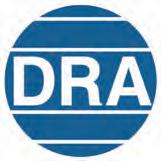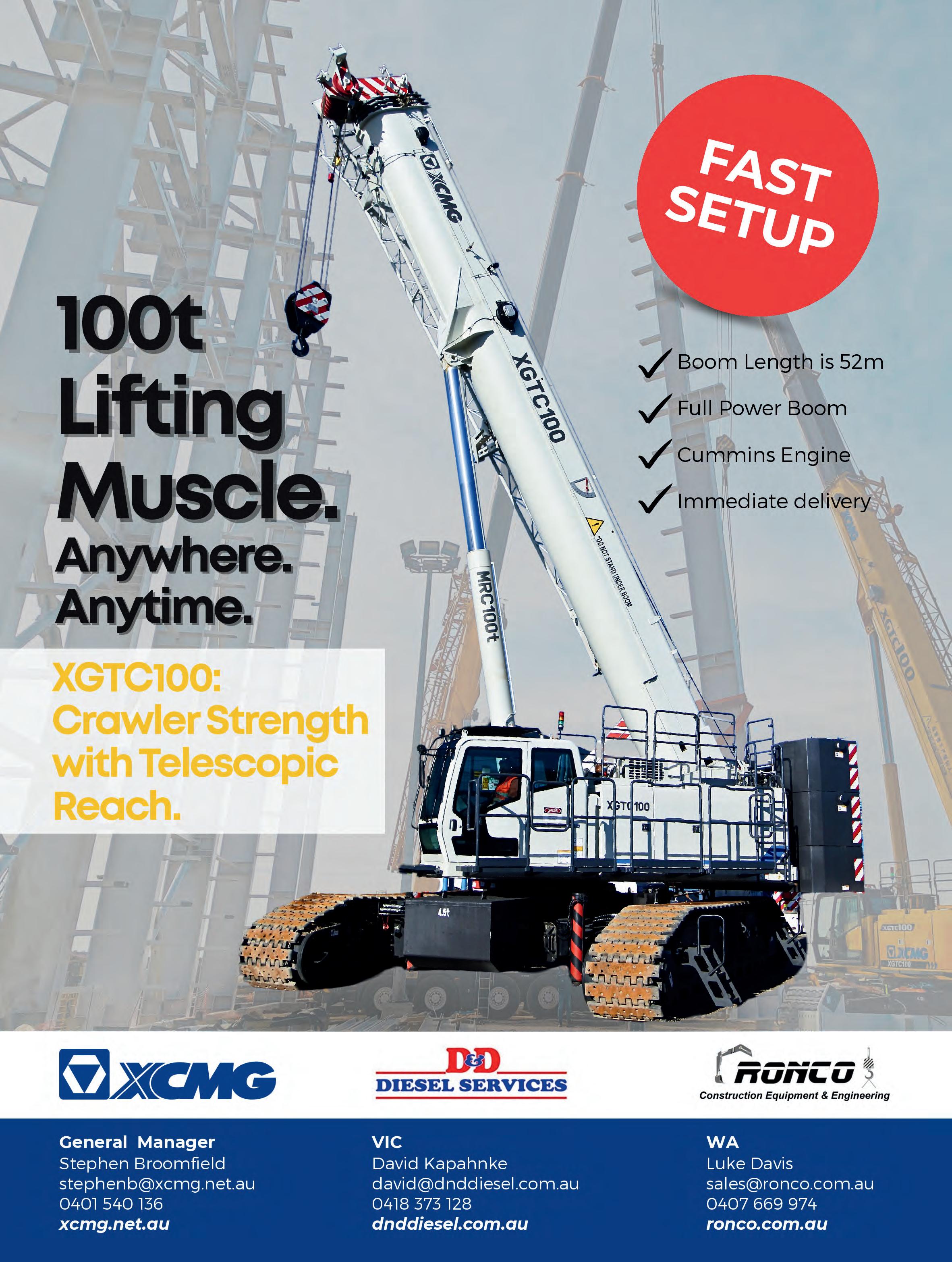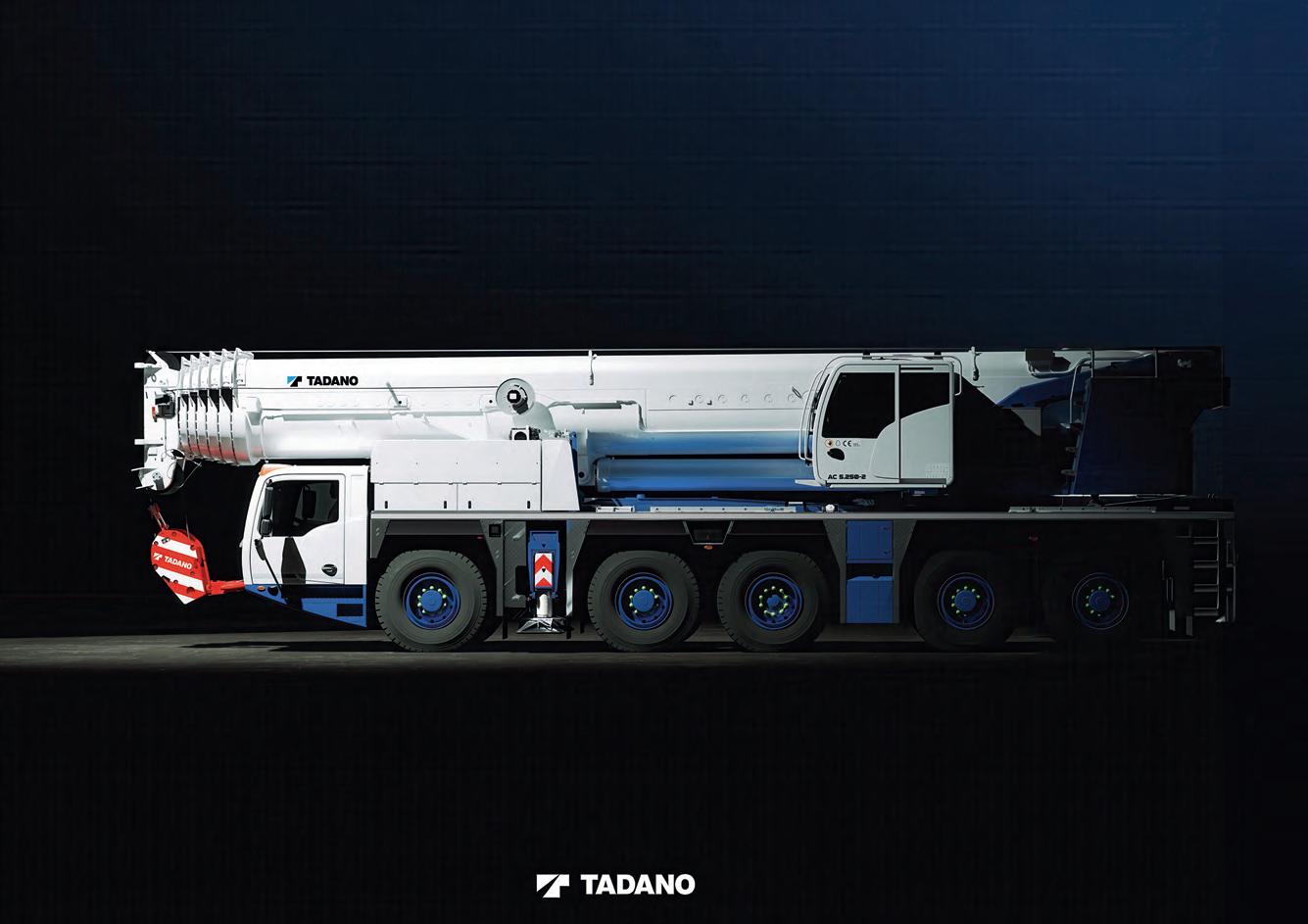
“Invested in
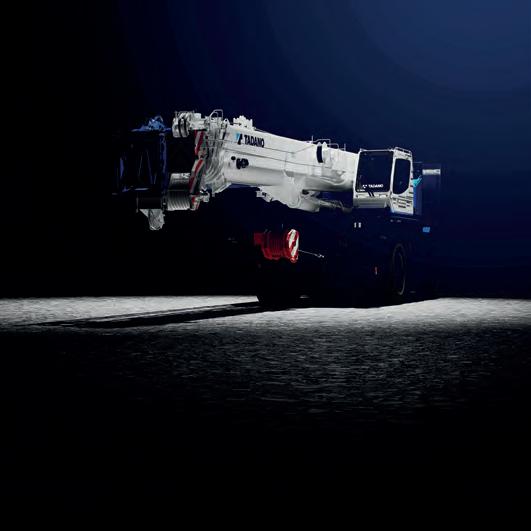
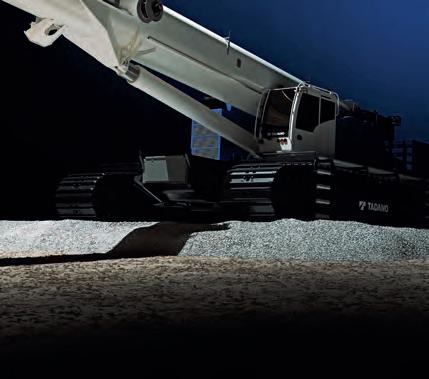
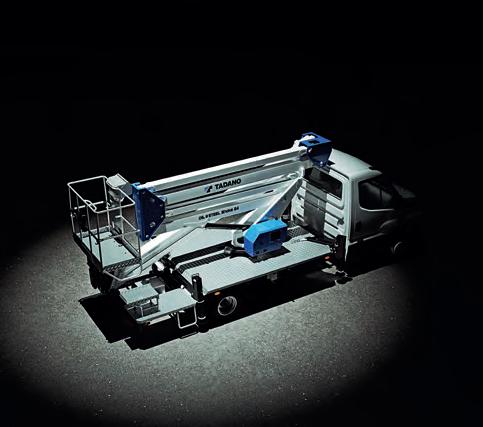
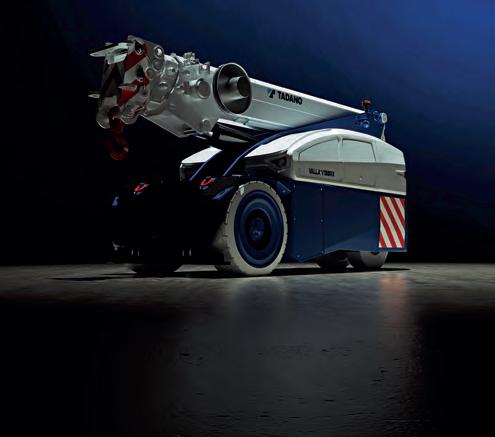
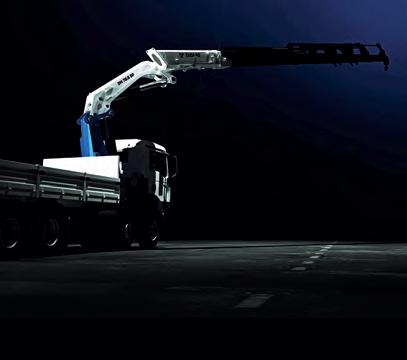
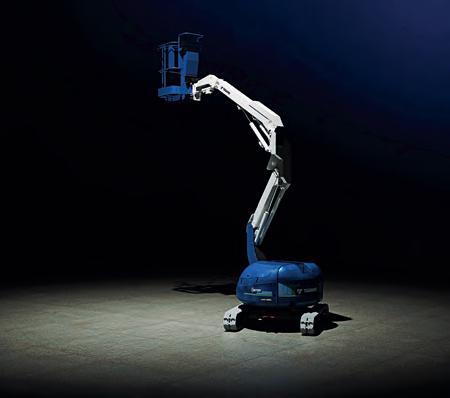
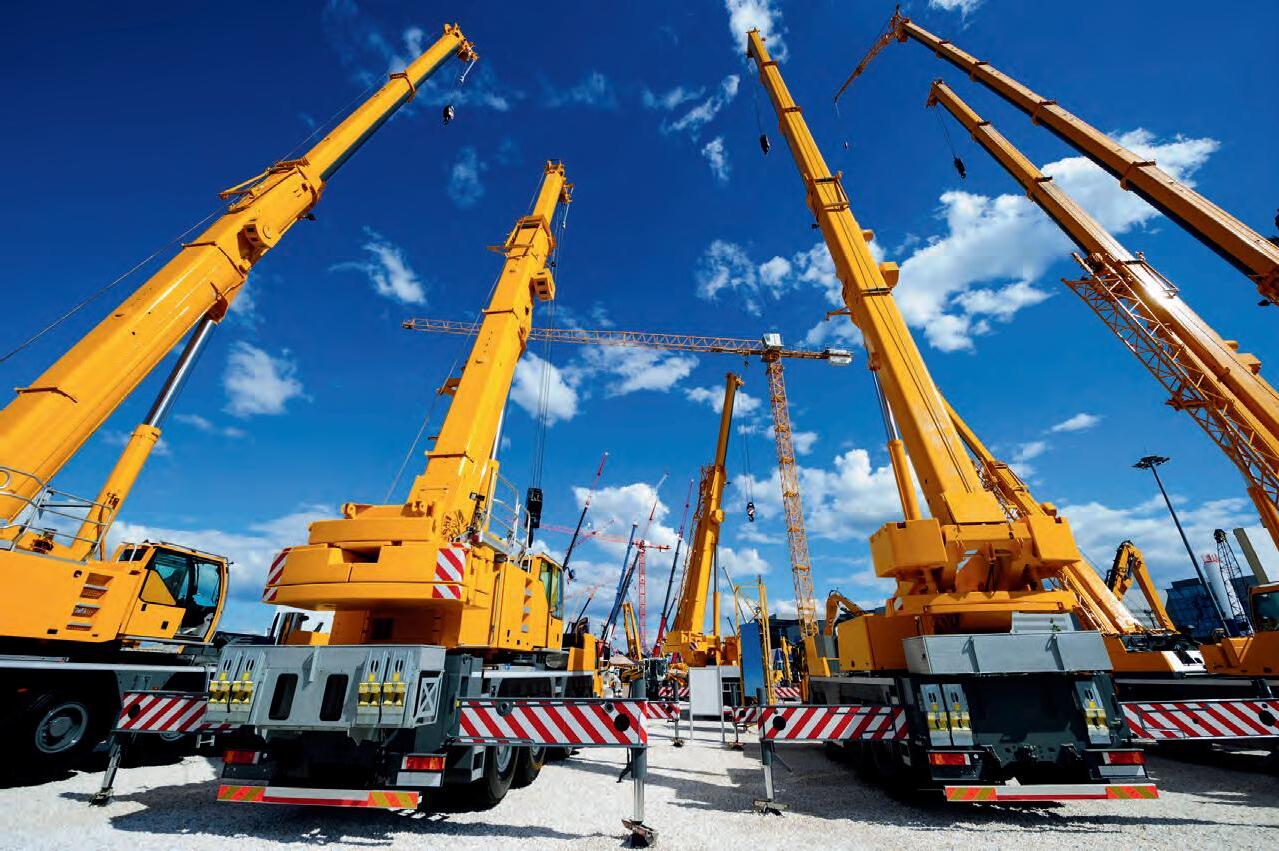


“Invested in







For over 50 years, UAA’s award-winning Mobile Plant and Machinery insurance solutions have powered the cranes and lifting industry - trusted by professionals who keep Australia moving.
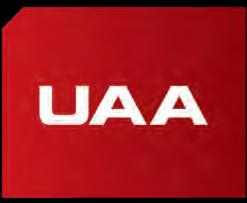
Our seasoned claims team has access to a network of experienced industry repairers, assessors, and suppliers who are

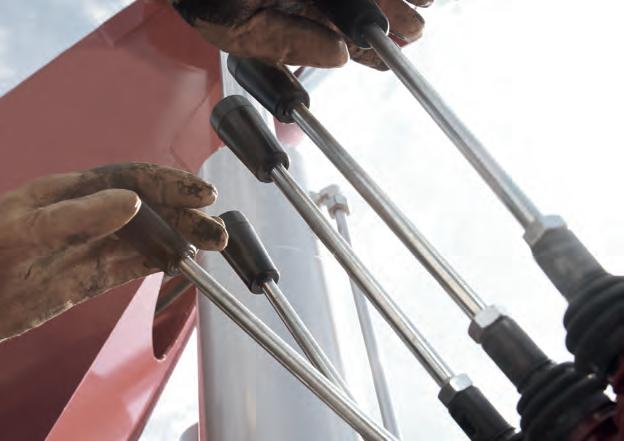
We pride ourselves in creating insurance solutions that are handcrafted and can meet the varied needs of different businesses.
To learn more about UAA’s Industrial Special Plant products, we invite you to reach out to an insurance broker or visit our website uaa.com.au

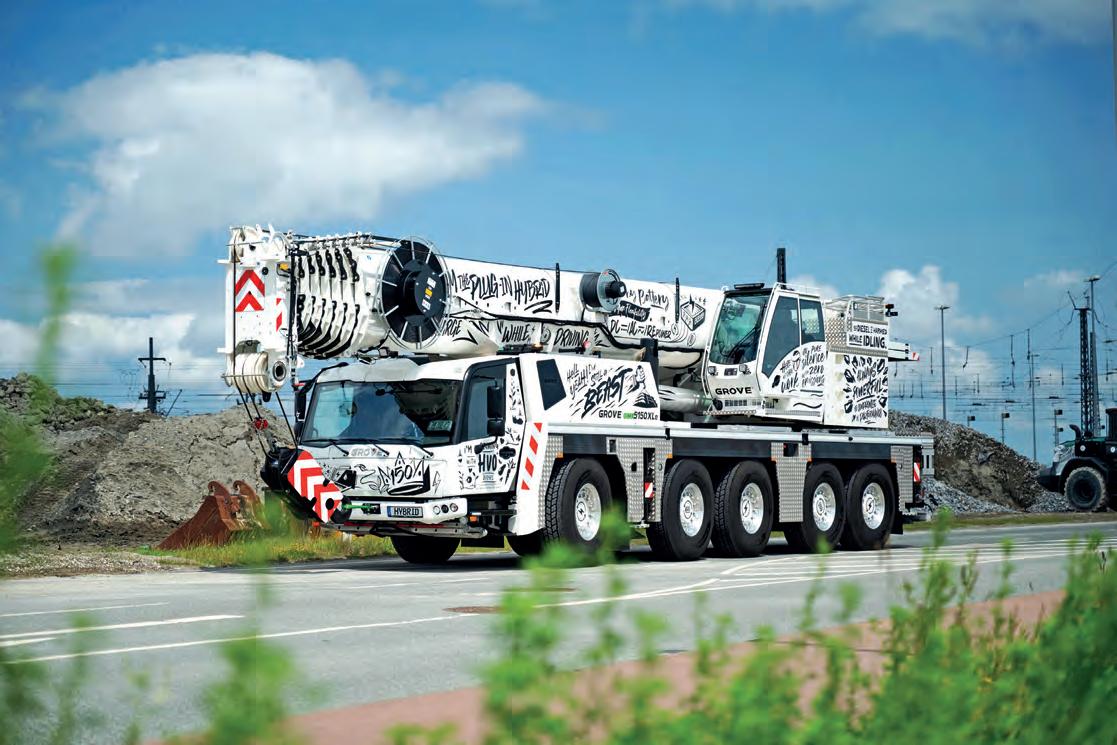
12 CICA CEO report
Welcome to the CICA National Conference and Exhibition.
14 CICA AND NAAS
A new way to move your cranes without permit headaches.
17 All Cranes
The long game of All Cranes.
21 ANC Cranes ANC steps it up with new cranes. 24 CANZ
Crane parade a major success.
26 Smith Cranes
Australasia’s first Liebherr LR11000.
29 LEEA
Small shecks, big consequences: Inspection and maintenance.
32 The Buddie System
World first for Marr Group and The Buddie System.
34 Liebherr Australia
Careers that lift off at Liebherr.
37 RUD
Engineering strength, designing safety.
41 Dieci Apollo 20.4. Compact in size, smart in per formance.
CICA Conference QLD Focus
44 Sarina Crane Hire Focused on people, powered by cranes.
47 Origin Cranes
The origin of growth, trust and reliability.
50 East Coast Cranes New Liebherr’s and Heavy Lift business.
54 XCMG and Brisbane City Cranes New XCMG for Brisbane City Cranes.
57 Superior Cranes Busy operations in Brisbane and Wagga Wagga.
60 Zoomlion Powering heavy lifts in Queensland.
63 Altequip Lifting with strong foundations.
66 Century Cranes
From crocs to construction, they lift it all.
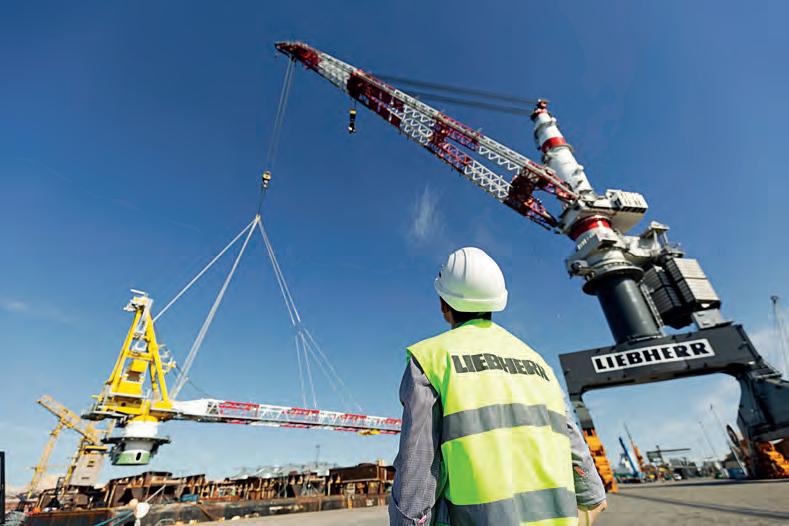
69 Universal Cranes Major expansions in North Queensland.
72 DRA Engineering Pick and carry expert joins Humma.
75 DLL
Financing made simple for crane companies.
79 Maxirig Global Lif ting Partnering for a stronger local industry.
82 TRT and Maritime Construction New bespoke trailer and Kobelco.
85 All Lif ting & Safety The quiet strength of fabrication.
88 Bridco Specialising in stainless-steel lifting equipment.
91 Drake Trailers Steering heavy haulage forward.
94 Andromeda Industries Investment to service demand.
96 Tutt Bryant and Universal Universal appeal of new Sany from Tutt Br yant.
99 Sany Australia Inside Sany’s mega factories.
102 Finlease Brighter times come with spring.
78
104 RapidWorks RapidWorks rolls out in Australia and New Zealand.
107 Protective Leaving no room for error.
110 Pace Cranes New name and Kings Award for tracked carrier.
113 Hardiquip First Jarlway hydraulic luffing tower crane installed.
116 Potain and Reds Global Reds Global partners with Potain.
119 Quadrent Finance built to bear the weight.
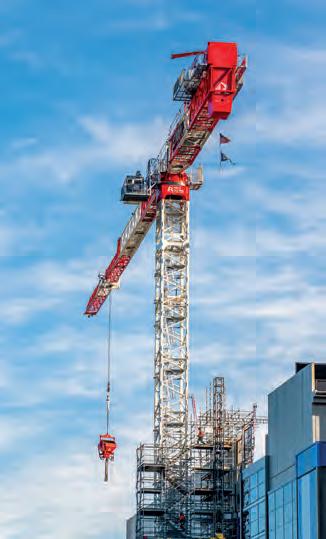
122 Pickles Auctions Pickles, leading in the second hand crane market.
124 Franna Safety in motion on the North East Link.
127 Dotmar Cutting costs without cutting corners.
130 Boom Logistics Challenges of attracting the next generation to the industry.
133 UA A Fully invested in CICA and the industr y.

136 MCT Equipment Examining MCT Equipment’s capabilities.
138 Complete Crane Solutions Tonnage takes the load.
141 Bridgestone Advantages of a Tier One Tyre supplier.
144 Ronco New faces, new perspective.
147 Manitowoc and Grove Grove first for the UK and Italy.
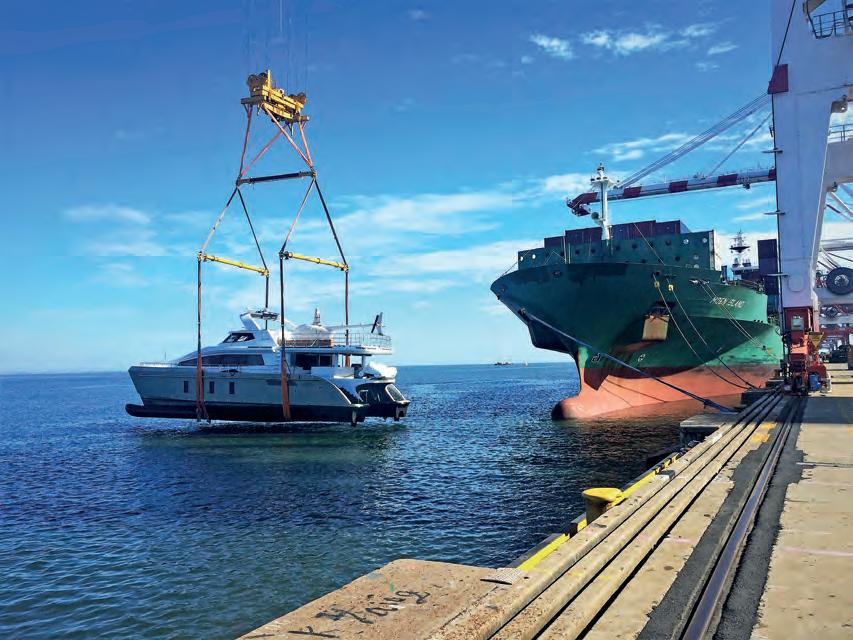
150 UAA Beyond Blue Building hope, one crane at a time. Melbourne Lif ting Strength in service.
Baden Davis Crane Connection Crane Connection appointed XCMG or.
esolution Rigging Services From hospitals, housing to schools: anes that deliver.
ace Cranes 30 years of service and maintenance ill loving it.
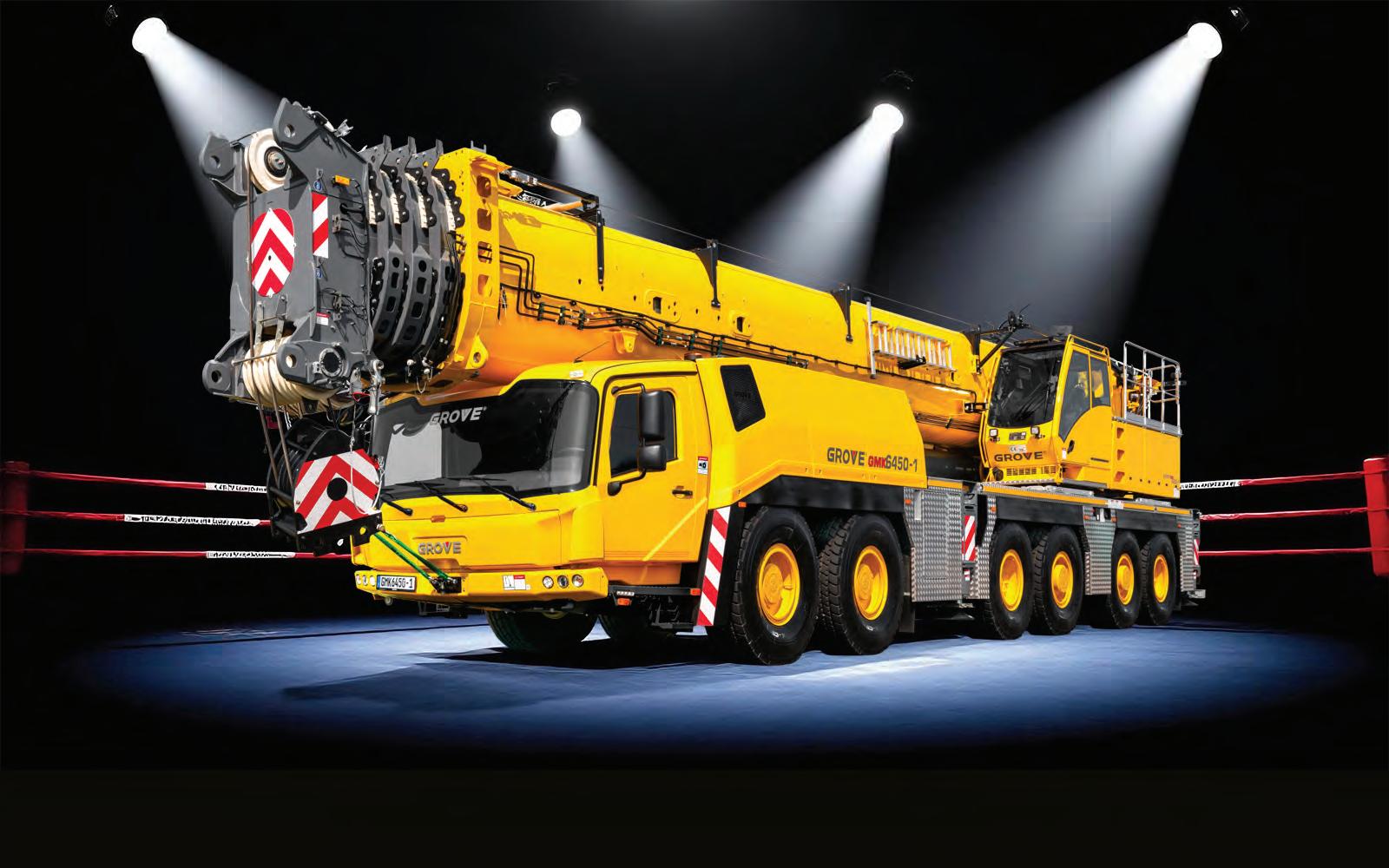


When others reach their limit We’re just getting started

450t Capacity 79m Luffing Jib
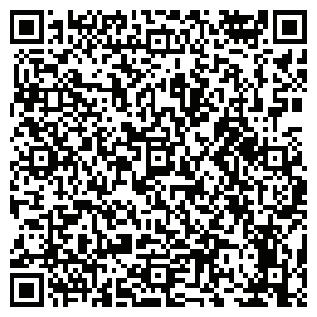
REACH OUT NOW FOR A SIDE-BY-SIDE COMPARISON AND SEE THE DIFFERENCE FOR YOURSELF.

IN WRITING THIS COLUMN, I ACKNOWLEDGE that early September was a dark and difficult period for the industry but Craig Membrey, Managing Director of Membrey’s Transport and Crane Hire, with support from the industry, brightened the mood immensely. One crane now holds something deeply personal for Craig: the memory of his son Rowan, and a message he has carried for more than a decade – that talking about mental health can save lives.
Over time, Craig began to dream of extending that legacy into the lifting sector – a space that has been central to Membrey’s for decades. When he learned Franna was about to deliver its 2000th MAC25, he saw the opportunity to bring that dream to life. Working with long-time friend Danny Black, General Manager of Franna, and securing the support of Beyond Blue, Craig ensured the milestone crane was finished in Beyond Blue livery. You will read the full story in this issue.
We congratulate The Crane Industry Council of Australia on the success of
Below: Franna’s 2000th MAC25 is finished in Beyond Blue livery for Membrey Cranes and Transport in memory of Craig’s son Rowan.
The National Conference and Exhibition. Predictions are for one of the largest conference delegations and the most comprehensive exhibition ever. The CICA Lift of the Year awards have been well supported with each category receiving numerous nominations. It will be interesting to see who succeeds when the winners are announced during the Gala Dinner.
This issue also includes our first ‘deep dive’ into the Queensland crane sector where a number of crane hire companies have taken the opportunity to promote their businesses and most recent acquisitions.
As always, the Cranes and Lifting team have worked hard to bring you this issue of the magazine and we hope you enjoy the read.
BOOMS UP!

Simon Gould Editor, Cranes and Lifting
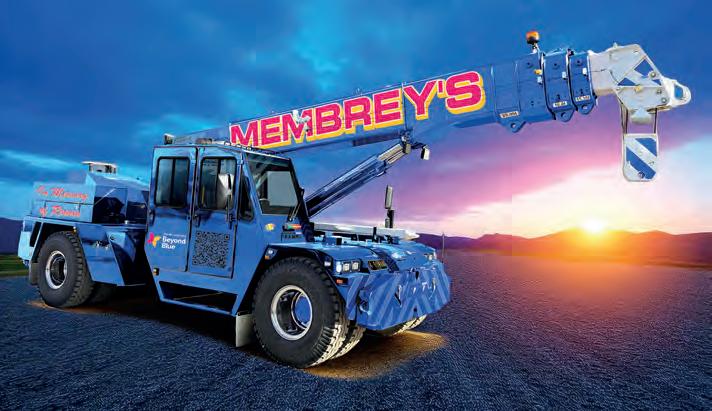
Published by:
379 Docklands Drive, Docklands VIC 3008
T: 03 9690 8766
www.primecreativemedia.com.au
Chairman John Murphy E: john.murphy@primecreative.com.au
CEO Christine Clancy E: christine.clancy@primecreative.com.au
Publisher Sarah Baker E: sarah.baker@primecreative.com.au
Managing Editor Lisa Korycki E: lisa.korycki@primecreative.com.au
Editor
Simon Gould
E: simon.gould@primecreative.com.au
T: 0404 865 109
Assistant Editor
Danny D’Cruze
E: danny.dcruze@primecreative.com.au T: 0429 187 751
Business Development Manager Emily Schlegel E: emily.schlegel@primecreative.com.au T: 0466 317 555
Client Success Manager Louisa Stocks E: louisa.stocks@primecreative.com.au
Art Director Bea Barthelson
Imaging Assistant Paul Breen
Subscriptions
Frank Rapone T: 03 9690 8766
E: frank.rapone@primecreative.com.au
The Publisher reserves the right to alter or omit any article or advertisement submitted and requires indemnity from the advertisers and contributors against damages or liabilities that may arise from material published.
© Copyright – No part of this publication may be reproduced, stored in a retrieval system or transmitted in any means electronic, mechanical, photocopying, recording or otherwise without the permission of the publisher.

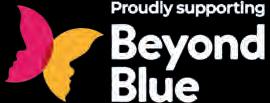

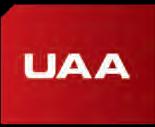

Underwriting Agencies of Australia (UAA) is supporting Membrey’s Transport & Crane Hire to raise funds for Beyond Blue’s 24/7 Support Service ahead of the CICA Conference.
Every dollar donated will go towards funding Beyond Blue's 24/7 Support Service. This means with your support, we can be there for people experiencing anxiety, depression or at risk of suicide whenever they reach out for help.
Scan below to donate today:

Tadano continues to shape the future of lifting and access solutions by combining relentless innovation, a clear sustainability strategy, and investment in customer service infrastructure. The result is a company firmly committed to both industry progress and customer success.
TADANO’S COMMITMENT TO INNOVATION spans safety systems, electrification, and digitalisation.
At tech event CES 2025 in Las Vegas, the company showcased advanced technologies such as artificial intelligence (AI)-powered prognostics and health management, surroundings monitoring, ground collapse prevention, and suspended-load motion assistance under the theme “Safety. Every Day. Every Lift.” This global focus on next-generation
This global focus on next-generation technology continued at bauma 2025 in Munich, where Tadano presented one of its strongest product portfolios to date.
technology continued at bauma 2025 in Munich, where Tadano presented one of its strongest product portfolios to date.
Highlights included the new AC 5.250L-2 all terrain crane with a 79 metre boom and 736 tonne-metres load moment, the next-generation CC 78.1250-1 lattice boom crawler crane designed for wind and infrastructure projects, and the premiere of the eGR-1000XLL EVOLT fully electric rough terrain crane. Tadano also debuted new aerial work platforms
from the Nagano and Oil & Steel ranges, alongside digital innovations such as the Hey Tadano AI assistant and the new 3D job planner.
Tadano’s Green Solutions innovation pipeline is also broadening into access and aerials, with electrified and hybrid platforms like the NUL07E-7, NUS21W-7, and AT-100TTE providing lower-emission solutions for diverse environments. Together, CES and bauma allowed Tadano to demonstrate its twin

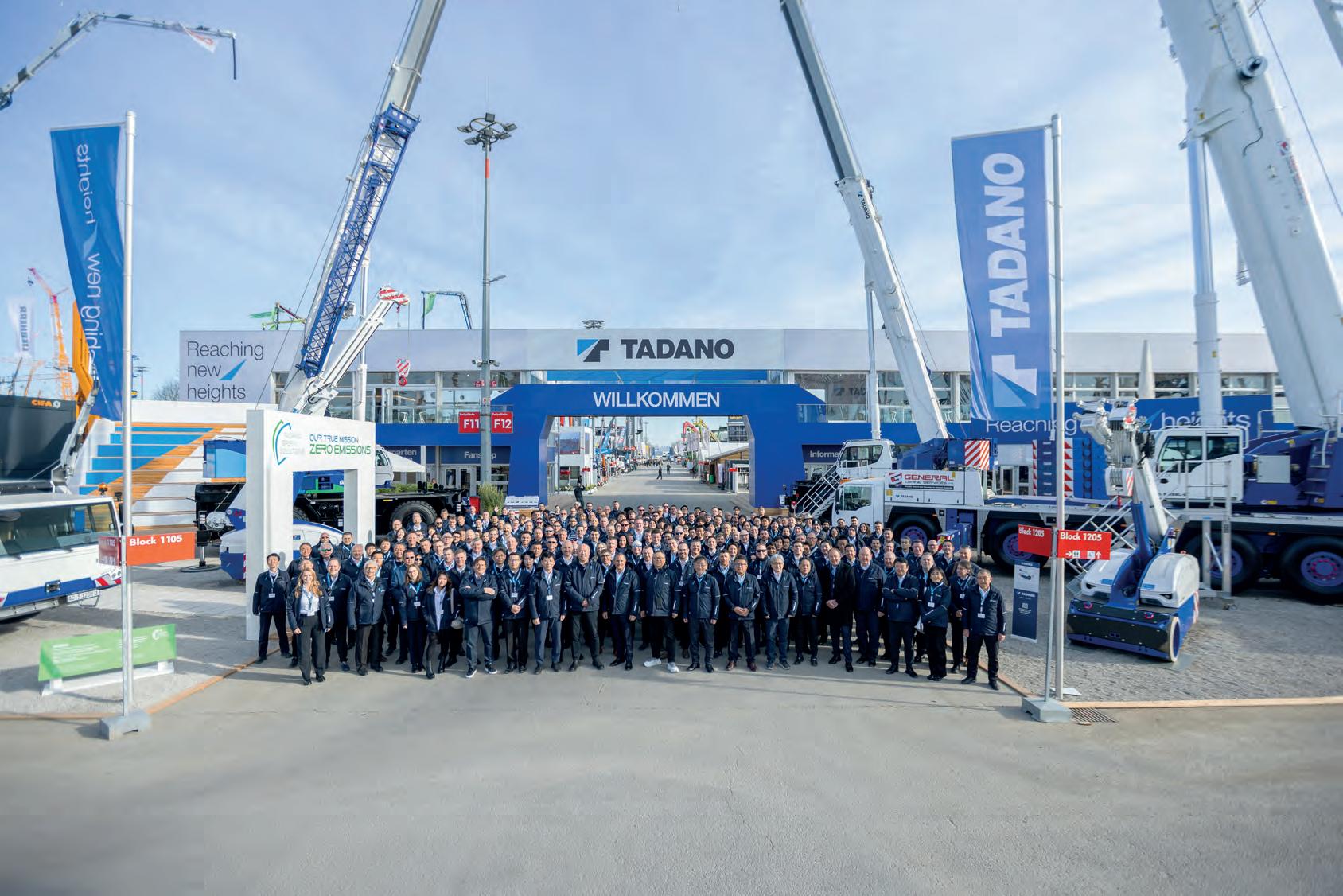

“The first AC 4.070HL-1 in Australia is now at work with General Crane Services WA, marking an important milestone in bringing hybrid lifting solutions to Western Australia.”
The Tadano Green Solutions (TGS) portfolio consolidates initiatives such as the ESTA-award-winning E-Pack electro-hydraulic kit for zero-emission operation, engines compatible with renewable diesel alternatives, and electrified cranes.
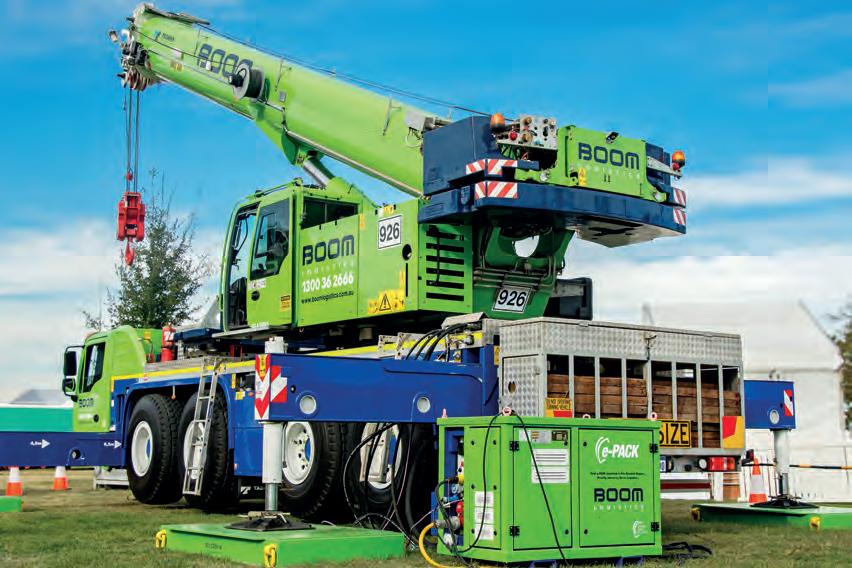
“By 2030, the company aims to cut carbon dioxide emissions from operations by 25 per cent and from product use by 35 per cent, on the path to achieving full climate neutrality by 2050.”
focus: applying digital intelligence and safety systems while accelerating electrification and hybrid technology across its product line.
Hybrid innovation is not just a concept – it’s already working in the field. The AC 4.070HL-1 all terrain crane can operate a full workday on battery power, with equal performance to diesel. Its rapid-charge system reaches 80 per cent capacity within an hour and can operate while charging, providing flexibility and efficiency.
The first AC 4.070HL-1 in Australia is now at work with General Crane Services WA, marking an important milestone in bringing hybrid lifting solutions to Western Australia. In parallel, the E-Pack electro-hydraulic
system has been successfully deployed with Boom Logistics, enabling whisperquiet, zero-emission operation in sensitive urban environments.
These local projects demonstrate how Tadano’s global innovations are already supporting Australian customers in realworld conditions.
Under its 2024–26 Mid-Term Management Plan, Tadano has positioned decarbonisation as a central growth strategy. By 2030, the company aims to cut carbon dioxide emissions from operations by 25 per cent and from product use by 35 per cent, on the path to achieving full climate neutrality by 2050.
The Tadano Green Solutions (TGS) portfolio consolidates initiatives such as the ESTA-award-winning E-Pack electro-
hydraulic kit for zero-emission operation, engines compatible with renewable diesel alternatives, and electrified cranes. Solar panel installations across manufacturing plants in Japan and Germany, combined with a modal shift toward sea freight, further reduce emissions and improve operational efficiency.
The TadanoPro app, meanwhile, supports digital transformation by reducing paper usage, providing digital access to brochures and manuals, and aligning with the company’s environmental commitment.
Tadano’s global growth strategy is underpinned by solid foundations. Under Chief Executive Officer Toshiaki Ujiie, the One Tadano model aligns operations in Japan, Germany, and the United States for greater efficiency and stronger support networks.
Strategic acquisitions including Nagano Industry, Manitex (with PM, Oil & Steel, and Valla), and the IHI Transport Machinery business, have expanded Tadano’s presence across all major crane segments, aerial work platforms, and wind power solutions.
Tadano’s governance framework supports this growth, with a sustainability committee, dedicated environmental and social governance subcommittees, and a carbon dioxide/ energy reduction subcommittee reporting directly to the board.
Tadano continues to back innovation with world-class service. In Oceania, Tadano operates branches in Perth, Melbourne, Sydney, and Brisbane, each staffed by factory-trained technicians and supported by a genuine parts supply network to minimise downtime.
Globally, Tadano invests in process upgrades, research and development, and manufacturing improvements. With more than 100 sales and service locations worldwide, it continues to build enduring partnerships founded on reliability, customer trust, and shared success.
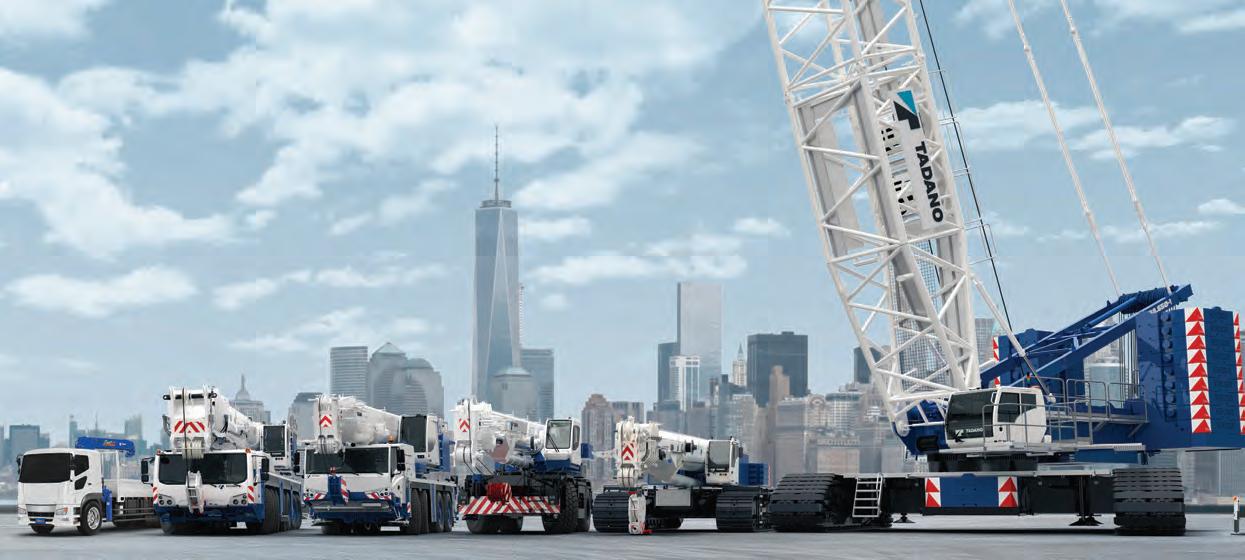


Investing in cranes is a big step but with the right finance options, it doesn’t have to be a heavy lift.
Tadano proudly partners with DLL to offer flexible finance and leasing solutions tailored for crane customers.
Whether you’re growing your fleet, upgrading equipment, or managing cash flow, DLL’s deep industry experience and flexible programs can help you stay competitive and grow with confidence.
Let’s build something great together!
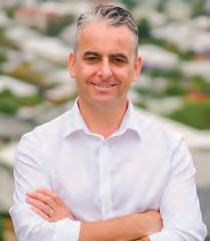
Reach out to Brendon today:
Brendon Mayo
Account Manager Construction, DLL Mobile: +61 482 180 702
Email: brendon.mayo@dllgroup.com
Scan the QR code to find out more about DLL and how we can help your business thrive.
IT’S A REAL HONOUR TO WELCOME YOU to the 2025 CICA National Conference in beautiful Brisbane – once again one of the biggest crane industry gatherings in the southern hemisphere. Our theme, “Are you invested?”, is a reminder that what we do in this industry goes far beyond equipment and contracts. Being invested means committing our time, our knowledge, and our energy to building an industry that is safe, innovative, and sustainable.
The crane industry is and always has been about people. We stand on the shoulders of those who came before us – the visionaries and pioneers who laid the foundations for what CICA is today. Their commitment and foresight created an industry built on strength, ingenuity, and collaboration.
That legacy continues every day through the people who own businesses, operate cranes, and work tirelessly to make life better for others in the community. Machines may be the tools of our trade, but it is people

who drive progress and shape the future of our industry. This Conference is a chance to reflect on that, to learn from one another, and to look ahead with confidence.
What makes me proud is seeing how many of you have made the effort to be here – some travelling long distances, others juggling already packed
schedules. It’s no small thing, and your presence is greatly appreciated. This Conference only comes to life because people are willing to show up, share their experiences, and be part of shaping the future of our industry.
I’d also like to acknowledge the generous support of our sponsors. A special thank you goes to our
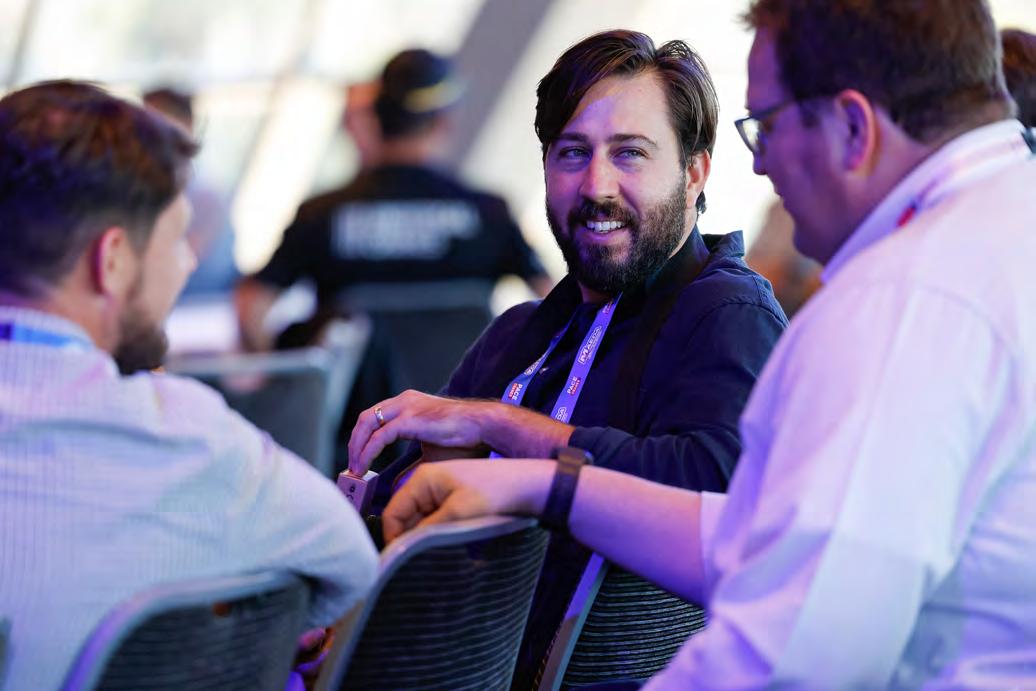
Brandon Hitch CEO CICA
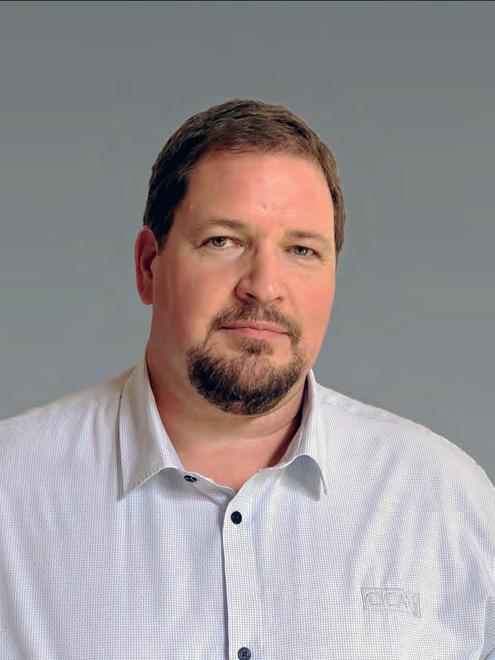
without whose support this Conference simply wouldn’t be possible. Thank you also to our Networking Dinner Sponsor, RUD, our Gold Sponsor, Liebherr, and our Silver Sponsors: Tadano, Terex Franna , XCMG, and Zoomlion / Nationwide Machinery Group. We’re grateful as well to our Lanyard Sponsor, Sany, and our Bronze Sponsors: Finlease, Manitowoc, Sennebogen, Maeda Pace, and RapidWorks. A big thank you also to our Keynote Sponsor, Robway, our Family Hour Sponsor, Tadano, and our Coffee Cart Sponsor, PNO Insurance. Finally, thanks once again to Cranes and Lifting Magazine for their support of the Lift of the Year and Photo of the Year awards.
This Conference is the result of so many people coming together; delegates, speakers, sponsors, and organisers and it’s a privilege to see it all come to life again this year. Thank you for being invested, thank you for making the effort to be here, and above all, I hope you have a wonderful and rewarding Conference.
Brandon Hitch CICA CEO
CICA BOARD
Marcus Ferrari – President
Danny Adair – Director
Danny Black – Director
David Solomon – Director
Karli Sutherland– Director
Anthony Grosser – Director
Andrew Esquilant-Director
OFFICE
Brandon Hitch Chief Executive Officer 0428 228 048 ceo@cica.com.au
Alice Edwards Road Technical Engineer 03 8320 0440 alice@cica.com.au
Patrick Cran
CICA Site Operations Advisor 0488 004 274 pat@cranesafe.com.au
Sharon Pearce
Crane Crew Competency Officer 0491 134 533 sharon@cica.com.au
Damien Hense
CICA Road Policy Advisor 0488 007 575 damien@cica.com.au
Thomas Webber Communications Coordinator thomas@cica.com.au
Kate Galloway Traineeship & Industry Engagement Coordinator 0491 047 118 kate@cica.com.au
Michelle Verkerk
Communications and Special Projects Advisor michelle@cica.com.au
Just ina Blackman Member Events and Engagement 0403 717 626
justina@cica.com.au
Shane Coupe CraneSafe & CrewSafe Administrative Assistant Officer 0491 047 134 shane@cica.com.au
Unit 10, 18–22 Lexia Place, Mulgrave Vic 3170 Phone: 03 9501 0078
Email: admin@cica.com.au Website: www.cica.com.au
For information, please visit our website or call the CICA office.
The current permit process can take weeks, with operators often left in the dark until every road manager has responded.
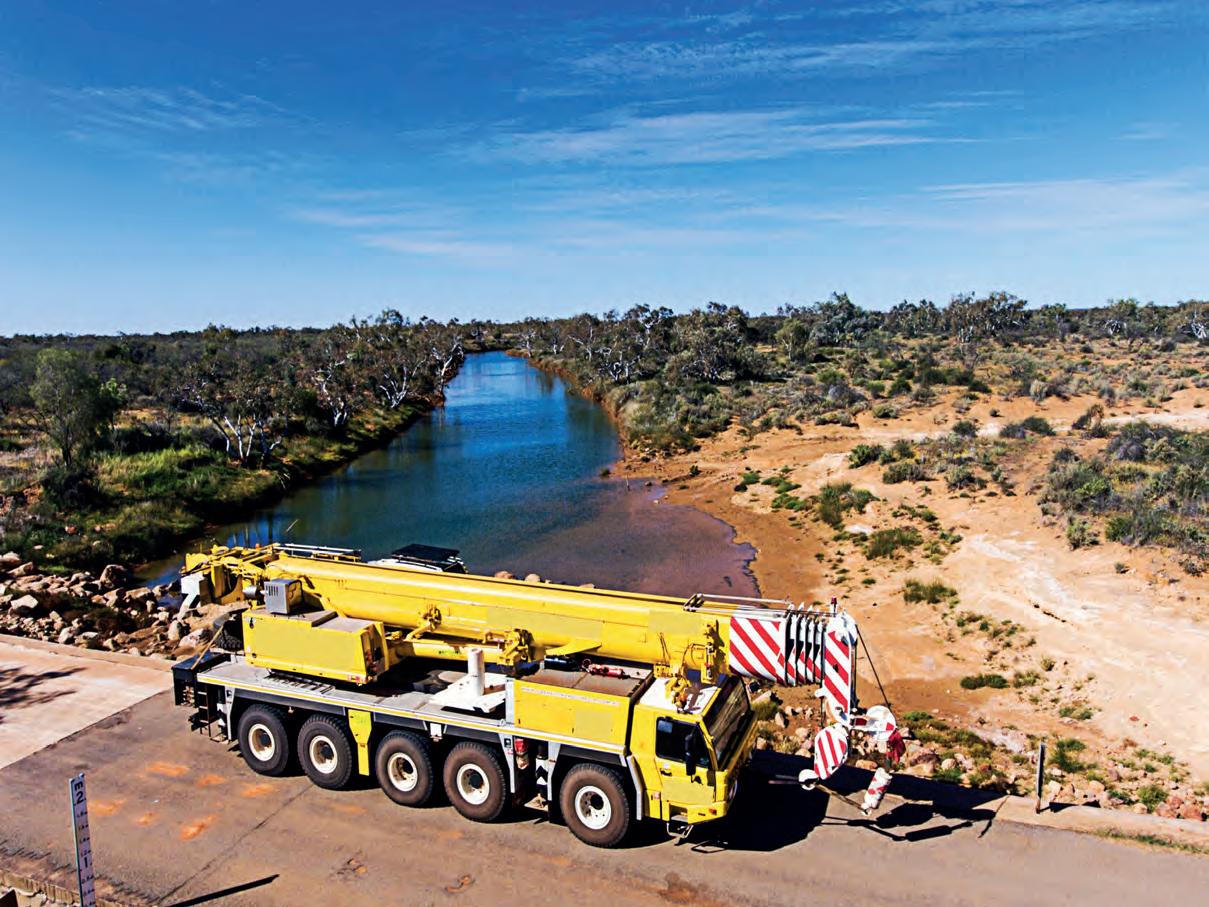
Anyone who’s ever had to move a crane to a site knows the somewhat frustrating process of navigating the permit process, whether it’s due to unfamiliar roads, complex regulations, or unexpected logistical challenges. Then there’s the paperwork, weeks of waiting, and the uncertainty of whether that last 500 metres of access will be approved.
SOUND FAMILIAR?
That’s the challenge the National Automated Access System (NAAS) is designed to tackle. NAAS is Australia’s next big step in heavy vehicle access. And for the crane industry, where jobs are often last-minute, time is money, and lastmile access can make or break a project, it’s set to be a game-changer.
Cranes are different to trucks. They’re usually larger, heavier and their main purpose is lifting. The work they do, raising pool shells, placing bridge beams, or hoisting air-conditioners onto rooftops, is often urgent and time-critical. The current permit process can take weeks, with operators often left in the dark until every road manager has responded. By then, the job may have fallen through,
costs have blown out, or the customer is already frustrated.
NAAS changes that by giving crane operators:
• Faster answers – Generate a map and instantly see where your crane can travel across the whole network.
• More options, more flexibility –Test different crane types or sizes and see which can access the site most efficiently.
• Last-mile certainty – Visibility on those tricky final stretches into job sites.
• Clarity across borders – Different rules in different states are made transparent through a single system.
• Practical planning – If Route A is blocked, you can check Route B on the network map before sending the crane out the gate.
For an industry built on speed and
reliability, NAAS means operators can plan with confidence.
Brandon Hitch CICA Chief Executive Officer, summed it up: “The NAAS is a game-changer for the crane industry. Having a clear, consistent and immediate process for assessing access to the road network means operators can plan with certainty, reduce delays, and improve safety outcomes. For an industry that already works under tight timeframes and complex logistics, NAAS gives us the confidence that we can get the right equipment to the right place to progress key projects, without unnecessary red tape holding projects back.”
NAAS is built on the proven Tasmanian HVAMS (Heavy Vehicle Access Management System) platform, which

has been successfully working for nearly a decade. It provides a digital, legally recognised way to confirm access, without waiting weeks for multiple road managers to respond to permit requests.
Here’s how it works, step by step:
1. Create your vehicle profile
Enter crane details into the system – axle configuration, weight and dimensions.
NAAS saves this as a reusable vehicle code, so you only need to do it once.
2. Generate a tailored network map
Based on your vehicle, NAAS instantly shows the full available network for your crane. Each network is valid for 14 days.
3. Update when needed
If the job falls outside that window, revisit NAAS, enter your saved vehicle code, and generate an updated network, which will be valid for another 14 days. No waiting for paperwork.
4. Plan your trip with a Route Card
For each job, you can create a specific route and generate a Route Card with turn-by-turn directions, conditions, and restrictions (like speed limits, curfews, or bridge conditions). Everything you need is captured in one document – no piecing it together from multiple approvals.
5. Backed by gazette notice
These maps carry legal effect. They’re not just advisory – they give operators certainty that what’s shown is valid under the law.
In short: NAAS replaces route-by-route guesswork with a network-wide view of access. What once took weeks of backand-forth now takes minutes and gives far more visibility across the entire network.
Of course, scaling up NAAS is no small feat. It has to align with multiple governments, hundreds of councils, and a whole range of vehicle types.
That’s why the rollout is incremental. It begins with performance-based standards (PBS) vehicles in Tasmania, then expands to defence, oversize/overmass vehicles and cranes across other states and territories. More areas and vehicle types will come online gradually.
One important note: Permits won’t
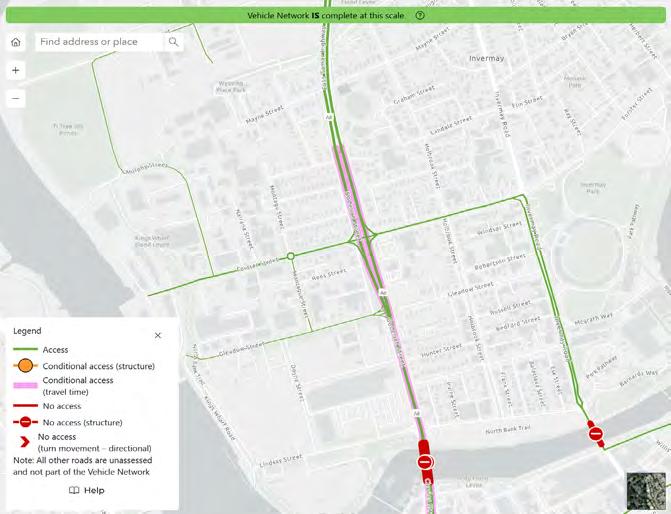
disappear and they’re not meant to.
NAAS is designed to reduce the number of movements that need a permit, not replace the permit system entirely. For certain cranes or roads, you will still need to apply for a permit. But as NAAS grows, more routine access will be handled instantly through the system.
To set clear expectations:
• Some cranes simply won’t be able to access certain parts of the network with or without permits. There are lots of reasons for this such as bridge capacity or space constraints,
• The NAAS will not magically provide access to all roads and bridges. It will, however, show you where the pinch points are quickly to allow you to discuss access with the road manager, research alternative routes or vehicles, or apply for a permit.
• Road managers remain central. Their rules, conditions, and expertise are what NAAS displays making access transparent for everyone.
NAAS streamlines the access process, automating where appropriate, while leaving decisions for the highly complex moves where they belong.
The long-term vision for NAAS is big: a truly national, digital access system for heavy vehicles. One that reduces
duplication, improves safety, and makes life easier for operators and road managers alike.
For cranes, that means:
• Less waiting.
• Fewer headaches.
• More certainty when planning jobs.
The rollout will take time, and the network will grow in stages. Some areas will come online sooner than others, but every step forward reduces complexity and brings more benefits.
As one industry spokesperson put it: “NAAS is about reducing red tape while maintaining safety, improving national consistency, and giving both industry and road managers the tools they need.”
Moving cranes has always been one of the toughest challenges in transport. With NAAS, that challenge gets a little easier. It won’t remove every permit. It won’t open every road. But it will provide faster answers, clearer rules, improved flexibility and a growing national solution to help crane operators get the job done with more certainty and confidence.







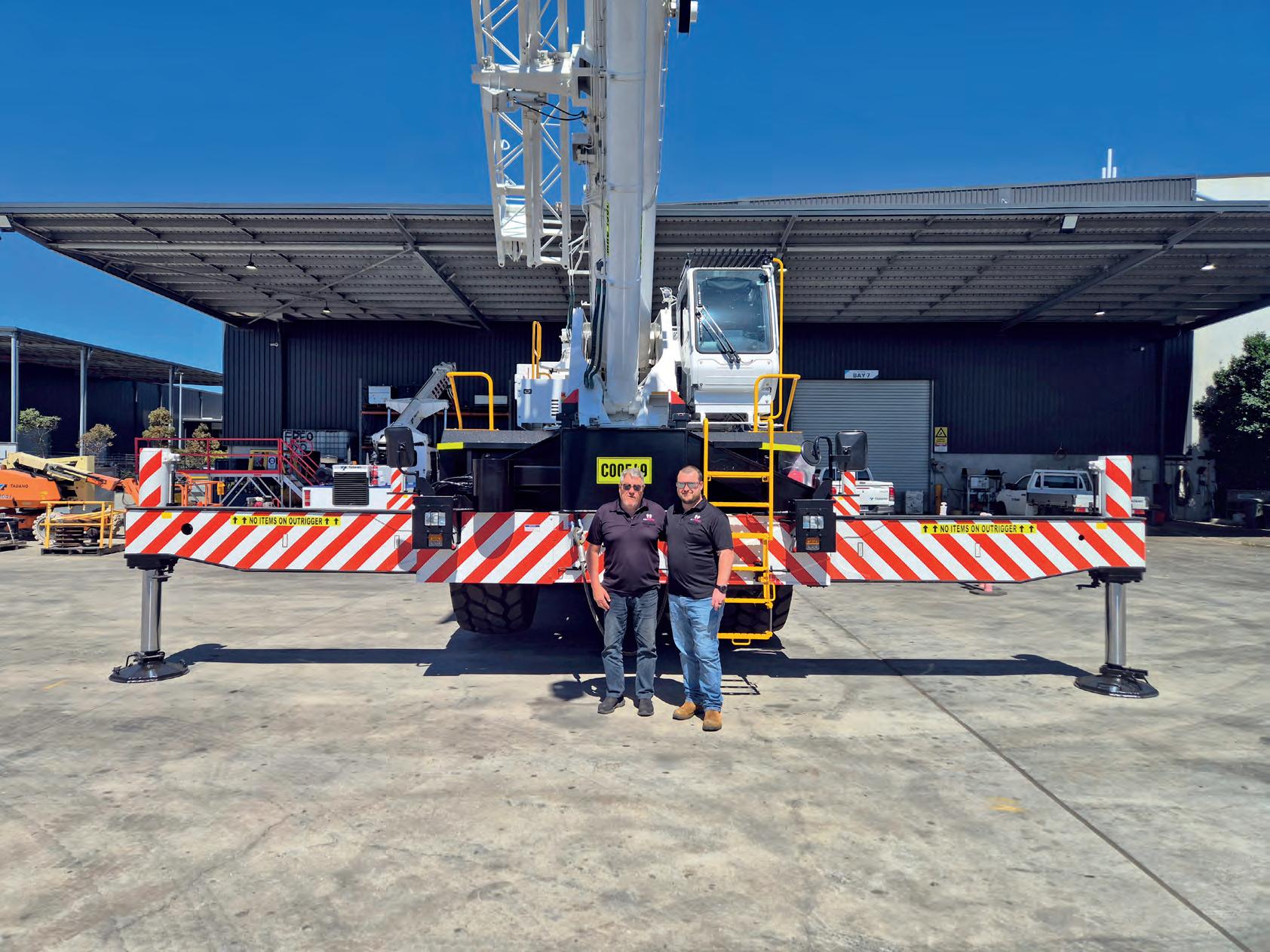

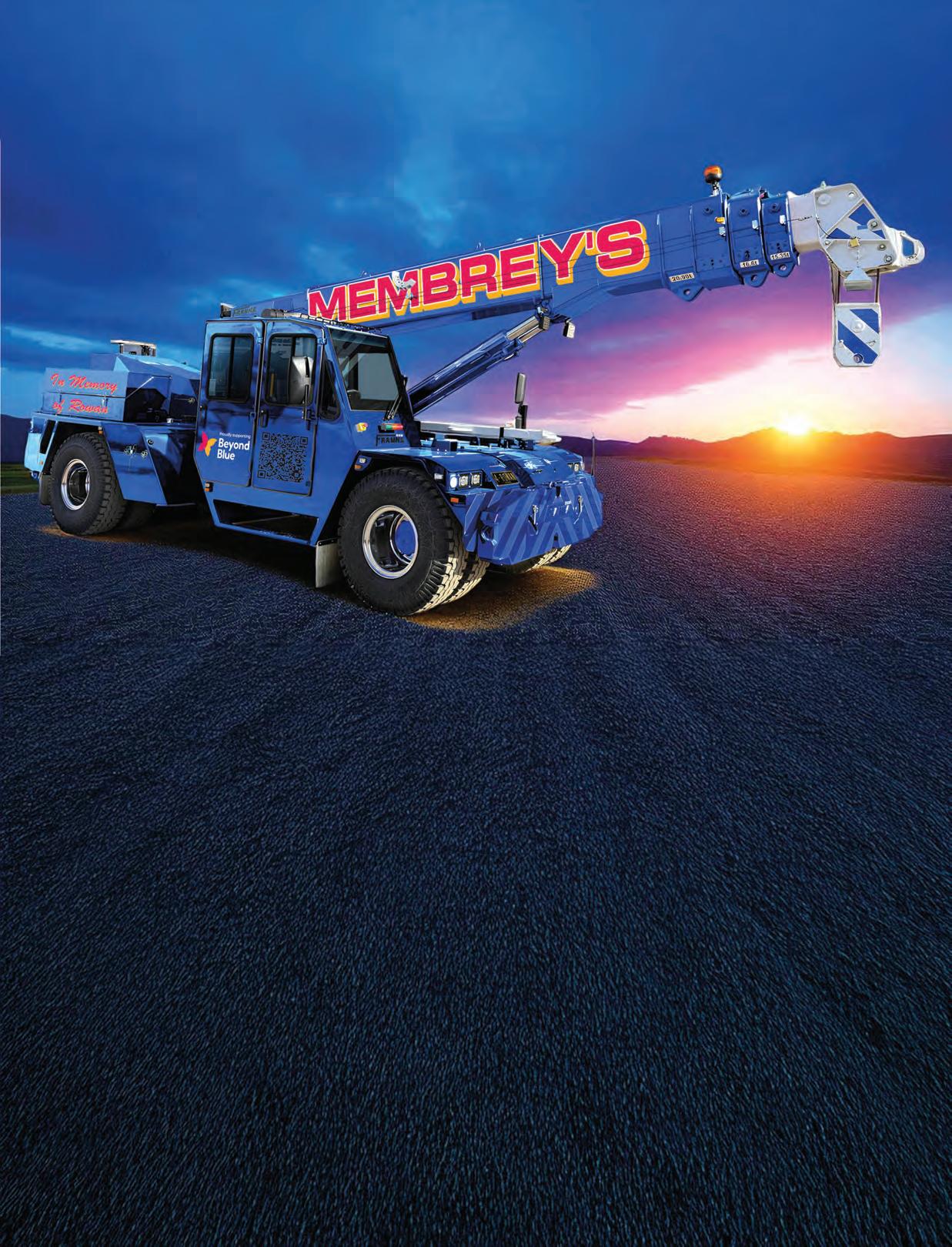

Marking 10 years in business, All Cranes proves that relationships and integrity are just as important as the machines they sell and hire.

FOR PETER SHELTON, CRANES HAVE been more than a career – they’ve been a lifelong calling. After starting as a storeman at Franna in 1989, he worked his way up to General Manager, before later holding leadership roles at James Equipment and Tadano. By 2014, after 15 years in corporate management, Peter was ready to step away. What he didn’t expect was that a family business with his son Todd Shelton would soon become his next chapter.
“All Crane Sales started almost by accident,” Peter said. “I had a couple of cranes for sale, put the word out, and
within months we realised there was a real business opportunity sitting in front of us.”
From the back deck of their Brisbane home in January 2015 (celebrating ten years this year), the father-son duo began answering calls, setting up spreadsheets, and selling cranes. What started with a handful of machines quickly grew into something much larger. “We thought we’d sell maybe five or six cranes in the first year. We ended up selling 15 to 20,” Todd said. “That’s when we knew we were onto something.”
What began as a small fatherand-son venture quickly grew into something much larger. As demand increased, the Sheltons brought their two business arms under one banner. The dry hire operation, Australian Machinery Hire, and the sales arm, All Crane Sales & Equipment, were merged to form All Cranes. The move made it clear to the industry that one company could now provide both services – crane hire and crane sales – through a single, trusted name.
Both companies were go-to names in their respective fields: one specialised
With more than 400 cranes sold and a 25-crane dry hire fleet, All Cranes delivers both sales and hire solutions under one trusted banner.
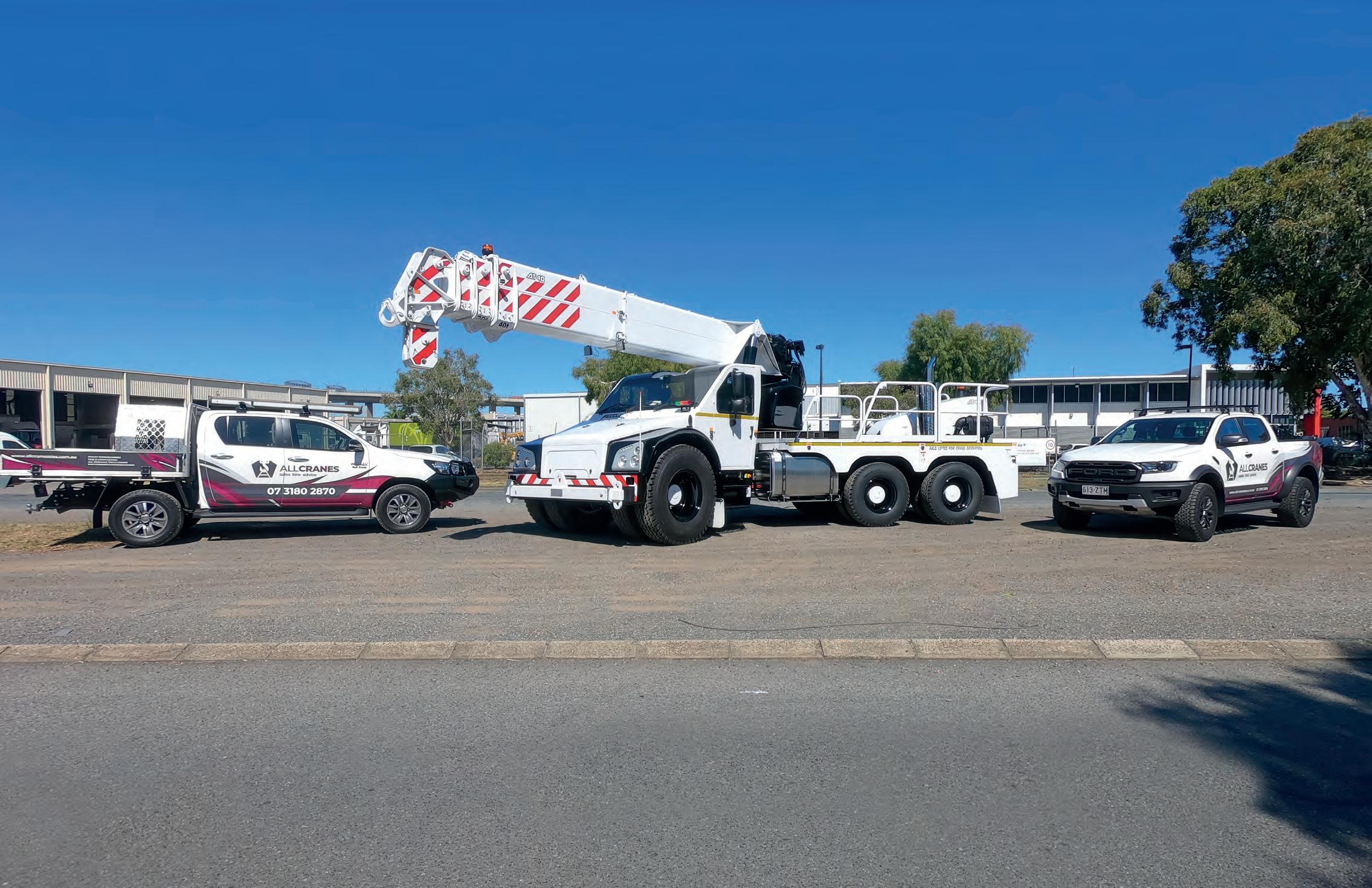

“Our aim was to change the way the used crane market worked –be more transparent with pricing as well as delivering prompt and efficient service throughout the entire sales process.”
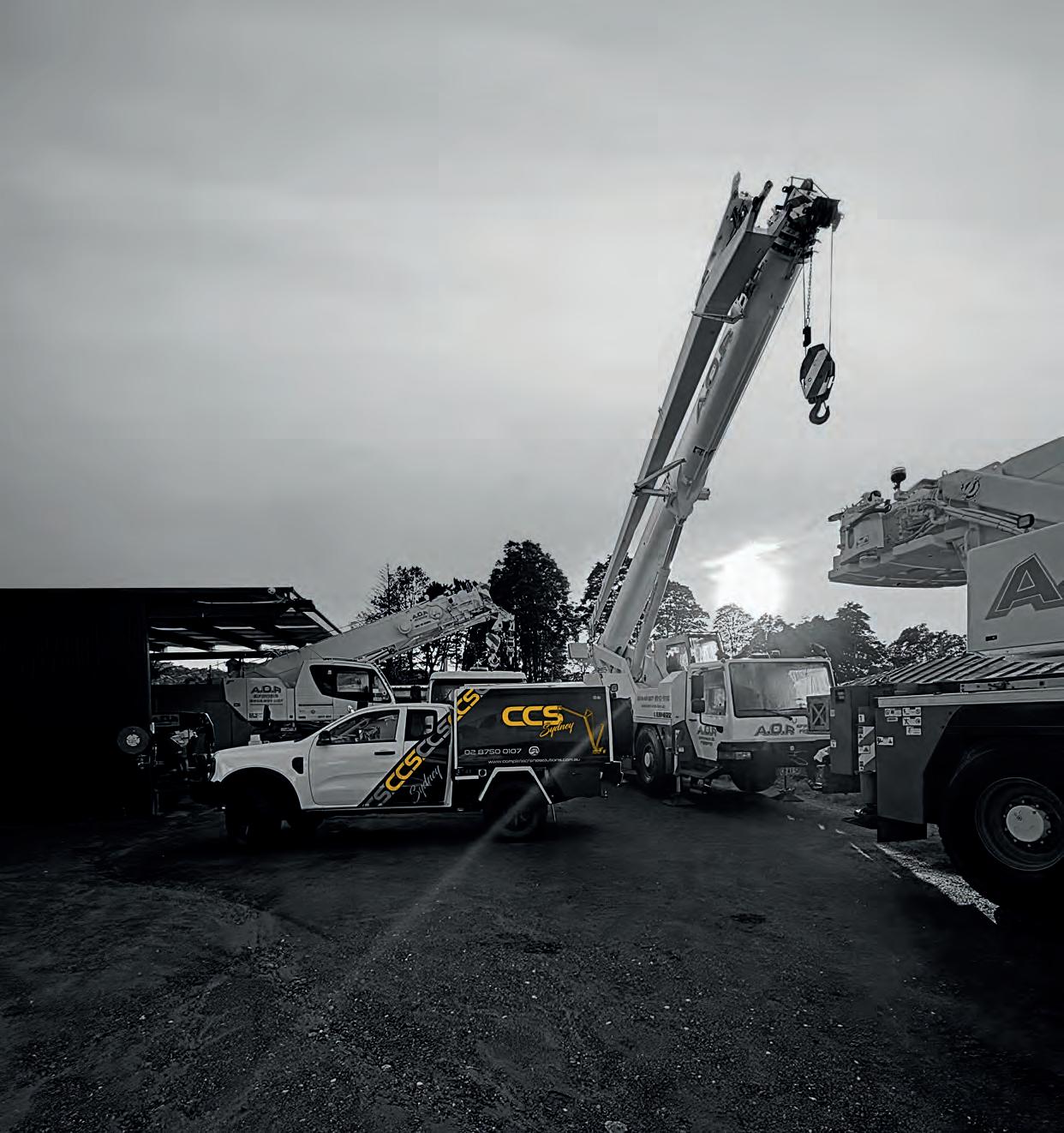
From heavy industry and mining in the Pilbara to marine and infrastructure projects on the East Coast, our team of expert technicians and parts specialists deliver around-the-clock, on-site support you can count on.
We’re more than a service provider — we’re a true partner in keeping your operations moving. OUR SERVICES
Mobile crane repairs & diagnostics

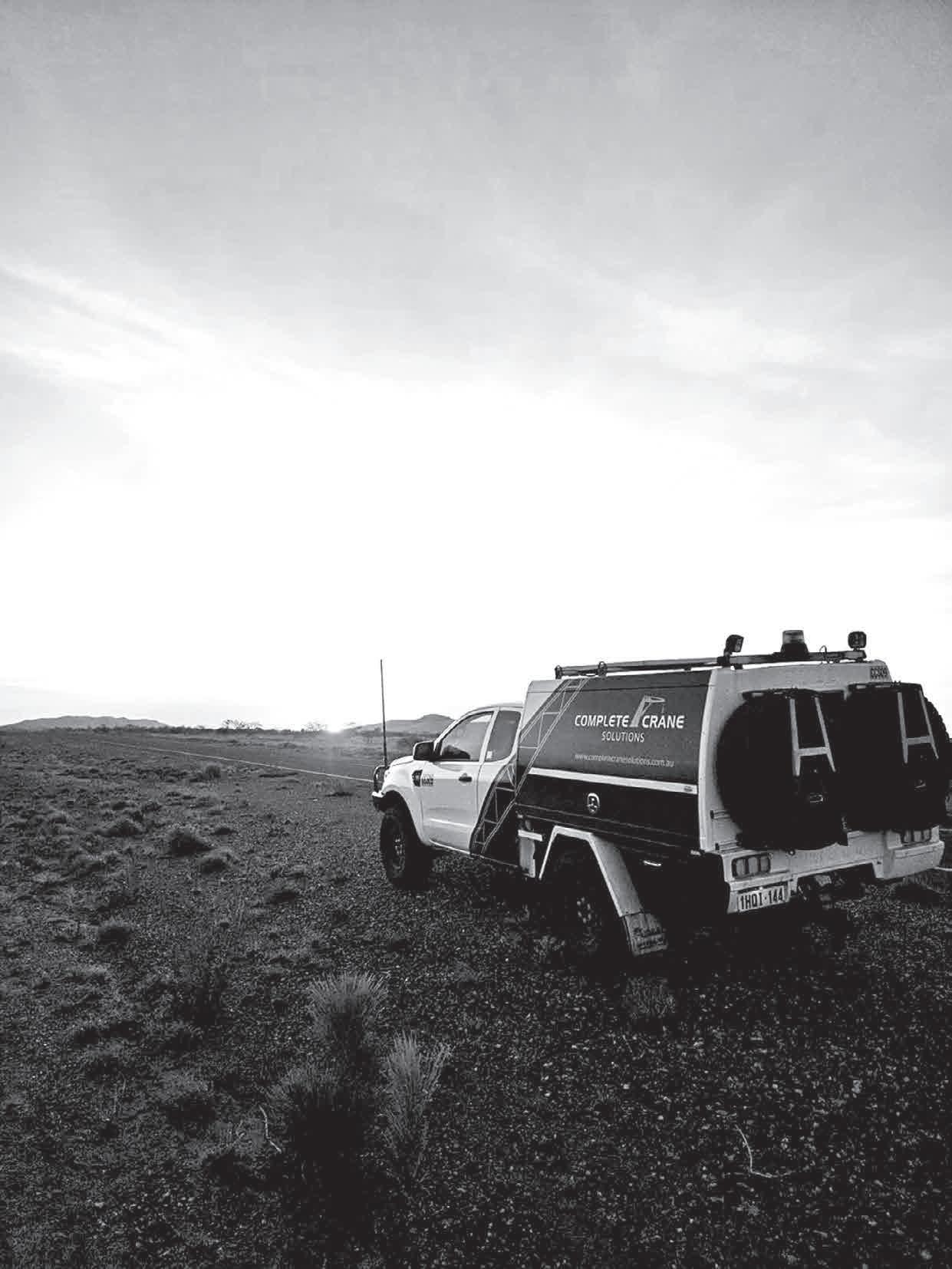
With operations based in Karratha (WA) Perth Metro (WA) Sydney (NSW) & SEQ (QLD), we offer rapid mobilisation and local expertise to meet the demands of Australia’s most challenging worksites.
NEW DIRECTION. EXPANDED CAPACITY. SHARPER FOCUS. As CCS enters a new chapter of national growth, we’re investing in the people, systems, and scale to support major projects, port authorities, and private fleets across Australia.


With growth, accreditation, and unforgettable projects, ANC Cranes is on a remarkable upward trajectory – strengthening its team with industry-leading expertise, expanding its fleet with cutting-edge cranes, and proudly securing ISO accreditation.
and Director Craig Davies, alongside seasoned industry professional Jay Gower, the company is charting an exciting new chapter defined by growth, innovation, and opportunity.
With more than two decades of experience representing global crane original equipment manufacturers (OEMs), Jay Gower brought a wealth of knowledge when he joined ANC Cranes in January. His role is intentionally versatile, ensuring he can contribute wherever the business needs him most – from managing lift studies and site inspections to customer engagement and technical troubleshooting.
“At ANC, titles don’t matter nearly as much as teamwork. I find myself wearing many hats – inspections, safety compliance, supporting the crews, and even helping interpret error codes on Tadano cranes. It’s hands-on, fast-paced, and incredibly rewarding,” Jay shared.
Craig added: “Having Jay on board has been a game-changer. His industry insight, technical know-how, and can-do attitude make him a huge asset to the team.”
This year, ANC Cranes proudly achieved AS/NZS ISO 9001, AS/ NZS ISO 45001, and AS/NZS ISO 14001 certifications – a milestone that not only recognises excellence but also positions the company for even greater opportunities.
Jay explained the decision: “We
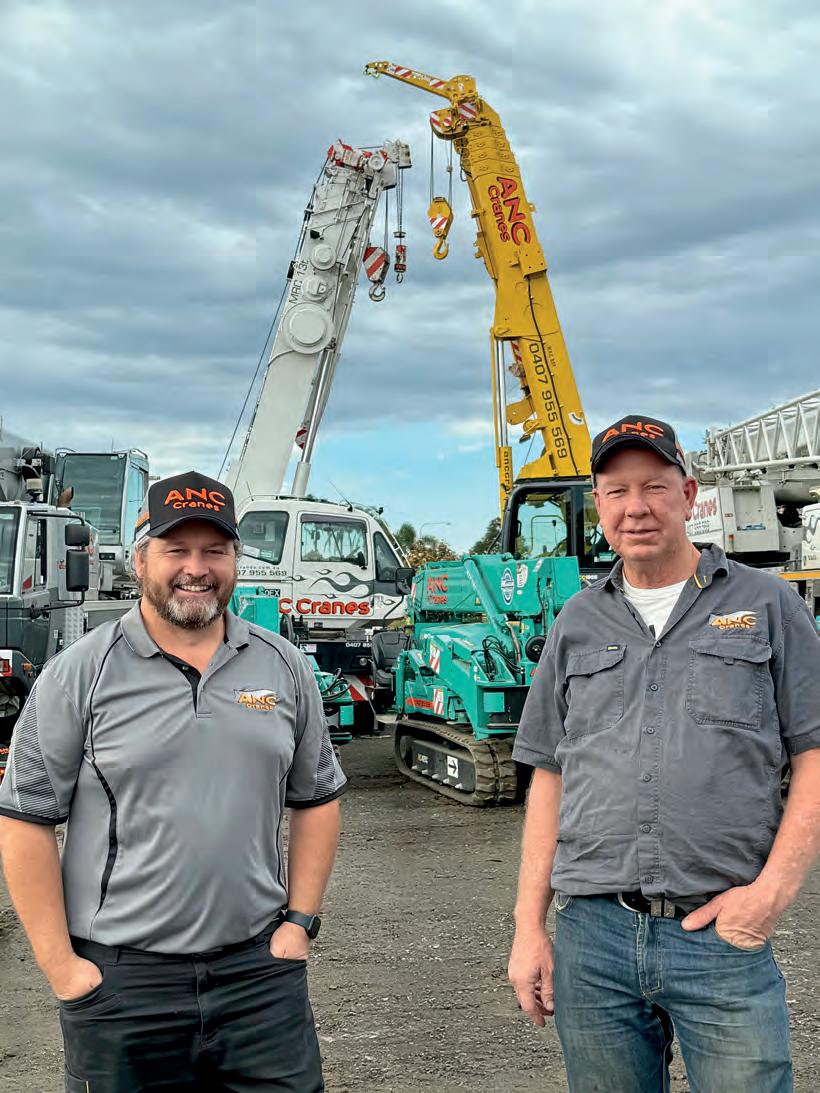
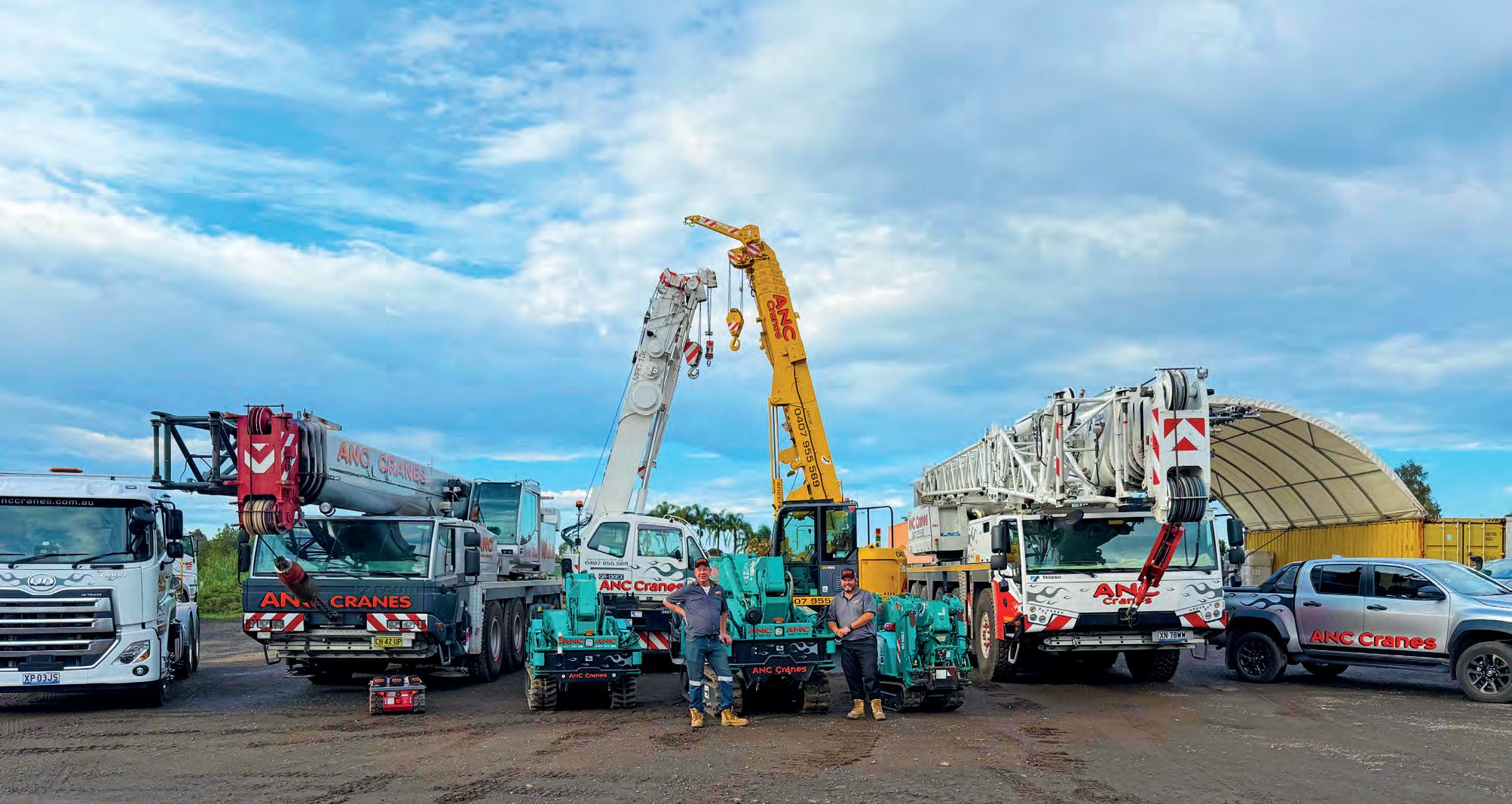
pursued ISO not just for the work we’re doing now, but for the work we want to do in the future. With industry changes from SafeWork NSW and ongoing regulatory updates, we wanted to stay ahead of the curve. By engaging a specialist safety consultancy, we lifted our systems to industry-best practice, putting in place the right framework for long-term success.”
Craig noted the cultural shift it created: “The accreditation process brought everyone together. The whole team embraced the changes – from new safety forms to updated procedures. It wasn’t about ticking boxes; it was about raising our standards as a business. It was inspiring to see everyone step up.”
ANC’s growth is also evident in its cranes. The fleet now stands at 25 cranes, including an impressive
collection of Maeda mini crawlers. New arrivals include an 8TMaeda, a 25T Franna, and a 100T all terrain crane, with a Maeda 174 scheduled to arrive in October.
will number 16, ranging from the 174 through to our 8T crawler.”
“The all terrain purchase from the McPhan family on the Central Coast was perfectly timed – a real win-win.
“We’re not trying to be the biggest, but we are determined to be one of the most trusted and reliable. Our goal is to consistently deliver quality work – safely, compliantly, and efficiently. That’s what sets us apart.”
Craig explained the strategic value: “We don’t see our Maedas in the yard often, which is a great sign – they’re always out working. The addition of the Maeda 174 bridges the gap between our larger mini cranes and smaller jobs, giving customers safer, more efficient options and reducing manual handling risks. With this arrival, our mini crane fleet
And while I resisted adding a Franna for years, Jay convinced me. It hasn’t stopped working since! I used to say, ‘I’m not driving a Franna,’ but now I realise I don’t have to – I’ve got skilled operators for that.”
With ISO accreditation and a strengthened fleet, ANC Cranes is

positioned to secure more complex projects and compete confidently in larger tenders.
“It moves us higher up the list,” Jay said. “We’re not trying to be the biggest, but we are determined to be one of the most trusted and reliable. Our goal is to consistently deliver quality work – safely, compliantly, and efficiently. That’s what sets us apart.”
ANC’s expertise was recently put to the test with one of its most unique projects yet: lifting fullsized dinosaur models into a private backyard in the Blue Mountains.
“The logistics were challenging –from cobblestone driveways to low tree canopies restricting our access and creating barriers to overcome. We had to get creative and use two different cranes,” Jay recalled. “Craig was onsite to help steer the operation,
and it really came down to meticulous planning, teamwork, and quick decision-making.”
The T-Rex and Triceratops, each weighing around 300 kilograms, were positioned safely and precisely, despite the obstacles. The project highlighted ANC’s ability to think outside the box, adapt under pressure, and deliver results that delight customers.
ANC Cranes is more than just a crane hire company – it’s a team united by a passion for excellence, safety, and service. With new expertise on board, an upgraded fleet at the ready, and ISO accreditation elevating its credentials, the company is poised to take on bigger opportunities and continue exceeding expectations.
Craig summed it up best: “We’re growing with integrity, expanding with purpose, and building a reputation we’re proud of. The future is looking very bright for ANC Cranes.”
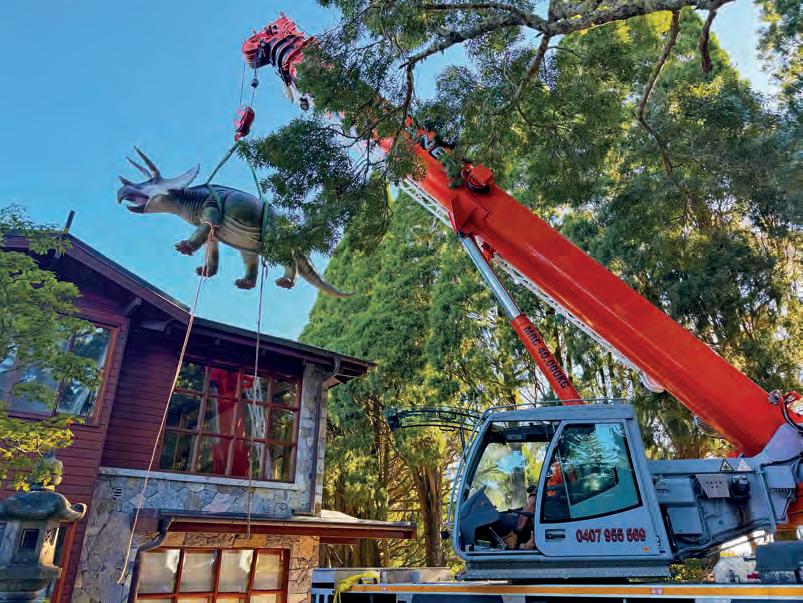
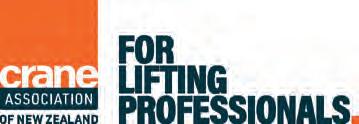

On Saturday 19 July 2025, Wellingtonians were treated to a once-in-a-lifetime spectacle as the Crane Association of New Zealand (CANZ) rolled out a crane parade to celebrate its 50th annual conference.
THE EVENT WAS NOT JUST ABOUT showcasing impressive machines, but also about bringing cranes into the public eye, raising awareness of crane careers, and creating a memorable family day out.
For most people, cranes are glimpsed only from a distance – towering above construction sites, hidden behind fences, and seemingly out of reach. The Crane Parade flipped that script, connecting the community with the industry in a tangible, up-close way. Families could not only see these extraordinary machines moving through the heart of the capital but also get hands-on once they parked up.
The parade aimed to spark curiosity about the world of cranes, inspire future operators, and give the public a chance to celebrate alongside the industry in marking CANZ’s half-century milestone.
The response from the industry was overwhelming. In the lead-up, CANZ confirmed 23 cranes in the parade – with companies still calling the day before, eager to be part of the action. On the day, Wellington delivered picture-perfect sunshine as crowds lined the streets to welcome the machines.
Excitement built as the convoy left the staging area at Wellington Stadium, winding its way through the city and onto Cable Street. As the flashing pilot lights of the cranes appeared, the energy in the crowd was palpable. Children squealed with delight as operators tossed out lollies and merchandise from cab windows, while crane enthusiasts of all ages gathered to watch the slow, powerful procession.
Once parked up on Cable Street, the real magic began. Skilled operators manoeuvred their cranes into place with surgical
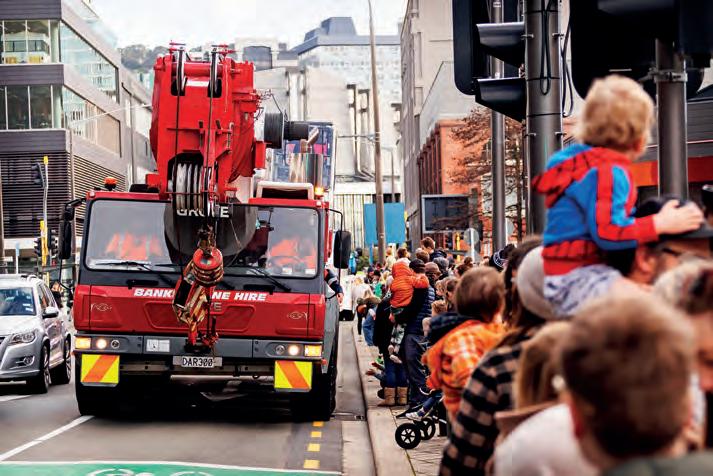
precision, turning the waterfront into a living showcase of engineering excellence. The public wasted no time getting involved – queues 20-deep formed at every crane as kids and adults alike waited for their turn to sit in the cab of these massive machines.
The looks of pure joy on children’s faces as they climbed into the driver’s seat said it all. Parents took photos, operators answered questions, and the atmosphere was one of genuine community celebration.
Feedback from the day has been nothing short of incredible. Families and crane lovers raved about the experience, and requests have already poured in from other cities to host their own crane parades. Wellington locals, too, are keen to see the event return.
The operators and companies involved were thrilled by the turnout and
engagement. For many, it was a chance to proudly share their work with the public and feel that appreciation reflected back. Perhaps the most rewarding moment came when one young visitor asked how they could sign up for a crane apprenticeship – a perfect reminder of why the event was held in the first place.
The Wellington Crane Parade was a fitting tribute to 50 years of CANZ and a glimpse into the future of the industry. It celebrated the machines, the people who operate them, and the communities they help build. Most importantly, it showed New Zealanders that cranes aren’t just construction tools – they’re symbols of possibility, careers of the future, and aweinspiring feats of engineering that capture the imagination of every generation.
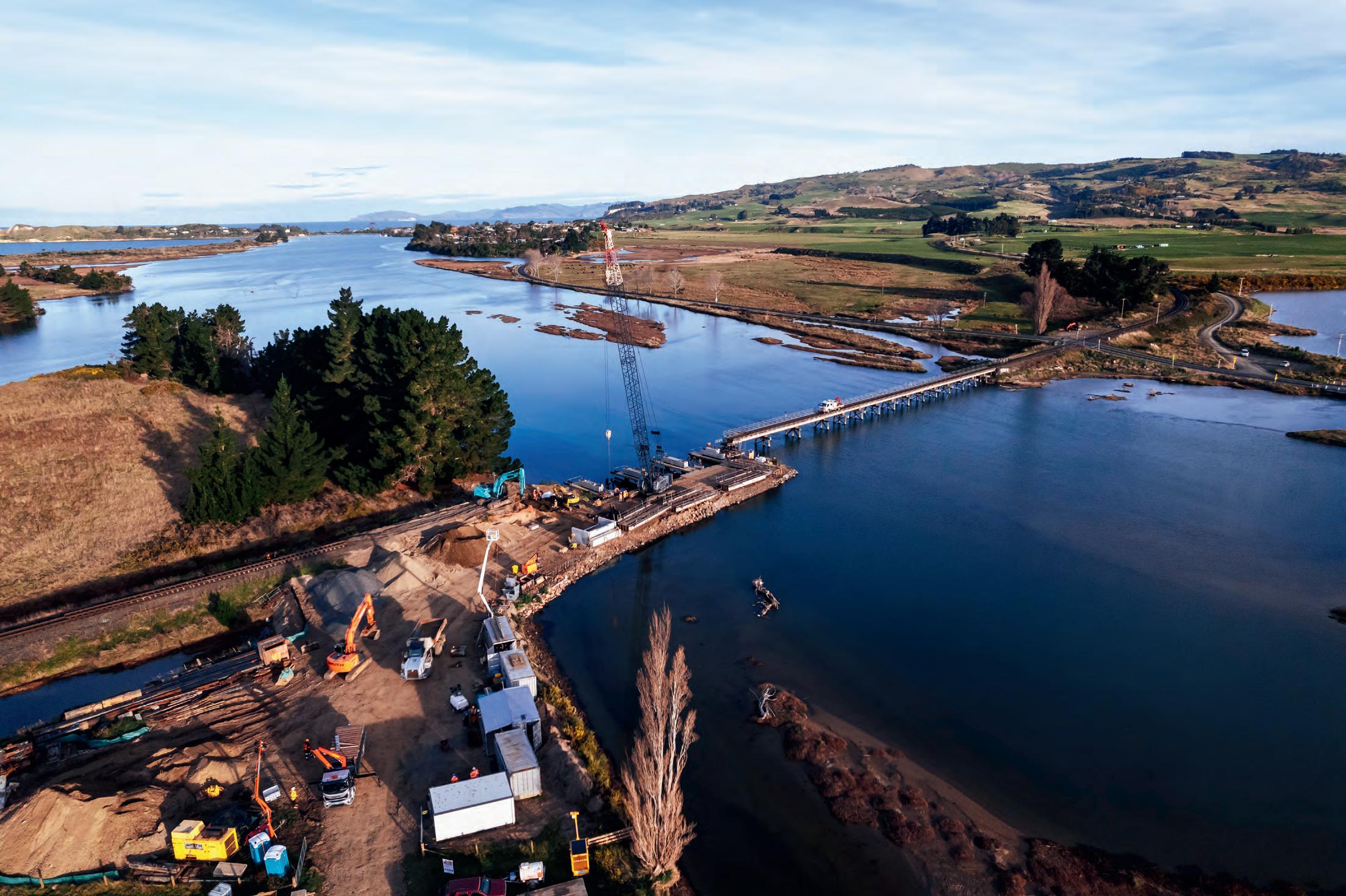
As CANZ looks ahead to the next 50 years, one thing is certain: cranes have never been more loved.


With decades of experience, skilled professionals, and modern equipment, we deliver innovative, safe, and cost-effective solutions for all clients. Our extensive fleet of cranes are available to support all your lifting needs throughout New Zealand.
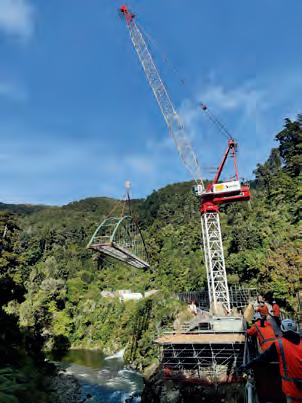
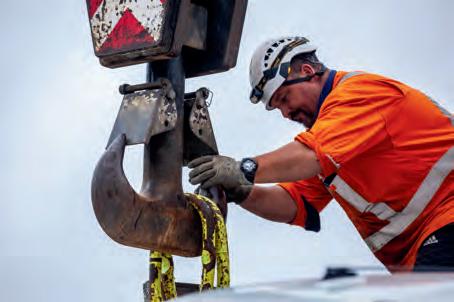
Extensive range of specialised equipment, including ancillary gear, temporary staging, man cages, construction hoists, and more.

With over 30 years in the industry, our team brings proven expertise and practical knowledge.

For Tim Smith, founder of Smith Crane & Construction, the story of cranes is inseparable from family, grit, and a fair share of Kiwi ingenuity.
FROM A ONE-MAN OPERATION WITH A second-hand 20-tonne crane, Smith Cranes has grown into one of New Zealand’s largest crane and construction companies, boasting close to 180 cranes and nearly 300 staff. Now, the company is preparing to add a machine unlike anything else in Australasia – the Liebherr LR11000 crawler crane.
“It’s sort of the peak of my career,” said Tim, with his usual mix of humility and humour. “When you start off with a 20-tonne Kato truck crane and end up with a 1000-tonne crawler, it’s pretty exciting.”
The Smith family’s story goes back to the 1950s, when Tim’s father moved from New South Wales to New Zealand. What began as civil contracting – drainage, culverts and bridges – gradually morphed into crane work. By the time Tim set out on his own, he was determined to chart
a slightly different path. “I bought a little 20-tonne Kato, drove it down from the North Island to Christchurch, and set up as an owner-operator,” he said. “It was just one man and one crane. Then I bought another, and another, and it sort of turned into a bit of a cycle.”
That has since become an empire with 800 pieces of equipment, from excavators to drill rigs, and a crane fleet spanning mobiles, towers, and crawlers. Yet Tim insists the success isn’t just about machines.
“It’s basically the people that work for me. I’ve got great guys – loyal, long-serving, and experienced. We’re still a family business at heart, just on a bigger scale.”
The latest chapter in this growth is the arrival of the Liebherr LR11000, a crawler crane that redefines capability in the region.
The Liebherr LR11000 will give Smith Cranes unparalleled reach for turbines, bridges, and industrial projects.
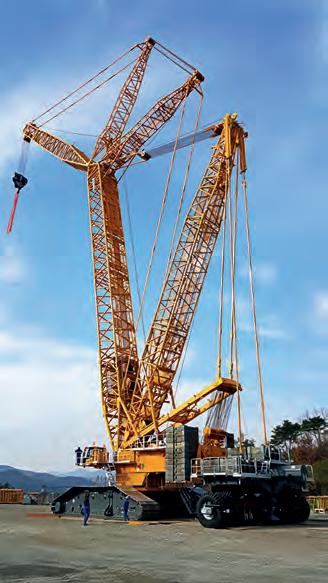
With a lifting capacity of up to 1000 tonnes, a maximum hook height of 220 metres, and a radius stretching 182 metres, the LR11000 sets a new benchmark for heavy and complex lifting.
Tim’s decision to buy the LR11000 was strategic. Smith Cranes could continue tackling wind projects with its Kroll 1650 tower crane, but it would’ve required substantial further investment in ballast, tower, and boom sections.
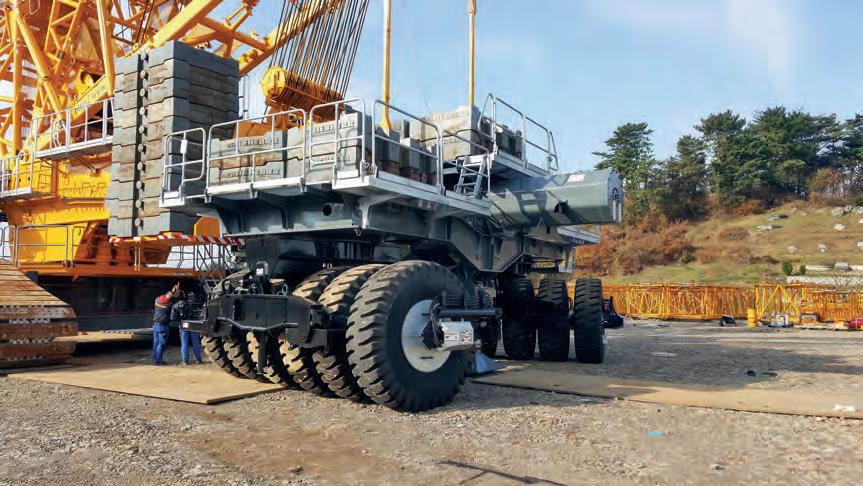
A high-rise commercial building opportunity also emerged, making the case for a large lattice boom crawler. The LR11000 opened opportunities in wind and infrastructure across New Zealand and Australia.
Soon after, it was secured for major bridge-lifting works, previously requiring multi-crane lifts, falsework, and bridge strengthening. With the LR11000, the entire lift can be executed with a single crane, benefiting clients. The crane has arrived in New Zealand and is currently being rigged and tested at Tauranga Port.
The crane was sourced from South Korea, where it had spent its working life on shipbuilding and nuclear projects –
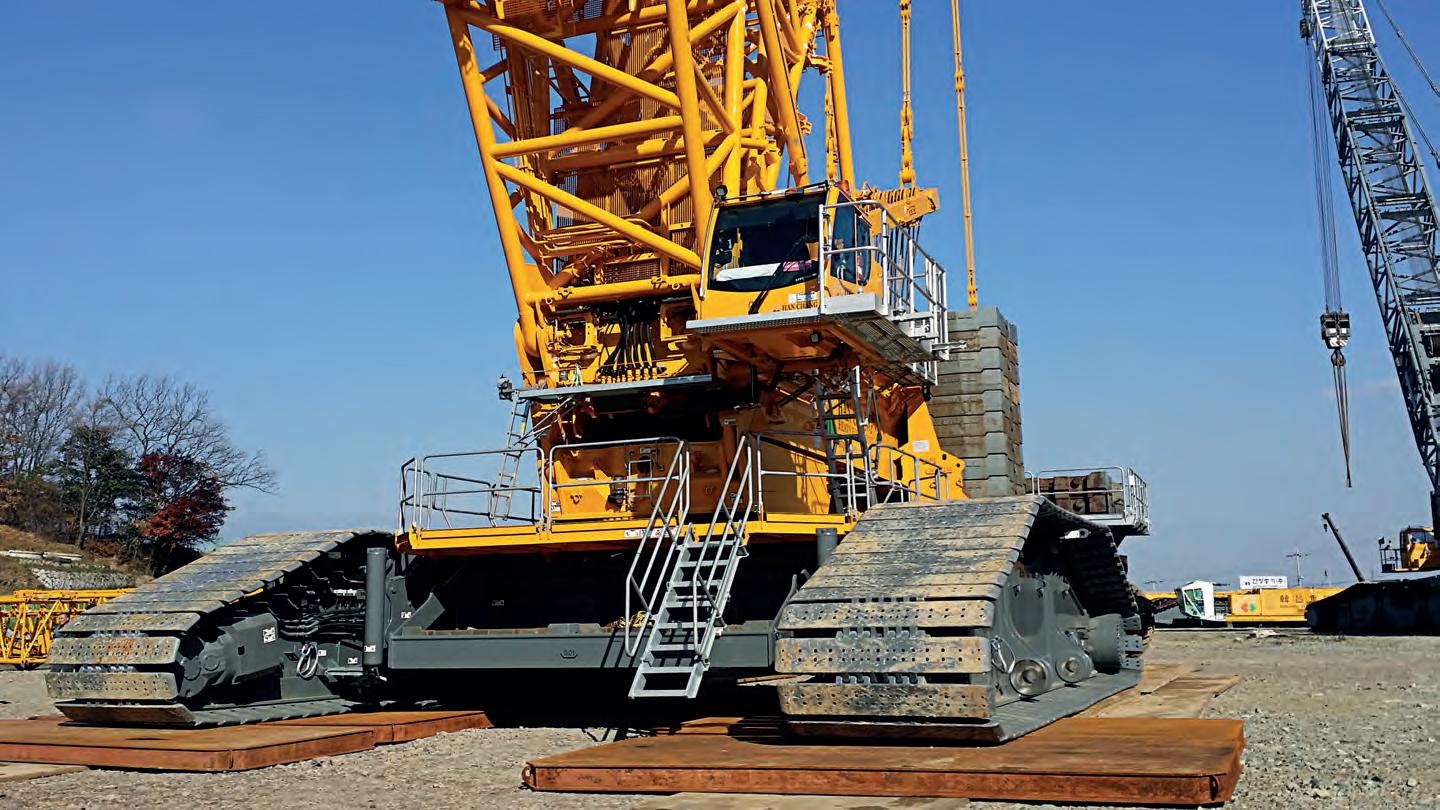

environments that demand precision but don’t wear out machines through constant relocation. “It’s only about ten years old and has low hours. With all the gear that came with it – the superlift, luffers, jibs –it’s well equipped. Cranes aren’t just about size these days, it’s about what fruit you’ve got with them,” Tim said.
The LR11000 was engineered for exactly the type of projects Smith Cranes is targeting. Its wide range of boom and jib configurations allow it to be tailored to different tasks. The M-Wagon ballast system ensures efficient mobilisation and reduced transport costs – a crucial factor when moving a crane of this size around New Zealand’s diverse terrain.
Its first assignments are already locked in. One is at Dargaville in Northland, where the crane will erect a dozen turbines up to 140 metres tall – beyond the reach of Smith’s existing LTR 11200 telescopic crawler. Another job is the replacement of a cyclone-damaged bridge near the city Gisborne in New Zealand.
“With two smaller crawlers, we would’ve needed complicated planning – strengthening temporary bridges, coordinating tandem lifts. The LR11000
makes it simple. One big crane, one lift, and the job’s done. That’s what I like about it – it makes hard jobs easy,” Tim said.
What sets this addition apart is not just its capability but its rarity. While Australia has multiple LG 1750 and LG 1800 cranes, Tim points out there isn’t another LR11000 operating in the region. That, he believes, creates opportunities across the Tasman as wind farms scale up.
“A lot of turbines in Australia are getting beyond what the 1750s and 1800s can handle. There could be a market there for us,” he said. “We’ll see how it goes, but it’s the sort of machine that can open doors.”
Despite the scale of the business, Tim remains grounded. He speaks about his sons joining the business: “I didn’t let them start straight with me. They had to get their own jobs first – one’s a diesel mechanic who’s now operations manager, another’s a builder, another drives trucks. They’re all starting to get involved now,” he said.
The generational mindset extends beyond family. Smith Cranes is well known for training apprentices – currently around
15 to 18 across its workshops. “Every one of my managers was once a crane driver, a mechanic, or a fitter. I like promoting from within. They understand the culture, they’ve grown with the business, and they know how we operate,” Tim said.
That approach has paid dividends. Smith Cranes has repeatedly taken out top honours at the New Zealand Crane Awards, and its operators are considered some of the most experienced in the country.
“We’re not too corporate or complicated. We’re just a family business that’s kept growing. We’re now two or three times bigger than the next guy in New Zealand, but we’re still the same bunch, doing the hard jobs with good people,” Tim said.
With the LR11000 soon to arrive in Tauranga, the company is ready for a new era of lifting – one where bridges, wind farms, and mega-projects across Australasia might all fall within reach of a single machine.
As Tim puts it: “It’s a big step for us. We’ve got the crane, we’ve got the people, and we’re ready to take on the big jobs. If anyone’s got work in New Zealand or Australia that needs a thousand tonnes lifted – give us a call.”
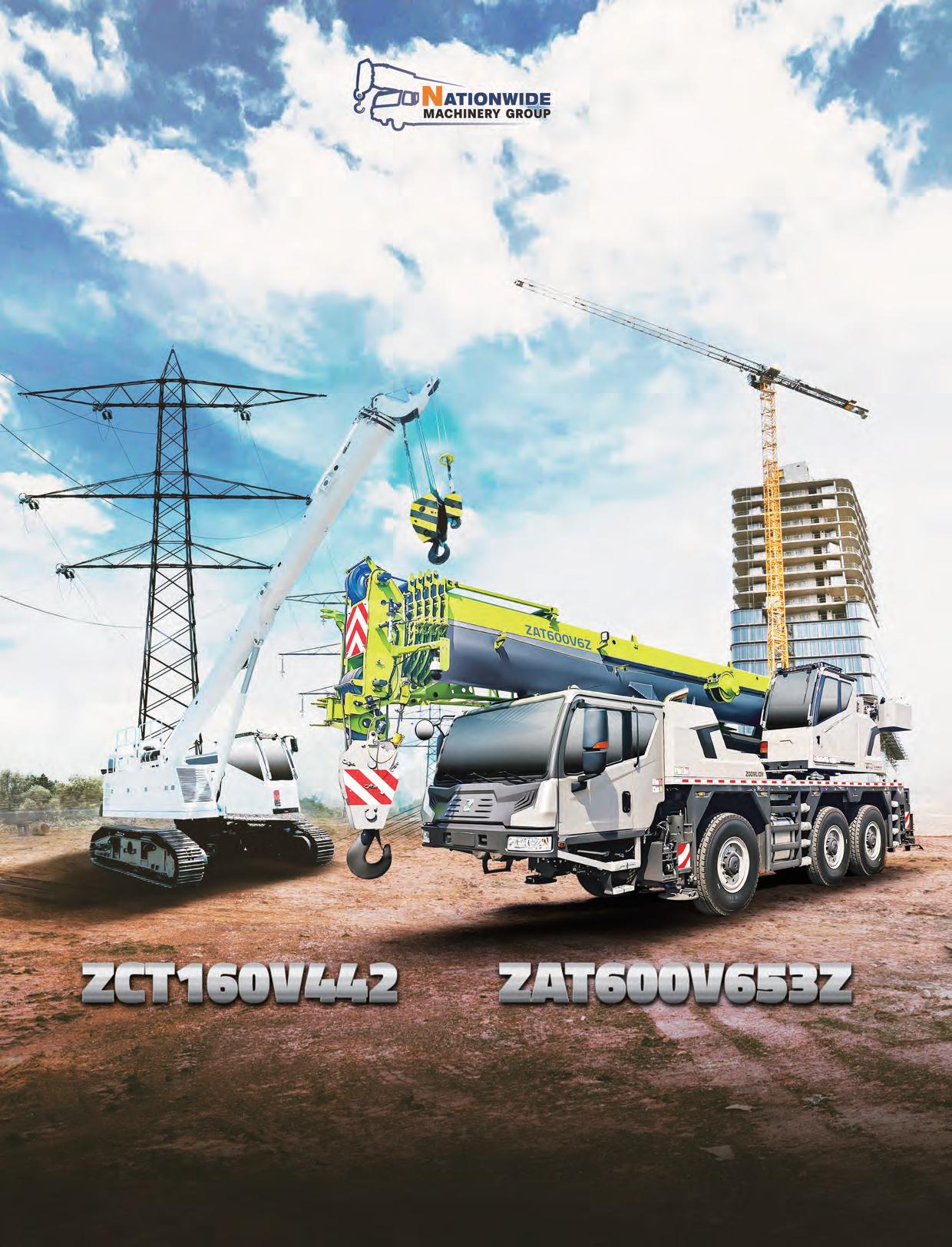


In the lifting industry, even the smallest oversight can have catastrophic results. Routine pre-use checks and scheduled thorough examinations are more than paperwork – they are lifesavers.
construction site in 2018, a crane’s concrete bucket dropped when a missing split-pin allowed the hoist assembly to fail, killing one worker and crippling another. WorkSafe Victoria noted that careful inspections “never occurred,” and that a reasonably practicable check of that pin could have prevented the tragedy. This article explains how simple checks and competent inspections, backed by proper training, safeguard Australian and New Zealand lifting operations against similar failures.
Lifting equipment inspection typically involves three levels: pre-use, interim, and thorough examinations. The first level is the pre-use check, performed by the operator before each lift. This is a quick visual inspection for obvious defects –damaged hooks, deformed links, missing markings, abnormal noises or changes in performance. Any problems found must be reported immediately to maintenance teams. These routine checks form the first line of defence: in a Western Australia mine incident (2014), a cracked sheave was missed during a pre-start check and later catastrophically failed, narrowly missing a worker.
Between pre-use checks and thorough examinations, interim inspections (also called frequent inspections) are conducted. Their frequency and scope are based on a risk assessment and may coincide with routine maintenance or follow repairs. Interim inspections zoom in on high-stress or wear-prone parts (for example, hooks, pins, brakes, ropes) that could fail before the next major exam. Finally, a thorough examination (or periodic inspection) is an
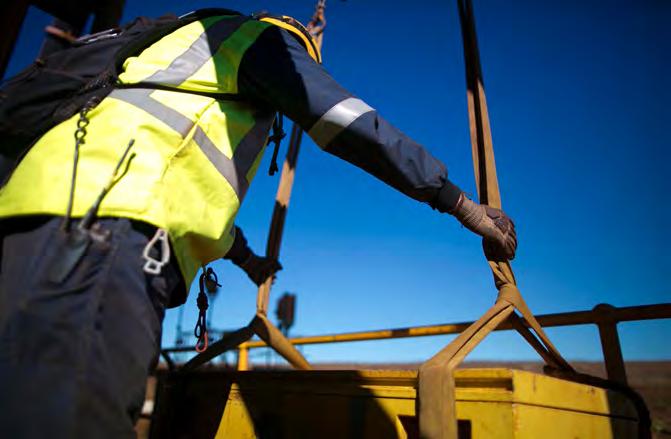
in-depth check carried out by a qualified, independent inspector. This thorough exam often includes measurements, testing or non-destructive evaluation, ensuring the equipment is safe for continued use. Standards such as AS2550.4 (tower cranes) and AS2550.1 (general) specify that thorough exams be done at defined intervals depending on equipment and conditions.
By law, a thorough examination must be done by a competent person – someone with the training, experience and ability to spot defects and understand relevant standards. For example, AS2550.1 2020 requires a competent person to inspect lifting equipment, and inspection reports must be kept. A competent inspector can be an accredited third-party examiner, or a LEEA-certified Lifting Inspector. LEEA’s guidance emphasises that if a defect is found during a thorough exam, it often points to a flaw in the inspection or maintenance regime,, underscoring
the need for inspectors who know what to look for.
LEEA supports competency through training and membership. All LEEA members and accredited companies undergo regular technical audits and training updates to ensure inspectors and users stay sharp. The association offers courses focused on rigging safety, inspection techniques and thorough examination of lifting gear. Users are encouraged to look for the LEEA logo on inspectors or service providers – a badge of competence and industry-best practice. Together, these measures mean inspections are not just a formality but an effective safety check on lifting equipment.
(AUS/NZ LAW)
Under both Australia’s Work Health & Safety Act and New Zealand’s Health and Safety at Work Act, the person conducting a business or undertaking (PCBU) has primary responsibility for plant safety. This includes cranes, hoists, slings and all lifting

accessories. The duty holder must ensure, so far as is reasonably practicable, that the equipment is safe and subject to proper testing and inspection. They must provide information, training and instruction to staff, maintain the equipment, and ensure inspection reports are recorded. Importantly, WHS law dictates that these duties cannot be transferred – a PCBU remains responsible even if inspections are subcontracted to others.
In New Zealand, crane controllers are explicitly required to ensure cranes have current inspection certificates issued by recognised inspection bodies. In Australia, regulations often prescribe periodic major inspections for registered cranes. For example, WorkSafe guidance notes that major crane examinations must include detailed visual inspections of all structural and wear components (brakes, ropes, sheaves, etc.) for corrosion and wear. Duty holders must also keep records of all tests, inspections and maintenance, and act promptly to remedy any defects identified.
• Victoria 2018: A tower crane’s concrete bucket fell to the ground after a missing split-pin in the hoist assembly worked loose. One worker was killed and another critically injured. The operator was fined $400,000; WorkSafe investigators noted that a thorough inspection when the crane was installed would have caught the missing pin.
• Queensland 2025: A tower crane’s hoist rope and hook assembly collapsed and dropped 10 metres. Investigations found significant corrosion on a swivel bolt due to harsh coastal conditions –corrosion that should have been detected during inspections. The crane had passed its annual check just two months earlier, highlighting the importance of competent, detailed examinations and perhaps more frequent checks in adverse environments.
• Western Australia 2014: At a mine site, a mobile crane sheave (rooster sheave) suddenly failed while slewing under load. A post-incident review found that the sheave had pre-existing
damage that daily pre-use checks had failed to identify. The two-kilogram nylon fragment narrowly missed a rigger below. This case shows how even routine operator checks must be thorough.
• New Zealand 2022: A Rotorua precast yard used a homemade mobile crane (converted from an old log skidder) with no formal inspection certificate or safety devices. A 17-year-old worker was struck by a swinging 412kg beam and badly injured. WorkSafe NZ observed “the crane should not have been operational” and warned businesses to “regularly check all their equipment” – especially older or modified gear.
Each of these incidents stemmed from missed or improper inspections. In every case, diligent checks by trained personnel could have identified the fault before it became catastrophic. In the words of one NZ regulator, “businesses must manage their risks. This includes regularly checking all their equipment to check it’s fit for purpose and compliant”.
LEEA’s Code of Practice (COPSULE) is a free resource that lays out best practice for lifting inspections worldwide. Section 1 of the latest COPSULE covers inspection intervals, roles (users, maintenance staff, examiners) and responsibilities. By consulting COPSULE (alongside local standards), Australian and New Zealand businesses can align with global best practices.
LEEA membership further helps users meet their obligations: members gain access to expert advice, regular technical updates and tailored training on lifting safety. Whether through LEEA’s accredited courses or its library of guidance documents, lifting operators can ensure they understand and fulfill the inspection and maintenance duties required by law.
‘Small checks’ at the start of each lift and scheduled thorough examinations have big safety payoffs. Operators, supervisors and duty holders in Australia and New Zealand must implement robust inspection
1. WorkSafe Victoria – I ncident: Crane bucket fall due to missing split-pin (2018). https://www.worksafe.vic. gov.au/news/2021-03/clark-cranesfined-over-fatal-crane-collapse
2. SafeWork Australia – Managing the Risks of Plant in the Workplace Code of Practice. https://www. safeworkaustralia.gov.au/doc/ model-code-practice-managingrisks-plant-workplace
3. A S2550.1-2020 – Australian Standard: Cranes, hoists and winches – Safe use – General requirements. (Available through SAI Global, not freely accessible online)
4. L EEA COPSULE – Section 1 – Code of Practice for the Safe Use of Lifting Equipment (2024). https://leeaint. com (available via LEEA membership or authorised distribution)
5. WA Department of Mines, Industry Regulation and Safety – Safety Bulletin: Crane rooster sheave failure (2014). https://www.dmp.wa.gov.au/ Documents/Safety/MSH_SB_144.pdf
6. WorkSafe Victoria – Safety Alert: Soft sling failure due to improper inspection/use. https://www. worksafe.vic.gov.au/safety-alerts/ soft-sling-failure
7. WorkSafe Queensland – Incident Report: Tower crane failure and hoist drop (2025). https://www.worksafe. qld.gov.au (Specific case report may be available upon request or FOI)
8. WorkSafe New Zealand –Prosecution: Homemade crane incident in Rotorua precast yard. https://www.worksafe.govt.nz
9. H ealth and Safety at Work Act (NZ) – Duties for PCBU and inspection responsibilities. https:// www.worksafe.govt.nz/laws-andregulations/acts/hswa/
10. L EEA – Training & Competence Programs. https://leeaint.com/ training
regimes. Working with competent inspectors (for example, those trained via LEEA) and following regulators’ codes ensures compliance with WorkSafe/ Victoria, SafeWork NSW and WorkSafe NZ expectations. As one regulator put it, ensuring lifting equipment is safe is a fundamental duty of care. By treating routine inspections as integral to all lifting operations, companies turn liability into assurance – preventing the next preventable accident.
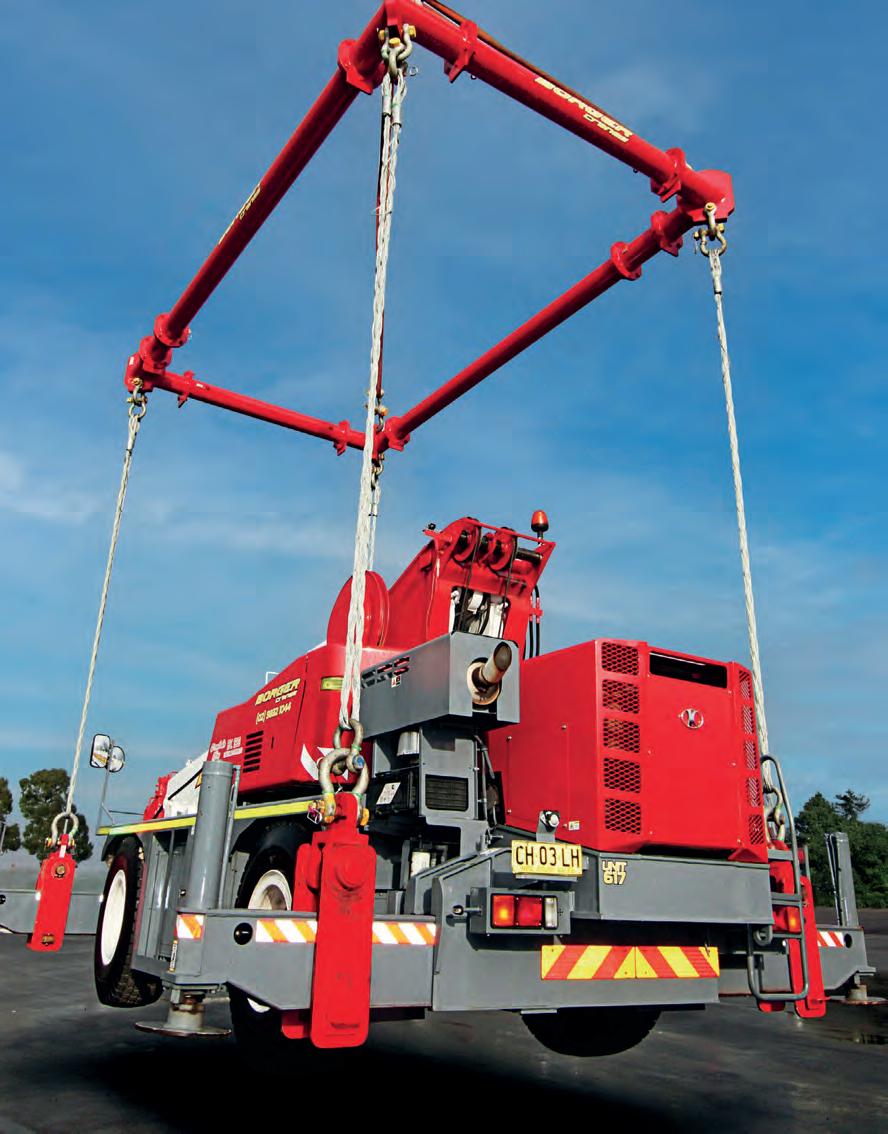




SUPERFLEX SLINGS
SUPERFLEX STROPS
DOUBLE ENDED STROPS
STEEL FLAT WOVEN SLINGS
DEAN-0 SLING
“ YOUR FIRST CHOICE IN LIFTING ”
SUPERFLEX “YOUR FIRST CHOICE IN LIFTING”


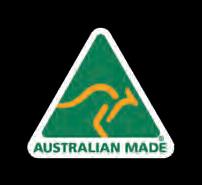
Marr Contracting (Marr) has become the first business in the world to implement new crane safety technology, The Buddie System, on two Sydney construction projects.
MARR CRANE CREWS WORKING WITH Parklife D&C Joint Venture on c onstruction of the new Sydney Metro Airport Terminal Station, and with Richard Crookes Constructions on the Sydney House mixed-use development, (former City Tattersalls Club site) in the Sydney CBD were the first to trial the system in a live environment.
Developed by experienced crane industry professionals Gary Panagiotidis and Jade Harris, The Buddie System is designed for crane operators and dogmen / slinger signallers to reduce the risk of
accidents caused by two-way radio issues or miscommunication between crane crews.
With up to 30 per cent of crane accidents (Crane Accident Statistics: Market Data Report 2025 ) involving miscommunication between operators and ground crews, The Buddie System has real potential to prevent injuries and fatalities on construction sites. The wireless safety alert device overcomes the shortfalls of existing two-way radio technology by allowing dogmen to instantly alert crane operators to stop if something goes wrong.
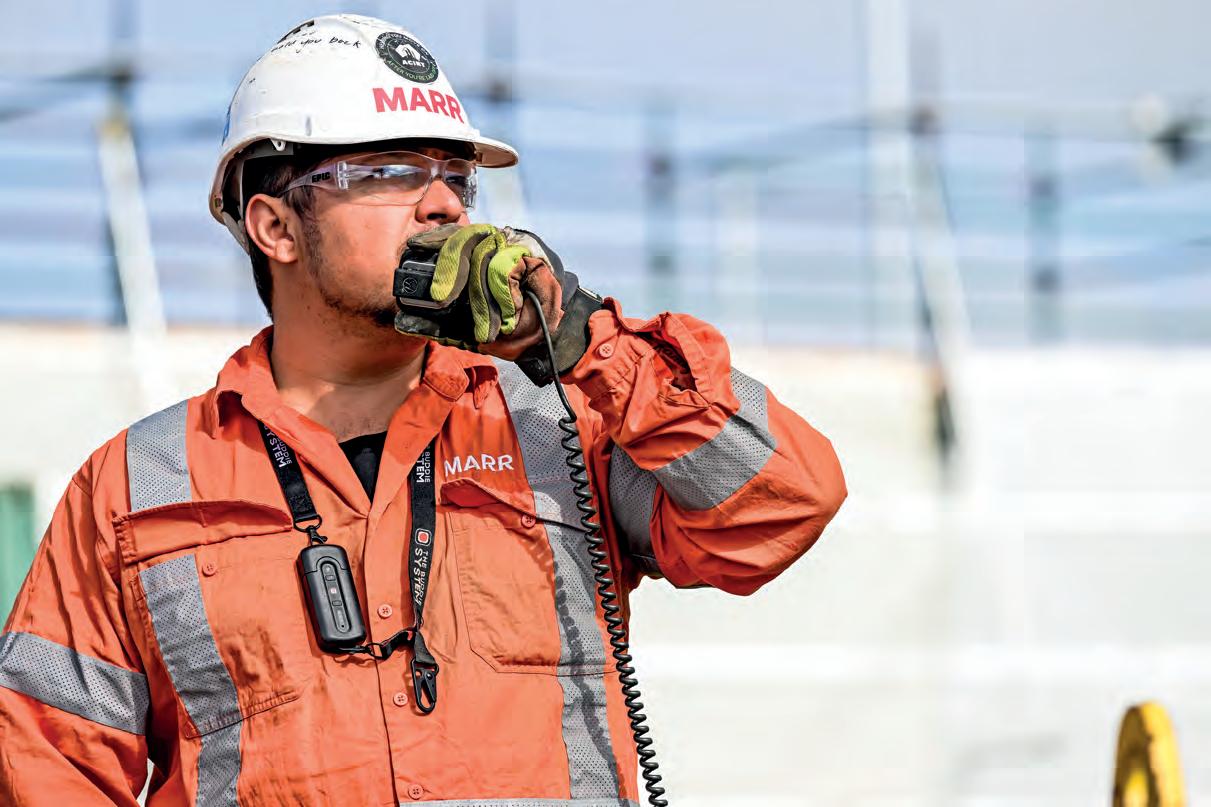
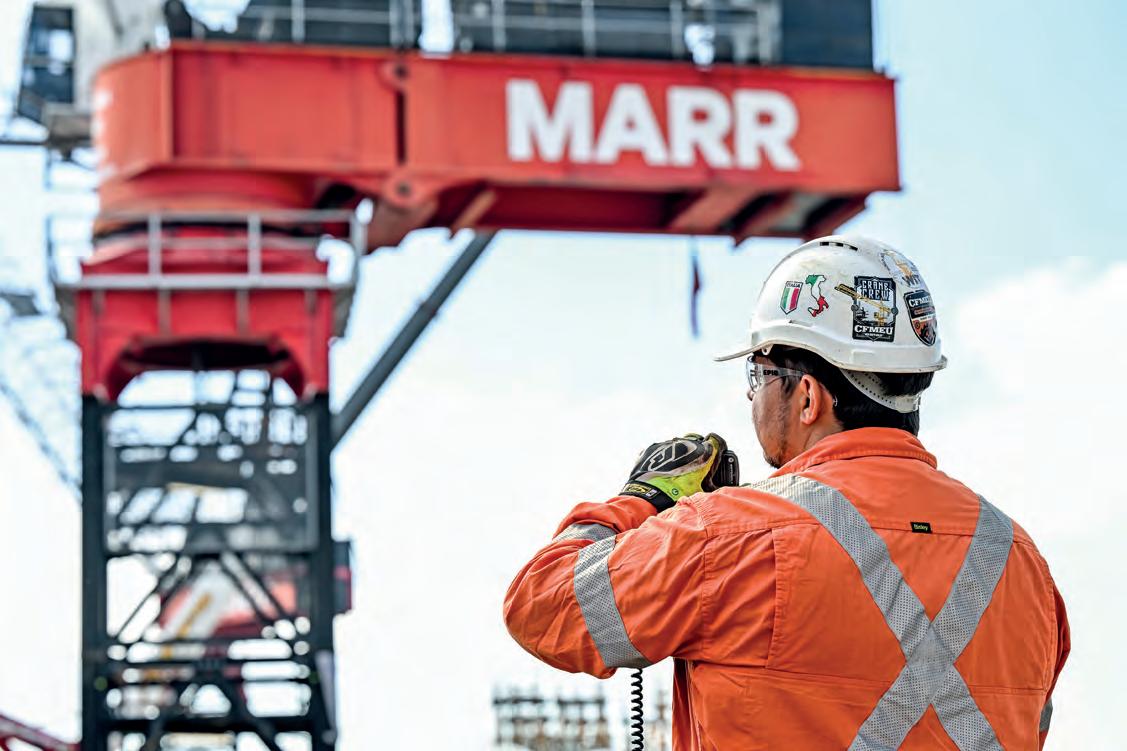

“I’ve
been in the industry for 30 years and Marr has always stood out as a company that leads from the front when it comes to innovation and safety.”
“Safety is always our number one priority and with The Buddie System we have an innovative solution to a common safety issue on construction sites,” said Marr’s Managing Director, Simon Marr.
“What we love about it is its simplicity and the fact that it was designed by people who’ve worked on the tools and understand the real risks of crane and lifting operations,” Simon said.
The Buddie System was officially launched at the Crane Industry Council of Australia (CICA) Conference with Marr the first to trial the system in a live environment.
With strong interest from crane owners and operators in Australia, the United Kingdom and other markets, Marr’s implementation on a large-scale infrastructure greenfield site and innercity high-rise environment is paving
the way for others in the industry to follow suit.
“We couldn’t have picked a better launch partner than Marr,” said Gary Panagiotidis.
“I’ve been in the industry for 30 years and Marr has always stood out as a company that leads from the front when it comes to innovation and safety.”
“Big cranes, big lifts, and big responsibilities. Marr’s reputation is built on getting all three right,” added Jade Harris.
“Their willingness to be first to adopt this technology proves they’re serious about safety.”
Following the success of the trial, Marr intends to roll out The Buddie System across its fleet in Australia and the United Kingdom over the coming months.
Marr Contracting is a world leader in the design and delivery of heavy lift luffing tower cranes and heavy lifting services. With almost 100 years’ experience working on large-scale construction projects in Australia and around the world, its expertise spans the large-scale construction, mining, oil and gas, power, nuclear, major transport infrastructure, technology and marine sectors. Not just a crew and cranes for hire, it offers big thinkers and problem solvers who love a challenge with a string of ‘world firsts’ to their name – including the world’s highest capacity tower crane, the Marr 2480D Heavy Lift Luffing (HLL) crane. www.marr.com.au
The Buddie System (TBS) is a wireless instant safety alert device designed for crane operators and dogmen/ slingers enabling rapid alarm activation in emergencies. The TBS device overcomes the shortfalls of two-way radio failure and often inaudible backup whistles.
The TBS device allows a dogman/ slinger to instantly transmit an alarm signal to a crane operator to stop. A quick snap on the TBS lanyard activates the alarm. www.thebuddiesystem.com
With staff loyalty running well above industry averages, Liebherr has created a culture where people grow, stay, and thrive.
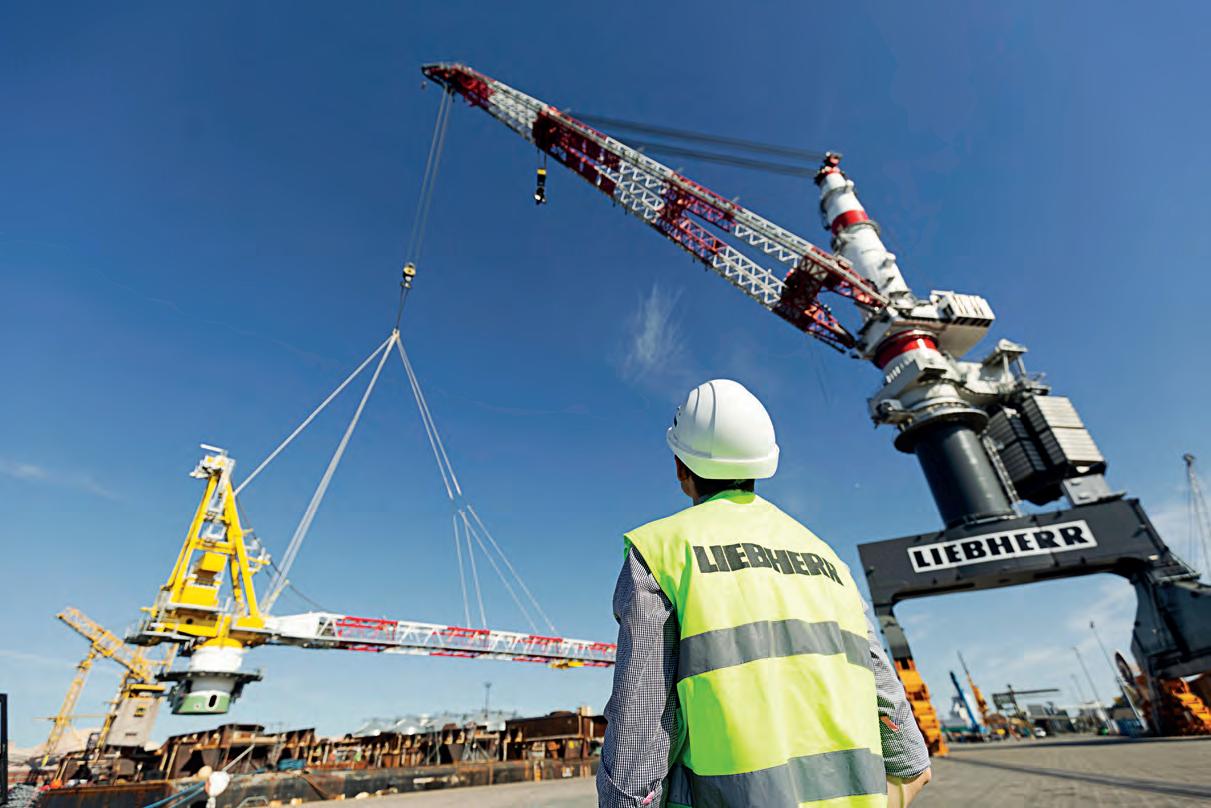
Ask anyone new to the heavy equipment industry what they’re looking for, and the answer is usually the same: stability, growth, and the chance to do meaningful work. At Liebherr, those opportunities are built in.
FROM APPRENTICESHIPS TO LEADERSHIP roles, the company has created a culture where people don’t just work with cranes and machinery – they build lasting careers.
Most people recognise Liebherr for its cranes or excavators, but the brand stretches far wider. With business interests in mining, construction, aerospace, refrigeration, and even hotels, Liebherr is one of the world’s most diverse industrial groups. For employees, that diversity is a source of confidence.
“Because of the diversity within our company, we are somewhat protected. Not against everything, of course, but
having so many different industries in play ensures our people feel secure,” said Andrew Wilder, the General Manager of Maritime & Construction Cargo (MCC) division in Australia.
Dino Mosca, the National Service Manager of the Mobile and Crawler Crane division, echoed the point. “It’s a big company, and there are many opportunities for people within the business. We recruit purely for the long term. People generally come for a career, not just a job,” he said.
Employee loyalty is a hallmark of Liebherr in Australia. Staff tenure across its divisions outpaces the national average,
with many employees staying for more than a decade.
“Our average employee tenure might say four years, but if you take out those who’ve joined recently, the average quickly climbs to six or eight years,” Andrew said. “Longevity is built into the culture here. Many of us, myself included, have been with the company for over a decade.”
That retention is not by chance. Both leaders point to the balance of global scale and local independence. “What differentiates us is our ability to act independently,” Andrew said. “We can make decisions quickly for the best interests of our team and our customers. That flexibility makes a big difference.”
For Dino, the appeal is in the smallteam structure. “We’re a large division, but we’re broken down into smaller groups where you have that close relationship among your team. It’s a good culture, and it’s one of the biggest reasons people stick around,” he said.
Liebherr places strong emphasis on developing talent internally. Dino said that starting as an apprentice is often the
best way to progress. “We have many team members who’ve moved from apprenticeships into leadership positions. With roles like service coordinators or technical advisors, it’s critical to start with that foundation of product knowledge,” he said.
Andrew highlighted similar stories in his division. “We’ve got people who started in junior roles and are now in management. Even if they move between divisions, they remain within Liebherr. That continuity means we don’t lose talent, and people know they can grow with the company,” he said.
For staff, career growth is supported by extensive training. Technicians frequently travel to Liebherr factories in Germany, Austria, or Ireland for advanced programs, sometimes spending weeks overseas.
“We invest heavily in training packages. Our technicians may travel once or twice a year to complete specialised courses,” Dino said.
The focus is on equipping people not only for their current roles but also for future opportunities. “Even if someone wants to step off the tools and move into training or technical advising, we support that,” Dino said.
Not every career path looks the same, and Liebherr’s global and sizeable local presence means there is space for different lifestyles. In the maritime sector, for instance, some roles involve offshore work – flying out by helicopter and spending weeks at sea.
“It’s well-paid and offers a unique lifestyle. For those who want travel and variety, it’s a great fit,” Andrew said. For others, the appeal is in transferring between divisions. Employees have moved from apprenticeships in workshops to technical advisory, or from mobile cranes into sales. That flexibility, according to both leaders, keeps careers dynamic and ensures employees remain within the company.
As the industry evolves, Liebherr is preparing for new kinds of roles.
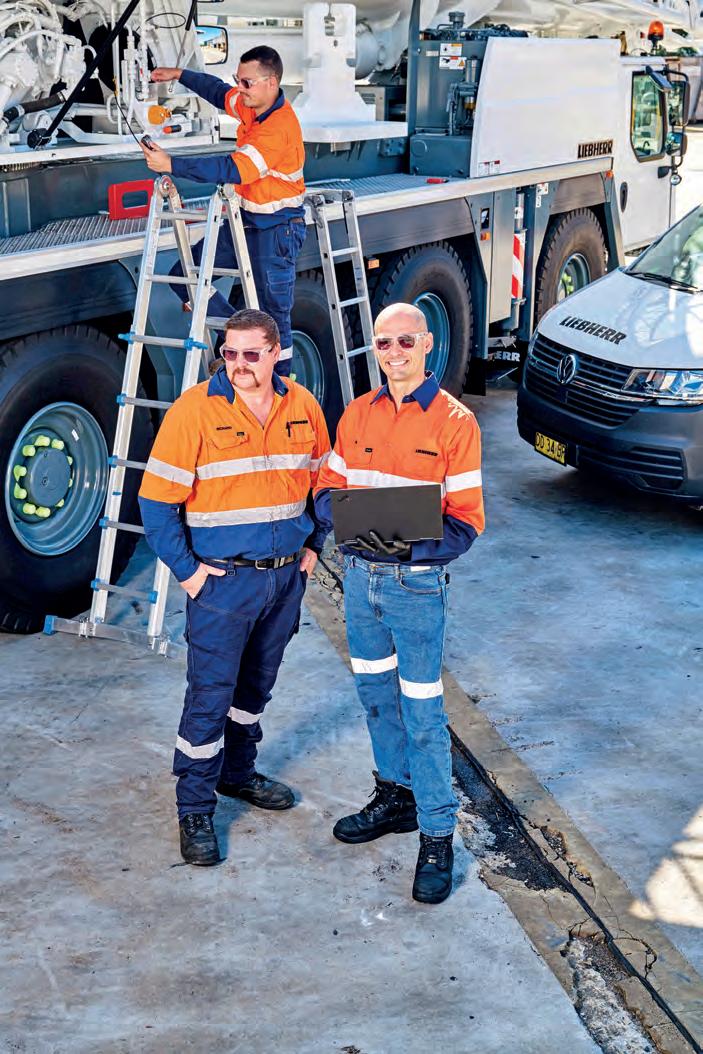
Andrew sees opportunities in training and technology. “We need to empower customers as much as possible, and training roles are a way for experienced technicians to step off the tools. There’s also the technology side –artificial intelligence is becoming part of our business, and that’s an exciting opportunity,” he said.
Dino added that whatever the role, the company’s culture remains the constant. “When you come on board, you’re part of the family. We’re not delivering services that make people instantly happy – we’re solving problems. That takes the right
kind of team, and people here genuinely want to stick around and help,” he said.
Liebherr’s machines are recognised worldwide, but behind them is a workforce that reflects the company’s values: stability, growth, and commitment. By combining global resources with local independence, Liebherr has created an environment where people don’t just work, they thrive. For anyone considering a career in cranes, mining, maritime, or beyond, Liebherr shows that the heavy equipment industry isn’t just about machines. It’s about people, and the futures they can build.

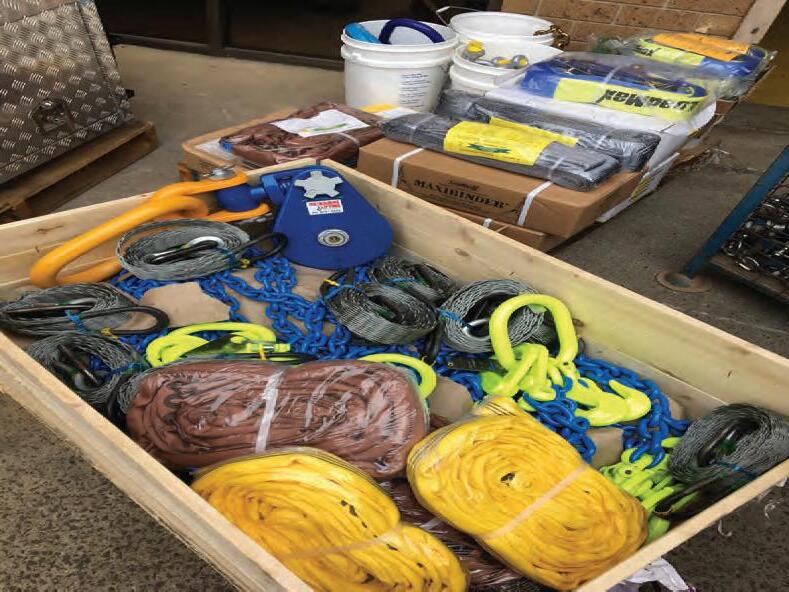
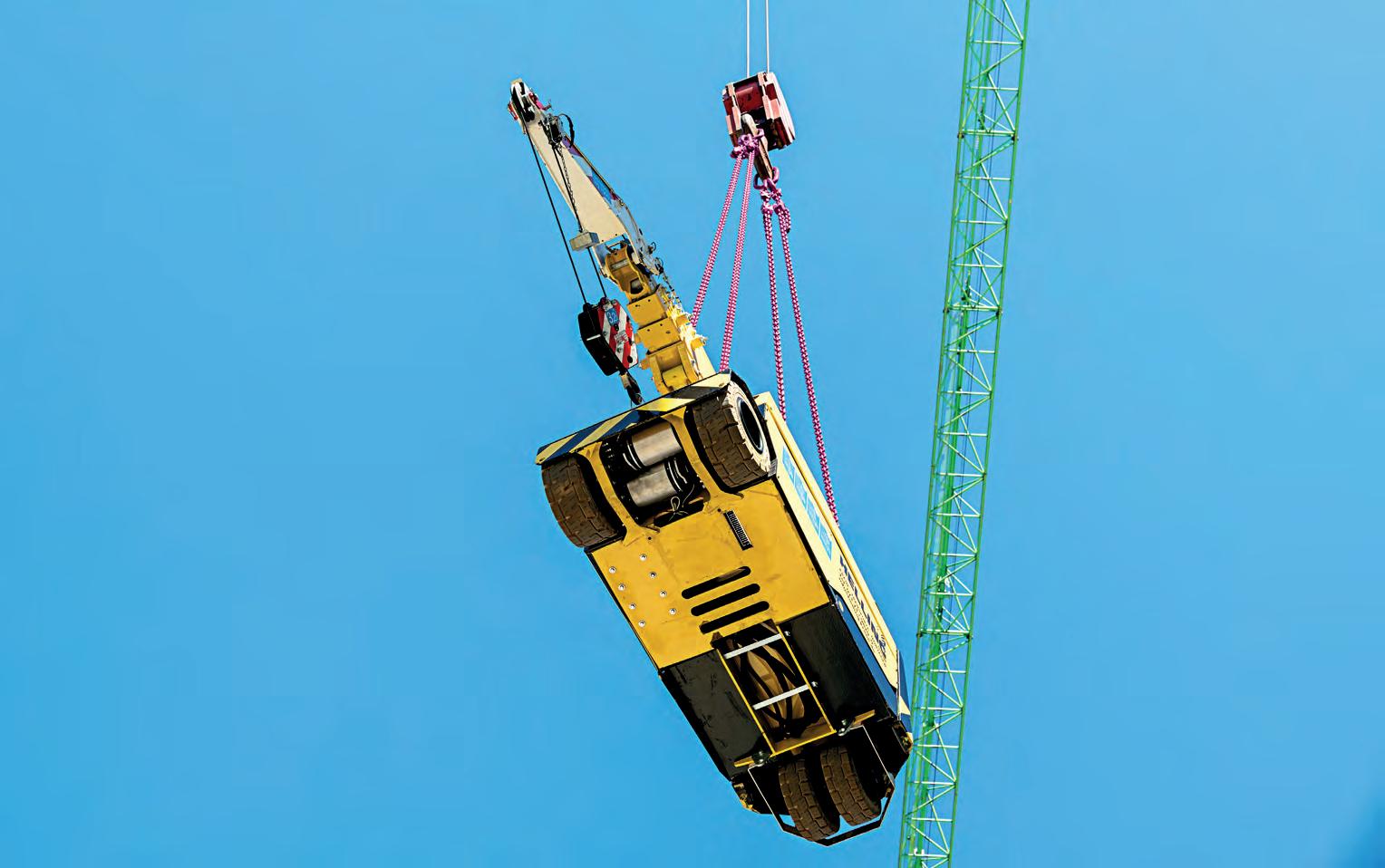
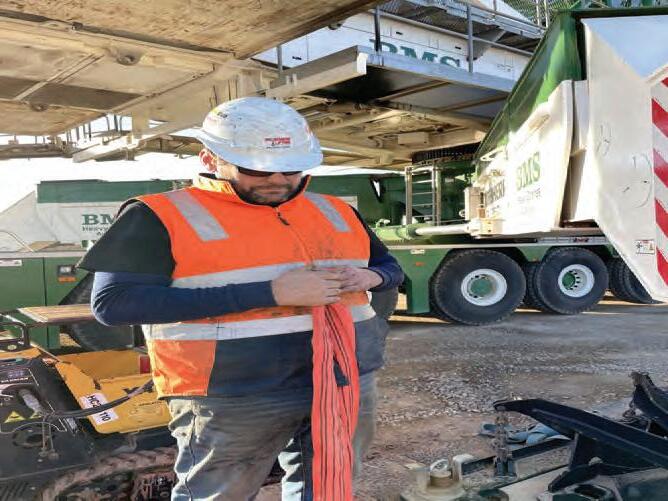



Founded in Germany in 1875 and celebrating 150 years in 2025, the RUD Group is one of a global leader in chain technology and lifting solutions, with over 1700 employees and products sold in more than 140 countries. RUD was founded by the Rieger family who continue to blaze a path with a strong legacy of innovation, quality and technical excellence.
RUD AUSTRALIA WAS ESTABLISHED in 1984 and has been led by the Nuttall family since inception. It has been supporting the crane industry with innovative lifting and lashing solutions for the past 40 years through local offices across Australia and New Zealand.
RUD’s focus on safety is exemplified by the quality of its products, especially the ICE 120 chain slings which are manufactured to meet the highest safety standards for crane operators and on-site staff.
Mark Read, Director of SureLift Crane Hire, a long-term RUD customer, attests to the quality of RUD’s chain slings, labelling them the “best chains in the industry”.
SureLift Crane Hire, which started with one crane in Moranbah, Queensland, now operates more than 16 cranes and exclusively uses RUD
products because of their performance which Mark believes “embodies the message of safety.”
RUD Australia has an advanced 6000 square metre engineering and manufacturing facility in Brisbane which offers bespoke lifting and material handling solutions for the crane industry. The production facility includes expanded positional robotic welding technology and multiple 200/500-tonne test beds ensuring quality work that exceeds industry standards.
RUD provides customised lifting kits and lashing solutions for the crane industry. RUD’s ICE 120 chains can be tailored to meet specific site requirements. The ICE Grade 120 chain is 30 per cent lighter than grade 80 which is a critical safety factor. Additionally, a RUD ICE 16 millimetre chain, when used with a balancer,
can lift up to 48 tonnes – the highest in its capacity class. Mark highlights the balancer as a “huge point of difference” that allows higher capacity lifts while maintaining safety.
Brisbane-based Hulk Lifting, consistently turns to RUD for lifting and lashing solutions. “Knowing that we’re using RUD’s products provides us with a sense of comfort and reassurance,” said Ben Rose, Director of Hulk Lifting. “RUD really are ‘bestin-show’ for us: through the design, manufacturing and final build stages; everything is simply top-notch.”
RUD designs and manufactures a range of lifting and spreader beams locally, specified to customer applications. It also offers more than
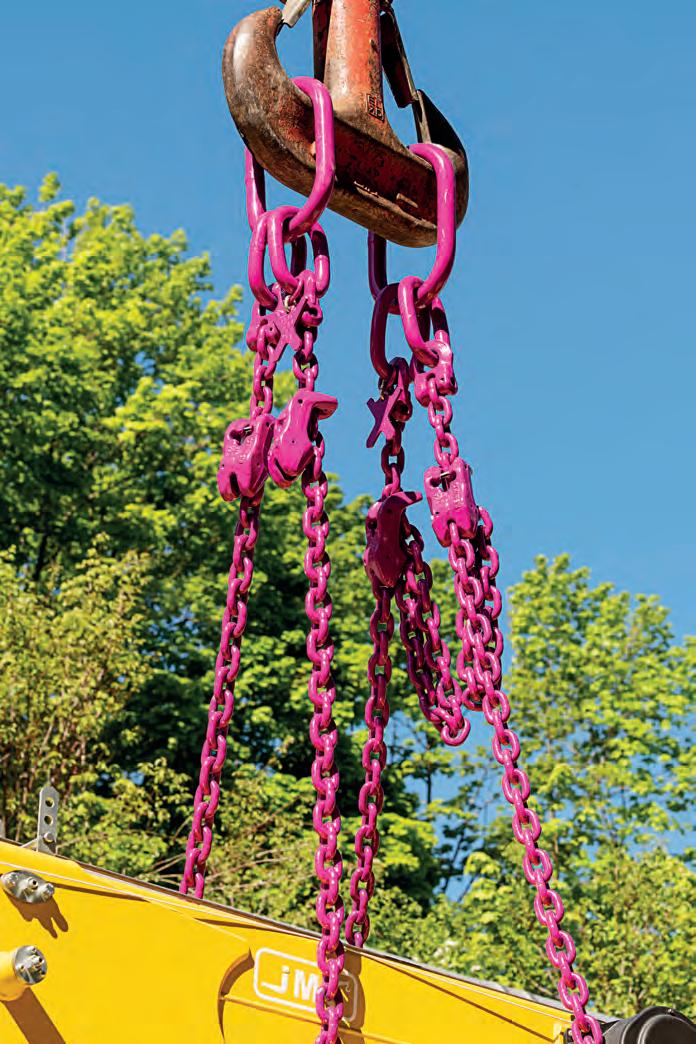
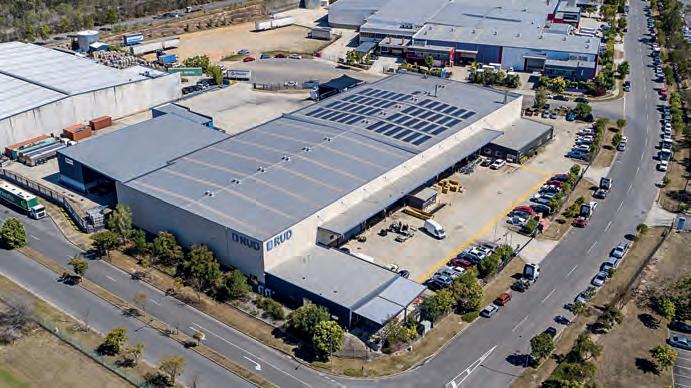
700 boltable and weldable lifting points featuring load ranges all the way up to 250 tonnes.
RUD Australia is known for unrivalled after-sales service and support, which is highly valued by customers.
“RUD is always available to provide advice on maintenance, new products and different lifting solutions,” Mark said.
His sentiments are similarly echoed by Ben of Hulk Lifting, “Whenever we get something in from RUD, there’s always an engineer coming afterwards to inspect the product and ensure that it’s performing exactly as it should.”
Configuring lifting chains for applications can be a time-consuming and complex task. There are multiple factors which influence safety that can complicate the choice of the right sling chain. The new Sling Configurator from RUD makes it easier to configure the perfect chain sling for any lifting application – in only six easy steps.
In addition to choosing between a VIP-100 and an ICE-120 chain, there is a choice of components, information on lifting accessories, tips on lifting and the option to save a chain configuration as a PDF or CAD (computer-aided design) file and email it to RUD.
• C alculate lifting means in six easy steps.
• G et a 3D view of final configuration.
• C ompare components and parts
• D ownload a CAD file that can be used in lift plans.
The Sling Configurator provides a list of the parts in a configuration, making it easy to discuss the sling chain with a team and contact RUD to place an order or for more information.
RUD’s Configurator app helps users configure chain suspensions and lifting points for specific lifting and material handling needs.
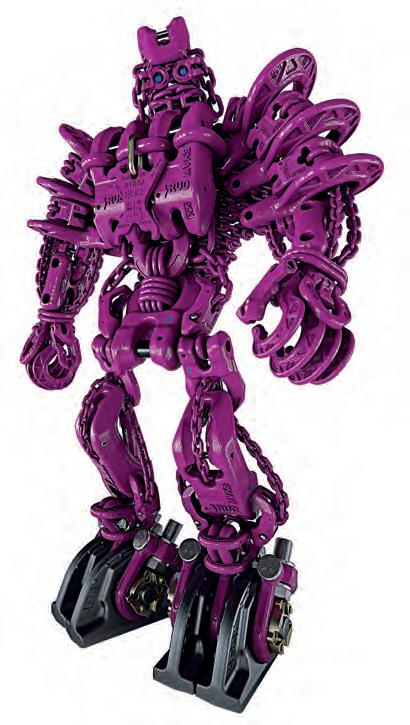
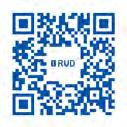
By combining a long-standing legacy of quality with cutting-edge technology and a strong focus on customer service and safety, RUD aims to be a preferred partner for crane operators seeking a safe and reliable investment.
RUD is having an open event on 15 Oct at its premises at 12 Commerce Place, Larapinta QLD 4110
Limited spots are available. The company will be showcasing its lift technologies for the crane industry including break tests for chains, lifting beams and lifting points. RUD will also demonstrate its new robot and ICE Tensioner load cell technology.
Call on 07 3809 1300 to register!

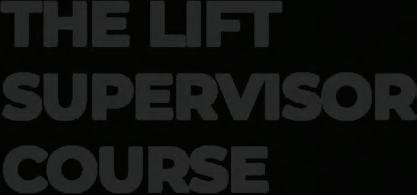
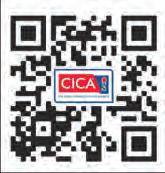

The course instructors are seasoned professionals who will mentor course participants through real-life scenarios, preparing them for the challenges and responsibilities of a Crane Lift Supervisor.
Crane Lift Supervisors are in high demand globally. Completing this course enhances employability and opens doors to a wide array of job opportunities and career growth.
The curriculum covers a wide range of topics, including lift planning, load calculations, safety protocols, communication strategies, and legal compliance.
Scan the QR code to book or to fill out an EOI to help to determine next year's course dates.
Sydney 17-18 September 2025
Adelaide 1-2 October 2025
The course gives participants the confidence and skills to take control of lifting operations safely and effectively.
—Brandon Hitch, CEO, CICA

* Dates subject to change – See CICA Website for latest information
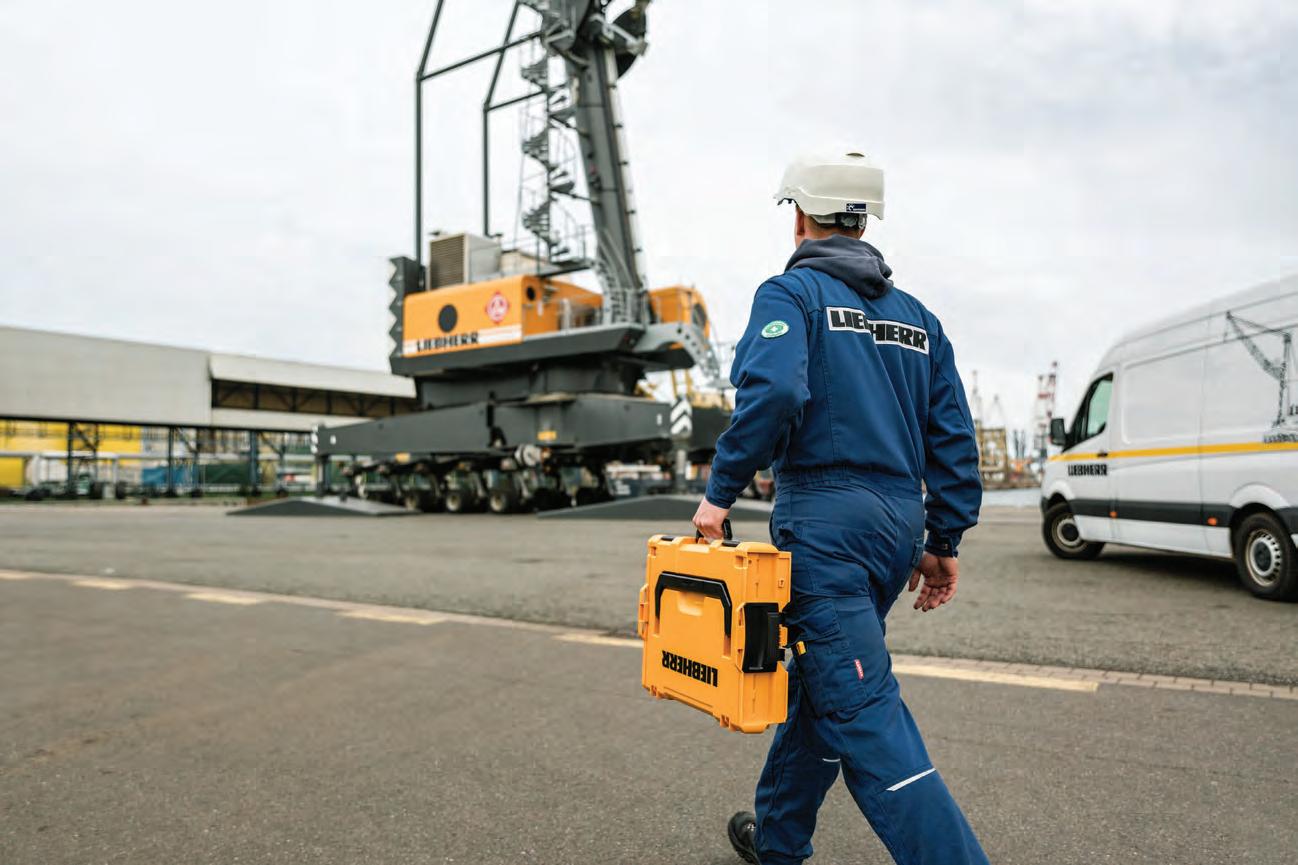
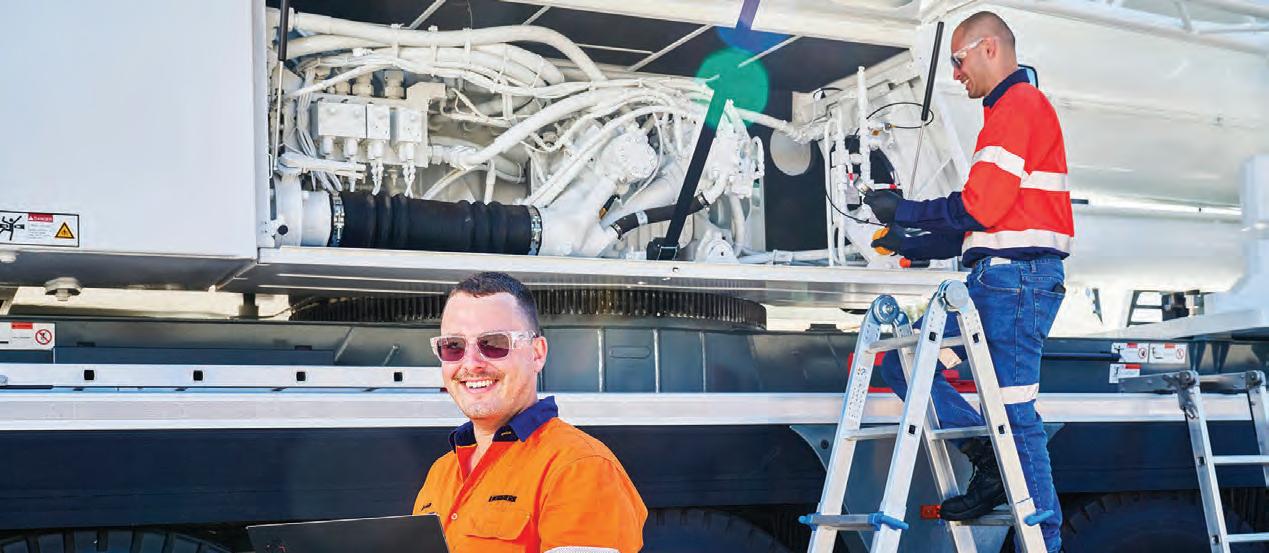
Maritime, Mobile and Crawler Crane technician roles available across Australia and New Zealand
Liebherr-Australia continues to grow, and we’re looking for talented people to join us. Our Service Technicians are at the heart of our success, ensuring reliability, performance, and service excellence.
Whether you’re an experienced professional or building your career, this is your chance to work with world-class technology and be part of a company known for quality, dependability, and innovation. Enjoy great employee benefits, including early access to long service leave, novated leasing, and training with the latest technologies.
If you’re interested in a career with Liebherr, simply scan the QR code and email us your resume at las-careers@liebherr.com


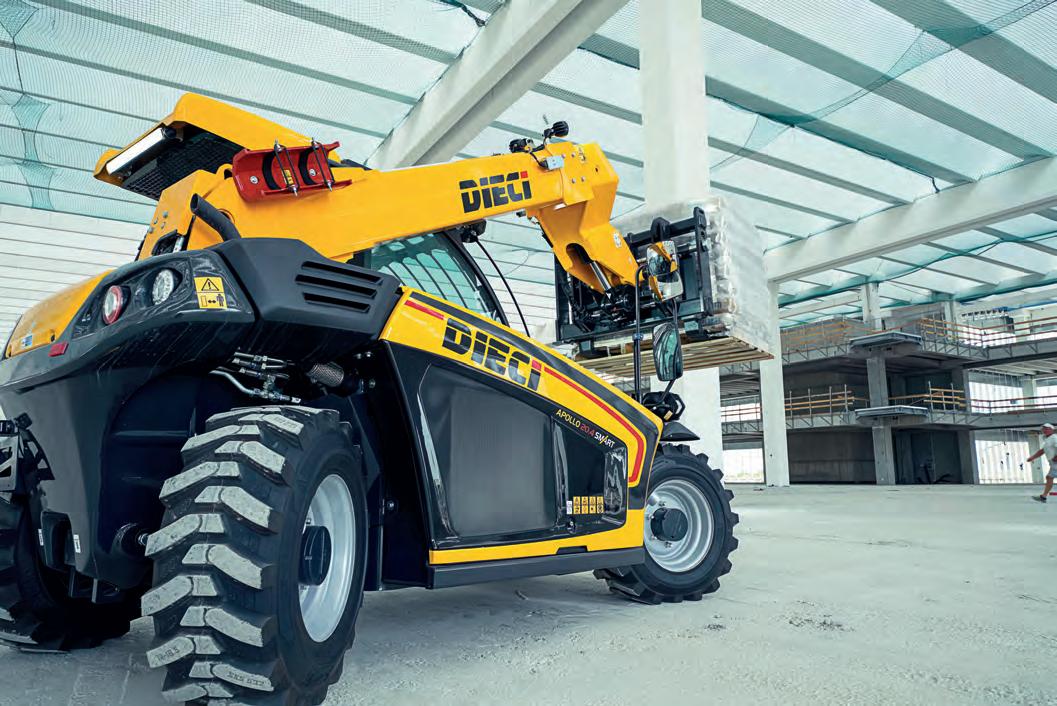
Able to handle heavy loads in tight spaces, Dieci’s new Apollo 20.4 ‘Smart Telehandler’ provides both strength and savings in one small but powerful machine.
CONTRACTORS, CRANE HIRE COMPANIES and machine operators are often faced with the challenges of having to work in confined areas or construction sites with tight space tolerances. Applications like these have generated a strong demand for equipment and special function vehicles that are more compact, more efficient, highly manoeuvrable and safe to use.
Similar limited-space handling challenges are often present on many work locations where materials need to be quickly moved, lifted, transported or stored.
Dieci’s 20.4 Smart Telehandler is a brand new model that is typical of the latest generation equipment that has been designed in response to this need.
Dieci National Sales Manager Bob Mules said the Apollo 20.4 – referred to as “smart” due to its advanced features that enhance efficiency, manoeuvrability,
and ease of use – addresses a market need for equipment that is more compact, agile, faster and more efficient.
“This telehandler has been designed specifically to deliver high-performance and effortless manoeuvrability in tight spaces, without compromising on power or precision,” he said.
“This product was only released recently. Rapid sales immediately following the introduction of this model is a clear indication that this new machine is satisfying a need in the market.”
The telehandler is powered by a 37 kilowatt Kubota engine, enabling it to travel at speeds up to 25 kilometres per hour.
“The advanced engine and transmission deliver an unbeatable combination of power and efficiency,” Bob said.
“The Apollo 20.4 features a Euro Stage V-compliant engine and a hydraulic flow system that enables the operator to use multiple functions at the same
time without losing speed or function enhancing the efficiency and productivity of the machine.”
Three steering modes –two-wheel, four-wheel and crab steer – make for smooth navigation and responsiveness even when carrying full loads.
Bob said that despite the telehandler’s compact dimensions, it provides several comfort-focused features designed to enhance the operator’s experience.
The cab is roomy and ergonomically optimised, ensuring operator comfort even during extended periods of use. There is an updated dashboard layout for improved accessibility and ease of operation, contributing to a more intuitive and efficient operating experience.
The controls, including a proportional joystick, are designed for ease of operation, reducing fatigue and allowing precise handling of the telehandler. All-round visibility is ensured by the cab design,
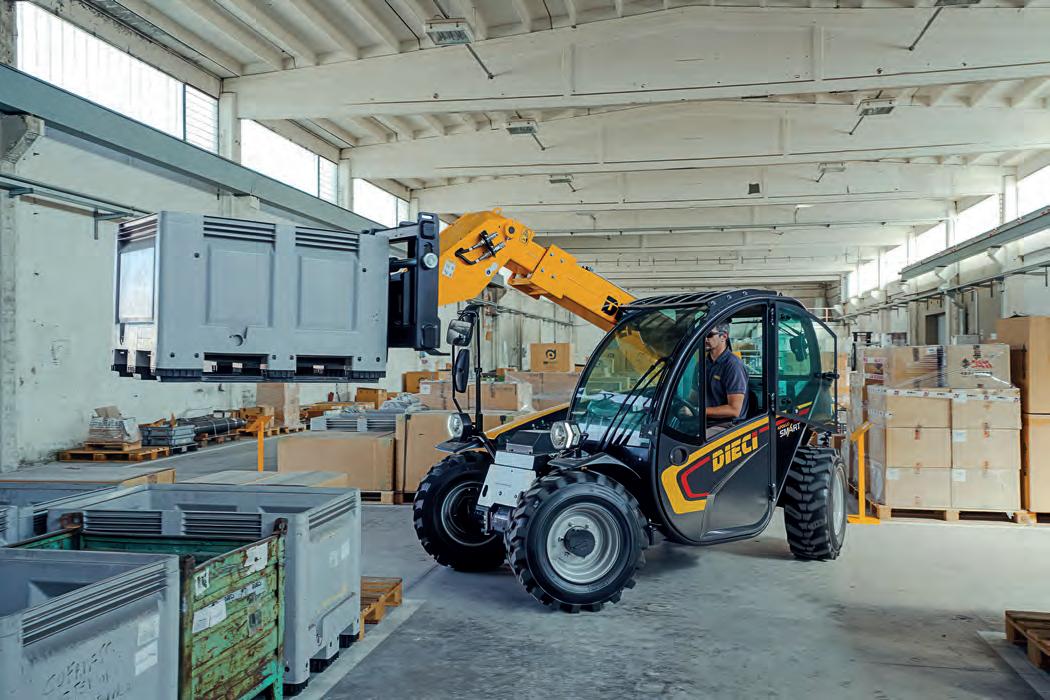
which includes large windows, providing excellent views in all directions, enhancing safety and convenience.
“Our engineers have also added patented features that simplify maintenance access.
The Apollo 20.4 Smart brings both strength and savings together in one powerful machine,” said Bob.
“Weighing in at 4300 kilograms unladen, the telehandler has a robust boom that can handle heavy loads up to two tonnes
manoeuvrability in tight places,” said Bob.
The Apollo 20.4 Smart isn’t just for construction sites, it can provide a more cost-effective versatile and efficient solution by combining the lift capacity of a hydraulic forklift with the reach and elevation of a crane.
A wide range of attachments ranging from buckets and jibs to forks and aerial work platforms mean operators gain the ability to take on multiple tasks with a
“The Apollo 20.4 is ideal for compact construction sites with tight height and space tolerances and ideal for underground and tunnelling applications due to its excellent turning circles and manoeuvrability in tight places.”
to an impressive height of 4.35 metres, while its horizontal reach is 2.67 metres.
“For great flexibility, the fork has a swivel angle of 133 degrees and the machine can climb angles up to 56 per cent. The Apollo 20.4 has an overall height of only 1.93 metres making it a compact, strong machine and an excellent lifter in confined spaces.
“The Apollo 20.4 is ideal for compact construction sites with tight height and space tolerances and ideal for underground and tunnelling applications due to its excellent turning circles and
single machine. Its compact dimensions also make it perfect for applications such as loading and unloading trucks, stacking pallets, and transporting goods within storage areas.
“Telehandlers are useful in moving heavy fabricated assemblies on construction projects and for the loading or unloading of machines on the job; their lifting capacity can streamline work and reduces risks associated with manual handling.
“Other jobs where the Apollo 20.4 Smart really shines is in applications such as public works landscaping where
its efficiency and speed makes it ideal for moving in confined spaces, while handling and transporting soil, mulch, large plants, and landscaping materials,” said Bob.
Compared to forklifts, the 20.4 has the ability to reach higher and further due to the telescopic boom, and it has greater visibility given by its lateral positioning. On landscaping projects, it can easily lift and transport logs, clear debris and has the necessary reaching power to manage heavy loads and handle bulk materials, transport tools and equipment in difficult environments. In recycling and waste management, the machine is ideally suited to handling materials, moving heavy bins, sorting materials, and handling waste materials for processing.
After-sales service plays a crucial role in the overall cost of ownership.
“Like every Dieci telehandler, we aim to ensure that the customer gets the best possible experience,” Bob said. “It’s about making sure sales, parts and service functions are integrated to deliver a great seamless experience, whether they are buying one or 20 machines. Dieci Australia has a commitment to customisation to suit market needs and has a proven record in specialised products that are supported by a strong national parts and service network.”
For more information call Dieci Australia on 1300 888 479, or visit www.dieciaustralia.com.au

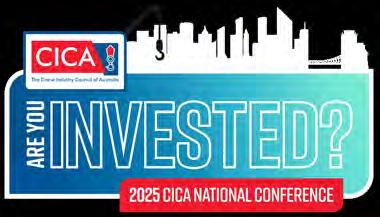
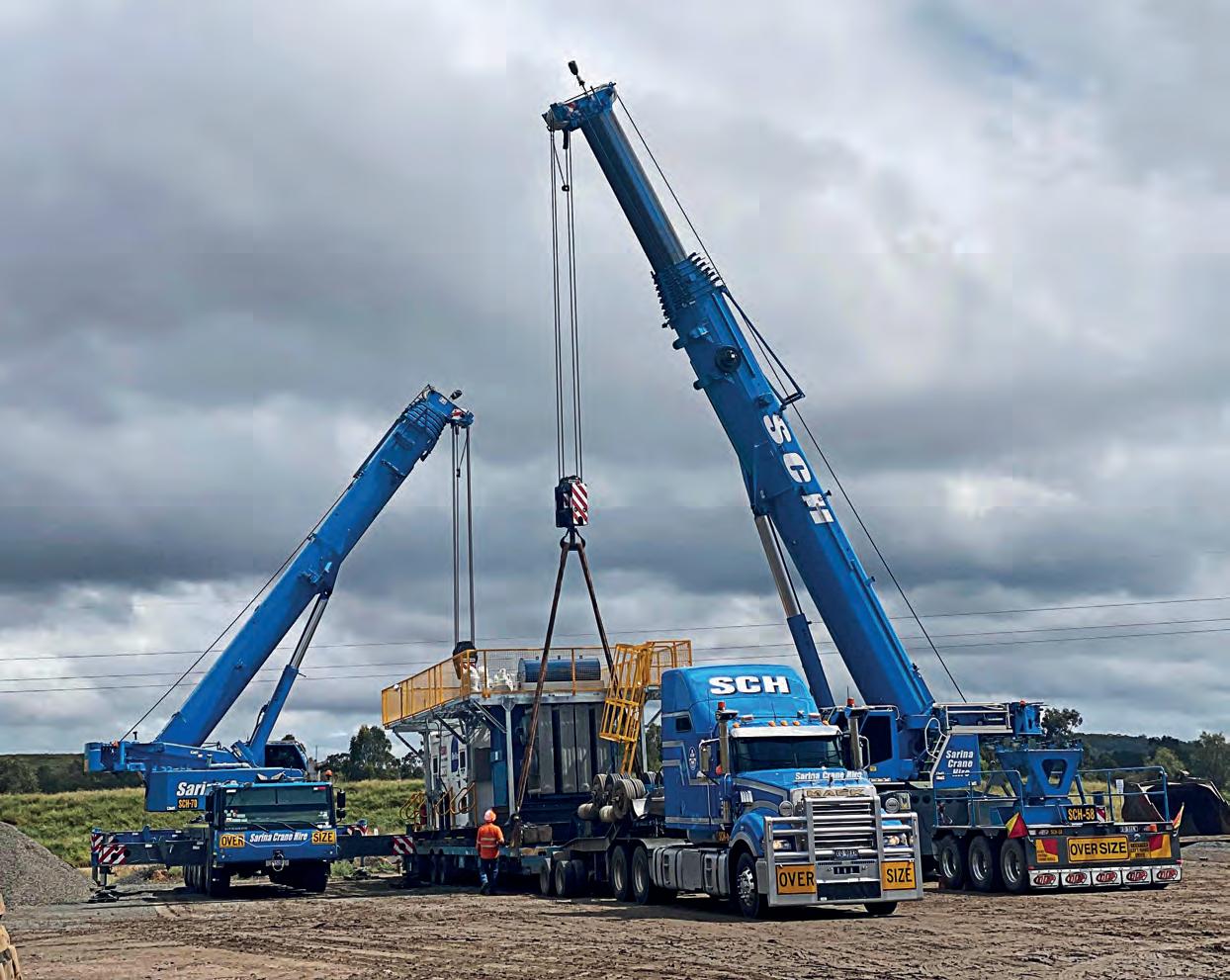
Scott and Cathy Goode, owners of Sarina Crane Hire, started the business in 2007 with a single 12-tonne Franna. They weren’t aiming to just hire out equipment – they wanted to build a company that delivered complete lifting solutions, backed by a strong safety culture, skilled people, and a commitment to doing the job right the first time.
EIGHTEEN YEARS ON, SARINA CRANE HIRE has grown to a fleet of 36 cranes ranging from 13-tonne city crane through to a 250-tonne Kobelco lattice boom crawler, supported by heavy haulage and access equipment services. “We’re more of a onestop shop,” said Scott. “One phone call –
we turn up, do your job, supply everything. One contact, one bill.”
It’s a model that wins work, “If we’re doing the lift and the shift, and something doesn’t turn up because of an oversight on our part, I don’t charge the client. They like that. It’s about delivering on what we promise,” Scott said.
BUILT ON RELATIONSHIPS AND EXPERIENCE
Scott’s own background spans rail, mining and sugar, giving him a strong foundation in both technical lifting and customer service.
“I built a lot of relationships on the ground in those early years,” he said. “In the first five to ten years, I worked incredibly hard to build the name. Now the work comes to us – we don’t need to hunt for it.”
The company operates across a vast region Scott calls “the triangle” – from Bowen in the north, out to Emerald, and down to Gladstone in Queensland. Within this area, the team services industries including ports, sugar, mining and rail.
Sarina Crane Hire’s main hub is in Sarina, complete with a fully equipped maintenance workshop. “We do all our own servicing and ten-year rebuilds inhouse,” Scott said.
“My son, Ethan is the workshop supervisor – he’s a dual tradesman and has been with us ten years. We’ve got contract fitters and engineers come in when needed, but most of it we handle ourselves.”
Additional yards include a large 130-acre facility in Coppabella, which houses the big gear servicing the Bowen Basin, and a yard in Mackay – recently upgraded to a full operation after a competitor’s exit created an opportunity.
The crane fleet is dominated by Liebherr slew cranes, (120-130-150-200-220 and 250 tonne), Franna pick and carry cranes (20-40 tonne), supported by Grove rough terrains, a Tadano truck mount, and a Kato city crane. Highlights include two Liebherr 250-tonne cranes, an LTR 1220 and the 250-tonne Kobelco.
The heavy haulage side includes 13 prime movers – mostly Mack, with one Kenworth – and a wide range of trailers. “We’ve got step decks, blade trailers, ten-row low loaders, a lot of Drake trailers, and about eight or nine from Australian manufacturer

John Pace, JP Trailers,” Scott said. Offering both lifting and haulage provides clients with a seamless solution. “You don’t need to deal with multiple contractors – we take care of everything,” Scott said. “It’s one less hassle for the customer.”
From day one, Scott embedded a strong safety culture, drawing on his time as a health and safety representative during a major legislative shift in the early 2000s.
“The old Act told you what you could and couldn’t lift; the new one was about risk assessment,” he said. “I was in the pilot programs, so when I started my business, I was fully aware of my obligations. That’s been carried right through to today.”
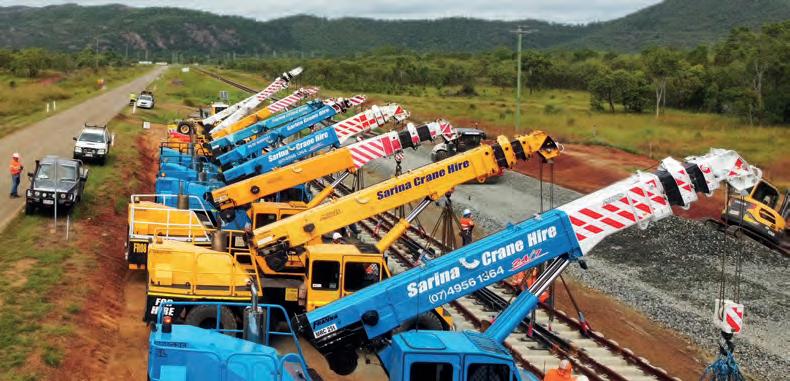
Every task has a Safe Work Method Statement (SWMS), and a Job Safety Analysis (JSA) is completed before every lift or movement – whether loading a semi or shifting heavy equipment.
“The process is the same across all parts of the business,” Scott said. “That way, if people swap between divisions, the safety rules don’t change.”
Scott’s training philosophy is equally grounded. “I’ll take someone with a strong work ethic, even if they don’t have formal skills, and teach them what they need to know,” he said. “They start in the yard, learn to care for and respect the gear, then we get them their dogman’s ticket. If the attitude is right, they can build from there.”
Most of the company’s eight supervisors have been with Scott for more than a decade – some for 15 years. “I’ve got a core team of 30 people I can always rely on,” he said. “They know the job, they know the customers, and they know our standards.”
For Scott, keeping crews happy is about more than wages – it’s about work-life balance. “If we can get them home every night, we will,” he said. “We won’t send them away for more than three or four nights at a time. When families are supported and things are steady at home, people can focus on the job. If there’s strain at home, it shows up on site.”
That philosophy also extends to building a strong social culture. Each year, the
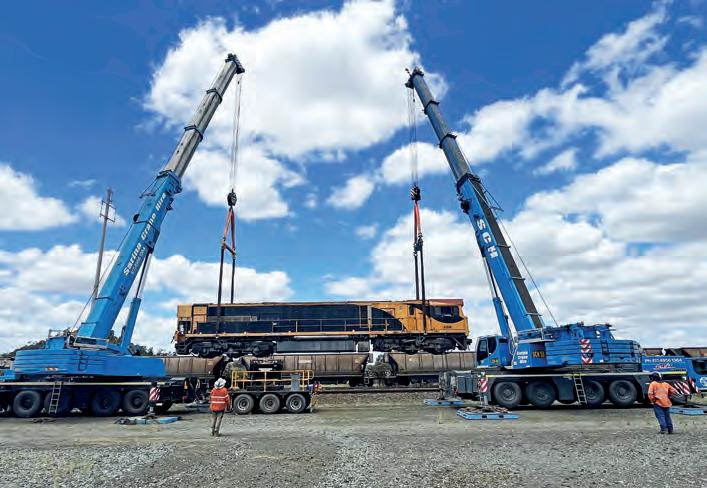
company hosts a major event for employees and their families, featuring a slideshow of projects from the year. “It gives families a chance to see the work their loved ones have been involved in,” Scott said. “It makes them feel part of it – and we like to have a bit of fun with it too.”
Being based in a regional town, Sarina Crane Hire takes community support seriously. “There’s probably not a sporting club, organisation or fundraiser we don’t sponsor,” Scott said. “It’s all part and parcel of living in a small town.”
This community connection also influences hiring. “First thing we do is ask our crew if they know someone for the job,” Scott said. “It gives us a benchmark straight away. Then we check skills, train where needed, and keep improving.”
After nearly two decades, Scott remains hands-on and forward-looking. His message to others in the industry is simple: focus on your own game. “Don’t worry about what people think – just keep working towards your goals,” he said. “Look after your own backyard first, and you’ll be fine.”
With a loyal team, a reputation for delivering complete lifting and haulage solutions, and a culture built on safety and relationships, Sarina Crane Hire looks set to keep lifting Queensland’s industries for many years to come.
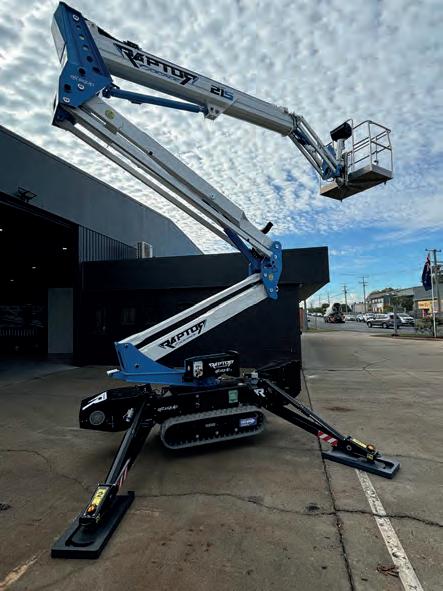
As highly experienced Travel Tower and Spider Operators ourselves, we know firsthand the importance of quality and reliability when working at heights. Altequip is proud to bring the premium Italian brand Socage’s EWP products to the Australian market.
This includes their innovative range of Raptor Spider machines, which deliver exceptional lifting capacity and versatility up to the impressive Truck Mounted TJJ100 100m.
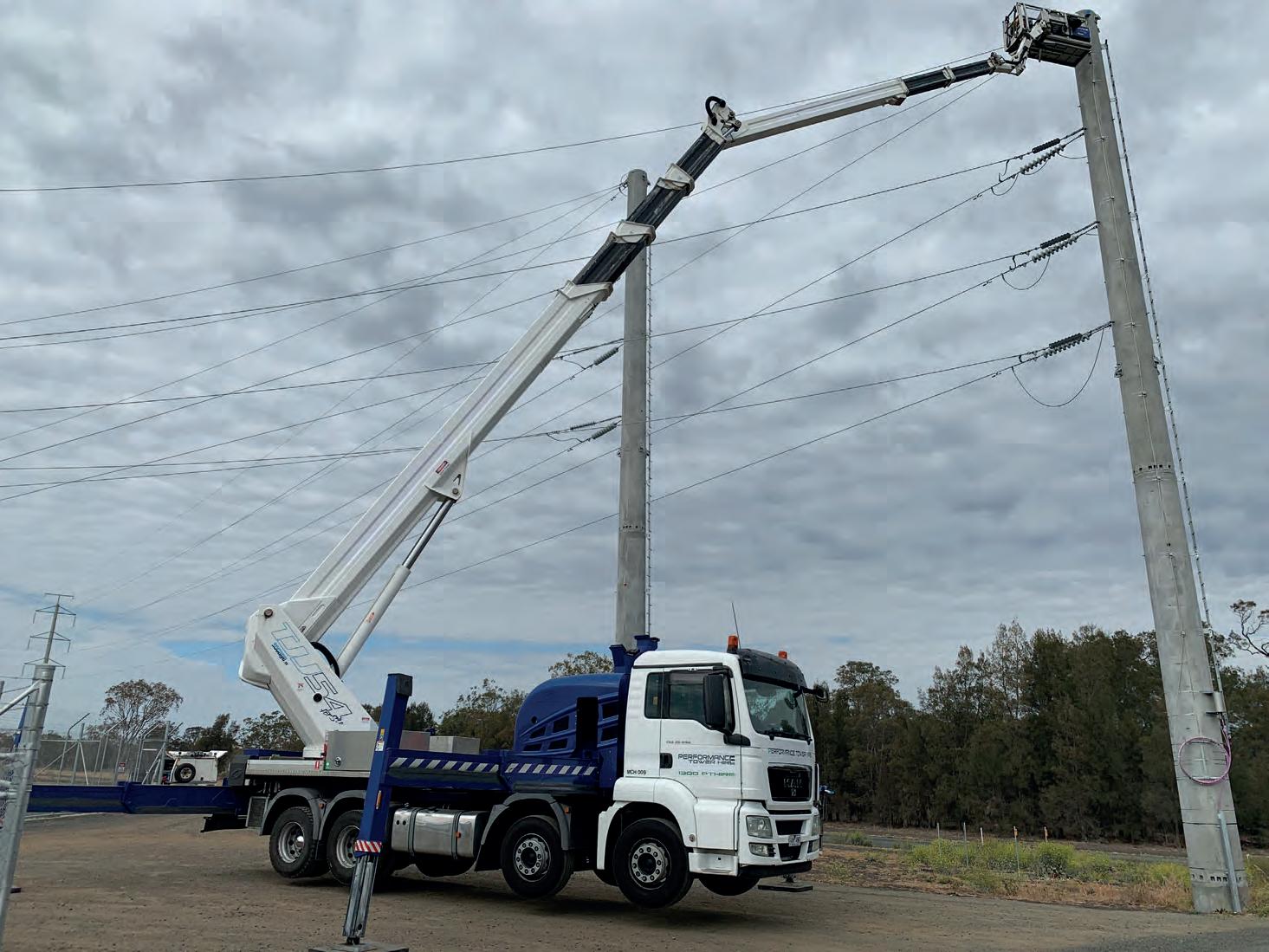
MACHINES FROM 14M TO

Every crane company has its origin story, but few are as true to their name as Origin Cranes.
BORN FROM A CHANCE MEETING AT A barbecue and fuelled by a shared love of the State of Origin rugby league series, co-owners Bradley Sugden and Daniel Wright built their Sunshine Coast business from the ground up. What started with two second-hand Frannas has grown into a fleet that now includes 100-tonne Liebherr all terrains, truck-mounted Zoomlions and a diverse range of machines servicing some of Queensland’s biggest construction players.
The “Origin” in Origin Cranes isn’t just branding – it’s part of the company’s identity. Daniel said, “We met at a barbecue and talked about starting a crane company. We didn’t know each other from a bar of soap, but within a week we’d made it happen. And because State of Origin was on at the time, the name stuck. The maroon and red paint scheme is a nod to that.”
For Bradley, cranes were always in his blood. His father founded a crane company in Toowoomba in the 1970s, and Bradley grew up riding along in the cab. After years working across Australia with major operators, he returned to the Coast, where he and Daniel crossed paths. Daniel, with a background in mining, drilling, and construction, had also been around cranes throughout his career. The partnership clicked immediately.
The company’s humble beginnings involved buying two ageing 20-tonne Frannas at auction. “We literally drove around job sites, pulling up and asking if they needed a crane,” Bradley said. “That’s how it all started – just word of mouth and determination.”
Bradley remembers the day vividly: “The first crane we bought maxed out our budget. The auctioneer then offered us a second at the same price. I wasn’t sure, but Dan’s dad gave me a shove in the chest and said, ‘Just buy it – you’ll be right.’ That’s how we ended up with two cranes instead of one.”
From there, the fleet steadily expanded.

A city crane was added to meet growing demand, followed quickly by a truck mount and then larger capacity units. “It was a good time to start,” Daniel said. “The Sunshine Coast was booming, and before we knew it, we were adding almost a crane a year.”
Today, the Origin fleet includes:
• Two Liebherr 1094.2 100-tonne allterrains
• Demag 55-tonne long boom
• Terex 40-tonne
• Two Zoomlion truck mounts (25 and 33–35 metre booms)
• Four Frannas – one 25-tonne and three 20-tonnes
• Kato 13-tonne and RK160-2 16-tonne city cranes
Bradley said the diversity is deliberate. “From small truss lifts for mum-and-dad builders to major projects with Hutchinson, Badge Constructions, FK Gardner, and McNab, we’ve always wanted to cover every corner of the market. Reliability and service have kept us in the mix with bigger players.”
While Liebherr anchors the heavy end of the fleet, Origin has embraced valuedriven options as well. The Zoomlion truck cranes, for instance, have been standout performers.
“You certainly get value for money,” Daniel said. “The 25-tonne single-steer Zoomlion represented a significant step forward for us and immediately made us more competitive. Those who criticise the brand likely haven’t had to purchase cranes themselves. The machines have proven excellent for residential and retirement village projects, where both reach and stability are critical.”
Bradley agreed, “For the price and performance, they do the job. They’ll happily put a tonne out at 30 metres –they’re great little cranes.”
Beyond machines, Origin Cranes prides itself on its people. With about 20 staff, the company blends experienced operators with newcomers trained on the job.
“If you don’t train your own, you’ll always be short,” Bradley said. “We’ve taken on people from all walks of life –one was a butcher, another worked in fruit. Now they’re running 100-tonners. It’s about giving opportunities and building careers.”
That philosophy has created loyalty. “We’re very family oriented,” Daniel said. “If someone leaves, they usually end up coming back. We make sure our guys have balance – if your daughter’s running in the school athletics final, we’ll cover for you so you can be there. That’s what keeps people happy.”
From the beginning, Origin has prioritised safety and professionalism. The company holds multiple ISO (International Organization for Standardization) certifications, which has helped formalise practices and reassure clients.
“Safety starts from the first phone call,” Bradley said. “We’ll do a site visit at no cost, explain the process, and provide a full digital lift plan. That makes customers feel comfortable and confident.”
Origin’s growth has been supported by strong relationships with manufacturers and suppliers. The company’s two Liebherr all terrains are backed by dependable service. “If we need parts or advice, the Liebherr team is always there,” Bradley said.
Zoomlion cranes have also proven reliable. “Those machines gave us the edge when we were building up. They made us competitive at the right time,” Daniel said.
Nearly a decade in, Origin Cranes has carved out a reputation for service, reliability, and community spirit. What started with two Frannas and a leap of faith is now a Sunshine Coast success story, with a fleet that continues to grow and a team culture that sets it apart.
As Daniel put it: “We don’t just run cranes – we run a family. Our people know they’re valued, and that translates to better service for our clients. That’s what Origin is all about.”
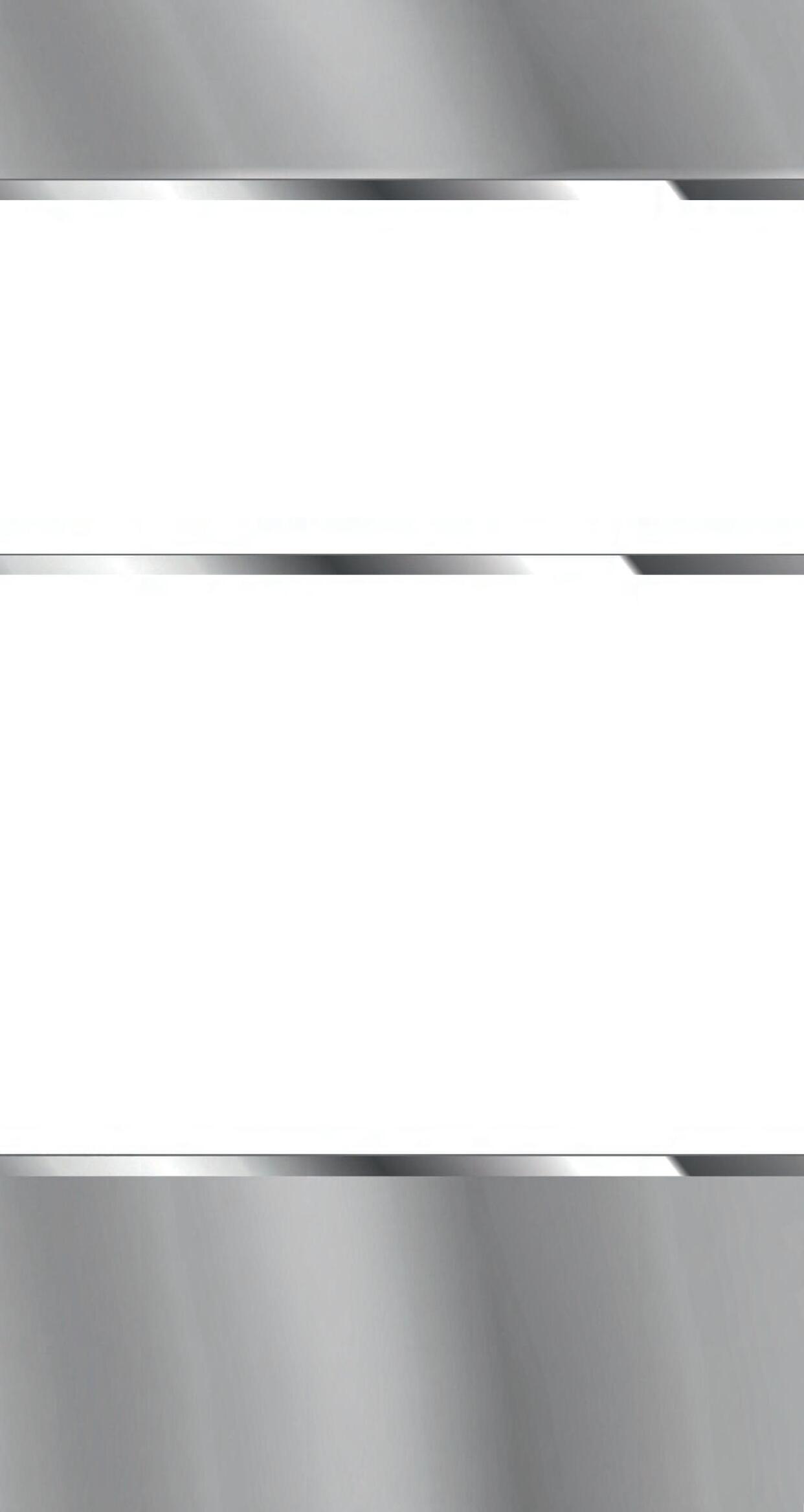
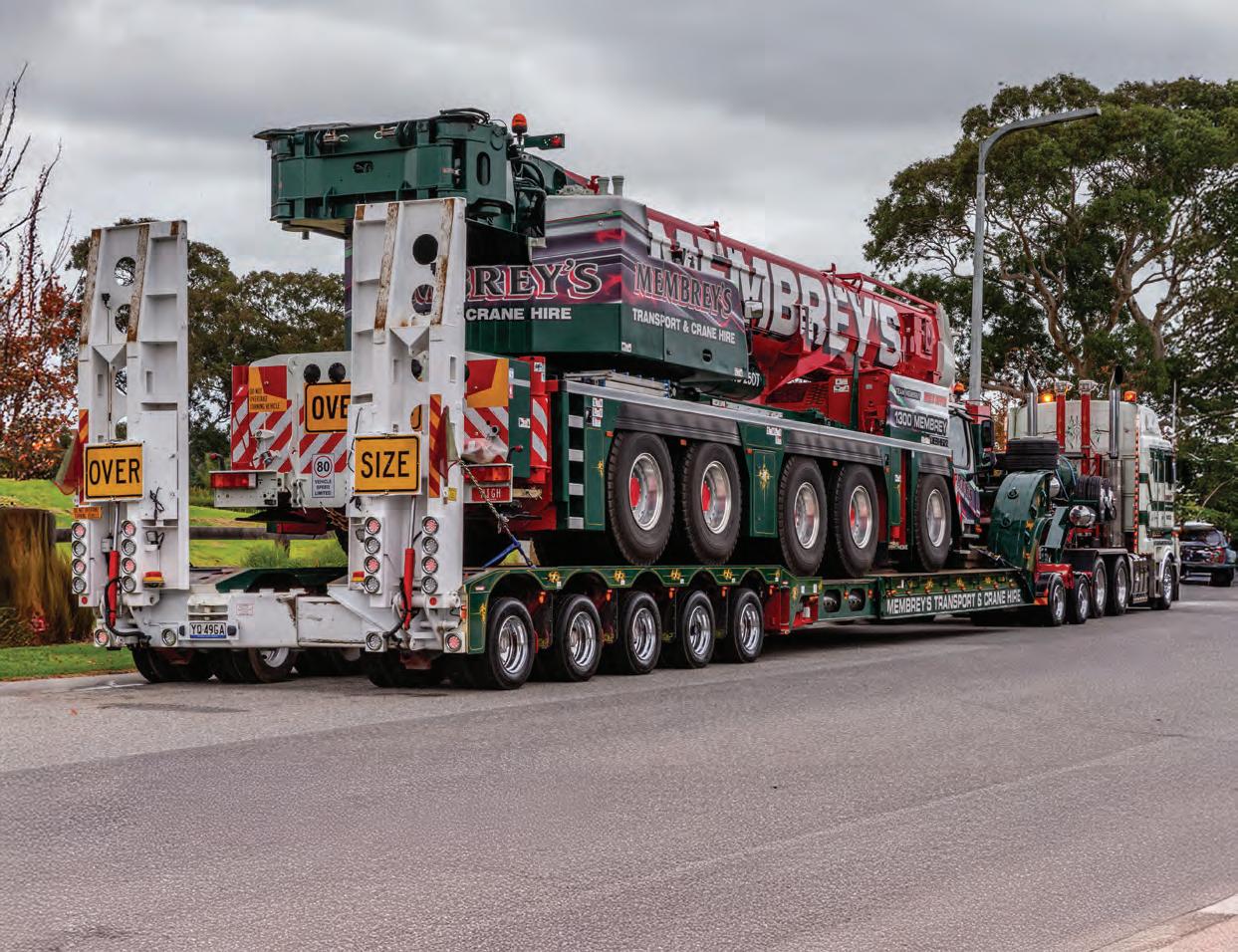
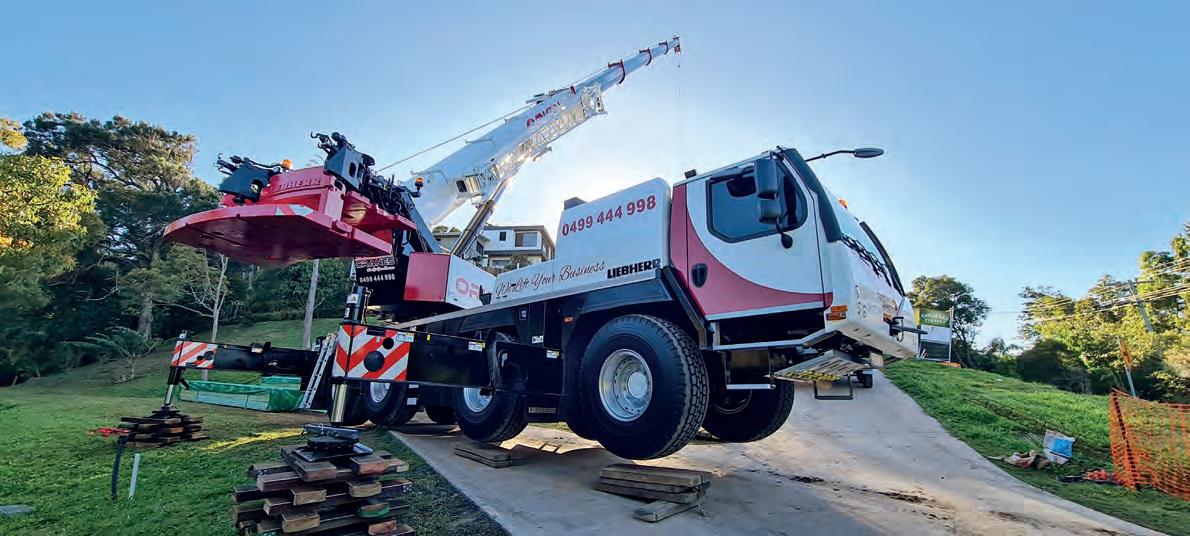
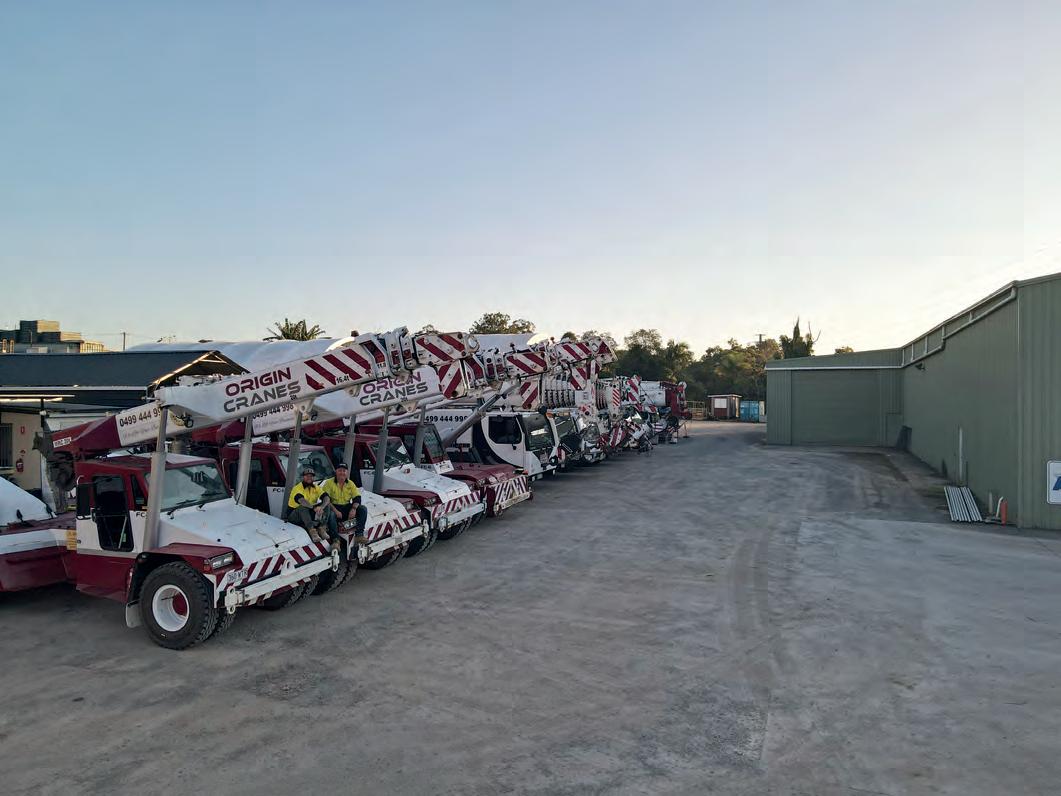








East Coast Cranes is raising the stakes in Queensland.
LATER THIS YEAR, BRISBANE-BASED East Coast Cranes will welcome the arrival of a new heavyweight to Queensland’s crane scene – a Liebherr LTM 1650-8.1, a 700-tonne capacity all-terrain crane that will be the first of its kind permanently based in the state. For Managing Director David Hopper, it’s not just another machine – it’s the next big step in a journey that started nearly three decades ago.
FROM THE ‘WOBBLY’ TO THE HEAVYWEIGHTS
Dave’s story in cranes began in 1996 after working for major construction names
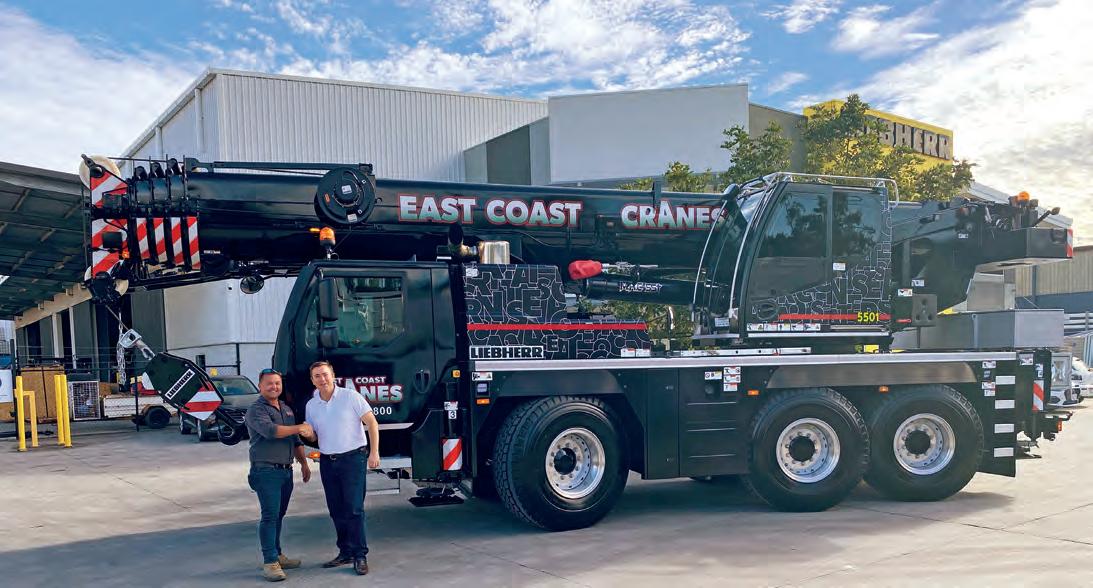
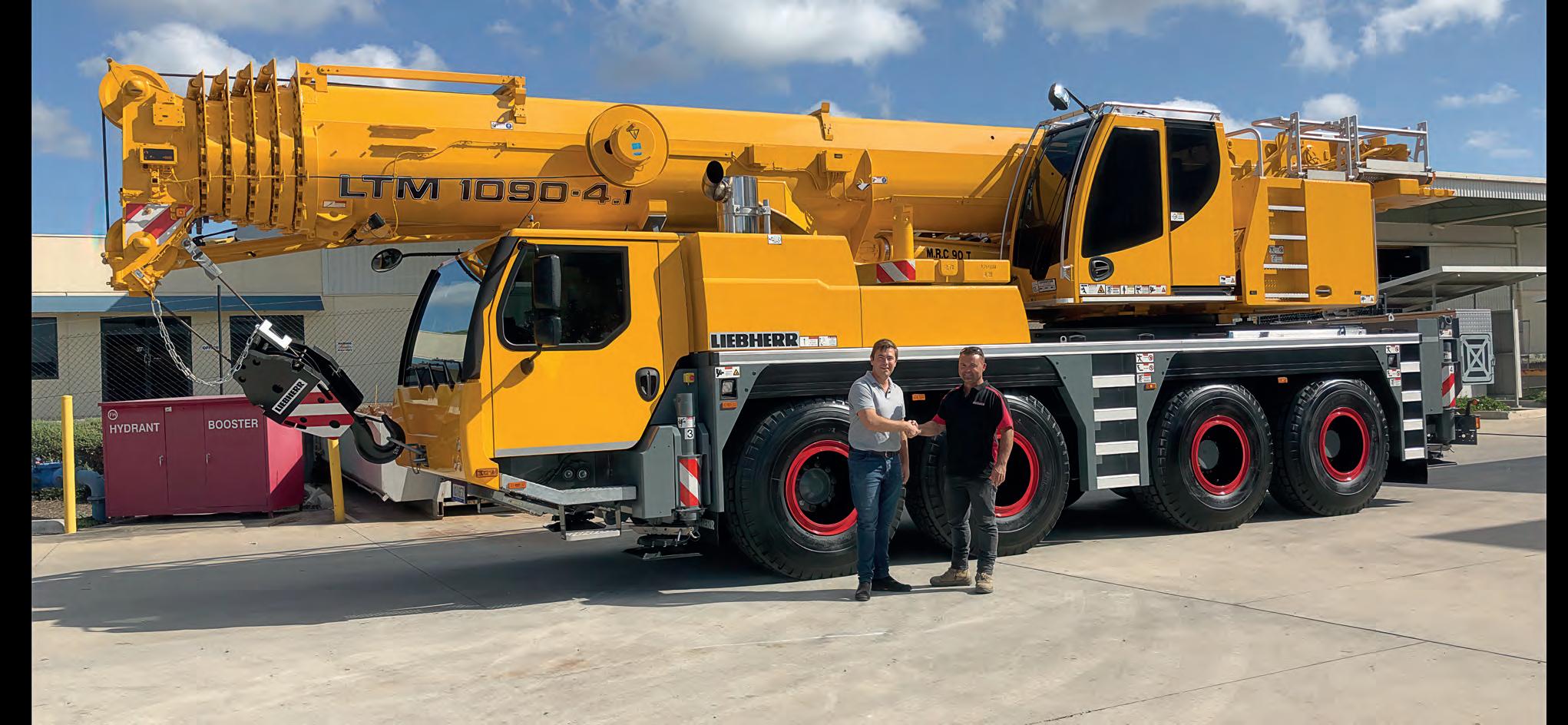

including John Holland, Barclay Mowlem, and Baulderstone Hornibrook. He earned his crane ticket on an old BHB “wobbly” before joining Holts Crane Hire – a small Toowoomba outfit that quickly made waves in Brisbane by acquiring industry leader Brambles Cranes.
“I grew with the business and operated pretty much every crane I could get my hands on. Back then, a 50-tonner was considered big. I left Holts in 2007 to join Matt Yapp at NQ Group as his first employee,” recalls Dave.
After an on-site accident in 2008 shifted him into the office, Dave rose to operations manager within six months. He later became the first crane hire employee for Big Lift Cranes, helping grow the business to 25 cranes and a heavy haulage arm across depots in the Hunter Valley and Brisbane.
Following stints at Universal Cranes and Lift Logistics, Dave decided in December 2015
to take the leap and start his own operation. Armed with an ABN, plenty of industry relationships, and a crystal-clear vision, East Coast Cranes was born.
Within three months, his accountant gave him a blunt piece of advice: “You’re kicking so many goals already – you’d be mad not to buy a crane.” Dave’s answer was obvious – a used 80-tonne Liebherr from Senator Cranes in Melbourne.
“That little beast was my launchpad. It lifted like a 100-tonner and quickly attracted a loyal client base. By 2016 I’d hired my first employees, bought a brand-new 100-tonne LTM 1100-4.2, a few Frannas, and the fleet just kept growing.”
Dave’s connection to Liebherr goes back more than 20 years.
“My very first slew crane was a Liebherr LTM 1025. Since then, I’ve told every business I’ve worked for: if you want the best, it’s Liebherr all the way. Premium
machines, premium service – and the Queensland back-up support is second to none,” he said.
That philosophy has shaped East Coast Cranes’ fleet, which now runs all Liebherr all-terrains from 50 to 230 tonnes, plus a 450-tonne Grove. That Grove, purchased from Melrose Crane Hire, opened the door to major heavy-lift projects – including
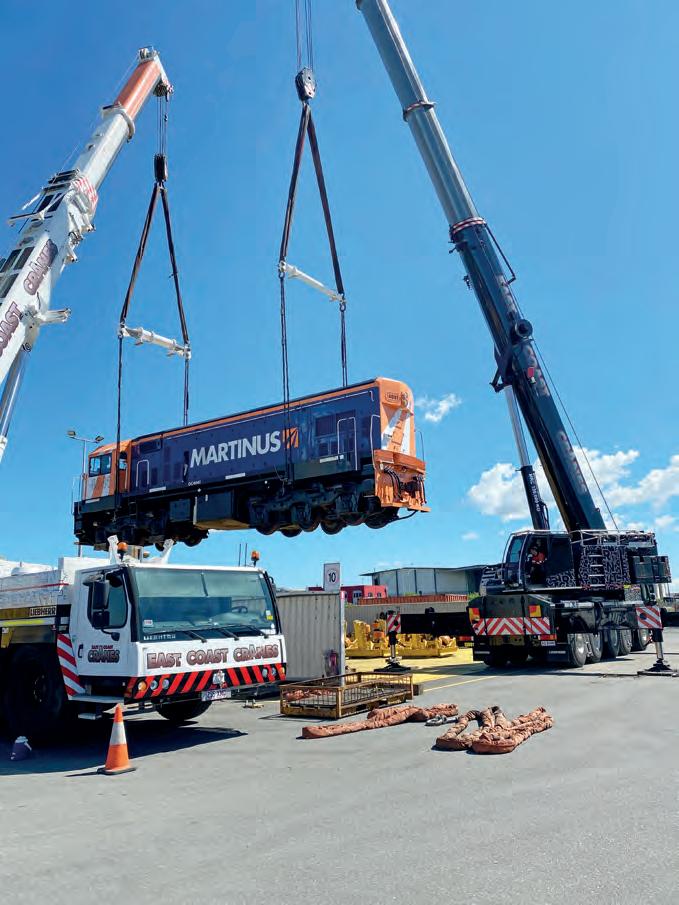
Now, a second-hand 2021 LTM1650-8.1 refurbished by the Liebherr factory is due at Christmas – a 10 year anniversary present.
East Coast Cranes also has a 2013, 220-tonne crane brought from Hanchard Cranes in 2018.
Dave was tempted by Liebherr’s LTM 1400-6.1, but the 1650-8.1 won him over for its versatility, higher load capacity, and opportunities in bridge and infrastructure work.
“There’s going to be a huge pipeline of projects in the lead-up to the 2032 Olympics. This crane will get us in front of every bridge and infrastructure
Dave has partnered with industry specialist Scott De La Rue to form East Coast Heavy Lift Pty Ltd.
With three companies under the East Coast banner – cranes, heavy haulage, and East Coast Heavy Lift – Dave has built a team that blends deep technical knowledge with a culture of loyalty and respect.
“I recruit on reputation. My crew is the strongest it’s ever been – highly experienced heavy-lift specialists, many from big crane companies, some now in supervisor and operations roles. We’ve built genuine friendships in the business, and my wife, who heads our accounts, has been part of the journey from day one.
“We started in our lounge room. Now we’ve built a purpose-built facility, we run 27 cranes, and we’ve got the biggest all-terrain ever based in Queensland on the way. It’s been a wild ride – and it’s about to get even bigger.”
In 2022, Dave partnered with industry professional Tim Milton to create ECC Heavy Haulage – a specialist division to complement East Coast Cranes. Together, they have grown ECC Heavy Haulage into a trusted and reputable transport partner, providing clients with a seamless connection between heavy haulage and crane hire.
Continuing this vision for integrated lifting and transport solutions, Dave has now joined forces with industry specialist Scott De La Rue to establish East Coast
“With a strong focus on large crawler cranes and complex heavy lifts, East Coast Heavy Lift ensures clients have access to a complete inhouse solution for the most challenging projects.”
builder in Queensland,” he said. “It positions us to handle projects on a whole new scale.”
East Coast Cranes has carved out a premium niche, working with major gas suppliers Coregas and BOC, specialising in modular school buildings, and tackling unique infrastructure challenges such as large concrete tank installations for Bunnings flood mitigation projects.
Heavy Lift Pty Ltd. This new venture is purpose-built for dry hire, project-style heavy-lift cranes, and technical lifting solutions. With a strong focus on large crawler cranes and complex heavy lifts, East Coast Heavy Lift ensures clients have access to a complete in-house solution for the most challenging projects.
“At East Coast Cranes, ECC Heavy Haulage, and East Coast Heavy Lift – our goal is simple: to keep raising the standard in crane hire, heavy haulage, and lifting solutions across Queensland and beyond.”
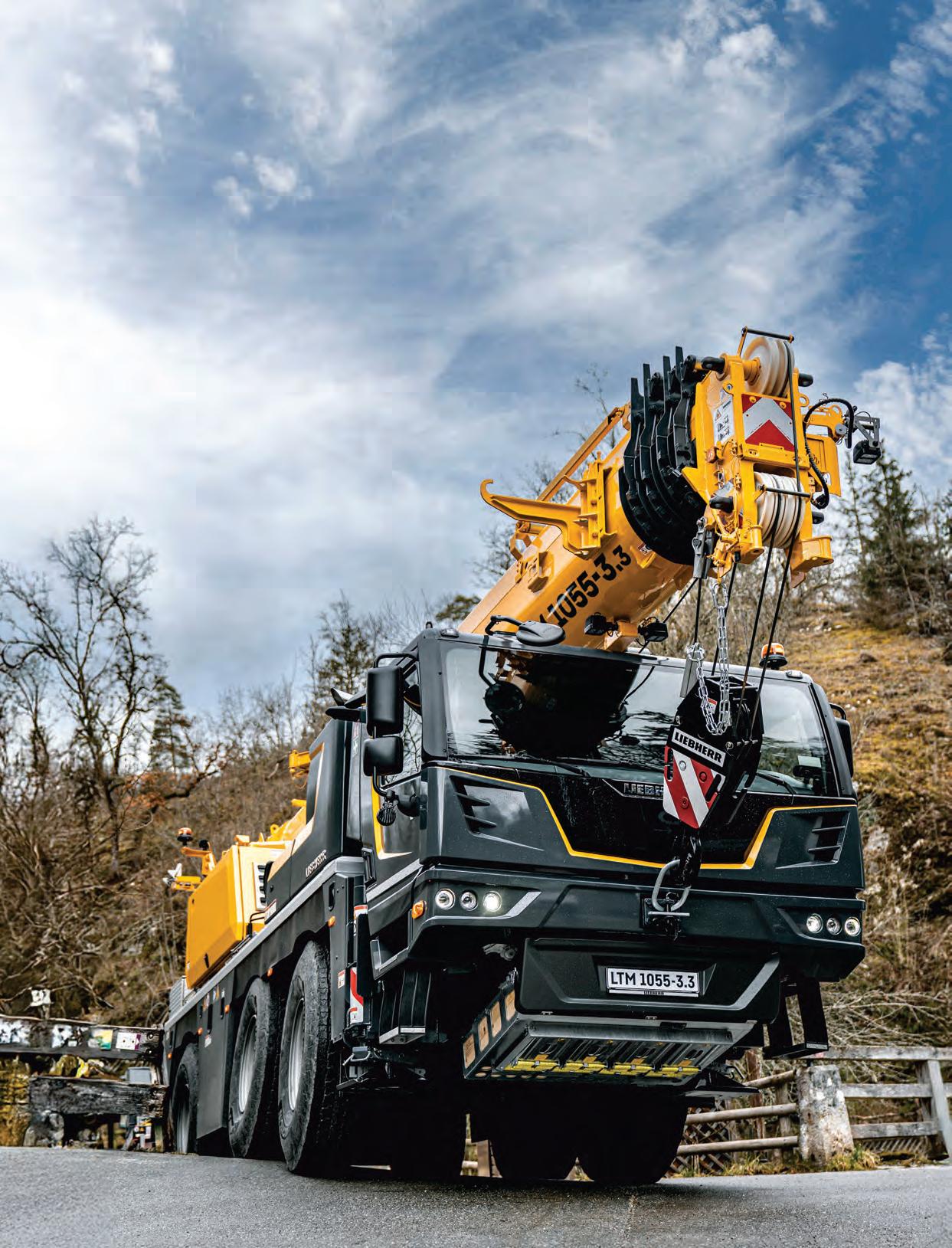

Mobility redefined: Complex on-road driving permissions are now a thing of the past! Thanks to low axle loads and total weights, permanent driving permissions are available for a large number of countries. Despite its lightweight design, the 40 metre telescopic boom offers high lifting capacities, especially for medium and large outreaches. www.liebherr.com
Brisbane City Cranes recently took delivery of a new XCMG XCA40-E 40 tonne capacity all terrain. General Manager
Billy Sasalu and Business Development Manager Joe Conti explain the reasons for choosing XCMG.
BRISBANE CITY CRANES FIRST TOOK notice of XCMG two years ago at the CICA National Conference and Exhibition where they had the XCA40-E on display.
“I first looked at it because it was very similar to other brands in terms of size, shape, and capacity,” said Billy. “I went on to conduct research and due diligence on the crane. I spent a lot of time researching the engine, the operational nature of the crane, the hydraulics, transmission and motors. Although I was aware of the general consensus that Chinese gear ‘is not quite where it needs to be, and you get
what you pay for’, I am not of that opinion. I have been very impressed with the overall quality of the crane.
“Also, from a business perspective, with the rates we are able to charge for cranes, and factor in the current Euro exchange rate and the quality and price of the crane, we figured XCMG was good value for the business.
“I started by comparing the XCMG XCA40-E with our LTC1045s. The motor sizes were comparative. They are running the Daimler motor, the transmissions are Ellison Autos, and the hydraulics systems
feature European brands. I worked with one of our experienced fitters and bounced a lot of things off him and in terms of servicing and maintenance it was quite comparative to the LTCs. With that size of crane, there are not too many components. Like all manufacturers it comes with service schedules and documents as to how to look after it and we’ll follow these guidelines,” he said.
Joe has been impressed with the quality of the XCMG.
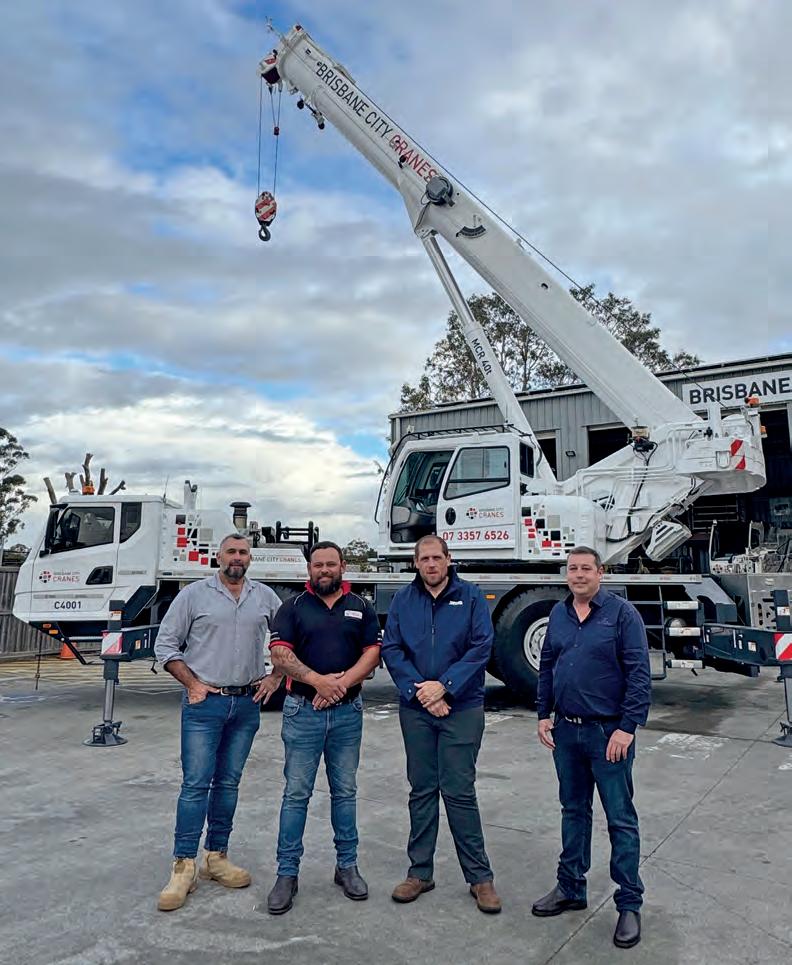
“There’s no doubting the quality of the crane. I’ve been to China a few times visiting the factories and met a very smart bunch of people who are improving their products all of the time with continued investment in state of the art manufacturing technologies. The crane has joined the fleet, and it’s doing great things and ticking along nicely.
“From a strategic perspective, we operated LTC1045s, which basically built the business. Purchasing the XCMG has enabled us to meet our competitors with a similar crane but be cost-effective with our rates which will ultimately benefit our clients,” he said.
The XCMG XCA40-E is a versatile and innovative crane designed for efficient lifting. It has a maximum lifting capacity of 40 tonne, features a more optimised layout for higher lifting performance, and adopts the classic K-series Jib telescoping technique for safer and more reliable lifting. The crane features a main-boom of 35 metres, and fully extended boom with jib is 44.5 metres, with a maximum lifting height of 48 metres. The lifting performance of the XCA40-E is higher than equivalent brands in the same class.
Overseas, crane rental service Sarens recently signed a memorandum of understanding with XCMG to supply a fleet of all terrains. Joe sees this development as sound business sense.
“The labour market in Europe is very unionised and as the costs of cranes continues to rise they are in the same predicament as us in terms of the rates they can charge. With this agreement they are purchasing the same crane for 50 to 60 per cent less than they were from the major manufacturers, it’s just business.
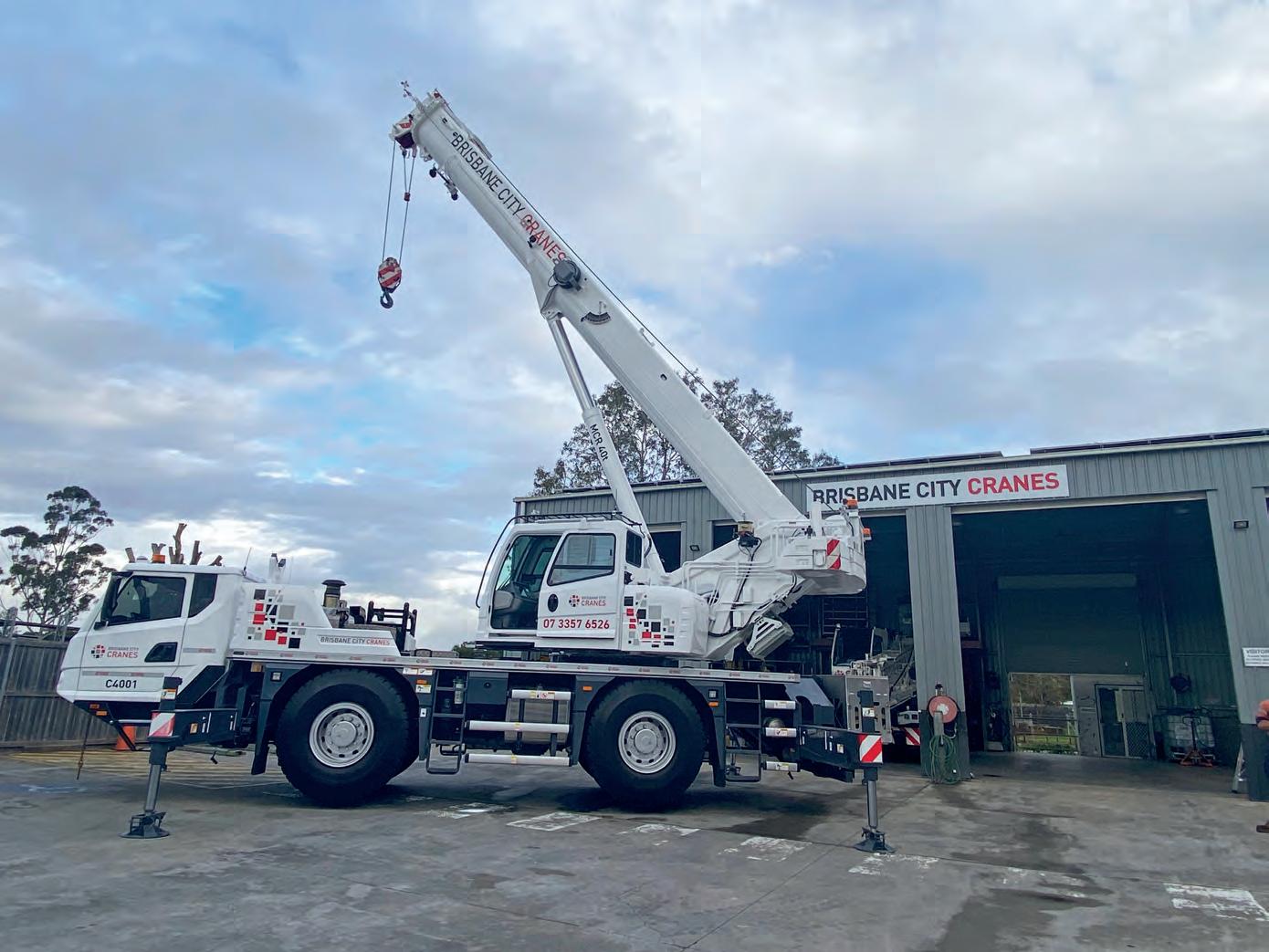

“That’s the concern for the European manufacturers. I believe this will prove to be a tsunami that’s going to sweep through the industry, and I’d rather be on the front end of it. As long as the product is going to be supported and we can see that XCMG is putting in place the right support structure and network,” said Joe.
“Through Stephen Broomfield, General Manager XCMG Oceania Crane Center, we have direct lines of communication to the factory and the technicians working with the cranes. I’m confident with the level of product support we will be receiving. It’s like any machine, as long as we are following the manufacturer’s spec, it’s going to run its course like any other machine, European or non-European.”
The XCMG comes with 35 metres of live main power boom and 16-metres of fly with a swing away fly attachment. It runs a single winch which is what Billy wanted in this class of crane.
“The fly attachments and running the single winch makes setup very straight
forward. Being a two-axle machine, it drops us down in class category for the Queensland On-Road Intelligent Access Program (IAP) registration. We’re not classed as a Category 2, we are in the Category 1 Non-IAP system which means we gain more access to public roads through Queensland Department of Transport and Main Roads,” he said.
Billy is also a fan of the XCMG’s operating system.
“The operating system is ‘stripped back’ and relatively simple and I’m a big fan. I was lucky enough to be taught by older guys, including my father, who would have absolutely no idea about today’s computers. When I say the operations are simple, the young upcoming guys have picked it up very quickly and for the older guys, it’s not too technical.
“Another feature we are impressed with involves the error code pages. We’ve got cranes where the error code booklet runs to 500 pages, and a technician has to read through these to determine what the issue
is. The error code booklet for the XCMG is much simpler,” he said.
Brisbane City Cranes is on the move. Billy recently moved into the role of General Manager and continues to drive the business, said Joe.
“We are going great in a market that is testing in respect to staffing and like everyone else in the industry, it is giving us a bit of a headache,” Joe said.
“We recently employed a full-time CAD (computer-aided-design) designer in the business which enables us to provide our own CAD lift plan drawings.
“We have continued to grow in a positive manner. I’m extremely happy where we’re at. Billy’s leading the business fantastically for us. We’ve just acquired this crane and we’re looking to acquire another crane in the next hopefully two months, all going well.
“There’s no figure on which cranes or how many, we just want to continue to support our clients, and our client list is growing exponentially.”





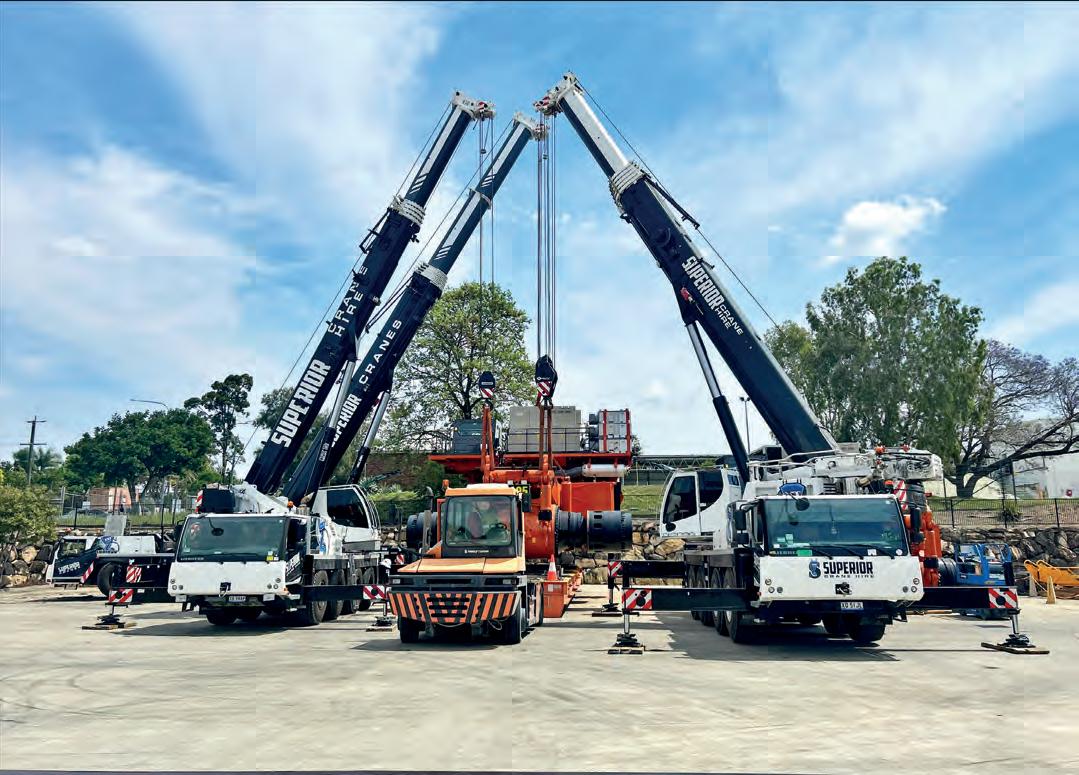
For a young man, Lachlan Stinson, Managing Director of Superior Cranes, is level-headed and wise beyond his years. Putting the wellbeing of his team and the service they provide to customers first, has stood the business in good stead.

“Initially we were operating secondhand gear to make ends meet, but we gradually got into our groove and developed relationships with customers and suppliers, especially Liebherr which is now the dominant brand in our fleet. We also run a fleet of Frannas. The Liebherrs
have been excellent for us, they are great quality and super reliable cranes backed by after-sales service and support which is fantastic,” he said.
Superior Cranes operates a fleet of 22 cranes, eight in Wagga and 14 in Brisbane and employs a crew of 50. Crane capacities start with a 13-tonne City Crane through to 250t capacity all terrains.
Lachie is proud of the work culture at Superior Cranes and firmly believes ‘Culture eats strategy’.
“We operate with a typical crane crew which includes four supervisors in the Brisbane yard and two in Wagga, a yard manager in each location, operators, riggers and dogmen, allocators and office staff.
“The crew is full of good people. I’m a strong believer that it is better to work with good people rather than those who are outstanding at their work but not good
people. We have a good work culture in both yards. Everyone gets along and we frequently socialise together, which helps build friendships and loyalty within the business. We are here for each other and that translates to a ‘can do’ approach when it comes to our customers,” he said.
“We are very family oriented. Some of the team have young families, as I do, and we understand and make allowances when the family has to come first. Obviously, field crews get RDOs (rostered days off) but in the office, we run a flexi-day system so that guys can have a day a month to do whatever they have to do,” he said.
Lachie explains how this culture works when it comes to planning jobs, how site inspections are managed, SWMS (Safe Work Method Statement) planned and lift plans generated.
“Our supervisors conduct the site inspections, as well as the SWMS and
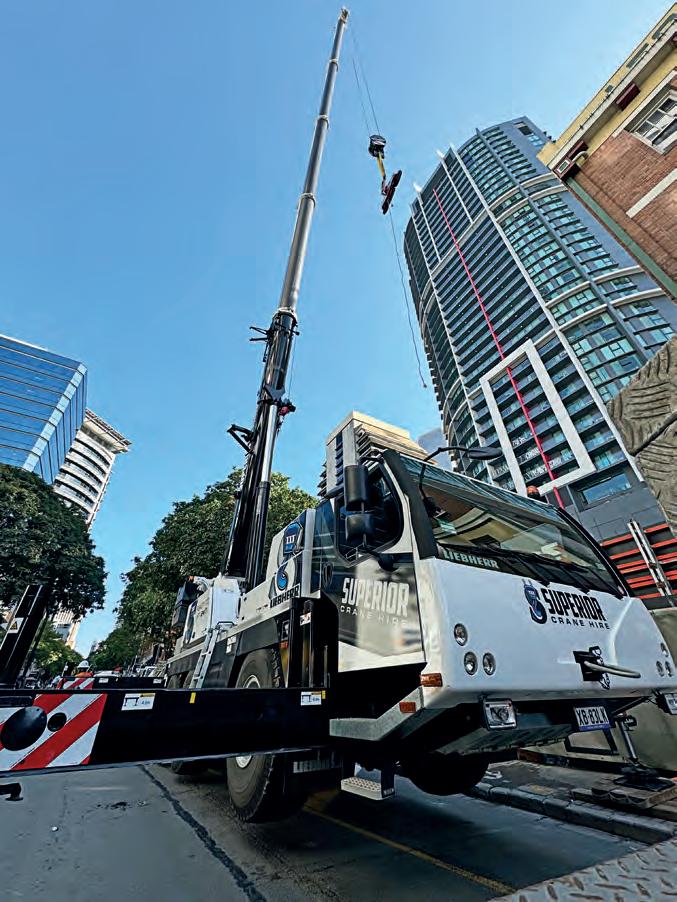
lift studies. We have a health and safety officer who manages the compliancerelated issues. Because we provide a quality service, and the ‘can do’ work culture of the team, we have strong relationships with our customers and a lot of work is repeat business. We have customers who have been with us for all of the 15 years, but you have to continually provide a good service with it being a very competitive market out there.
I always say to the team, ‘be kind and do your best, because being a good person goes a long way in life’. Although the crews laughed when I first mentioned it, they understand what I mean now,” said Lachie.
He can see a significant difference between his two operations with the Wagga Wagga team working on long-term projects and Brisbane managing general crane hire requirements.
“In Brisbane we are focused on dayto-day general hire work whereas the Wagga yard is very much project-based. We are working on the HumeLink East and HumeLink West power line projects as well as the SecureEnergy project.
“There is also the Inland Rail Project where we are working with Martinus Rail and John Holland. We are also servicing Evolution Gold Mine at Lake Cowal and there is a lot of project work on the largest pulp and paper plant in the southern
hemisphere. We are able to move assets between the two yards as demand comes on and off,” said Lachie.
He goes on to elaborate on the relationship with Liebherr and what he and his teams like about the product.
“We are very happy with Liebherr. In our opinion they provide a premium product which is backed by ‘second to none’ after sales service and support. Liebherr are good people. I have a good relationship with Bryce O’Brien and we’ve got a couple of new cranes coming including a 120-tonne and 150-tonne. We also recognise the need to go bigger with capacities and we’re examining our options.
“Adam Damon is our go-to for service and support, and his approach is second to none. I’m in touch with Adam a lot and he is always responsive, but if any of the crew have an issue and call him, he always picks up and has answers pretty much straight away. Liebherr cranes are super reliable and so are their people,” said Lachie.
“Another advantage of having a predominantly Liebherr fleet is the fact that operators can move from crane to crane effortlessly. Even though the capacities might vary, the operating systems are the same or very similar which makes life easier for our operations team,” he said.
With the Brisbane Olympics coming into view and projects ramping up for the Wagga yard, Lachie is planning the company’s near future very carefully.
“The Olympics are under seven years away and there is going to be a hell of a lot of lifting required,” he said. “Obviously, the bigger boys will be positioning themselves for the large stadium and infrastructure projects but there will be plenty of other work and that’s on top of Brisbane being a busy market anyway. For our Wagga yard, the HumeLink West project is about to really kick into gear, so that’s going to suck up a fair bit of labour and machines. I’ve got to be mindful of the impact this will have on the business. We don’t want to be left short in either yard, and we are working through this at the moment. But whatever we do in terms of new cranes, they will be Liebherrs.”
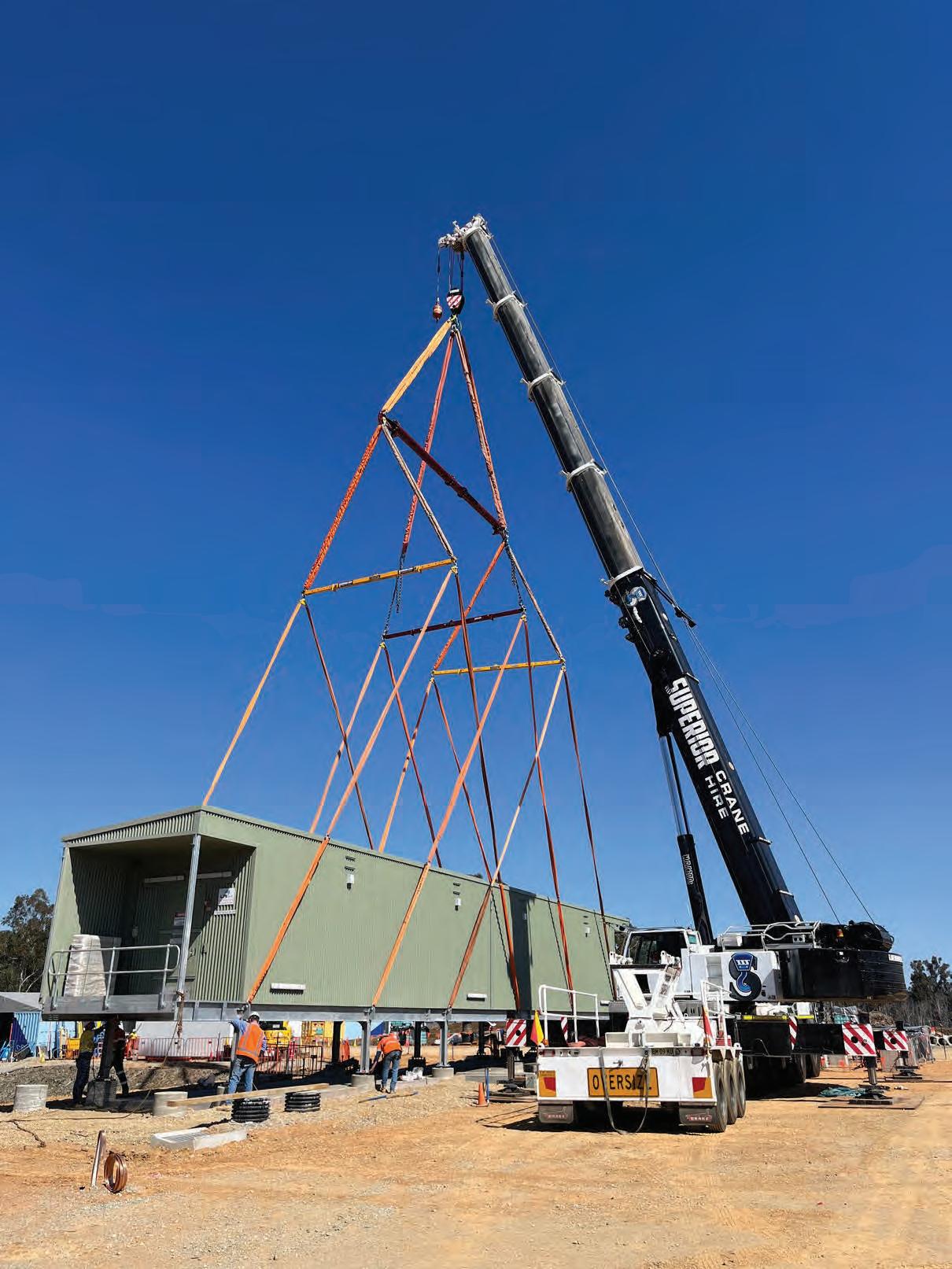

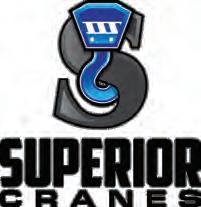
Mining and infrastructure projects are demanding bigger and safer lifts. Queensland-based Lee Crane Hire has turned to Zoomlion’s heavy-lift line-up to meet that demand. Managing Director Dan Story explains why the manufacturer’s new machines are proving their worth in Central Queensland.
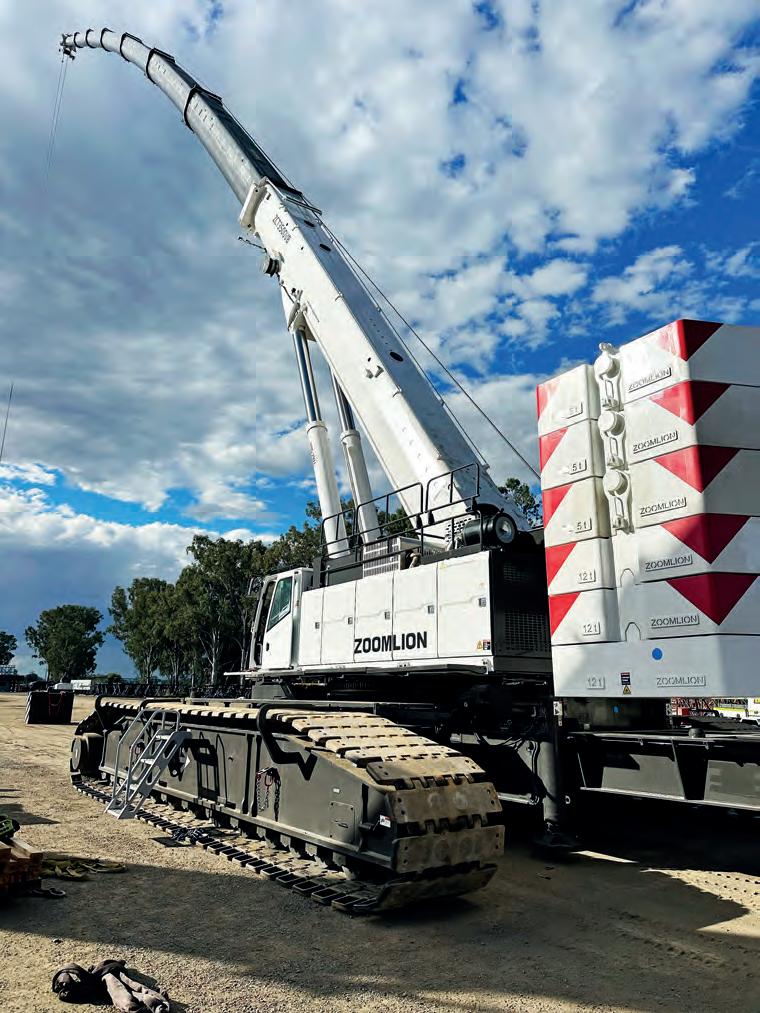
The Zoomlion ZCT3500V843 offers a 1130 tonne-metre lifting moment. LCH conducted on-site load testing. The boom deflection is within the crane’s normal technical specifications.
LEE CRANE HIRE (LCH) HAS GROWN INTO a trusted provider of specialised cranage and haulage across mining, power, infrastructure, and construction. The company’s work ranges from general crane hire and long-term site maintenance to short- and long-term projects, with a particular focus on heavy lifting and major shutdowns.
Dan described LCH as a family-owned and operated business with a culture that blends local and non-local staff. “LCH offers flexible working arrangements that will suit anyone in the industry,” he said.
“We have a successful, like-minded, long-term management team, and while larger than the publicly listed companies in Central Queensland, LCH maintains its small business feel. Everyone here feels responsible for its success, the staff know what they need to do to be the best, and they take pride in doing it for us, and themselves.”
When it came time to expand the fleet, LCH looked closely at Zoomlion. Dan said the brand had lifted its game in recent years.
“Zoomlion, in our opinion, has been producing products equally comparable to other manufacturers in the industry. Product support, development, customisation, and communication has actually been far superior,” he said.
He said that established manufacturers didn’t have a comparable product in this capacity. That made the 350-tonne telescopic crawler a clear choice for LCH’s operations in Central Queensland.
Compact transport dimensions make the 350 tonne telescopic crawler highly versatile for complex Central Queensland projects.
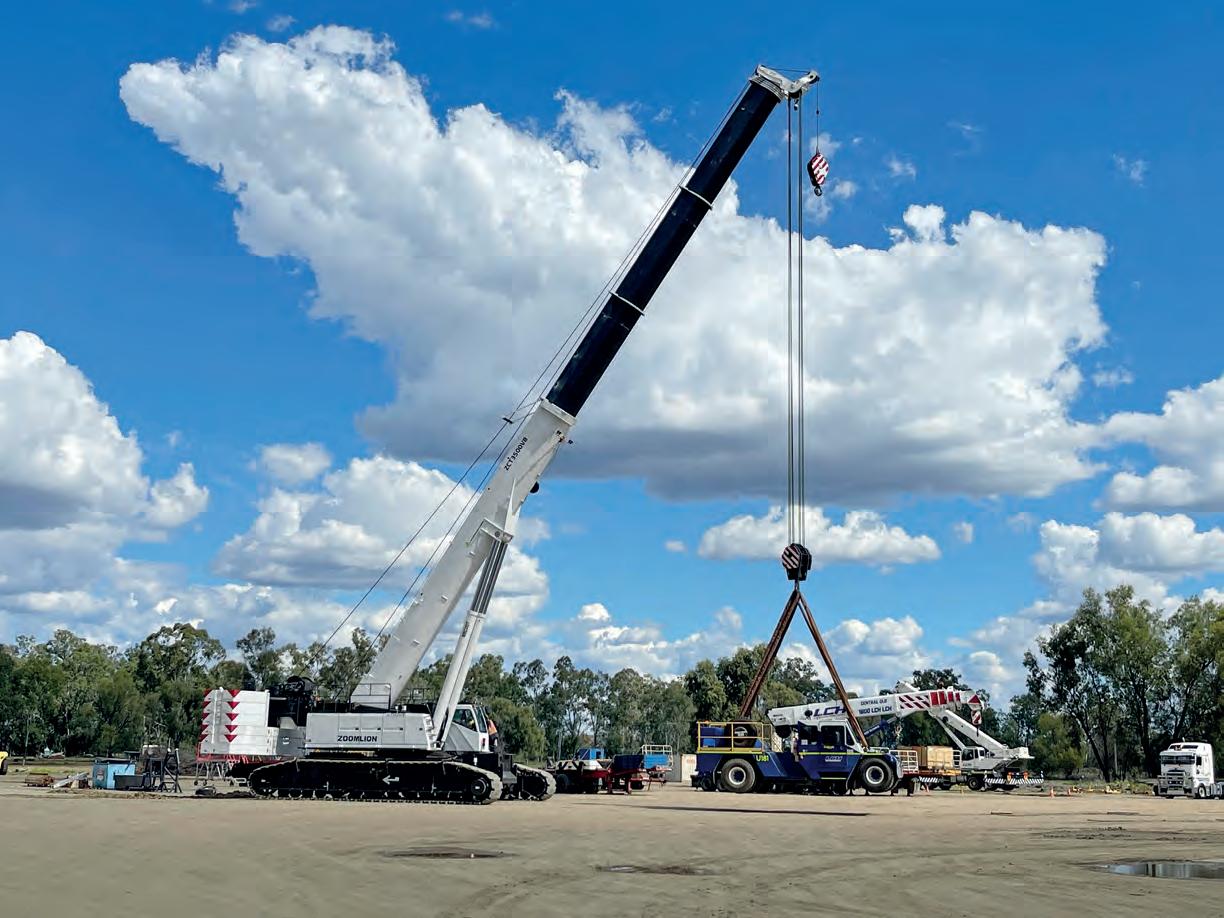
The arrival of the Zoomlion ZCT3500V843 has already made a strong impact.
“It outlifts and outperforms our current 220 tonne telescopic crawlers, significantly,” Dan said. “The 350 tonne is almost necessary now as the mining industry develops and the safety factors for lifting are increased. It has gone straight to our projects division to complete major shutdowns on draglines and shovels.”
The ZCT3500V843 is one of the world’s largest telescopic boom crawler cranes capable of working without outriggers. It offers a maximum lifting moment of 1130 tonne-metre and can handle ultra-high voltage tower erection up to 110 metres and bridge lifts up to 200 tonnes. Compact transport dimensions, multiple crawler width configurations, and remote-controlled self-assembly add to its versatility on site.
LCH is not stopping at the 350-tonne
model. A 400-tonne Zoomlion crawler crane is on the way. Dan said, “We intend to modify the 350 tonne tele crawler with a shorter boom and variable counterweight configuration to give us an increased lifting capacity. This is sure to give us a clear edge when providing cranage to Central Queensland.”
Before committing to a purchase, LCH hired a 350-tonne telescopic crawler through Nationwide Machinery Group hire division. That trial helped cement the decision. “It was the product support, development, customisation, and communication,” Dan said. “The simplicity and practicality for operators also needs to be noted.”
Dan’s visit to Zoomlion’s factory in China, invited by Nationwide, reinforced his confidence in the brand. “Zoomlion isn’t
a large factory of workers,” he said. “It’s full of high-tech machines and AI (artificial intelligence) monitored production lines, thousands of machines built and ready for delivery, spread across what could only be described as a small city. It has to be seen to be comprehended, we surely don’t have anything like that in Australia.”
Nationwide Machinery Group has been instrumental in LCH’s adoption of Zoomlion. “They have been with us every step of the way, without them, it wouldn’t have been an option,” Dan said. “The whole team goes above and beyond. They are a vital link between LCH and Zoomlion themselves. Nationwide play a crucial role in Zoomlion’s success in Australia, and Zoomlion has done well to recognise that.” Looking to the future he said, “They will be industry leaders, at the rate they are going. They are making strides, constantly developing and improving.”

Sarina Crane Hire provides expert cranage, heavy haulage, height access, and material handling solutions across all industries throughout Central Queensland, the Bowen Basin, and beyond.
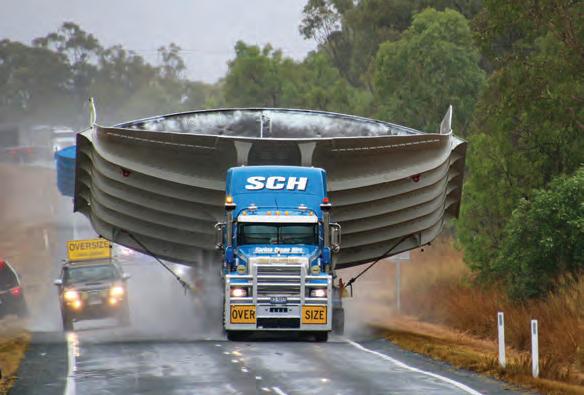
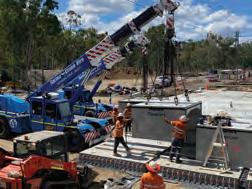
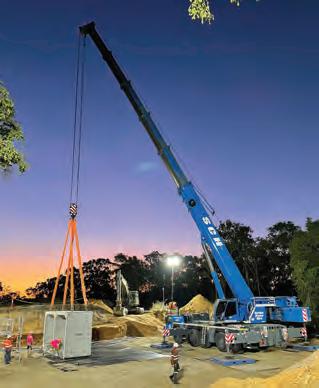
Sarina Crane Hire offers the ultimate in convenience and capability, with a comprehensive fleet of cranes, heavy haulage equipment, and height access solutions available 24/7.
We supply cranes & transport solutions tailored to any project or application, working closely with clients to develop cost-effective lifting and transport strategies to meet specific needs.
Our well-maintained fleet ranges from 12t to 250t cranes, including hydraulic crawler cranes and pin jib crawler cranes, ensuring we have the right equipment for every job.
Our experienced team delivers reliable service with a strong focus on safety and efficiency.
Get in touch with us for all your crane, heavy haulage & material handling needs.
“Don’t Accept a Lift From a Stranger!” P: (07) 49561364
With locations in Sarina, Mackay & Coppabella 24/7


Brisbane-based Power Reach has made its next big move in the elevated work platform (EWP) space, adding a Socage Raptor to its fleet through Altequip. For founder and owner Matt Hooper, the choice came down to capability, mobility, and after-sales support.
POWER REACH DIRECTOR, MATT HOOPER brings more than two decades of experience in the power line and utilities sector. After starting his career with Energy Queensland as a tradesman at 21, Matt worked across field operations, business development, and project management before deciding to strike out on his own.
“Power Reach is only just over a year old, but the growth has been strong. We’ve been focused on power line construction and renewable energy projects, while also providing elevated work platform hire,” Matt said. With a tight-knit team of skilled operators and subcontractors, the business has already secured projects ranging from electrical substations to rural line work, and it is now gearing up for a long-term Brisbane development. The company is also focused on mining, with its elevated work platforms fully specced for mining compliance and currently deployed in the Bowen Basin.
To support this growth, Matt turned to Altequip for the Socage Raptor, a spiderlift style EWP that combines compact design with surprising capability.
“The Raptor gives us 24 metres of height with a very strong side reach, and yet the machine only weighs 2.7 tonnes,” Matt said. That relatively light weight has given Power Reach a unique advantage.
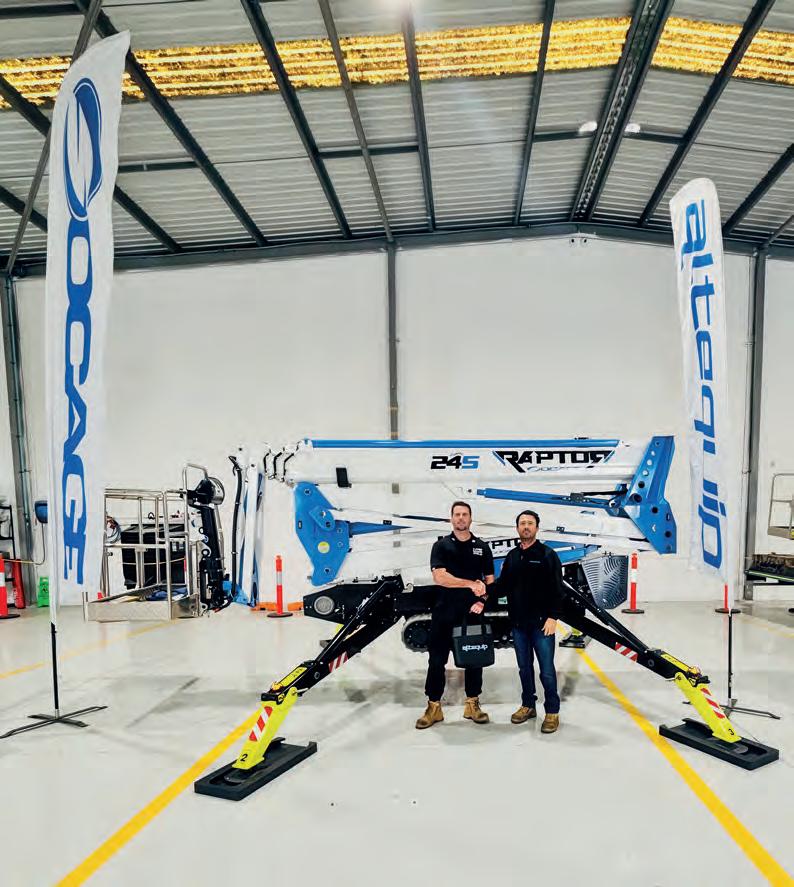
Matt had a custom trailer built so the Raptor can be towed on a standard 3.5-tonne-rated ute. “Normally you’d need a flatbed truck, which adds extra cost and time. With this setup, we can move the Raptor quickly between sites or around a large project. For our clients, it saves on transport fees, and for us, it makes the machine more versatile,” he said.
With strong industry ties and a hands-on team, Power Reach is using the Socage Raptor to expand its services across Queensland and beyond.
Beyond transport efficiency, Matt highlighted the stability of the Raptor in the air. “For a machine of its size, it’s very steady. I’ve operated a lot of EWPs, and this one feels like a solid workbench in the sky,” he said.
The Raptor’s design makes it suitable for a wide range of jobs. Non-marking tracks allow it to move across sports fields or indoor courts without damage, while radio controls and automatic levelling simplify set-up. The machine
can also pack itself down automatically, further speeding up transitions between tasks.
“We’ve already used it for tree work, substations, and rural power line maintenance. The Raptor is very userfriendly, and it’s proven itself in different conditions,” Matt said.
Additional safety features are also being fitted to meet tier-one contractor requirements. Power Reach is working closely with Altequip to integrate new protective systems directly into the machine’s controls.
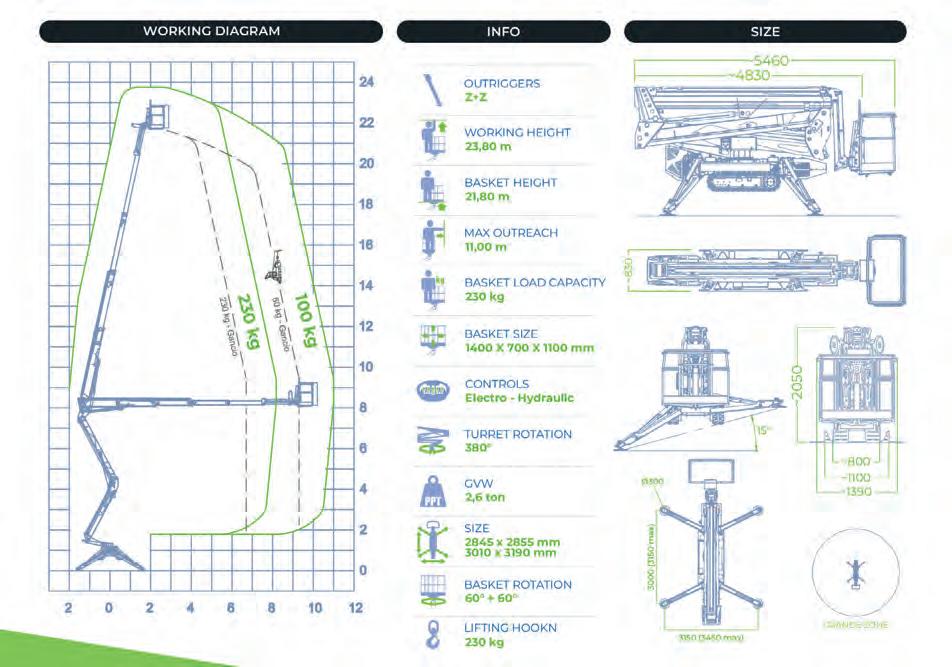
While the machine’s features were important, Matt said his decision ultimately came down to the people behind it. “I’ve known Robbie and Curtis from Altequip for years. They’ve always been prompt, supportive, and willing to go the extra mile. As a smaller company, that support makes all the difference. If a machine goes down, you can lose work quickly. With Robbie and Curtis, I know
I’ll get the help I need straight away,” he said.
That relationship goes back to Matt’s early days in the industry, when he bought his first truck mount from Curtis. “It was an older unit, but I knew it well and trusted it. That gave me the confidence to start building my own fleet,” he said.
Today, the same level of trust underpins Power Reach’s partnership
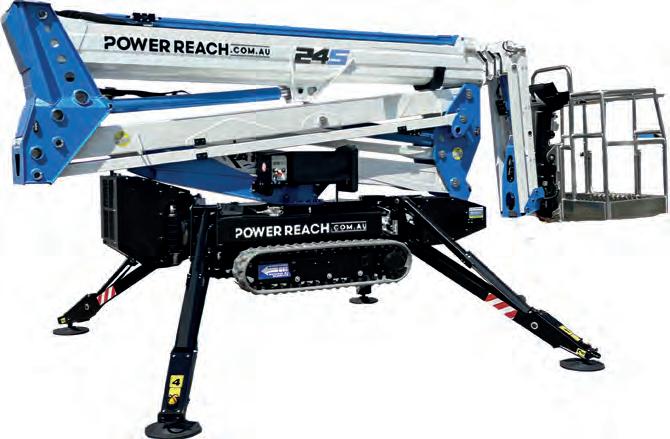
Above: The Socage Raptor delivers 24 metres of height with strong side reach, yet weighs only 2.7 tonnes – light enough to be towed on a 3.5-tonnerated ute trailer.
with Altequip and Socage. Matt still spends time at Altequip’s operations centre, working with the team to refine and customise his machine. “We’re adding extra features, and it’s never a problem. They’re always there to help,” he said.
For Matt, the Raptor is a way of positioning Power Reach for larger, longterm projects and for expanding into new markets. “At the moment, we’re focused on Queensland, but New South Wales is the next step. The opportunities are there; it’s just about building the fleet to match demand,” he said.
With its lightweight transportability, strong reach, and stability, the Socage Raptor is already proving to be a valuable asset for Power Reach. Combined with Altequip’s hands-on support, it has given Matt the confidence to push his young business into new territory. “We’ve got good people around us, and that makes all the difference,” Matt said.

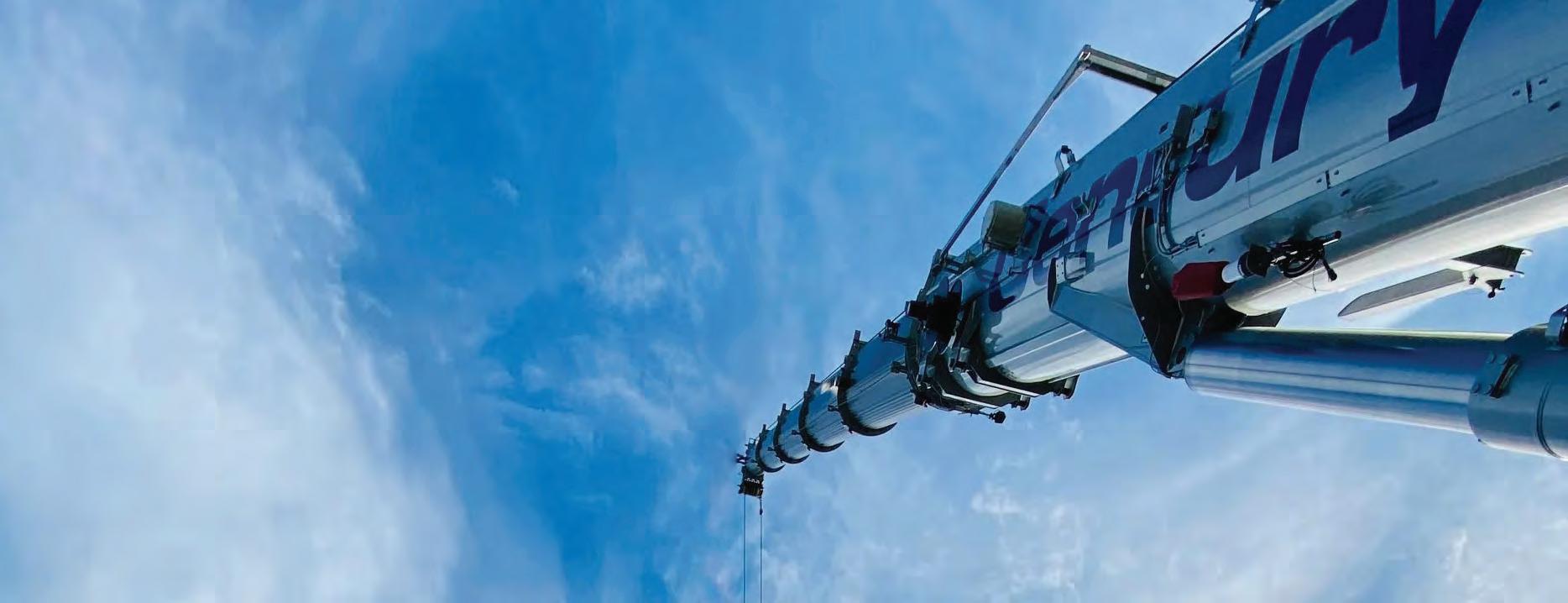

Your premier lifting partner

Locally owned and operated Cranes from 2.9T Spider to 250T All Terrain 24/7 responsive service across Far North Queensland
Century Cranes is Cairns’ trusted lifting partner with the region’s largest and most diverse fleet. From compact 2.9T spider cranes to powerful 250T all-terrain models, we deliver full-service solutions backed by local experience and community values.
Our skilled team brings expertise, precision, and passion to every lift. We provide tailored crane solutions for projects of all sizes while investing in the next generation through inhouse training. Century Cranes is more than a service provider — we’re a partner you can rely on.
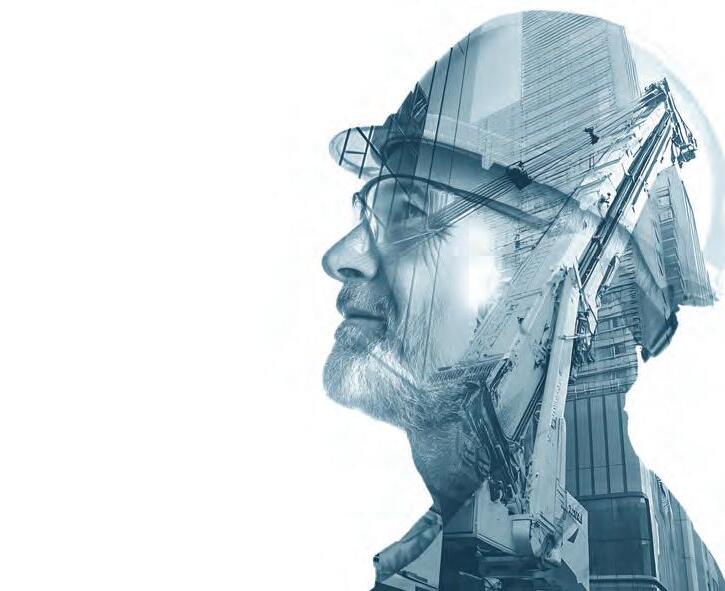
Cairns may be best known as the place where the reef meets the rainforest, but behind the palm trees and postcard views sits a crane hire business that has been quietly building a reputation for tackling just about anything.
Manager Bianca Wilson, has been keeping Far North Queensland moving for more than two decades.
“We’re a general crane hire company,” Bianca said. “If it needs to be lifted, we lift it.”
From caravans tangled in rose bushes to major infrastructure projects, Century Cranes has become a trusted partner across industries that outsiders often overlook in a town better known for tourism.
Bianca has been running the business for 23 years, long enough to see Century Cranes evolve from a small operator with just three cranes into a fleet of 23 machines. Today, the company runs everything from 2.9-tonne units through to a 250-tonne Liebherr.
“The weather and terrain here make truck cranes impractical, so we’ve built a strong fleet of all terrains, backed by Frannas and Katos,” she said. “Our bigger slew cranes are Liebherrs, while our smaller ones are Katos. The rest are Frannas.”
According to Bianca, the mix ensures versatility across civil, shipping, construction, and residential projects –without needing to stretch into mining work, which is left for larger operators further inland.
Behind the fleet is a crew that Bianca describes as a “mixed bag of lollies.” Century employs both fresh entrants to the industry and veterans who have been with the business for more than a decade.
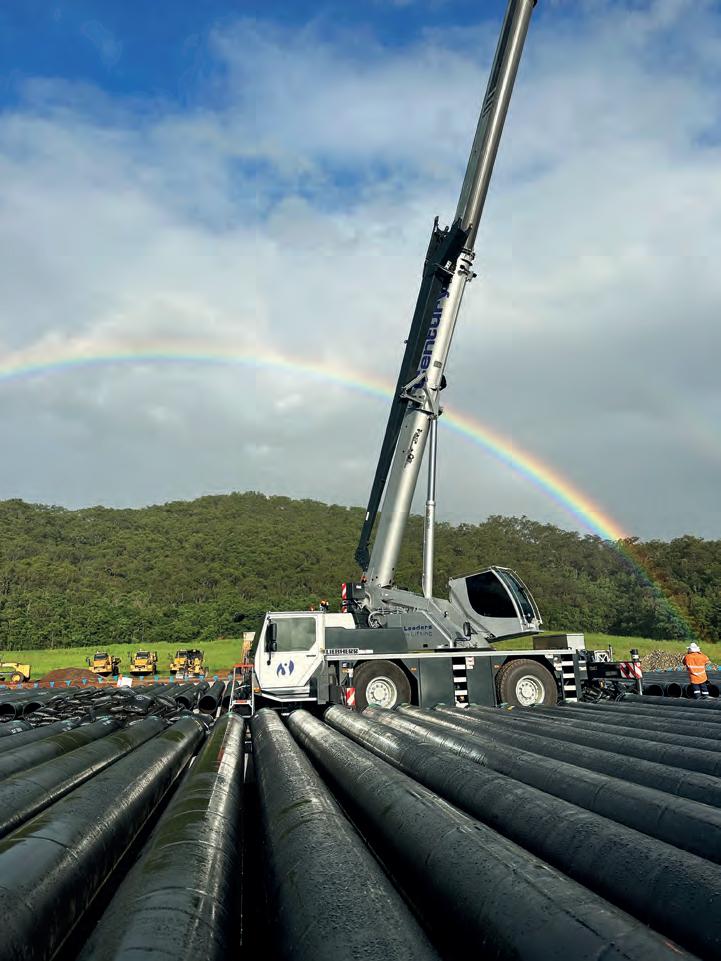
“We’ve got 18-year-olds and 68-yearolds working side by side,” she said. “We bring in young operators, train them properly, and then pair them with
experienced hands until they’re ready to be let off the leash.”
The approach creates a culture where knowledge is passed down naturally. Add in sausage sizzles, special breakfasts, and an emphasis on respect and communication, and Century Cranes’ workplace has become a rare combination
of structure and community. “Customer service is a big part of my background from tourism, so I run things differently to some others in the industry,” Bianca said. “We talk about our feelings, our tone, and respect for each other. At the end of the day, you have to be more than just a boss –you become like family.”
From crocodiles on rooftops to school formal arrivals, Century Cranes has spent more than 20 years lifting just about everything in Cairns.
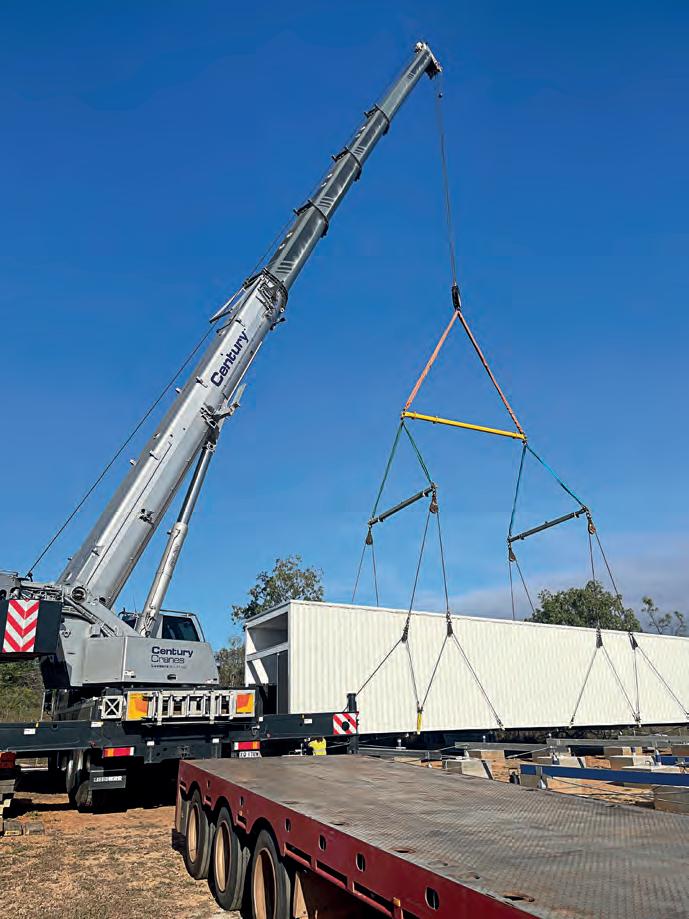
While Century’s bread and butter lies in construction and infrastructure, it’s the unusual lifts that get people talking. Years ago, the company was called in to remove a crocodile from the roof of the Cairns casino after an animal attraction closed down.
“We actually had to lift the crocodile up onto the casino, and then years later, we had to take it back out again.”
Then there was the high school student who wanted to make an entrance at his formal. Century Cranes obliged, delivering him to the Cairns Convention Centre in a 40-tonne Liebherr.
“It was compact enough to get through the porte-cochère but shiny enough to make a real impact,” Bianca said. “He was
over the moon – and he got entrance of the evening.”
Such stories reflect how embedded the business is in the community. From everyday residents to major civil projects, Century’s work is visible across Cairns.
The company’s fleet is built around Liebherr all terrains, which Bianca said have proven themselves through strong performance and reliable aftersales support.
“When we switched to Liebherr we couldn’t fault the service,” she said. “The after-sales is amazing. Bryce and the team have been excellent.”
Recent additions include a 70-tonne
Liebherr, chosen for its versatility as a taxi crane. “It’s a four-axle machine that rarely needs support vehicles, so it’s very efficient for our work,” Bianca said.
Century Cranes also operates nine Frannas, ranging from 15-tonne to 40-tonne units. Support for these machines comes directly from Brisbane, though the business also relies on its own full-time fitter.
“There are no crane repairers or maintenance facilities up here, so you have to do it in-house,” Bianca said. “As long as we can get someone on the other end of the phone, we sort it ourselves.”
Century Cranes is also in the middle of rolling out new logistics software, shifting to a cloud-based system through Visual Dispatch.
“We’ve had logistics software since 2008, but this is a big step forward,” Bianca said. “It means we can issue electronic tickets straight to phones and streamline how we manage our fleet. It was time for an upgrade.”
The move reflects Century Cranes’ focus on staying modern and efficient, even while working in a part of the country where distance and isolation can make operations more challenging.
For Bianca, running a crane business in Cairns has always been about adaptability. Century Cranes doesn’t shy away from residential lifts one day and large-scale water treatment projects the next.
“The preconceived idea is that Cairns is just a tourist town,” she said. “But the industries we support – civil, shipping, residential, infrastructure – are significant. We might not touch the mines, but within our region, we lift anything and everything.”
That balance of flexibility, modern fleet investment, and community connection has made Century Cranes a fixture in North Queensland. Whether it’s hoisting pipes by the thousand at a water treatment plant or creating an unforgettable experience for a teenager, Century Cranes is proving that even in a town known for tourism, a crane company can be just as essential as the reef or the rainforest.
Be guided by our dedicated team of crane specialists
As Australia’s leading industrial auction house, Pickles is renowned for securing value for our customers. By choosing Pickles’ trusted online marketplace, customers will gain access to an exclusive database of active buyers and a hassle-free experience.
9.3M+ New Users
2.5M+ Returning Users 222M+ Pages Viewed
FY25 results
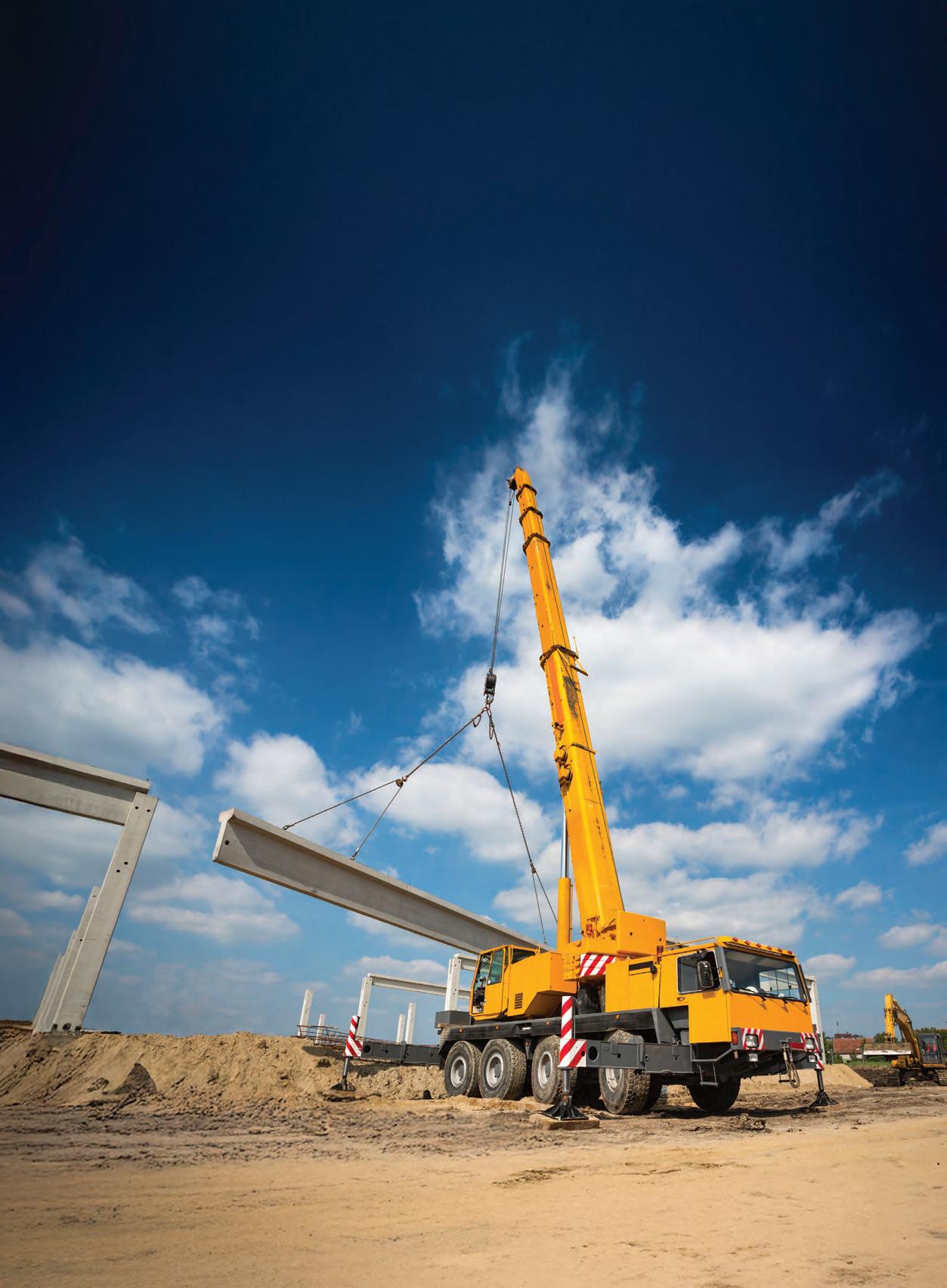
Contact one of our crane experts to get started or scan the QR Code to explore our range of quality Industrial assets.



James Chauncy 0418 612 739
National Sales Manager –Trucks & Machinery
Ben Hallam 0407 254 718
State Sales Manager, WA
Grant Barrie 0434 079 653
State Sales Manager, QLD

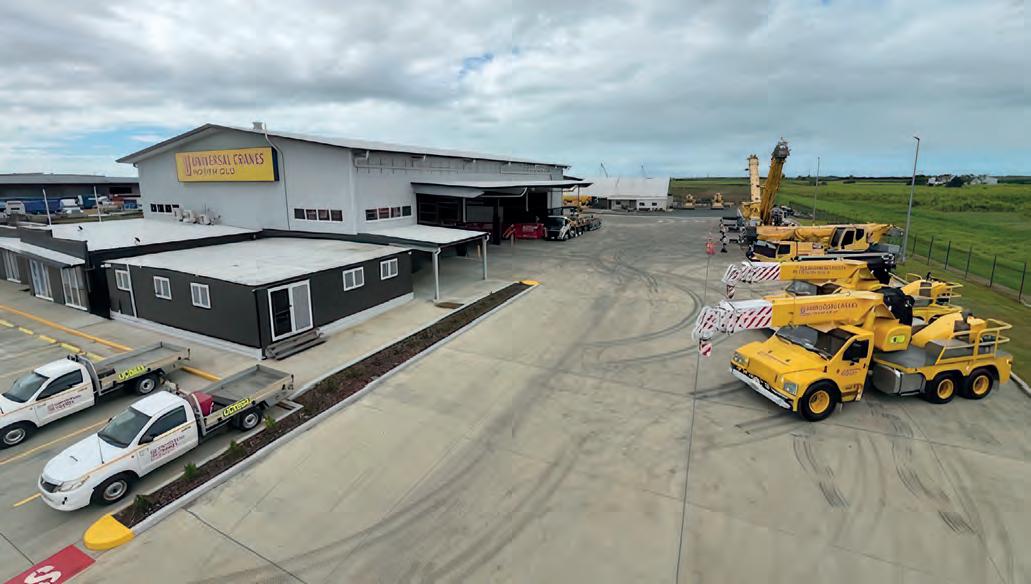
It has been a significant 12 months for the team at Universal Cranes North QLD including continued growth and the opening of their new Diesel Drive Depot in Paget, Mackay. There will be more news including additions to the fleet says Gordon Willocks, Universal’s Managing Director for the North Queensland region.
“AS WELL AS OPENING THE NEW DEPOT IN Mackay last year, we operate a significant 14,000 square-metre depot in Townsville and our work can take us as far north as Thursday Island and Archer River in the top end of the Cape York Peninsula. We also reach right out to the west and north-west corners and into the mining regions, so we cover a fair distance in the North. To the south, Universal ranges between Mackay and Rockhampton, which is the cross-over between the branches further down to Universal Cranes Central Queensland,” said Gordon.
Universal Cranes North QLD operates 32 main crane assets between the two branches and currently has other machines cross hired from other Universal Cranes divisions deployed for project work. The business is supported by a team of 60 employees across the two entities.
Universal Cranes North QLD services a broad and diverse range of customers including coalfields west of Mackay in the
Bowen Basin region, and including the coal terminals at Hay Point. The team also services the rare earth mineral sector in the Northwest corner of the state as well as the renewables sector, particularly the GeneX Kidston project, which is one of the major pump hydro projects currently underway in
Below: Universal’s Ben Smith and Gordon recently bid generously for Rens Million Dollar Mission and helped raise
“Our client base is diverse and includes a strong mix of what’s existing including coal, what’s rare earth in the mineral sector and what’s new in the renewable space. To service this diversity, we require a broad range of capacities in the fleet.
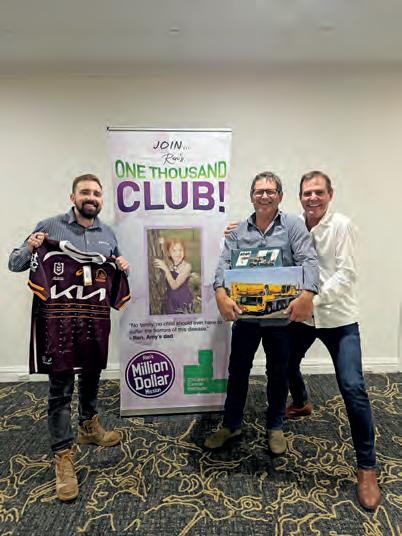
“Last year we added a 450t then an additional 350t crane to the support range. We’ve positioned these assets in North Queensland to complement the fleet and build on the size of the works and projects we are currently working on. Traditionally, in North Queensland, the largest crane you would find would be in and around a 250t to 300t all-terrain, but customers are now seeing the benefits of utilising larger machines.
Universal recently ordered the latest release Liebherr LTM 1400-6.1. The 450t and 350t cranes are secondhand machines put into the market to generate heavy lift work now, and the new 450t will support this strategy in the long term said Gordon.
“It takes time for customers to see the
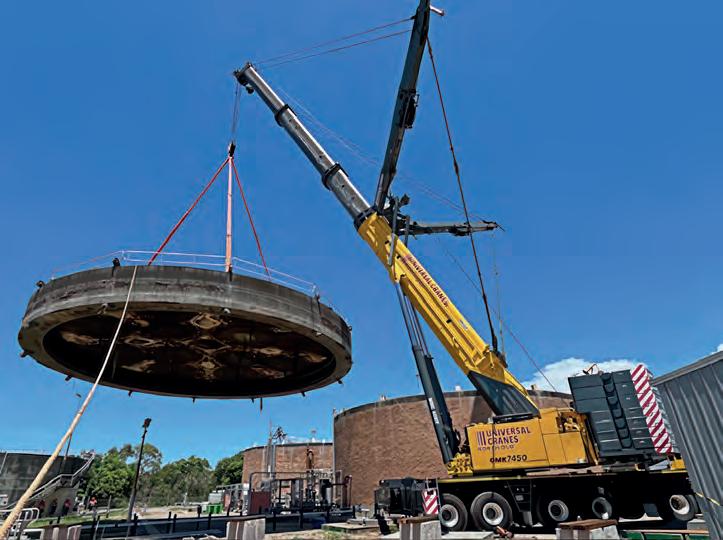
benefits of bigger machines, and until now we have been deploying cranes from the southeast for a one-off for project work and it would return back again. Now, we’re starting to see customers think about that space differently, they’re understanding the larger modularised systems and bigger load oppertunities and of course, we are keeping pace with that development,” he said.
In 2008 Universal purchased the Hinspeter Crane Service business in Townsville, an over one hundred year old, family-owned business and this has proved to be the stepping stone into the region.
“With the acquisition of Hinspeter Crane Services, we inherited a number of loyal customers and we’ve built and extended these relationships. In 2014 we saw an opportunity in Mackay and we were successful with that tender. We’ve now been servicing the Mackay area for over 10 years and we also have a strong foothold in the market in terms of our customer base,” said Gordon.
Over the last five years Universal has been investing continuously in business systems and processes including online platforms for repairs and maintenance, screen sign-on dockets plus invoicing and tracking systems. These new platforms have meant a big change for the business and meant adjustments as business processes move online creating a more paper-free type environment.
“We’ve been modernising our systems
and leveraging from the wider business and the Smithbridge Group by aligning a lot of our systems to suit. We recently implemented the Myosh platform which manages our safety, tracking and reporting systems. It is a well recognized, accredited system which is looked at favorably by Tier Ones and large mining companies. We can report information in real time and the system also assists with our requirements around our ISO compliance as well,” said Gordon.
Universal Cranes North QLD boasts an experienced team with a ‘can do’ attitude as well as significant capabilities in lift planning and engineering complex lifting solutions.
“Our team has significant levels of experience with a number having plus 10 years, a handful with over 15 years, and a majority with 3 to 5-year. We are focused on creating loyalty within our workforce and providing a positive environment across a wide variety of works.
“With our customer base being so widespread, we have a lot of people working away but our workforce is very dedicated, and we see a ‘hands up’ attitude about being away and getting on with the work at hand,” he said.
“Currently we have a handful of inhouse team members on our management side that are CAD conversant. They can work on basic to very detailed planning depending on the client’s requirements
and the complexity of the lift. Generally speaking, we will supply clients with a large ‘pre-lift pack’ of information fulfilling most client’s requirements. A lot of the requirements ensuring the process from site inspection to the design of the lift, through to the lift execution is streamlined. This approach provides job specifics and accuracy for our workforce so they have the confidence and assurance to execute the lifts when out in the field,” said Gordon.
Universal Cranes North QLD supports and sponsors a number of charities and community based initiatives. Supporting mental wellbeing initiatives such as Mates in Construction/Mates in Mining (MIC and MIM), R U OK, the popular TradeMutt, ‘This is a Conversation Starter’, Funky Shirt Friday’s are also important to the team.
“Supporting charities and community initiatives, including local sports clubs and teams is really important to the business and a lot of our staff get involved and volunteer their time across a broad range of organisations. One charity that we have been a long term supporter of is the “Cure Starts Now “and the recently formed “Rens Million Dollar Mission”,” said Gordon.
Amy was a feisty little redhead who loved ballet, athletics, singing at the school talent show and wearing monster teeth. In her dad’s words, she was an ‘unstoppable force.’ Devastatingly, at age 7, Amy was diagnosed with diffuse intrinsic pontine glioma (DIPG), an extremely aggressive childhood brain tumour for which there is no known cure. Just 16 months after diagnosis, DIPG would claim Amy’s life. After Amy’s passing, Amy’s dad Ren set about to change the future for children diagnosed with DIPG. ‘Since we lost Amy, I’ve used every ounce of energy to raise money for research that will find the answers to DIPG. My pledge to our little angel is to do everything in my power to find a cure,’ Ren said.
“Ren spoke recently at the CICA Regional Event in Townsville and his charity was the recipient of the industry’s generosity raising $27,000. We were actually on ground when that event was unfolding for Ren and his family, so it is very close to our heart,” said Gordon.








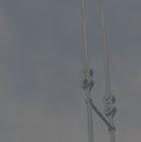







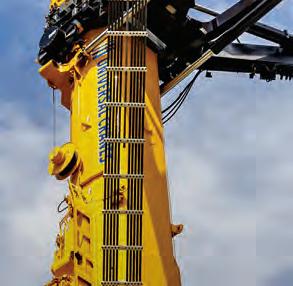




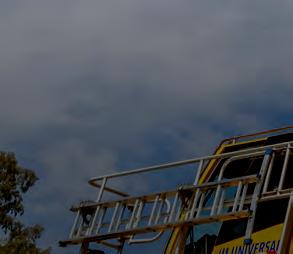
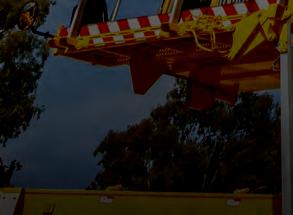



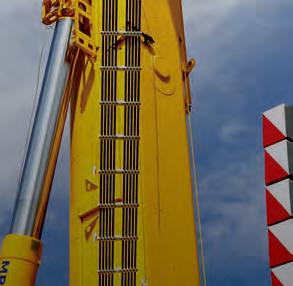
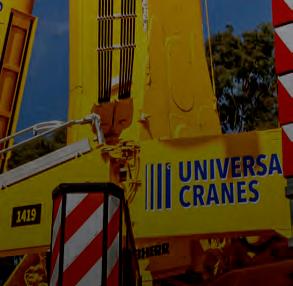
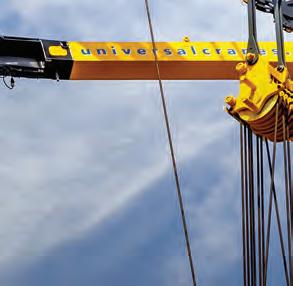
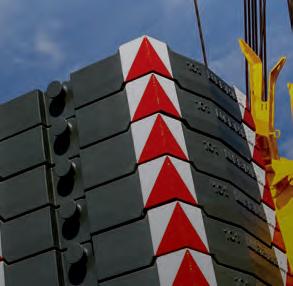
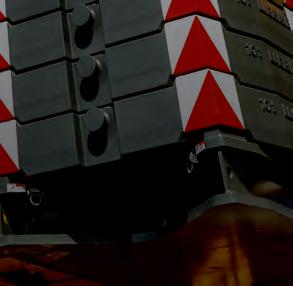

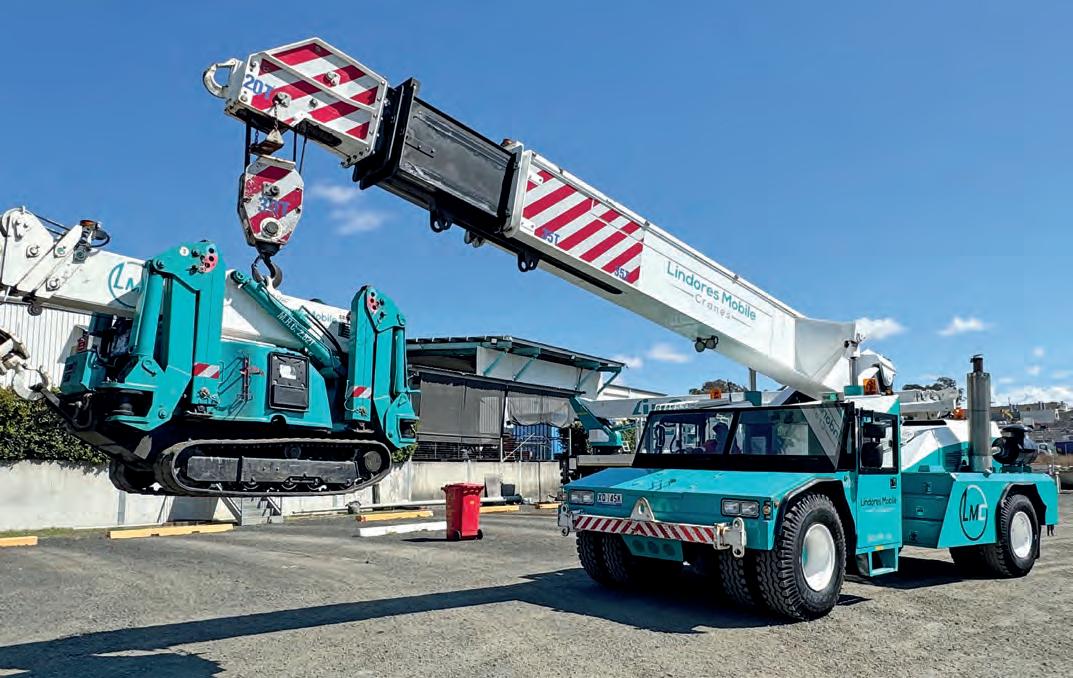
DRA Engineering, designer and manufacturer of the Humma range of pick and carry cranes, recently announced the appointment of Brendan ‘Cookie’ Cook. Up until now, DRA has relied on the testimonials of happy customers to sell the product, Cookie is the first salesman to be directly employed.
DRA COULD NOT HAVE FOUND A MORE qualified salesman with Cookie, involved with pick and carry cranes for over 30 years, dating back to his time with the Linmac brand. Cookie takes up the story.
“My association with pick and carry cranes has come full circle. I started off with Linmac in the mid ’90s before its demise and Peter Dalla Riva saw the opportunity to take on some of the engineering team, which led to the development of the Humma.
“When Peter Dalla Riva senior found out I was available he called and said, ‘how do you feel about the Humma? I said, ‘your crane is the best kept secret in the industry, Australian-built and the customers I have spoken with who have one, love them’.
“He flew me to Perth and I was not quite sure what to expect. But when I got there, I couldn’t believe what they were doing in their state-of-the-art manufacturing facility. The cranes are fully
manufactured in-house including painting of the machine. I informed Peter senior and junior that the East Coast had mostly no idea the advances in pick and carry crane technology you’re making over here; it totally is eye-opening. The innovation they pack into the Humma is amazing, people really need to take a fresh look at these industry-leading cranes. It’s also notable the number of features that have been copied by other pick and carry companies.
“I know the airbag suspension Humma has been running for a number of years, but unless you get in and drive it on the road you won’t know how smoothly it runs, the feeling of safety and comfort you get when travelling is unmatched by other manufacturers. Also, I was surprised that their boom was two and a half metres longer than the opposition, which is a huge advantage.
“DRA is a family-owned company so you can talk directly to them and get things done, they take on board your thoughts as well as the customers, continually listening and so improving the product. Unlike working with a corporate organisation where you become a number – the customers become numbers as well – and they concentrate on profit over service
if they are aware of it or not. As far as innovation is concerned, they are ahead of the curve and remember, Humma is Australian designed, engineered and manufactured. I look forward to this genuine opportunity with DRA Group’s Humma range,” said Cookie.
Initially Cookie will concentrate his efforts in Queensland, but he is well connected up and down the East Coast having worked with crane hire businesses in all major cities and surrounds including Adelaide, Melbourne and Sydney.
“I’ve tapped into my network and the feedback I’ve received is ‘yeah, they’re a good crane, but there isn’t a genuine understanding of what makes Humma stand out from the rest, I’m here to show them there is a better option and it’s truly Australian,” he said.
Chantelle Lindore, from Lindores Mobile Cranes, is a great example of a happy Humma customer.
“The Humma joined our fleet four and a half years ago. One of the main reasons for deciding on the Humma is that it is designed, engineered and manufactured in Australia,” Chantelle said. “Before purchasing the crane, I visited DRA Engineering’s factory and looked at the way the Hummas are manufactured. I spoke to Peter Dalla Riva senior and junior and came away very impressed with the way their business is run, not just the Hummas.
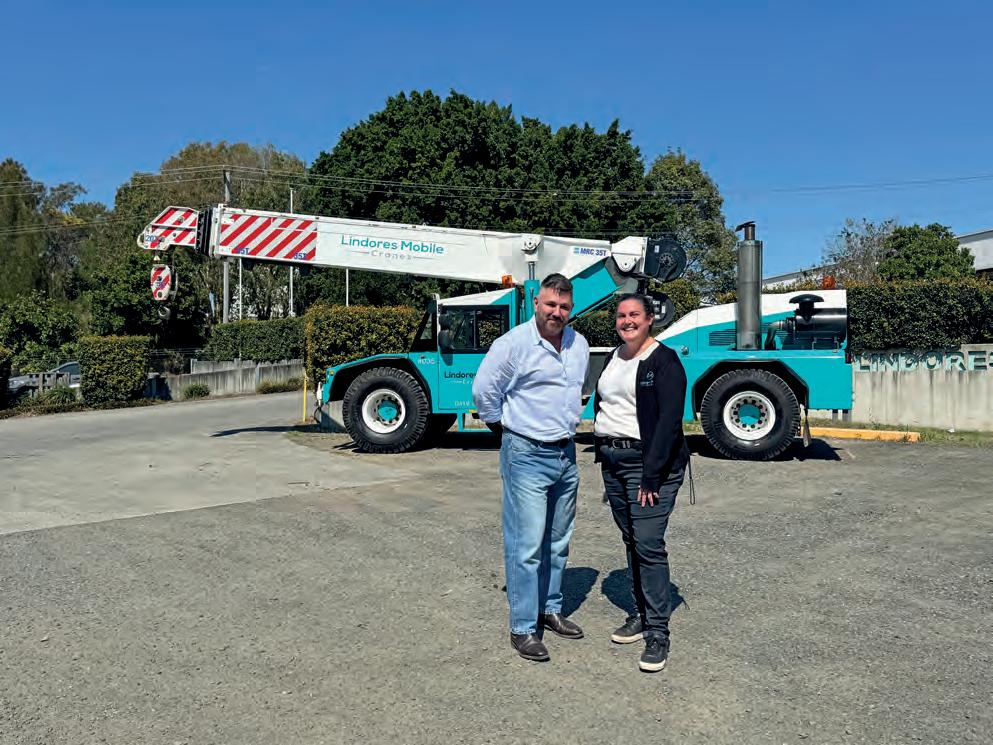
including lifting pools and moving building materials around. It has proved ideal for dual lifting, basically when it comes to heavy material that has to be picked and carried, the Humma has proved to be ideal.
“The team conducts a site visit before every job to assess which crane will suit
“Although there were doubters close to me, I decided to give DRA a go and try out the Humma and nearly five years later my decision has proved to be excellent – it’s a really good crane.
“Like any crane, it has little issues now and again but they have been easily resolved and like anything new, the crew did take a while to warm up to it, but once they’d operated a few times they loved it and still do.
“Hanchard’s were the first to purchase a Humma in Brisbane and they had a couple of trials. I had a few ex-Hanchard guys working here at the time and when I mentioned I was considering purchasing the Humma they only had good things to say about the crane,” said Chantelle.
With it’s additional lifting capacity, the Humma is used for all types of application
of service businesses with experience of the Humma brand said Chantelle.
“Humma’s support team is great, I can send an email or ring and always get a really quick reply. If I call either of the Peters, they always pick up, and there are a couple of local service providers who know and understand the Hummas.
“I know the airbag suspension Humma has been running for a number of years, but unless you get in and drive it on the road, you won’t know how smoothly it runs, the feeling of safety and comfort you get when travelling that is unmatched by other manufacturers.”
the application best. Frequently, the guys will come back and say, ‘we definitely need the extra counterweight so it’s the Humma for this one’. We have other pick and carry cranes in the fleet and the Humma is frequently chosen for jobs over and above these. The operators have also been impressed with the way it drives on the road and that’s as a result of the air bag suspension,” said Chantelle.
The service and support from DRA has been excellent and there are a number
“We’ve been working with Nick from IND in Yatala and there’s also Luke from MCSM. There’s are now a number of Hummas working locally. Sam from Pivot Crane Hire is on the Gold Coast and has two. He came up to see mine before he decided to go with Humma, it was the same with Boonah Crane Hire who bought one after they took ours for a test drive. I’m pleased to meet Cookie and now he is on board, I’m sure the Humma pick and carry will go from strength to strength.”
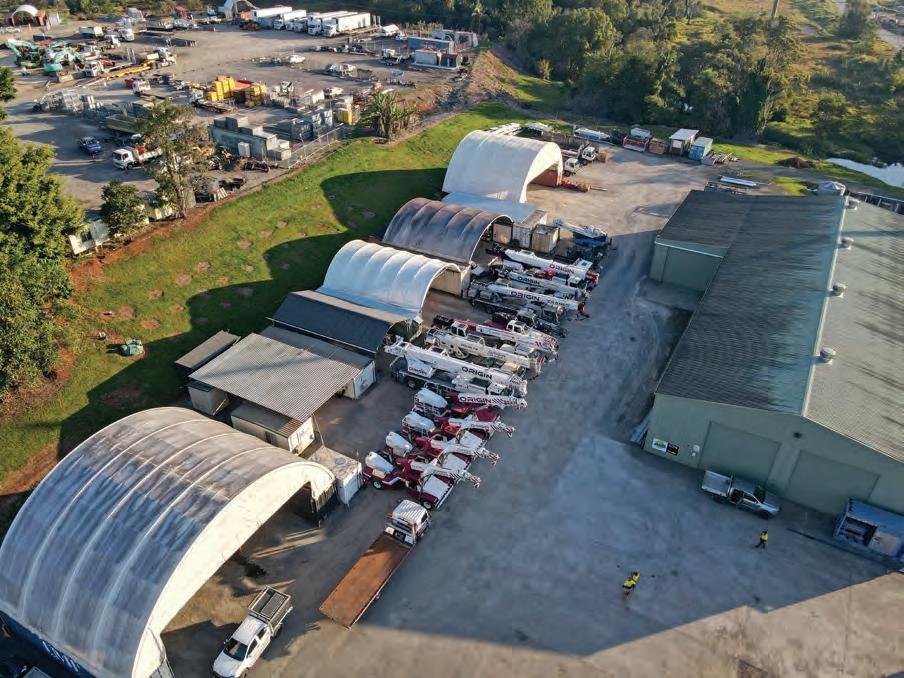
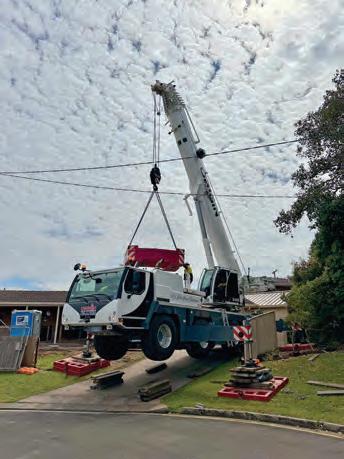
With dedicated staff to assist you in running your next project. Origin Cranes has you sourced. From domestic housing work, private hire for tiny homes, pools and containers to commercial high rise and factory moves – We will provide a step by step process from your 1st phone call.
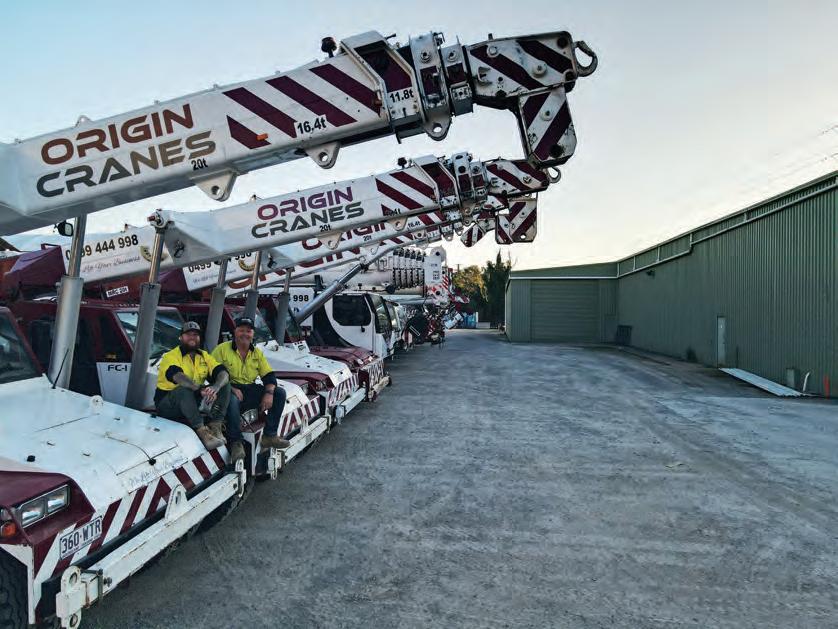
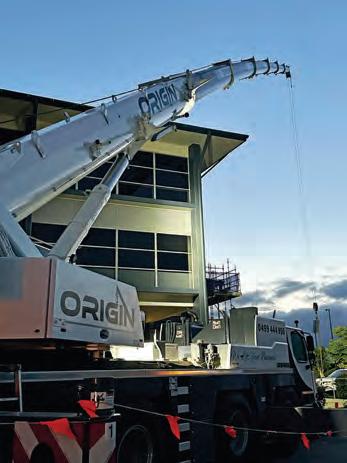
CURRENT FLEET: WE LIFT YOUR BUSINESS
• 2 x 1090 4.2 liebherr (100t class)
• 55t Terex Challenger
• 40t Terex Demag
• 2 x 25t Zoomlion Truck Mounts
• 13t Kato City
• 16t Kobelco City
• 3 x 20t Terex Franna’s
• 1 x 25t Superlift Franna
• Crane truck
• Tilt Tray
• Support trucks



Call now for your free no obligation on-site inspection 0499 444 998


For crane owners, the real value of a machine extends beyond its lifting strength –it’s about how quickly and efficiently it can be added to the fleet to keep projects moving on time. That’s where the partnership between DLL and Tadano stands out.
BY COMBINING THE LATEST CRANE technology with financing tailored to the industry, they’re giving Australian businesses a smarter, faster path to growth without tying up capital in large upfront investments.
Tadano is one of the world’s leading crane manufacturers, with factories in Japan, Germany and the United States. The company has steadily grown its footprint in Australia, particularly since acquiring the Demag brand, which doubled its scale both locally and globally.
Jason Perry, Tadano’s Sales Manager for Queensland, Northern Territory and Papua New Guinea, has seen the industry change dramatically in his nine years with the company.

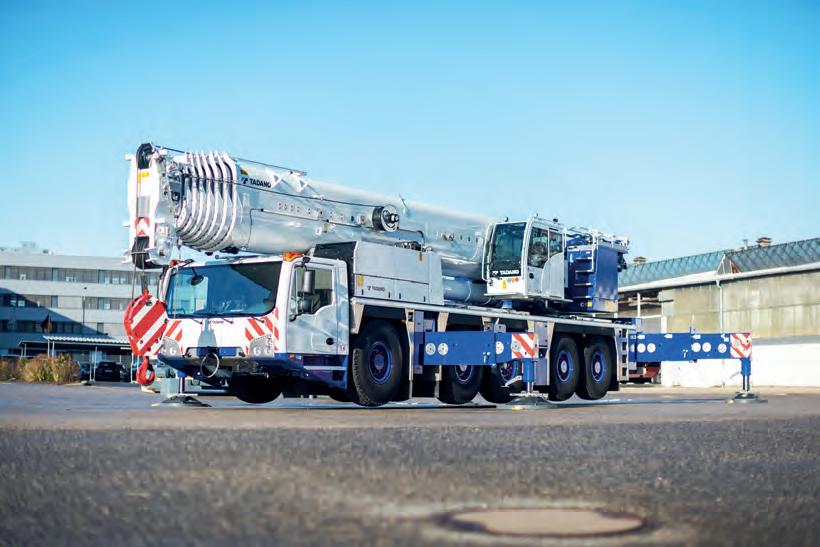
“Ten years ago, the crane industry in Australia was relatively small, with only a handful of major owners,” Jason said. “Today, there are far more players in the market, and Tadano’s global market share has grown, not only because of the company’s efforts in introducing new product offerings but the overall expansion
of the industry. The importance of having reliable and efficient finance solutions has never been more vital to achieving success in today’s market.”
DLL, meanwhile, brings more than 60 years of asset financing experience. A wholly owned subsidiary of Rabobank, DLL operates in over 20 countries, supporting industries from construction to agriculture.
“DLL is a global asset financing partner,” said Brendon Mayo, Account Manager for Construction at DLL. “We partner with vendors and customers to support them on their financing journey. In Australia, we’ve made significant investments in the crane and construction industries and integrate closely with Tadano’s sales team to support their customers’ financing needs.”
For many crane owners, the high upfront cost of equipment is a major barrier. That’s why the partnership between Tadano and DLL is so significant.
DLL’s role is to arrange flexible financing terms for qualified Tadano customers,
helping them achieve productivity and profitability goals while managing operational costs.
Brendon explained why this flexibility matters. “Every deal is different. We take a bespoke approach to financing, putting the customer at the centre of the partnership. It’s not just DLL and Tadano – the customer is the third part of that relationship. By understanding how the crane will be deployed, the contract terms, and the business’s cash flow, we can structure financing that works from day one.”
This often means going beyond traditional models. DLL offers everything from operating leases, which can reduce risk on project-based acquisitions, to standard equipment loans with tailored repayment structures.
“One example is when we assisted a customer who had won a contract with significant start-up costs and delayed payment terms,” Brendon said. “We matched the cash flows of their project so the crane was cash-flow positive from day one. That kind of flexibility gives
Smart capital and trusted machinery are giving businesses a faster, more sustainable path to expansion.
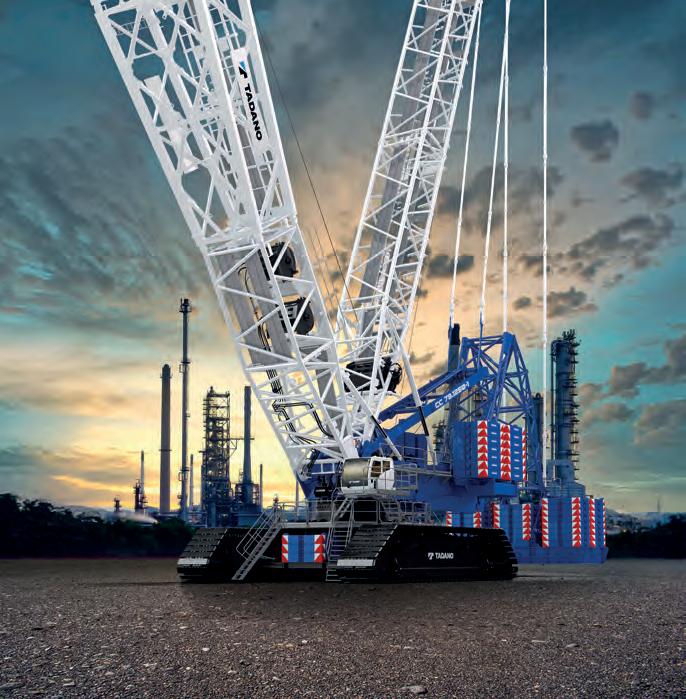
businesses confidence that their investment will perform.”
Financing is only valuable if it moves at the pace of the industry. When financing through conventional pillar banks, crane owners often face delays and that can mean losing business opportunities.
Jason said that this is where DLL stands out: “The biggest thing is responsiveness. Brendon and the team are quick to get back to us, and that matters because when a crane buyer is ready, they want answers fast. From the first conversation, DLL gives us confidence about what’s possible and how far we can go.”
The crane industry is cyclical, shaped by construction activity, commodity prices, and infrastructure investment. Costs have risen significantly in recent years, putting pressure on smaller operators.
Brendon believes DLL’s long-term approach is what sets it apart. “We’ve worked with some vendors for more than 20 years, through multiple up and down cycles. Where other funders might tighten their belts in tough times, we see opportunities,” he said.
“We take a longer view, which helps our partners and customers keep growing even when conditions are challenging.”
That outlook is particularly important now. While the industry has faced some headwinds, Brendon sees positive signs ahead. “We’re coming out of a downward cycle, and that’s when opportunities present themselves. The partnership with Tadano helps customers take advantage of those opportunities when they arise,” he said.
Another strength of DLL’s approach is its industry knowledge. Traditional banks may not always understand the unique nature of cranes as assets.
“Cranes aren’t like other equipment,” Jason said. “They’re complex, they hold their value differently, and the market operates in a unique way. DLL understands that which means they can offer solutions that banks often won’t. For our customers, that means more options and a better chance of securing finance when they need it.”
The partnership isn’t limited to mobile cranes. As Tadano has expanded into aerial work platforms and truck-mounted solutions through acquisitions, DLL’s financing covers these products as well.
“Our access equipment portfolio is already a significant part of our business in Australia,” Brendon said. “Partnering with Tadano on these products means we can bring more options to our existing customer

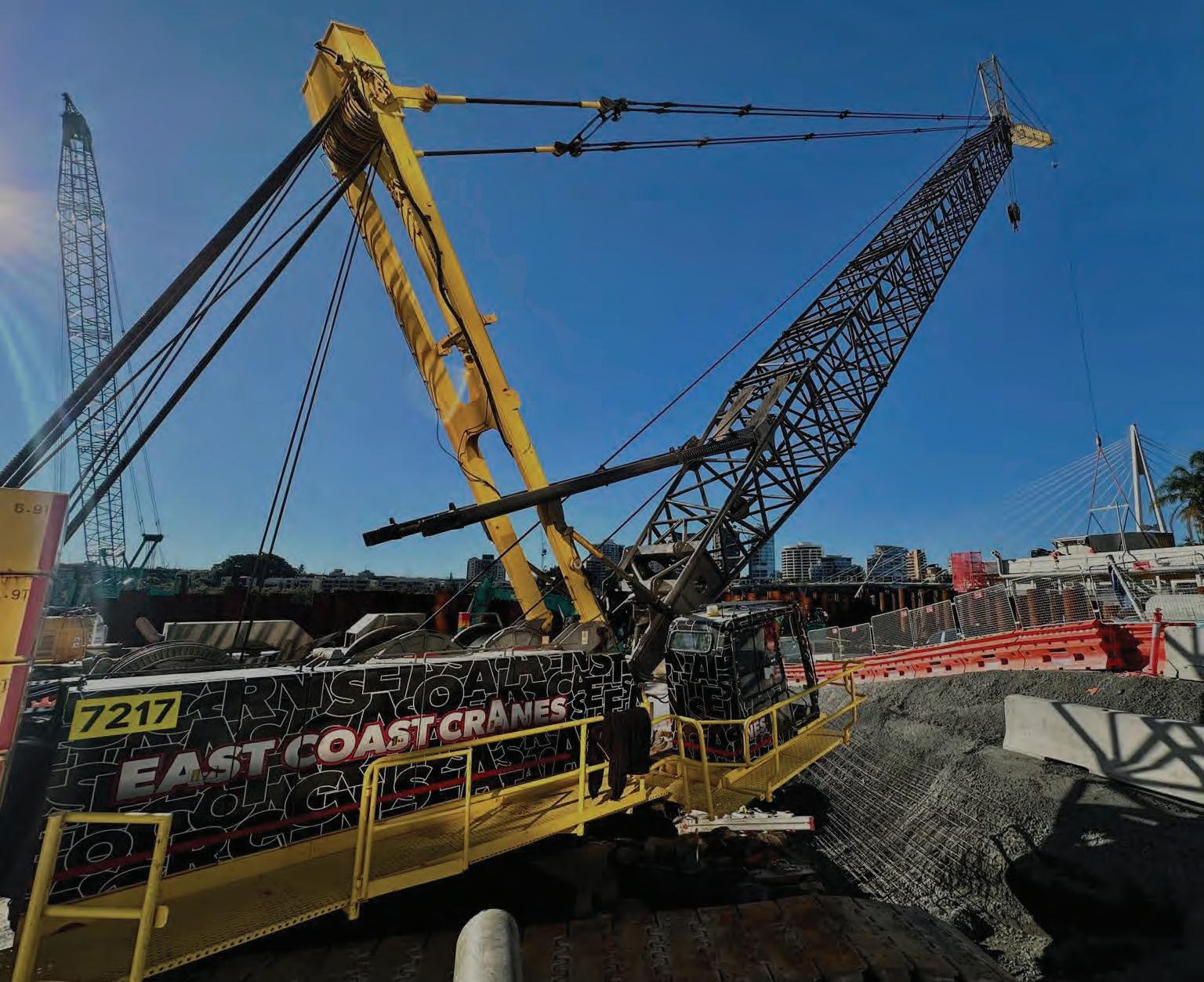
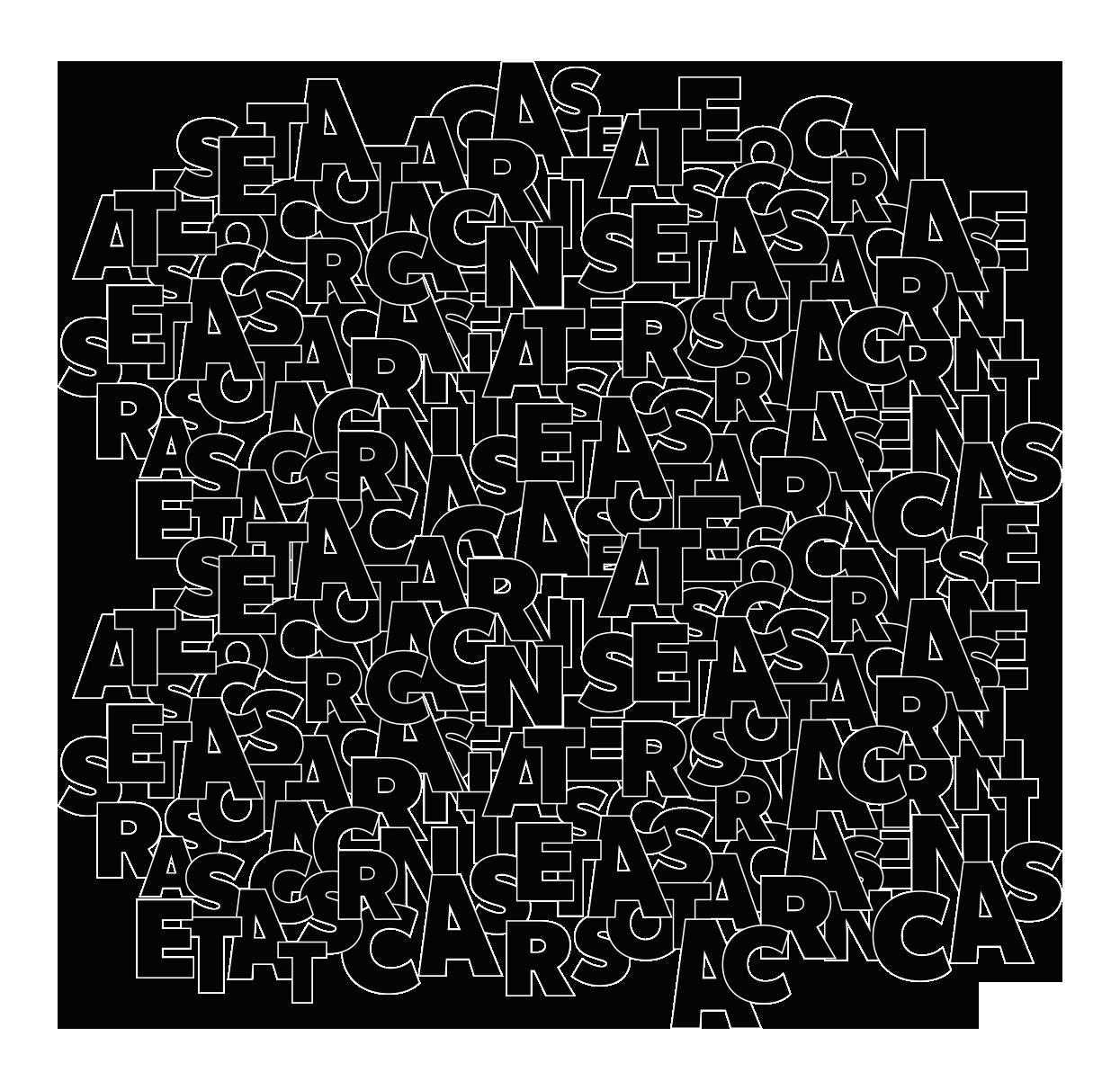
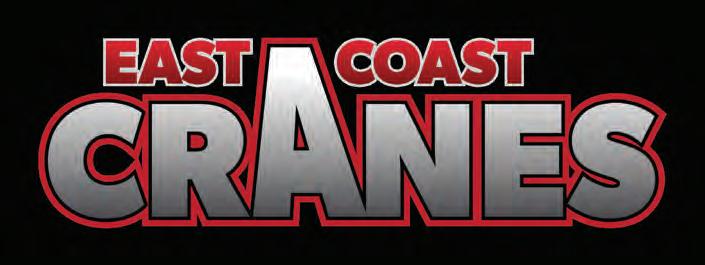





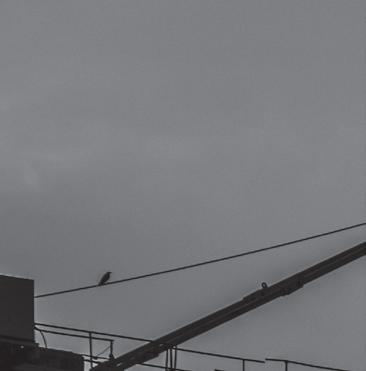
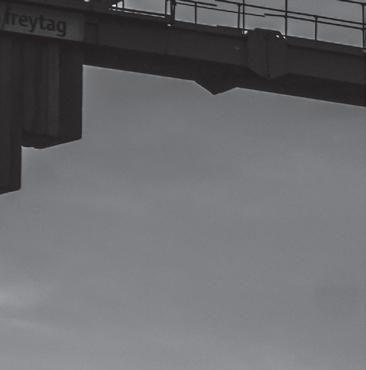


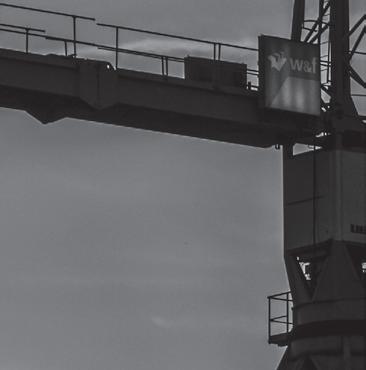
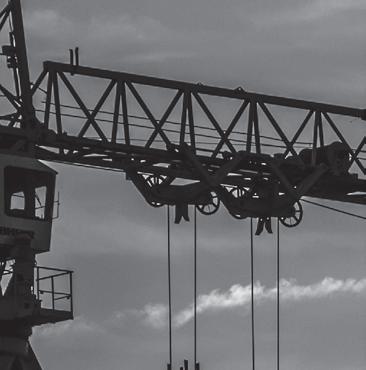


As a member, you have exclusive access to:
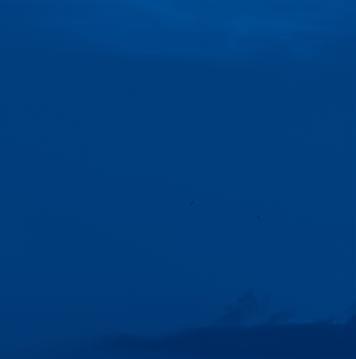
Empower your team with industry-leading skills and safety expertise. Industry Networking
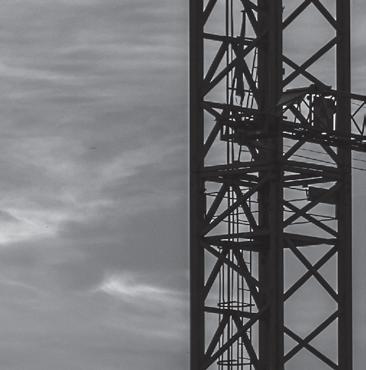
Join the exclusive network shaping the future of lifting.
Stay ahead with exclusive access to international standards and expert guidance.


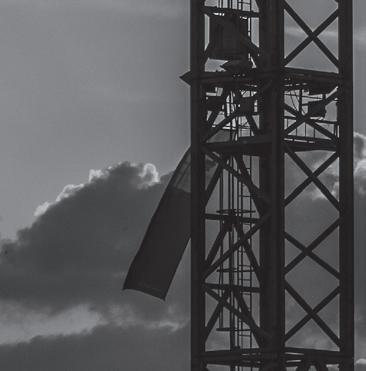


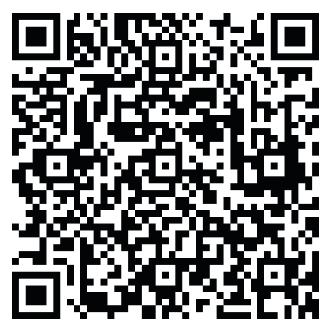
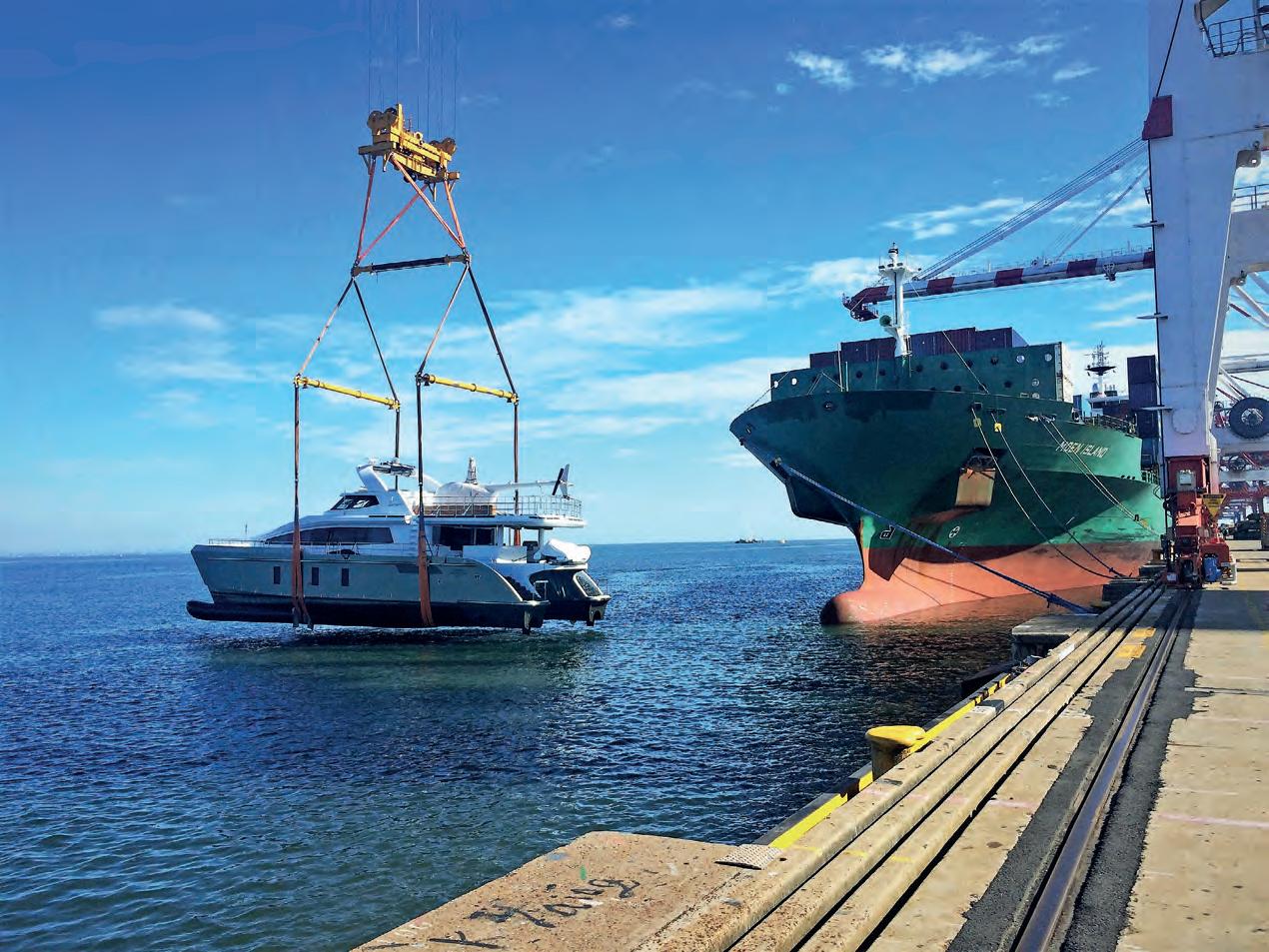

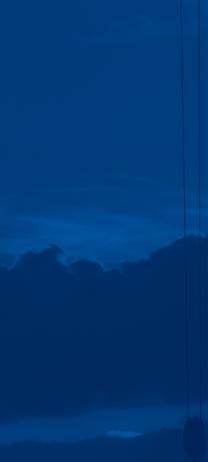





In an industry dominated by imports, one Australian manufacturer is proving that quality and innovation still have a strong foothold at home. Maxirig, based in Geelong, has become a quiet achiever in the nation’s lifting sector, producing lifting equipment that is both bespoke and proudly Australian Made.
FOR MANAGING DIRECTOR NATHAN VAN Berkel, the campaign is more than just a logo stamped on products. “It’s about conveying quality, responsiveness, and the ability to meet Australian standards,” he said. “We’ve been a signatory to the Australian Made campaign from very early on. It’s been a long relationship, and it’s central to how we present ourselves in the industry.”
Maxirig’s growth and reputation have been closely tied to its partnership
with the Global Lifting Group, a nationwide network of suppliers. Early in the company’s history, the decision was made not to sell directly to end users but instead to work exclusively through distributors.
“That decision to partner up with the Global Lifting Group was made early and I’d suggest to our benefit,” Nathan said. “Their people are at the coalface, talking to end users, understanding their problems. By the time queries come to us, they’re already qualified. That means we can focus on providing a solution quickly.”
The close working relationship with Global Lifting Group has also amplified Maxirig’s role in the Australian Made campaign. By running through the Group’s established distributor base, Maxirig’s products and values reach crane hire companies and operators across the country, which in turn reinforces the importance of buying local.
“The Global Lifting Group is much more than just better retail benefits,” said Brayd Gross, Founder Director of Alpha Rigging Service, a GLG member that sources from Maxirig. “It offers some of the best networking in the lifting gear
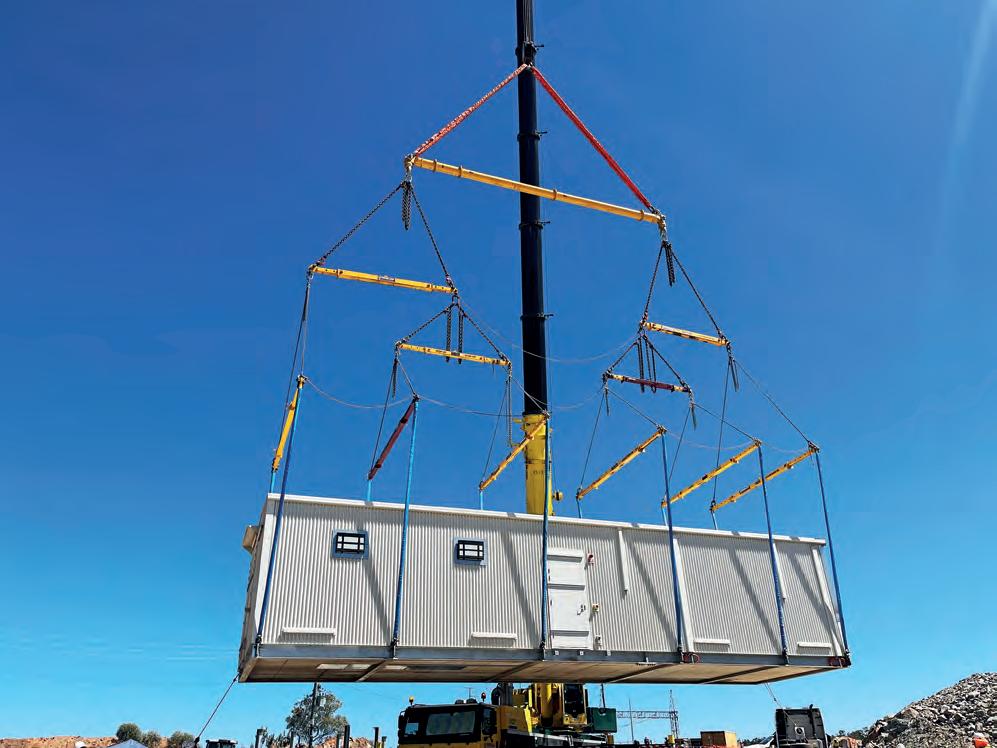
market, bringing together like-minded business owners and suppliers.”
“We’ve always tried to stay relatively anonymous and let our products do the talking,” Nathan said. “But through the Global Lifting Group, our reach has expanded, and the campaign gains real traction in front of customers nationwide.”
Maxirig was established in 2005 as an offshoot of a local engineering business in Geelong. When work slowed at the parent firm, the team began developing spreader bars and other lifting products for members of the Global Lifting Group.
“What started as a small suite of products has grown into something much bigger,” Nathan recalled. “We
overseas-sourced units that were no longer available. Maxirig stepped up to an urgent request that was outside its normal scope, and as always, it delivered.”
The company’s solutions have grown with the machines it serves. “The biggest projects we’ve delivered so far are in the 600–700 tonne range,” Nathan said.
“As cranes coming into Australia get bigger, our equipment has to match that scale. We work in that space between the hook and the load – and that’s where our expertise lies.”
Maxirig’s process combines design, fabrication, painting, and testing, all under one roof. It works with an experienced engineer who brings decades of experience and ensures designs are rigorous and tailored.
On the fabrication side, efficiency is critical. The company recently commissioned a welding robot to lift productivity, a move Nathan described as essential for competing with imported products.
“That’s the challenge for all local manufacturers – productivity. We’re no different. The robot is about finding smarter ways to deliver Australian-made products at competitive prices.”
“As cranes coming into Australia get bigger, our equipment has to match that scale. We work in that space between the hook and the load – and that’s where our expertise lies.”
still make those legacy products, but a significant portion of what we do now is bespoke work. People come to us with a problem, and our job is to solve it.”
“We’ve been working with Maxirig since their foundation in 2005,” Brayd said. “Together we’ve tackled everything from everyday spreader and lifting beams through to highly specialised solutions. One standout project was when Alpha Rigging and Maxirig designed and fabricated fully adjustable mobile floor cranes for multiple Royal Australian Air Force (RAAF) bases – replacing
Another pillar of Maxirig’s reputation is its rigorous testing. The company operates an in-house horizontal test bed and an A-frame setup capable of handling container lifting gear and other specialist equipment. Plans are also underway for a large-scale vertical test tower.
“By the end of the year, we hope to have our test tower commissioned,” Nathan said. “That will give us even greater capability to validate products inhouse, alongside third-party certification routes that the industry is familiar with.”

The partnership with the Global Lifting Group is also enabling the development of a new fully welded, Australianconstructed personnel cage.
“We’re trying to build a product that’s genuinely Australian but can be offered at a price point closer to imported units,”
Nathan said. “That’s part of why we’ve invested in robotic welding – to make sure we can compete while still delivering the quality that local customers expect.”
The Global Lifting Group’s distributor network will play a central role in rolling out this product, ensuring the Australian Made story continues to reach worksites across the country.
For Nathan, the conversation around Australian Made is deeply personal. Growing up in Geelong, Victoria, he
has witnessed the decline of traditional heavy industry in the city, with Ford, Alcoa, and other manufacturers shutting their doors.
“One of the things I’m passionate about is Australia not becoming just a quarry,” he said. “The vast majority of our wealth comes from mining, but I’d like to think there’s still a place for valueadded manufacturing in this country. We’ve lost too many of those industries in recent decades. If we want those skills to continue and prosper, we have to see it through the hard times.”
That passion extends to Maxirig’s broader mission. “Our challenge is to find our niche and push the frontier of advanced manufacturing where we can. Welding steel might not seem like high-tech work, but innovation comes in the details – automation, efficiency, and responsiveness to customers. That’s where we can make a difference.”
With a strong distributor network, anchored by its partnership with the Global Lifting Group, investment in automation, and a clear commitment to the Australian Made campaign, Maxirig is positioning itself for the future. Yet Nathan remains pragmatic. “We’ve always sat behind our distributors and let them do the talking.”
Regardless, Maxirig’s story is one of persistence and quiet conviction. In an industry where imported products often dominate, the company continues to back Australian skills, standards, and manufacturing. As Nathan said, “We’re blessed with natural resources and energy, but too often it all just gets put on a ship, and we buy it back. At Maxirig, we’d like to think we can buck that trend and show that Australianmade products still have real value.”
Manitowoc Australia 0417 674 019
infoANZ@manitowoc.com
New Zealand 0800 878 695
cranes@trt.co.nz
Manitowoc Australia 0407 967 444
infoANZ@manitowoc.com
New Zealand +61 407967444
infoANZ@manitowoc.com

Maritime Constructions first turned to TRT for its equipment needs with the purchase of a Kobelco crawler. That partnership has since grown, with the company now operating three Kobelco machines in its fleet.
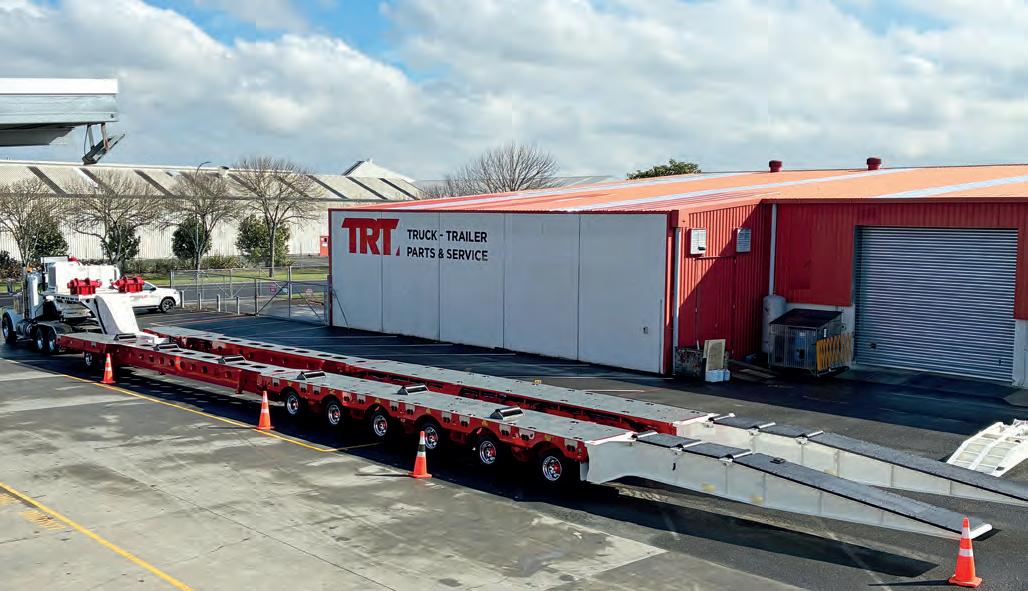
WHEN IT CAME TIME TO SOURCE a solution for transporting heavyduty piling and dredging equipment, Maritime Constructions once again turned to TRT. The result was a custom-designed and purpose-built trailer, engineered specifically to meet operational requirements.
Senior Project Manager Sam Watkins, who has been with the business for 13 years, discusses these recent developments.
Maritime Constructions is a market leader in marine infrastructure services, offering a comprehensive range of solutions across marine construction, dredging and port development, harbours, fabrication, and remediation. With a team of highly experienced personnel and a commitment to quality, it delivers tailored solutions to meet any project scope. Its capabilities encompass
design, engineering, management, and self-execution of complex marine projects, ensuring the highest standards in every aspect of work.
“Works typically involve cutter suction dredging and general marine construction which involves a significant amount of pile driving from barges which is a core competency for the business,” said Sam.
“We specialise in projects that involve cranes and barges working on water through to subsea installations with divers, piling on artificial reefs, jetty works, refurbishment of wharves and jetties and navigation aids. Basically, we will look at most coastal infrastructure projects.”
He goes on to discuss how he was introduced to TRT and how conversations regarding the requirements for the specialised trailer evolved.
“We were first introduced to the team at TRT Australia when exploring the purchase of Kobelco crawler cranes, of which we now own three. About 18 months ago, we began discussions with the TRT team in New Zealand, including Bruce and Jeremy Carden. Those conversations have now resulted in the design and manufacture of our first custom-made TRT trailer,” said Sam
The trailer has been purchased specifically to service the dredging division of Maritime Constructions.
“We have been operating an old asset which was built back in the ’90s. It’s a basic chassis-type trailer which we use to transport our dredges, which are on the smaller side when it comes to the world of dredging equipment. We truck them to sites and launch them, almost like you would launch a boat at a local boat ramp. The trailer basically acts as a
mobile slip carrying up to 90 tonnes of dredging equipment.
“That was the old asset which had been operating for over 25 years, and we have had the new trailer in the works for a good year or so. We wanted to make a bunch of design and safety improvements on the new trailer from TRT.
“You could call it serendipity, but during the conversations about the Kobelcos we got chatting to Bruce and Jeremy about our trailer requirements and they immediately displayed a depth of knowledge and competence in custom trailer design and manufacture,” said Sam.
“We engaged in a process involving design briefings and design engagement and they were able to bring in concepts from other parts of their business, such as their house-moving trailers and the technology involved in that type of trailer. They came up with a concept that will enable us to transport and launch our dredges in a manner which is smoother, safer and far more efficient than we could have imagined with a basic trailer. It was certainly a collaborative design effort, but they introduced us to technology, including wheel groups and being able to jack and lift the trailer, which we wouldn’t have considered and indeed even know existed as an option,” said Sam.
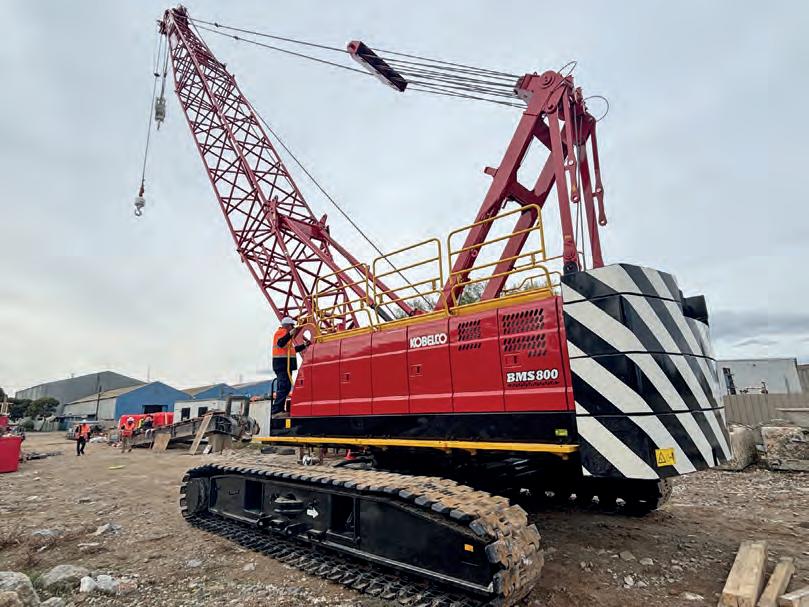
The design of the trailer will provide far more manoeuvrability when it gets to site.
“The additional manoeuvrability is important but the big challenge we face is getting enough vertical lift from the trailer to get the dredge off. In the past we have had to lift the gooseneck right up at the front with the plant at the back of the trailer, but with this technology, we are able to spread the load all the way down the ramp through all the wheel groups,” said Sam.
“The TRT team has nicknamed it the “Dredge Trailer” but she’s better described as a TRT modular ESS Hybrid Platform trailer. With her distinctive, detachable house trailer-style gooseneck and her majestic, synchronised ESS (electronic steering system) capabilities, she will certainly be turning heads once operational over in Western Australia,” said Jeremy Carden, TRT Trailer sales.
In 2024, Maritime Constructions purchased two Kobelco BMS1000 for a project on the Cocos (Keeling) Islands. The hydraulic lattice boom crawlers have a lifting capacity of 90.7 tonnes and a boom length of 62.6 metres. Welded lattice construction using tubular, high-tensile steel chords with pin connections between sections make up the boom and jib.
The BMS1000 features a powerful HINO P11C-VH. The engine is a turbocharged vertical inline six cylinder with fuel injection which makes the engine reliable, durable, and consume less fuel. The hydraulic system consists of three variable displacement piston pumps. A hydraulic propel system provides both skid steering and counter-rotating steering allowing the crane to move on terrain with a 30 per cent gradeability. The lower structure of the crane is a 14.6 tonne steel-welded car body with axles. The counterweight for this crane is 37.1 tonnes, making load lifting more efficient.
The Kobelco BMS800 is a 72.5 tonne capacity, heavy-duty cycle crawler crane designed for demanding foundation work
The recently delivered Kobelco BMS800 is a 72.5 tonne capacity, heavy-duty, duty cycle crawler crane designed for demanding foundation work like pile driving, vibratory hammering, and earth drilling.
like pile driving, vibratory hammering, and earth drilling.
Key features include a powerful HINO P11C-VH engine, high line pull winches with accurate hydraulic synchronisation, free-fall capability with a monitoring function, and the Kobelco KCROSS remote monitoring system. With a maximum boom length of 54.9 metres and a robust, high-cycle design, it offers reliability and precise control for continuous foundation applications.
“The BMS800 can work in many different configurations and initially it will be operating from a barge. We’ve used Kobelcos on previous projects and they’ve proved to be very reliable and excellent Japanese products,” Sam said.
“The reliability of the cranes is the key issue when they are operating on very remote projects or out on a barge in the ocean. It’s not easy to mobilise or change a crane out if you have an issue. So durability and reliability were central to selecting Kobelcos and TRT.”
If you’d like to discuss TRT’s heavy lifting or haulage solutions, email sales@ trtaust.com.au
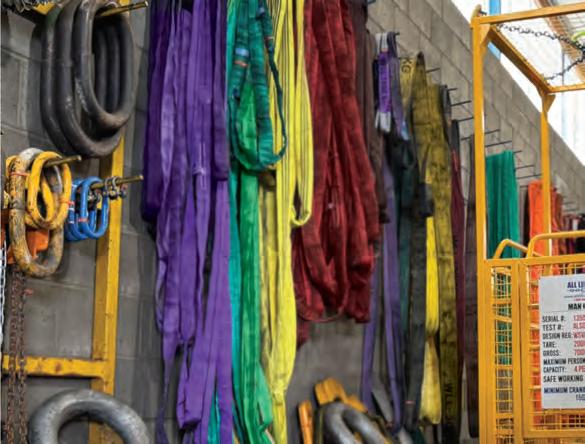
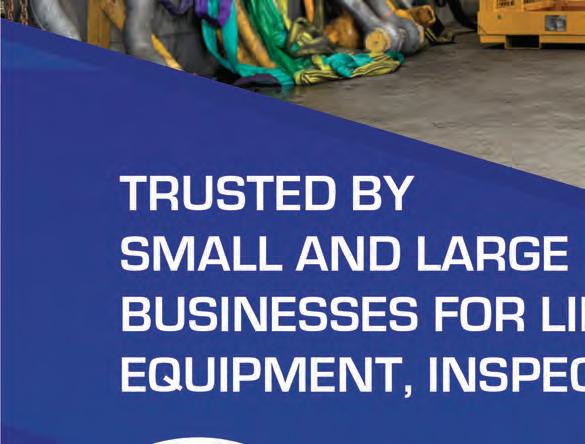
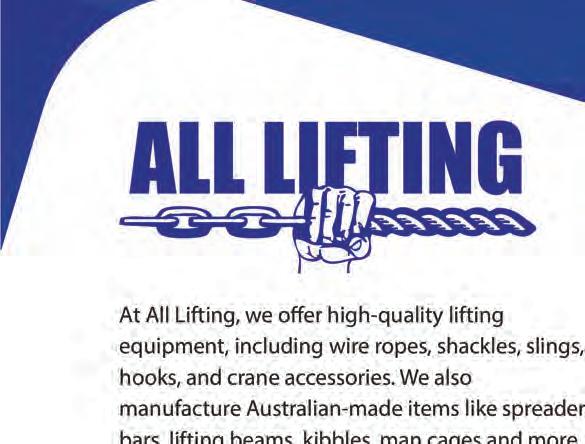
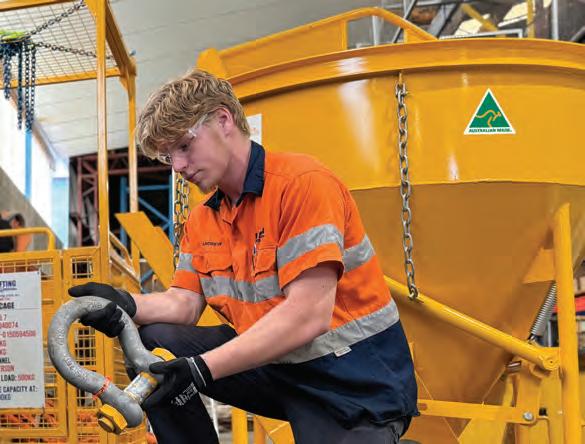

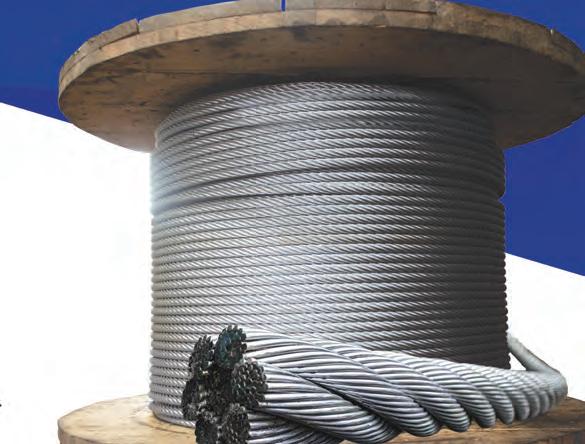
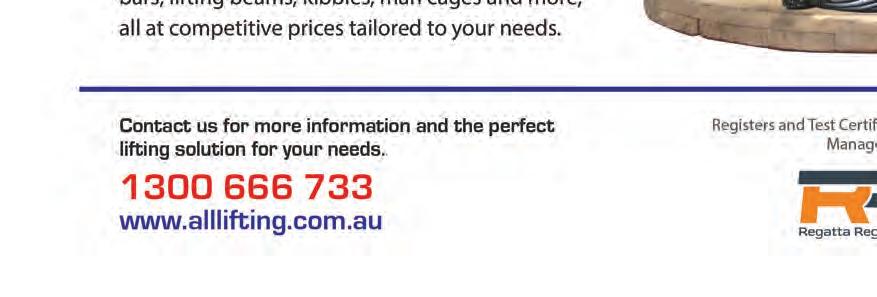
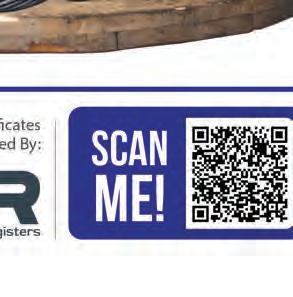
For more than 20 years, All Lifting has set the benchmark for safety and durability in fabricated gear. “In all that time, we’ve never had a site incident, never seen one of our fabricated items fail” said Managing Director Jason Warner.
the company’s commitment to quality and process. All Lifting delivers services across Australia with the same focus on reliability and safety.
Fabrication has become central to the way All Lifting services worksites across Australia. The heart of that capability is in Melbourne, where a large, experienced crew turns concepts into certified equipment. Many of the team have been with the business for years and thrive on the variety of work, creating something new for
All Lifting’s Melbourne facility fabricates custom lifting gear, proof-load tested up to 300 tonnes, ensuring every beam, cage, and hook meets and exceeds Australian Standards.
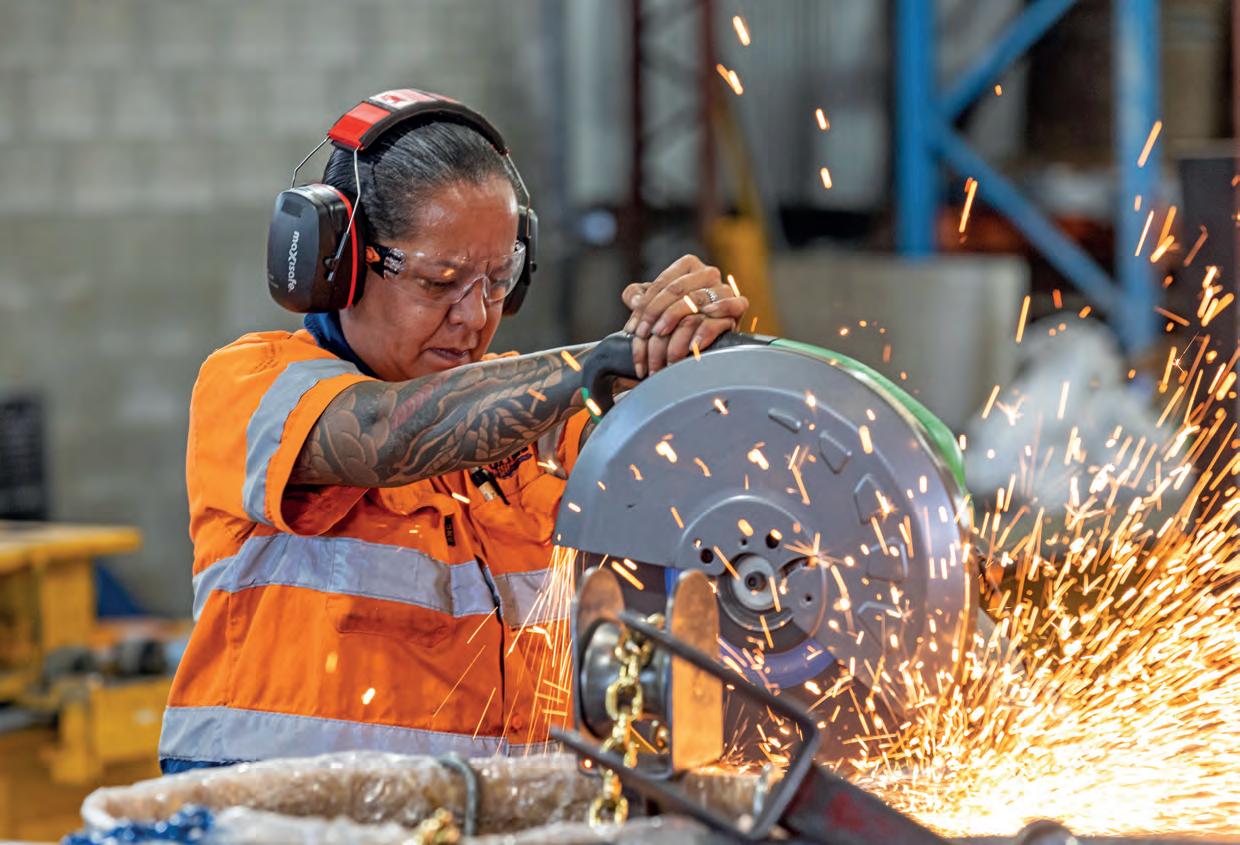
every job rather than repeating the same task. This in-house capability has allowed All Lifting to take on complex projects, such as an 85-tonne adjustable spreader beam designed for Melbourne’s North East Link project, as well as customised cages for Keppel Seghers in Hong Kong. Each project demonstrates the company’s ability to deliver equipment that standard catalogues cannot.
To strengthen control over quality, All Lifting has also invested in its own painting workshop, ensuring every piece of equipment is finished to the highest standard in-house. Most projects begin with a sketch and a conversation. With an in-house draughtsman and engineer, concepts are translated into AutoCAD drawings, signed off by the client for design and capacity, and then verified to ensure the steel is the correct size. From there, the fabrication team brings each piece of equipment to life.
Testing is non-negotiable. “Everything is tested in-house in our Melbourne factory before it leaves,” said Jason. “Our testing capability goes up to 300-tonne. Each product is tagged, painted safety yellow, and certified before it goes out.”
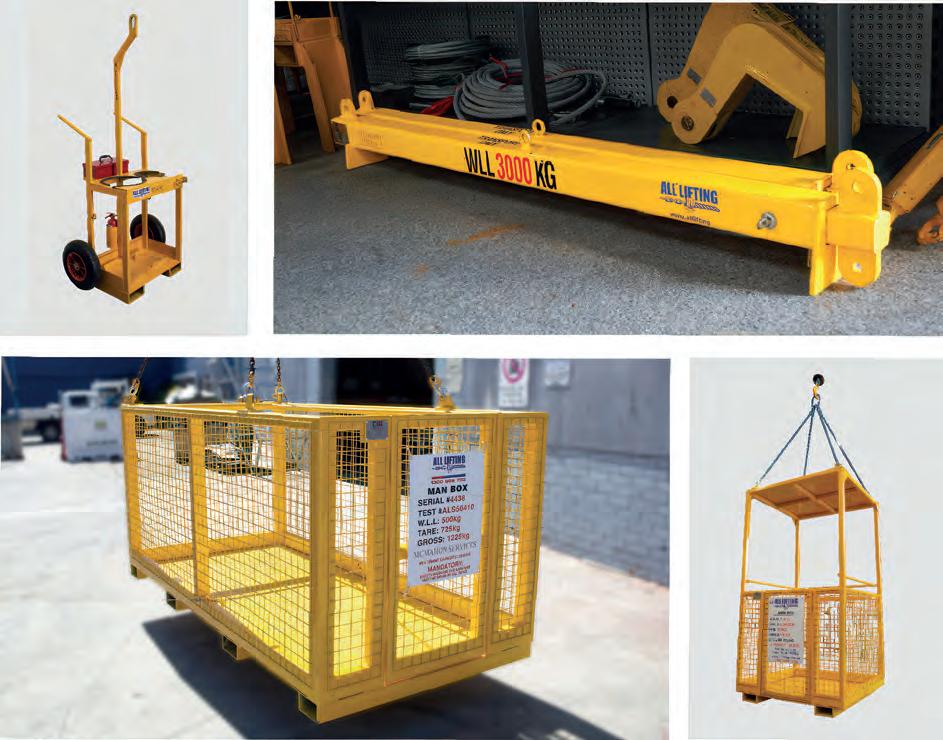
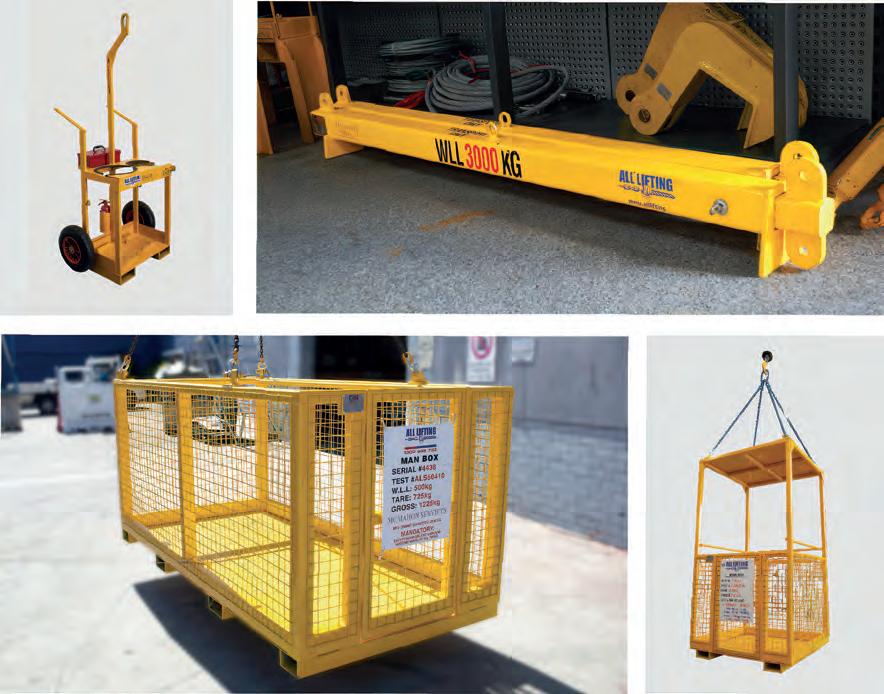
That attention to detail extends even to the small things that can cause issues on site. Every lug, shackle, and hook is checked, and the team can customise low-headroom or lightweight beams so clients can safely lift more load. Fabricated equipment also enters a life cycle of maintenance and traceability. Inspections, testing, tagging, and an online registry help equipment remain serviceable for years. Some lifting beams remain in use more than a decade after purchase, thanks to designs that exceed Australian Standards.
While every project is unique, demand often clusters around a core set of products. Man cages, brick cages, and lifting beams are specialties, but the company also carries a range of standard beams and fabricated items for quick turnaround. The workshop handles special
Above: With in-house design, AutoCAD engineering, and life cycle traceability, All Lifting delivers fabricated gear that remains serviceable for extended periods of time.
sizes, low-headroom constraints, and unique interfaces, with a catalogue that includes lifting beams, spreader bars, order-picker cages, forklift jibs, stillage and pallet cages, crane bins, and drumhandling systems.
Clients typically turn to fabrication when job parameters are especially tight, low hook heights, cramped laydown areas, unusual load geometries, or interfaces that must connect seamlessly with an existing crane hook or forklift carriage. With in-house capability across design, engineering, and fabrication, All Lifting delivers solutions tailored to each site’s exact requirements.
If there is a single message the company wants the industry to hear, it is reliability
backed by process. “The fact is, our products don’t fail,” Jason said. “That’s because we build them properly, test them properly, and make sure every part of the process is right before they go out the door.”
That confidence is reinforced by experienced tradespeople, an integrated design-to-test workflow, and a catalogue shaped by the real demands of moving people and heavy loads. In an environment where a small oversight can cascade into downtime or worse, All Lifting’s fabrication unit is built for the realities of the site, not just the theory of the drawing.
The same workshop that turns a rough sketch into a painted, tagged, and certified device is the one that proof-loads it and checks it against the crane hook it was designed for. That’s why clients return time and again with the next challenge and the next sketch. For them, the promise is simple: build it right, test it right, and make it work on site.
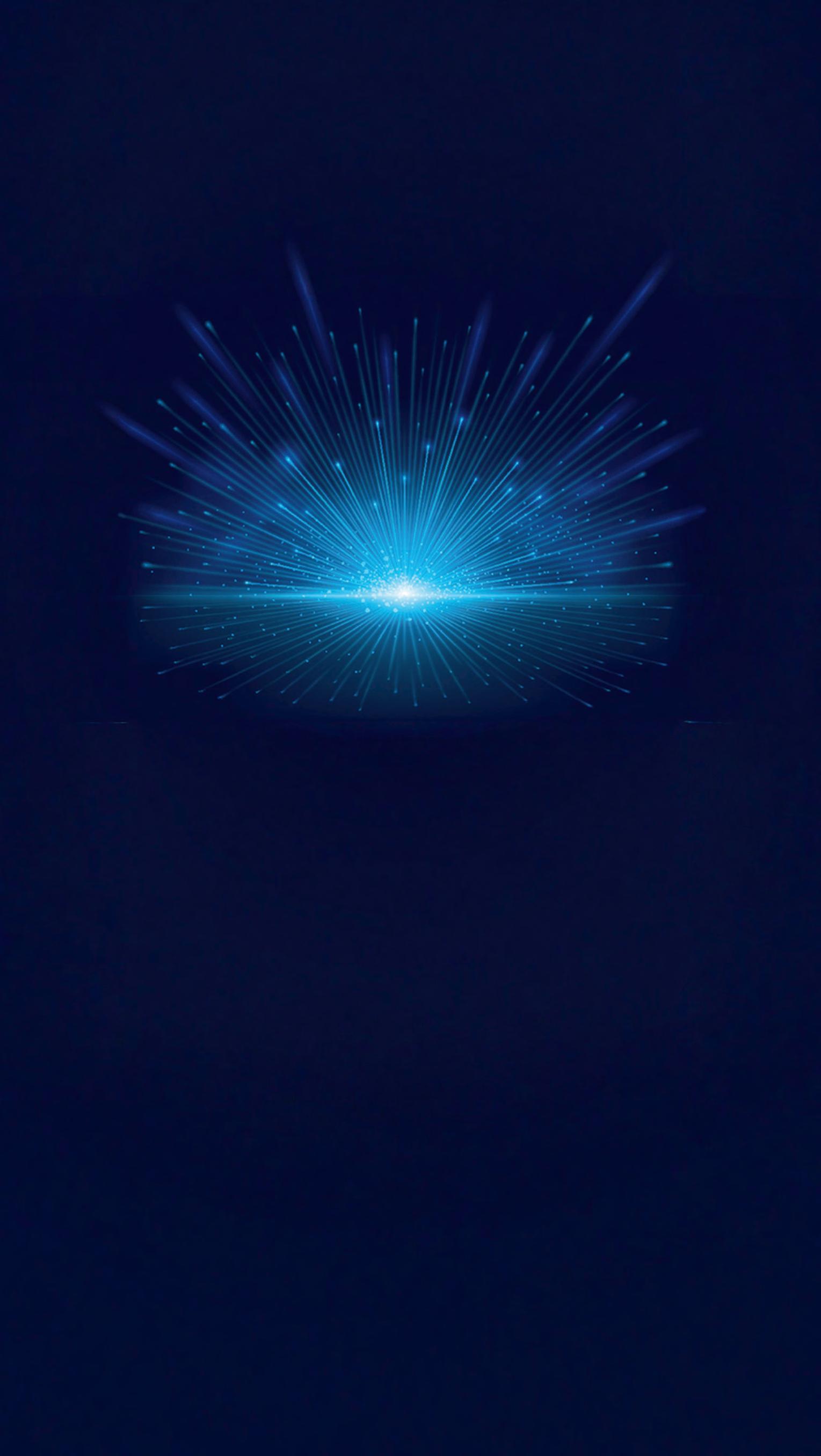

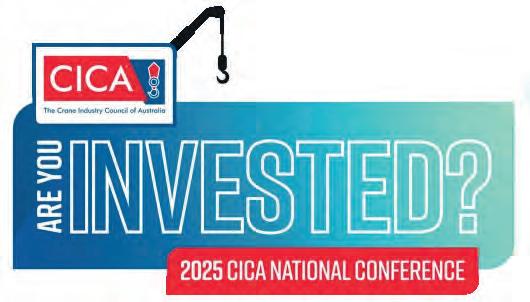

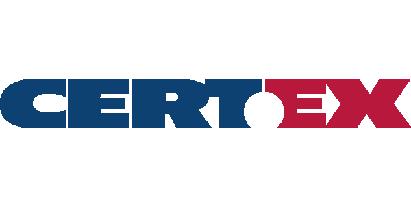




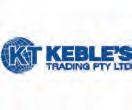
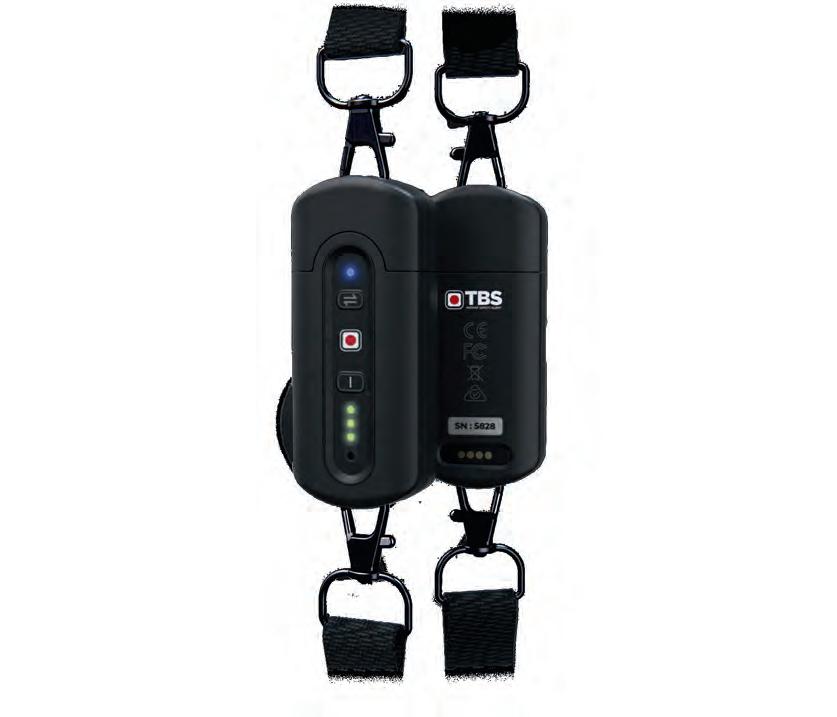


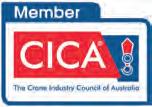

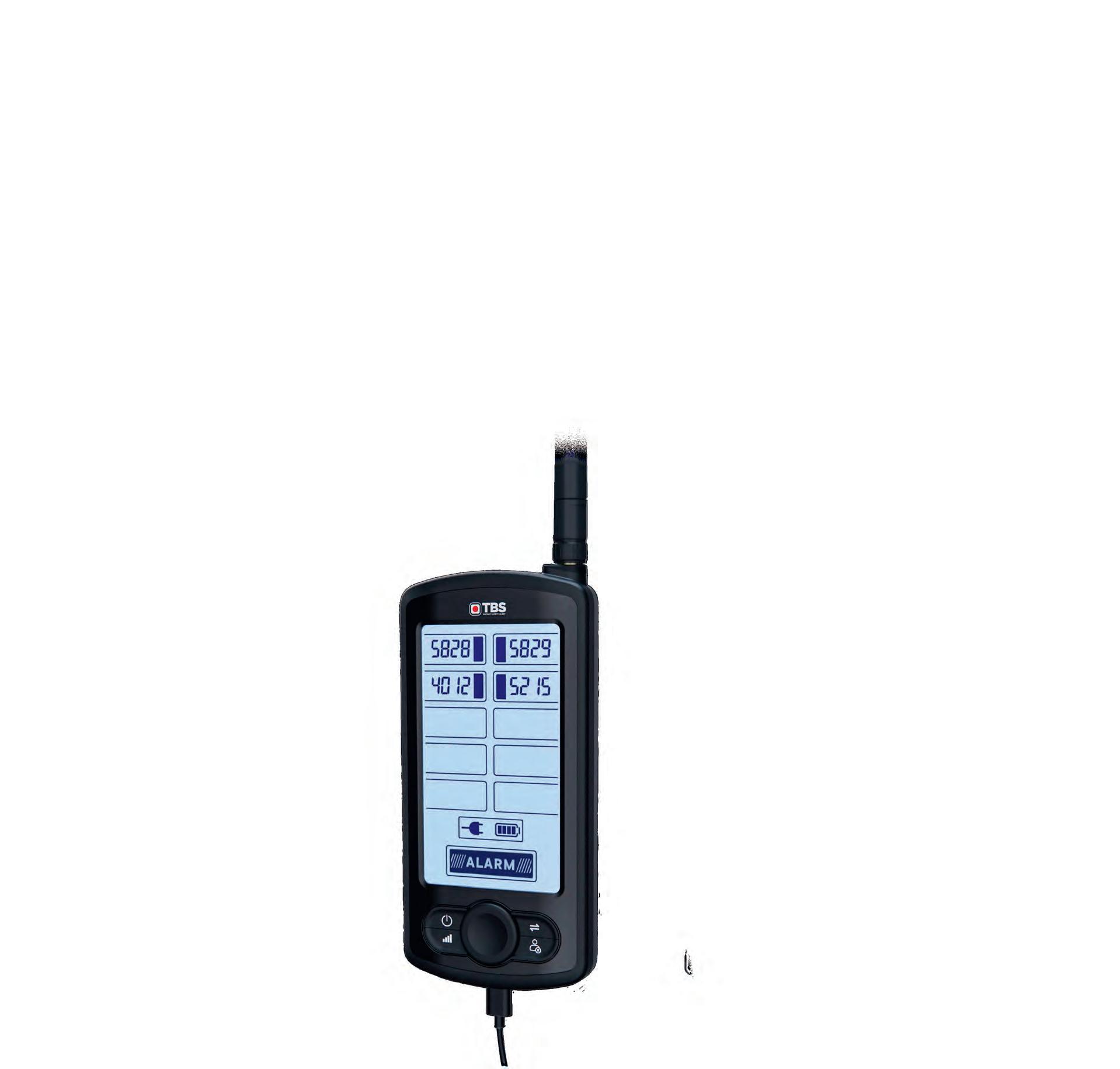
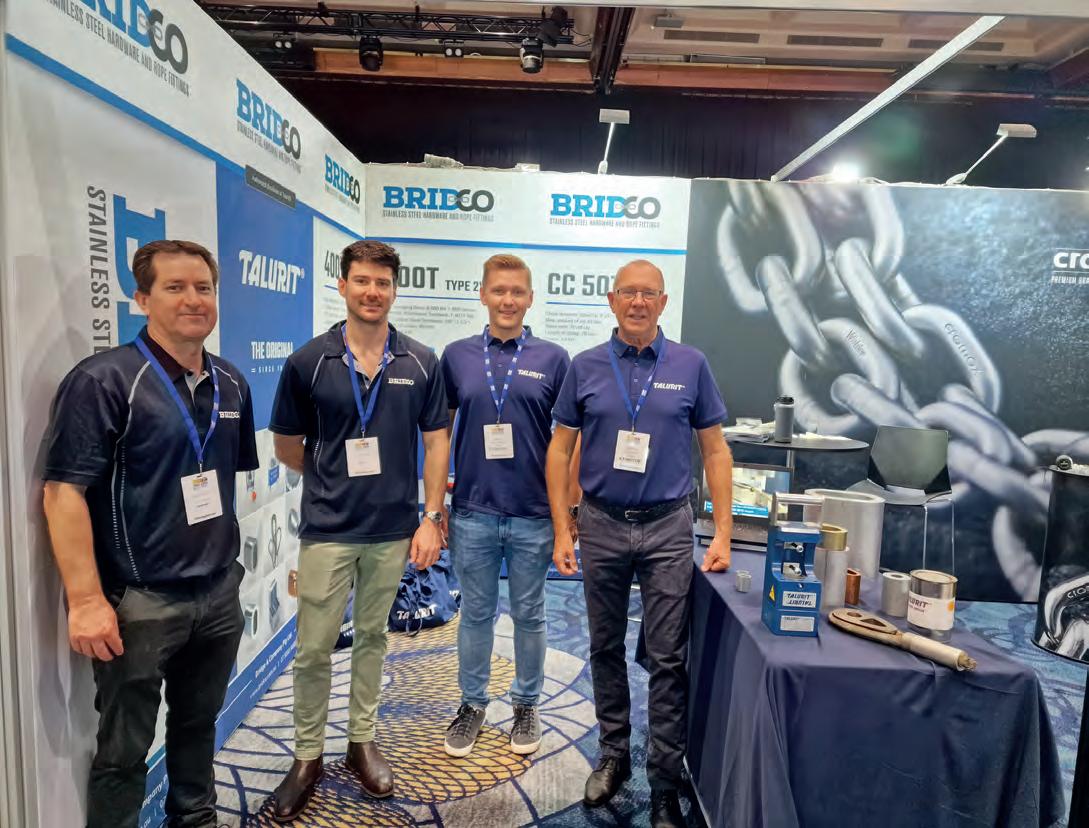
BRIDCO BEGAN IN 1985 WHEN NATHAN’S grandfather started trading from his garage in South East Queensland. At the time, it was possible to drive to hardware stores with stock in the back of the car and sell directly. Recognising an opportunity, Nathan’s father focused the business on stainless-steel hardware and wire rope fittings, laying the foundations for what would become a specialised operation supplying some of the major players in the industry.
The business expanded steadily throughout the 1990s and moved into a purpose-built facility in Burleigh Heads, which remains its headquarters
today. Nathan himself joined in the late 2000s. “Initially, I wasn’t going to be involved, but I spent a summer in the warehouse before university and never left. Eighteen years later, I’m running the business,” he explains. “During the 2000s, we transitioned more into the lifting side of the industry, developing strong partnerships with Talurit AB, who manufacture swaging presses, end fittings and handling equipment, and with German manufacturer Ketten Waelder GMBH, producers of Cromox stainlesssteel lifting chains and fittings.
“These relationships have become central to our business.”
With decades of experience in wire rope and swaging, Bridco has become the go-to resource for technical enquiries and problem solving. The company works closely with major suppliers in the industry, assisting with specialist advice when challenges arise. “Because we are so specialised in stainless-steel, the difficult questions inevitably find their way to us. We’re always happy to help,” Nathan said.
At the core of Bridco’s success is its commitment to representing worldclass manufacturers and maintaining an experienced, long-serving team. “Talurit designed and manufactured the first
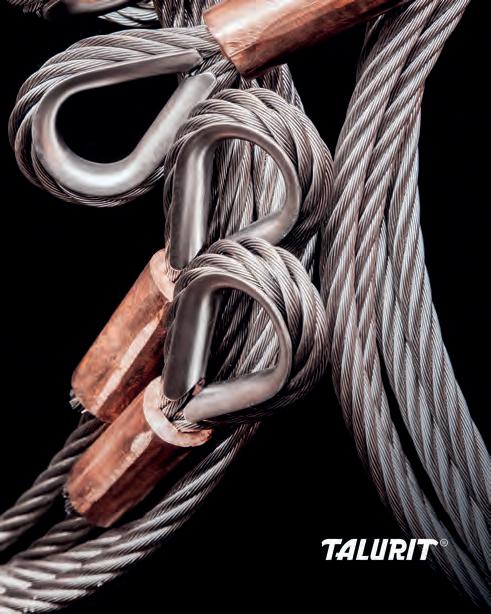
mechanical splice, and their founder invented the wire rope ferrules. Cromox are industry leaders in stainless-steel lifting chains, consistently innovating with new materials and designs. They’re at the forefront of developments in this field, and it’s a privilege to represent them,” Nathan said. “Within Bridco, many of our team members have been with us for over a decade, and collectively our sales team brings more than 100 years of experience to the lifting industry. That depth of knowledge allows us to provide solutions quickly and confidently.”
Although stainless-steel lifting equipment is less visible in mainstream crane operations, its applications are vital in wastewater treatment, clean rooms, food processing, and highly corrosive environments where standard materials simply do not perform. Bridco continues to expand its capabilities to meet these demands, offering different grades and surface treatments to suit specialised conditions. “Cromox is now working with medical-grade equipment in Europe, with prototypes being tested for cleanroom use in pharmaceutical and medical industries. Hygiene-critical applications
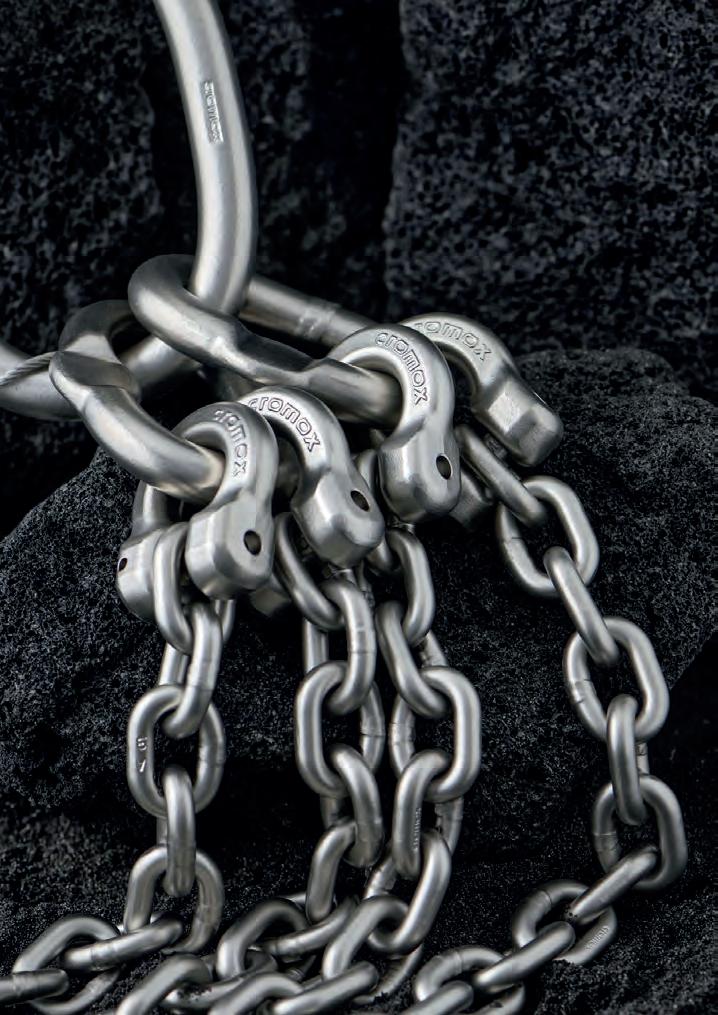
are driving a new wave of innovation,” Nathan said.
Bridco operates through a reseller model, ensuring distributors have the technical expertise and support they need. The company places strong emphasis on collaboration, working closely with both customers and manufacturers to deliver the right solution for each application. “Whether it’s a complex lift or an installation in a highly corrosive environment, we work as a team across all stakeholders to get it right. That’s why
many of our key accounts have been with us since the 1980s,” Nathan said. This long-term approach underpins Bridco’s reputation. “We don’t take a one-and-done approach. Our focus is on building enduring relationships, and we are firmly positioned as stainless-steel specialists,” he said. “From wire rope terminations to shackles, hooks and clips, stainless-steel is what we do best. With our range and our experience, we pride ourselves on delivering the right solution every time.”
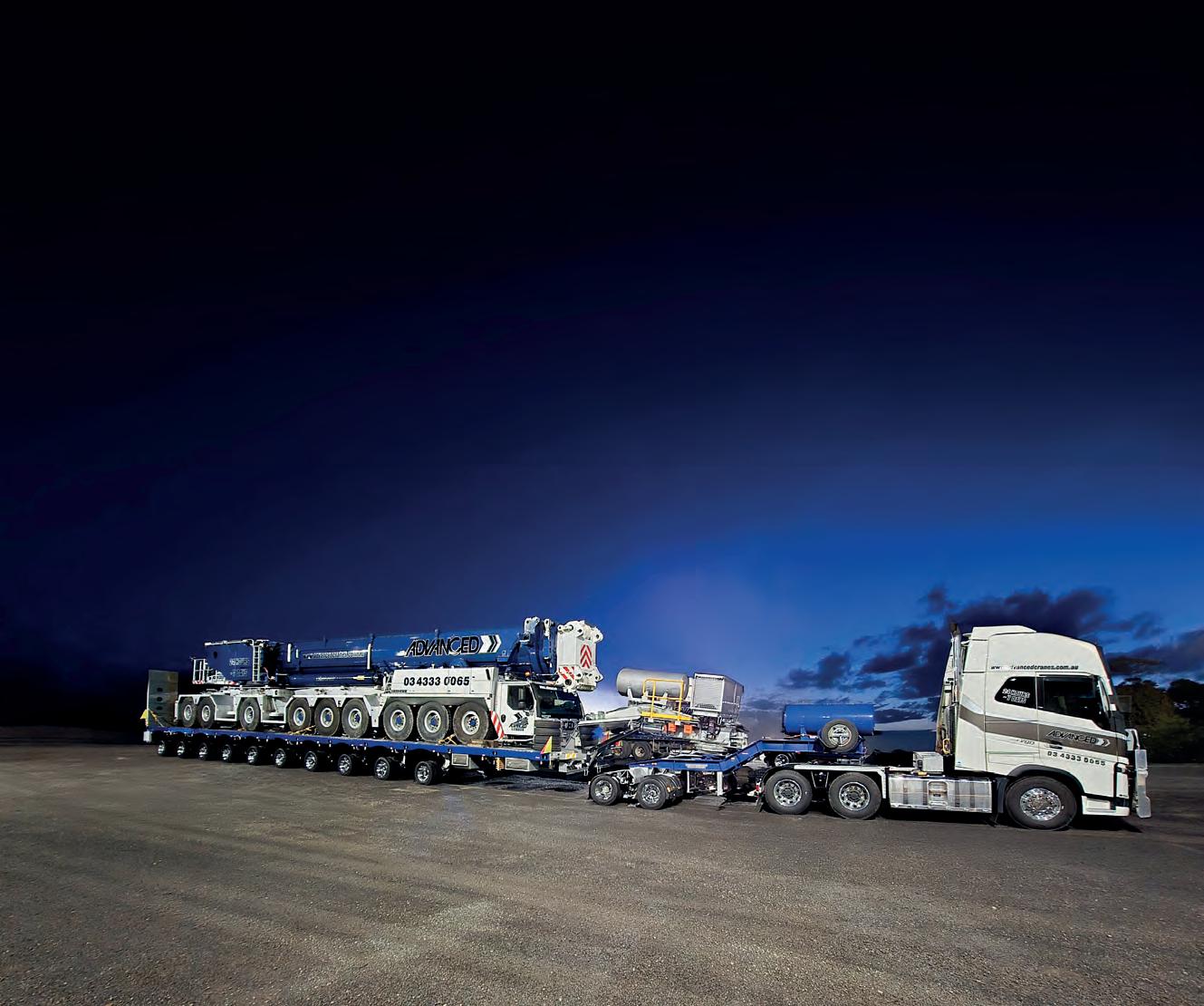


Heavy haulage is about providing transport solutions for clients with challenging over mass and/ or over dimensional logistical problems. For Advanced Cranes, the solution came in the form of a Drake steerable – engineered to make light work of the industry’s bigger lifts.

THE STEERABLE TRAILER, DESIGNED IN close collaboration with the team at Drake Trailers, shows how one of Australia’s leading trailer manufacturers continues to solve industry problems with purposebuilt engineering.
For Byron Foss, Sales Manager at Drake Trailers, the project reflects the company’s commitment to building robust, simple and reliable equipment that heavy haulage operators can count on.
“Advanced Cranes came to us with a problem,” Byron said. “They needed a safe way to move a Liebherr LR1750 crawler crane, which meant a long enough trailer with the right capacity and features to make loading and unloading safer. The result was a ten-row steerable platform built specifically to meet that need.”
The Steerable Trailer supplied to Advanced Cranes is configured as a 7+3 – meaning it can be used as either a sevenrow or ten-row platform. With a legal on-road payload capacity of 140 tonnes and up to 240 tonnes payload capacity off-road, the platform is suited to carrying some of the heaviest equipment working in Australia today.
But it was the details that made the difference. To handle the loading angles
of the LR1750 safely, Drake engineered custom clip-on “slipper ramps.” “These ramps reduced the load angle, which means the crane can be driven on and off the trailer with greater control and less risk,” Byron said. “It’s a simple addition, but it improves safety dramatically.”
What makes the ramps even more valuable is their interchangeability.
Advanced Cranes can use them not only on the new steerable, but also across other trailers in their fleet – including Swingwides and Swingwing trailers.
Configured as a 7+3, the new Steerable Trailer offers 140-tonne legal on-road payload and up to 240 tonnes off-road.
“That compatibility means they’re not locked into a single application. It’s a safety investment that multiplies across their whole fleet,” Byron said.
Central to the design of Drake’s steerables is the steering system itself. Drake has deliberately kept things straightforward.
“The system is based on hydraulic master and slave cylinders,” Byron said. “Wherever the prime mover goes, the trailer follows. It’s simple, bulletproof, and easy to operate.”

The new Drake Steerable gets features such as hydraulic master–slave steering, clip-on slipper ramps, and full fall protection.

For operators pulling a ten-row platform stretching up to 35 metres with a dolly, reliability is non-negotiable. “Our customers appreciate the simplicity,” Byron said. “You don’t need an electronics degree to maintain these trailers. Anyone with mechanical experience can get them going again. That’s why our Steerable Trailers have a reputation as being rock solid and virtually unkillable.”
Drake has long emphasised building for Australian conditions, and the new Advanced Cranes trailer was no exception. Beyond the ramps, the steerable came equipped with full fall protection, walk platforms on the gooseneck, and safe access to the power pack and spare tyres.
“Not every company asks for that level of safety integration,” Byron said. “But Advanced Cranes has always pushed for it across all its Drake and O’Phee trailers. It makes them safer to operate and more attractive to their clients.”
The steerable also offers 16 metres of clear deck space, giving it versatility beyond carrying crawler cranes. “It’s not just about one application,” Byron said. “It can handle counterweights, heavy
“It can handle counterweights, heavy components, or even be used for on-site shuttling. That’s the advantage of a steerable –it’s a workhorse that adapts to the job.”
components, or even be used for onsite shuttling. That’s the advantage of a steerable – it’s a workhorse that adapts to the job.”
Since acquiring O’Phee Trailers in 2015, the Drake Group has broadened its offering to crane and heavy haulage companies. Today, its portfolio covers low loaders to counterweight trailers, drop decks, skels and flat-tops.
“What we can do now is provide a complete package,” Byron said. “We don’t just sell you the trailer to move the crane –we can supply the trailers for your booms, your jib sections, your counterweights, and all the support equipment. That’s what makes us valuable to companies like Advanced Cranes. They know they can come to one supplier and get everything they need.”
Drake’s steerable range has evolved
over decades, built on more than 65 years of trailer manufacturing experience. With capacities from 5x8 up to 12x8 line configurations, hydraulic widening up to 4.88 metres, and a reputation for durability, these trailers have become the benchmark for heavy haulage.
“At the end of the day, our job is to make sure operators can do their work safely and efficiently,” Byron said. “That’s what this trailer achieves.”
The steerable’s delivery coincides with Drake’s decision to take a more active role in the crane industry. This year, the company is exhibiting at the Crane Industry Council of Australia (CICA) conference in October. “The crane industry has really supported us over the past decade,” Byron said. “We’ve gained more crane customers than ever before, and we wanted to give back. That’s why we’re going to CICA – to support the industry that’s been supporting us.
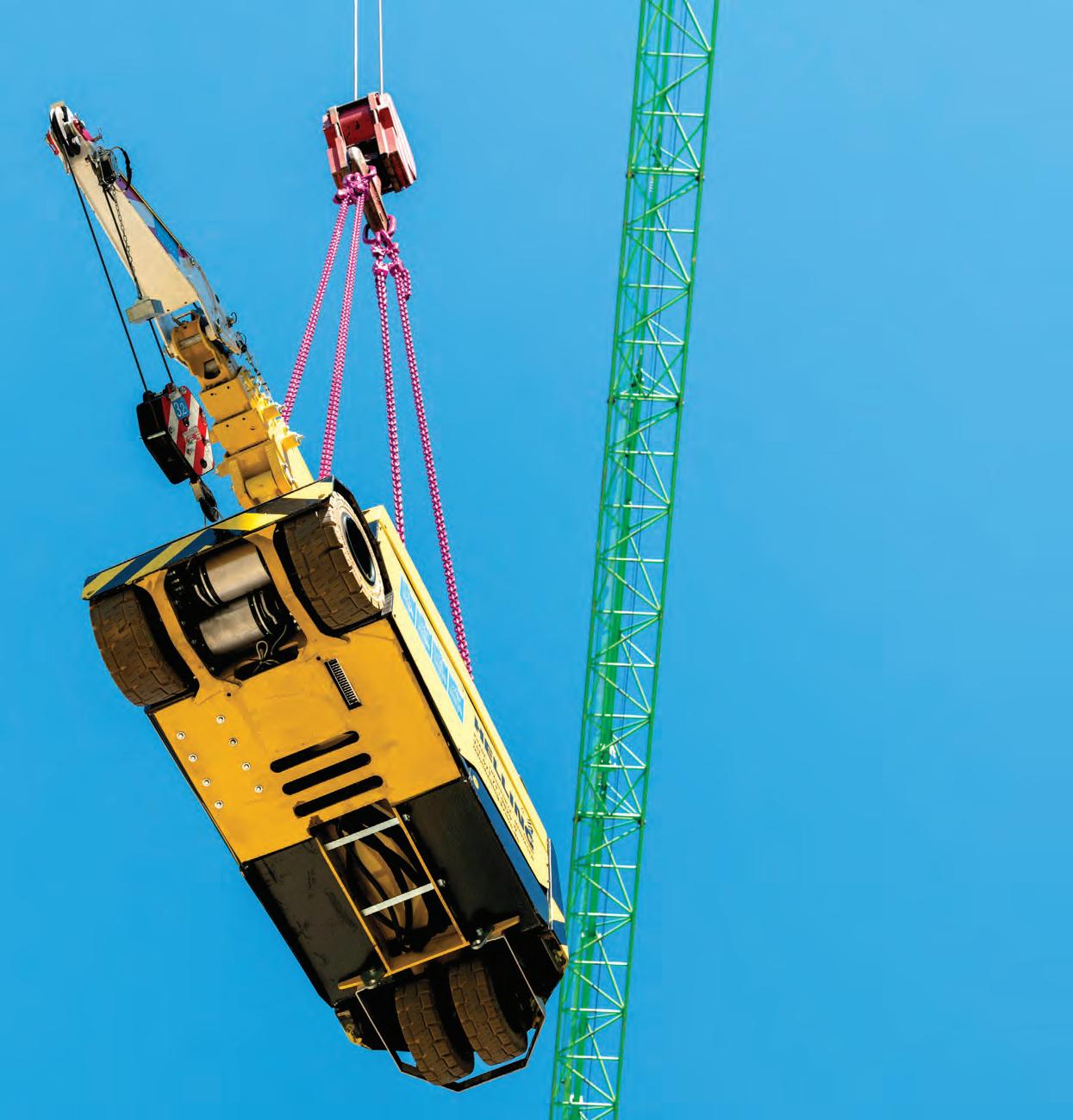

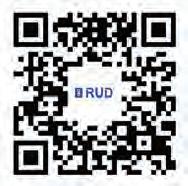
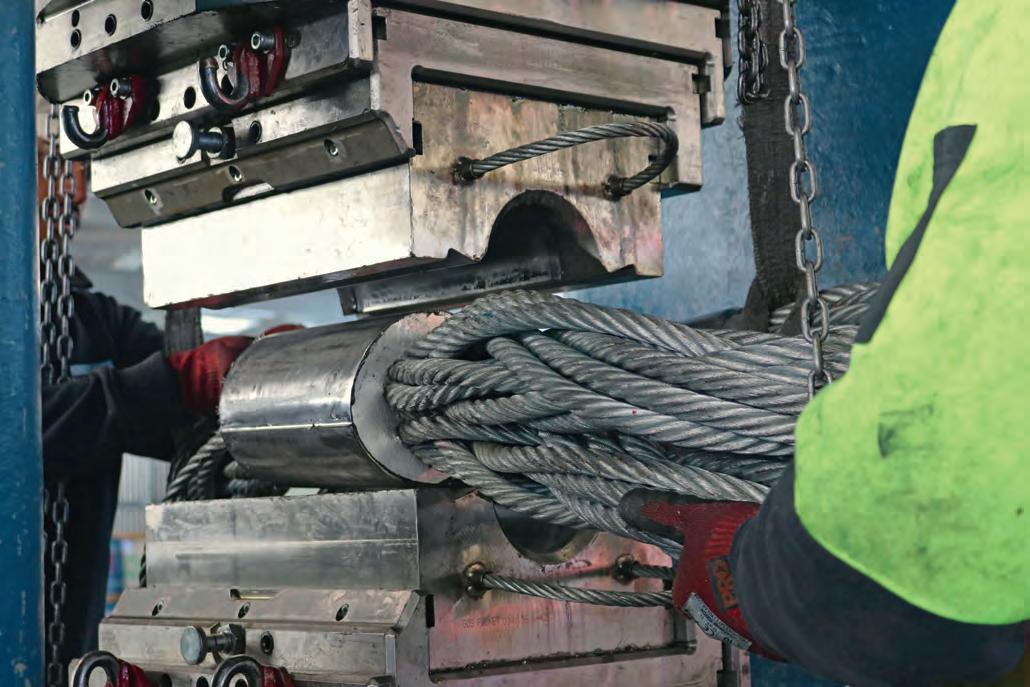
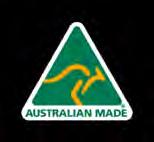
Andromeda Industries continues to invest in the latest manufacturing technology, expanding the depth and function of the team and developing new markets, both domestically and internationally. Customer Relationship Manager Geoff Bower and Company Director Annette Williams explain more.
THE INVESTMENT IN NEW MANUFACTURING technology is aimed at strengthening Andromeda’s ability to consistently produce high-quality steel wire slings and lifting solutions, while also supporting premium service to meet the increasing demand of the Superflex range.
Operations have been expanded with the recent purchase of a brand new 800 tonne Talurit Swaging Press.
“Interest in our products is increasing and the team is getting busier, and I have to ensure they can keep up with the demand. Investing in the latest manufacturing technology is key to ensure this happens,” said Annette.
The new swaging press is used for mechanical splicing of wire rope where high pressure is required to swage ferrules turning wire rope into a lifting sling. This new 800 tonne press is hydraulic-driven combined with variable speed and a smart control system allowing the swaging operation to be highly efficient.
The new swaging press terminates the ends of the cable, turning into a lifting sling. It will work in conjunction with the existing presses which include a 4200t Talurit swaging press – the largest in the southern hemisphere.
“Basically, the swaging press terminates the ends of the cable transforming it from a length of cable into a sling for lifting. The new press will work in conjunction with our existing presses which include our 4200 tonne Talurit swaging press, which is the largest in the southern hemisphere,” said Geoff.
“The new press can handle steel cable with a diameter up to 48 millimetres, which will ultimately manufacture a large flexible sling capable of lifting 43.2 tonnes in a straight lift. This asset is a bit of an insurance policy should one of our existing machines fail, we won’t be holding up production.
“The current 600 tonne press we bought in 1990 is over 35 years old and still sees everyday use. The new press is a significant upgrade, it’s going to make production faster and quieter for the team, it’s an impressive upgrade for the business. In terms of sales, service and support we work with Nathan and the Bridco team who are the national distributor for Talurit.
“The ferrules that we use on all our Superflex products are Talurit ferrules, which is by far the most premium aluminium ferrule in the market and is reflected in the superior quality we have in our product range. In our Superflex range we are using the best quality cable, the best
quality ferrules which enables us to provide the best quality product,” Geoff explained.
This commitment to the ongoing manufacture of quality products has led to significant growth over the past 12 months.
“We have seen an increase in sales of close to 12 per cent across all sectors of the lifting business with a significant increase in sales of our Dean-0 and Flat Woven Slings. We’ve attended a number of overseas events this year and the Dean-0 slings have been very well received from an international perspective. We are making significant inroads in Saudi Arabia, and it was great to recently catch up with customers and distributors in New Zealand during the Crane Association of New Zealand’s Conference and Exhibition,” he said.
Another significant and exciting development for Andromeda Industries has been the approval to use the Australian Made logo. Australian Made Campaign Limited (AMCL) licenses companies to use the logo promoting Australian products in Australia and overseas. Annette explains more.
“Back in June we began the process of applying for the Australian Made logo for our Superflex and Flat Woven products. We saw it as an ideal way to promote the business and support our resellers and distributors. There was a lot of criteria we had to meet but by early August we received the tick of approval and are rolling out the Australian Made logo on all of our products,” she said.
“The growth in the business is definitely a result of Geoff and myself attending industry trade shows, working with industry groups like CICA, CANZ and LEEA and also the support we have been afforded by the team at Cranes and Lifting Magazine and the introductions they have facilitated for us have been amazing,” said Annette.
With all this activity and higher profile, Andromeda Industries has been recognised as a finalist in three categories of the Tamworth Quality Business Awards including Customer Service. Annette has been nominated for Outstanding Business Leader and Geoff for Outstanding Employee. Both progressed as finalists for the New England North West Business Awards for each category.

“Today, Andromeda Industries has a noticeable presence in the lifting industry. We’ve created a significant profile, we are attending trade shows where we get to talk to customers directly and we are visiting our supportive resellers,” Geoff said.
“We’ve also been taking part in events hosted by our resellers, most recently in Newcastle, Sydney, and Thailand. We’re grateful for these opportunities and value our reseller network, which
placed through our reseller partners,” he said.
With the increase in demand and continued investment in the business, Annette and Geoff are carefully growing the team around them.
“We are still a very small family business which operates very much like a family unit and I think that’s why our customer service shines through so much. We are adding people to the team because of the fit within
“We have seen an increase in sales of close to 12 per cent across all sectors of the lifting business with a significant increase in sales of our Dean-0 and Flat Woven Slings.”
plays a key role in driving demand for our products. Just the other day, I got a call from a gentleman in Western Australia we’d previously spoken to at a conference about the D-to-D ratio of some of our slings – and we’re talking very large slings. Although he purchases through our reseller network, he reached out directly hoping for a quicker turnaround.
“While he’s still buying through the reseller, our relationship meant we could adjust a few things in our production schedule and push his order through faster. We’re continuing to build strong connections with companies like Woodside and John Holland, but the orders themselves are still being
the business and culture of the business,” said Annette.
“Evelyn recently joined us, and she comes with an HR and marketing background which is an element of the business that was previously part of my workload. There are two or three of us with ‘fingers in the marketing pie’ and with Evelyn now on board we will be able to develop a more uniformed approach to our messaging.
“As we grow, we will put the right people in the right places, and I know we will have great success with this approach. We are looking to grow the industrial rubber side of the business with the right people which is also exciting.”
Universal Cranes recently took delivery of a new Sany SCC3200T, 320 tonne capacity lattice boom crawler. It’s not the first Sany to be purchased by the company explains Ben Smith, National Operations manager.
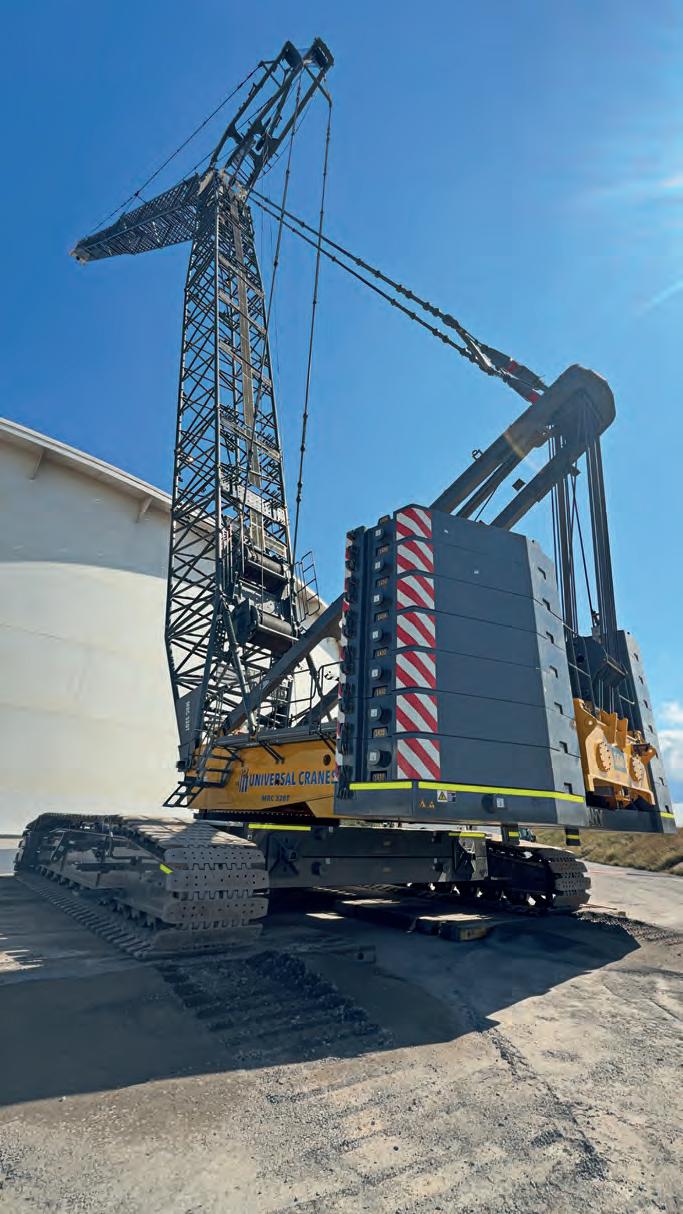
“THIS MARKS OUR FOURTH SANY IN the fleet. We’ve long operated a 100 tonne crawler, a 2007 model which was manufactured just three years after Sany began producing crawlers in 2004, which still serves as our yard crane today,” said Ben. “The advances in technology and build quality since that early model have been significant. More recently, we added two SCC400TB 40t telescopic boom crawlers to the fleet.
“Our two SCC400TB telescopic boom crawlers have performed well and been great additions to the fleet over the past 18 months. As we’ve worked with them, our confidence in the quality has only grown. I also had the chance to visit the Sany factory with Albert and Joe Smith, which was a really eye-opening experience for all of us.
“With the new 320 tonne crawler crane, there were a few improvements we wanted on our machine, and it was refreshing to find the factory open to making those changes. We sent two of our most senior crawler crane team members to Western Australia to inspect the same model recently delivered in Perth. After going over the crane in detail, we put together feedback and suggestions for our order, which we presented to the Sany factory. To their credit, Sany did an excellent job addressing those points and working closely with us to incorporate the changes.”
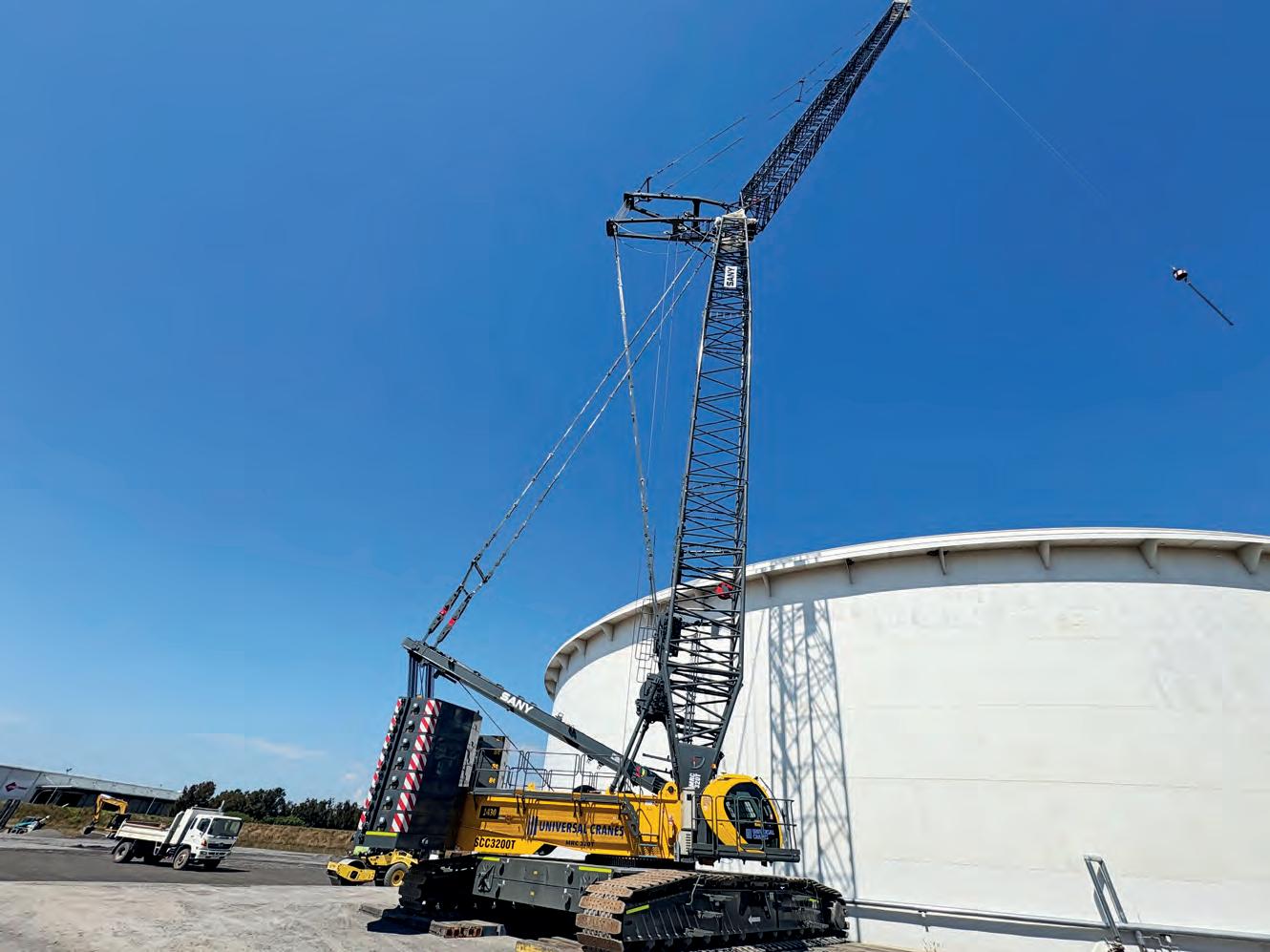
The Sany SCC3200T is a highperformance lattice boom crawler crane for demanding infrastructure and heavy industrial applications, featuring a stable crawler undercarriage, powerful Cummins engine, and an ergonomic cab with advanced safety and control features. Its modular design allows for efficient transport, while technologies like one-button boom extension and smart controls enhance productivity and operator comfort. The SCC3200T is noted for its reliability and adaptability to complex sites, including projects like bridge replacements.
The SCC3200T crawler crane is ideal for a range of applications including heavy
The Sany SCC3200T is a high-performance lattice boom crawler crane featuring a stable crawler undercarriage, powerful Cummins engine, and an ergonomic cab with advanced safety and control features.

construction projects, bridge building and replacement, wind energy projects, oil and gas installations, and other heavy industrial applications.
Universal Cranes was happy with the sales process provided by Sany’s National Distributor Tutt Bryant, especially Business Development Manager for Cranes, Peter Lawgall.
“Peter was great to deal with, and he helped manage the outcomes we were looking for and ensured the communication was clear at all times. He played a really important role in terms of relaying our requirements to the factory and making sure they were implemented. Peter helped by ensuring there was transparency around the challenges and improvements we wanted to see with the product,” said Ben.
“When evaluating new cranes, one of our key considerations is the quality and
“It
comes with an enhanced hydraulic system, and an interchangeable boom system that’s already proven ex tremely useful.”
durability of the manufacturer’s paint system. A robust coating is essential for ensuring long-term performance and protection. To support this, we engaged a coating specialist to visit the factory and conducted multiple inspections throughout the painting process to verify that proper procedures were being followed. Full credit to Sany – they welcomed our feedback and made a genuine effort to address our concerns. The result is a high standard of paintwork, and we’re very satisfied with the outcome.”
Members of the Universal Cranes
team also visited the Sany factory for familiarisation and training, and their initial feedback on the SCC3200T has been very positive.
“There’s a lot to like about the Sany SCC3200T,” said Ben. “It comes with an enhanced hydraulic system, and an interchangeable boom system that’s already proven extremely useful. On its first job –carrying out repairs on a large tank –we’ve got it configured with 36 metres of main boom and the full 70 metre luffing jib. It will be in operation on that site for nearly 12 months.’”
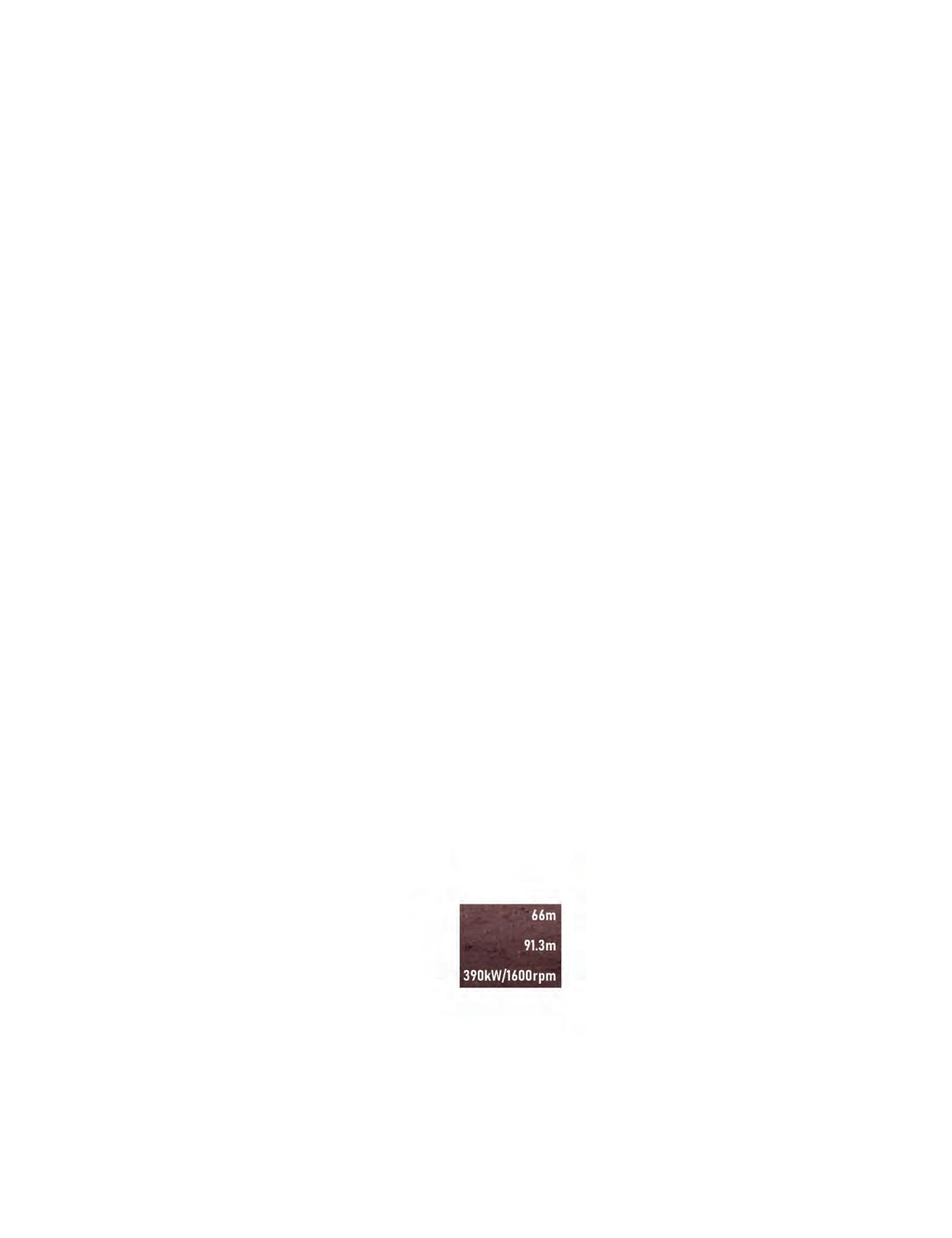
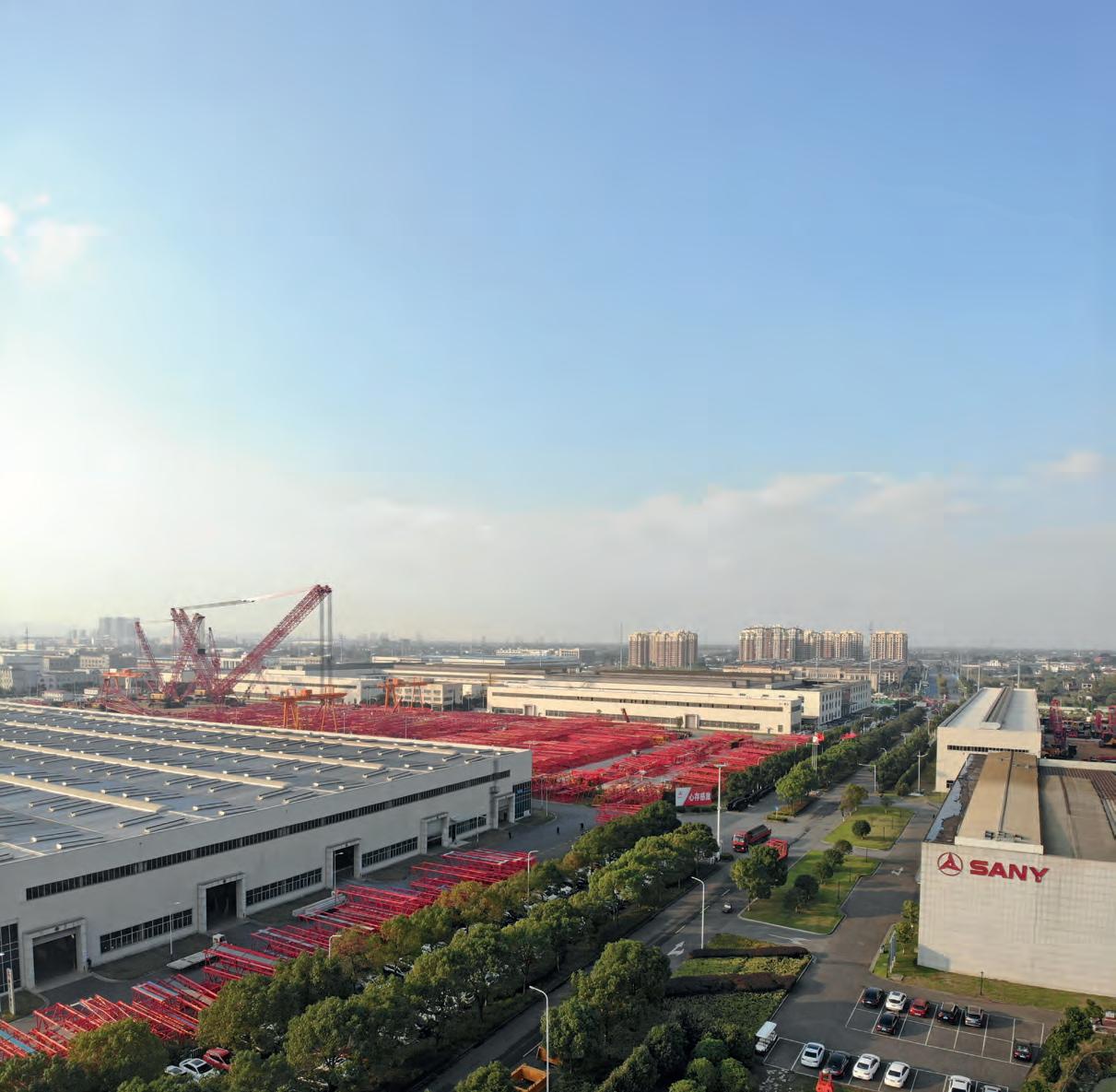

Sany is sharpening its Australian push with a tighter dealer model, heavier investment in service and parts, and a product roadmap aimed at wind, all terrain and rough terrain segments. That was the clear message from Rex Chen, who oversees international sales for Sany’s crane business, and Philip White, who supports Sany sales across Australia and leads direct sales for Sany tower cranes Down Under.

“GOING INTERNATIONAL HAS ALWAYS been a Sany goal,” Rex said. “We invested heavily in service and parts, and we keep asking customers what they want – then we implement those requests into our products.” He added that Sany often builds an Australian version of key models to meet local preferences on comfort and user experience, not just capacity.
A single national dealer underpins that strategy in Australia. “We’ve got one dealer, and it’s a national dealer,” Philip said. “If a customer buys a crane in Brisbane and sends it to Perth, it’s still the same company supporting it. With multiple dealers, you can end up with
gaps or finger-pointing.” Philip also noted that being part of a larger international organisation helps ensure the business “operates honestly and justly”.
Sany builds wheeled cranes (all terrains, truck cranes, rough terrains) and tower cranes in Changsha, central China, while crawler cranes are produced in Huzhou, near Shanghai. Depending on market conditions, annual crane output can reach roughly 18,000–20,000 units. “All cranes sold internationally are designed to European standard EN 13000, then adapted to local regulations,” Rex said.
Quality control increasingly leans on automation. Rex pointed to Sany’s “Lighthouse Factory,” where robots handle a growing share of production to lift consistency and compress build times. For smaller all terrain models, he said the manufacturing lead time can be as low as three months, with additional time for Australian testing and about a month on the water.
“In the past, customers told us that waiting times were too long, and we listened,” Rex said. “Today, our automated lines and improved processes mean a smaller all terrain can be ready much sooner. Once it’s tested for Australia and
From wind farms to high-capacity all terrains,
shipped, the customer can have their crane in less than five months. That’s a big change compared with the old timelines.”
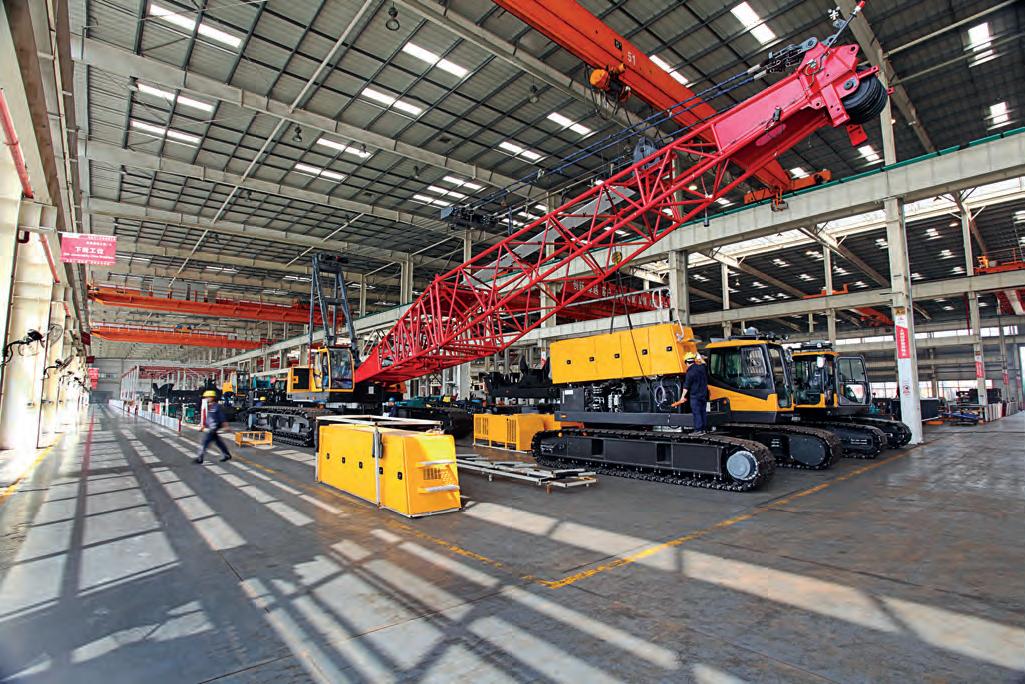
Wind remains a core growth engine. “China has invested heavily in wind, and turbines keep getting larger,” Rex said.
Sany is responding with large-tonnage crawlers and high-capacity all terrains for wind work: a 1300-tonne crawler designed for Europe with Australian availability planned, plus 300- and 400-tonne all terrains.
Philip said that performance at the wind farm is about more than charts. “It’s not just capacity,” he said. “You have to optimise how the crane is assembled on site and how quickly and efficiently that happens, and you must keep within about 22.5-tonne ground pressure per axle.”
On all terrains, Sany has rolled out its “E Series” for high-end markets, including Australia. Rex framed it as a top-spec line expanding from smaller capacities toward the 300-tonne class and above. Rough terrains are also evolving. Sany’s current 40-tonne RT is 2.98 metres wide, and a 45-tonne model
“There’s a function where you press a button and the crane runs through the boom-extension procedure by itself, so the operator can relax their feet and let the system complete the sequence.”
at 2.54 metres is being readied to meet tighter European road envelopes – an approach Sany wants to bring to Australia.
Beyond specs, operator experience is a priority. “We’ve got the new iCab coming as standard,” Philip said. “There’s a function where you press a button and the crane runs through the boom-extension procedure by itself, so the operator can relax their feet and let the system complete the sequence.” The focus on ease-of-use reflects feedback from Australian buyers who ask for comfort and operability, not just lifting chart advantages.
Sany is progressing both battery-electric crawlers (telescopic and lattice) and plugin hybrid all terrains. According to Rex, a 250-tonne plug-in hybrid all terrain has already taken orders in Europe, with
more hybrid all terrains on the way. For now, most models support hydrotreated vegetable oil (HVO)-type fuels to reduce emissions.
Sany prefers to engineer customerrequested changes before delivery and has invited Australian and New Zealand clients to its factories to give feedback on realworld needs. “We’re open to new ideas and we’re happy to host customers on site,” Rex said. “Whatever we say is just words – seeing the factory and the process tells the story better.”
The takeaway is straightforward: a national-dealer model, quicker production through automation, and a pipeline spanning wind, high-spec all terrains and narrower rough terrains position Sany to compete more directly in Australia – while operator-friendly electronics and cab design aim to win over crews who live with the machines every day.
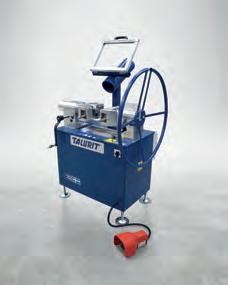
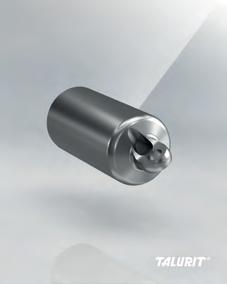
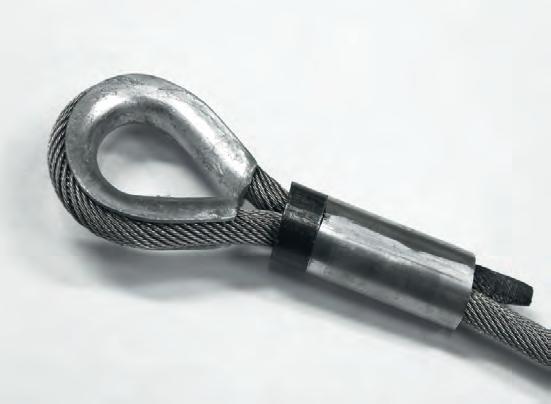
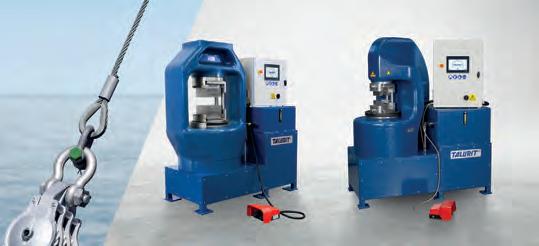
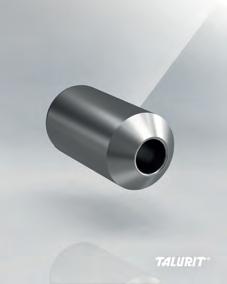
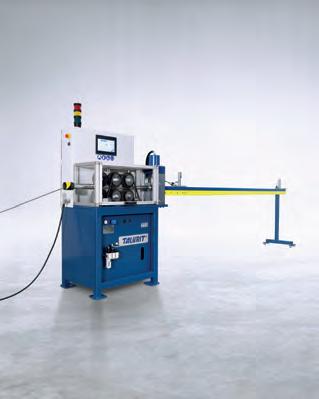
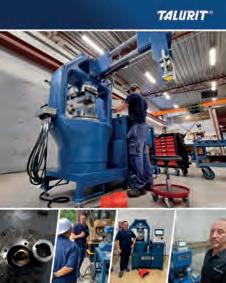
It would be fair to observe that the past 12 to 18 months have been tough for most businesses associated with the construction sector, including the crane industry. Economic conditions have been difficult to navigate with interest rates high and cash flow tight. For Chris Burke, Senior Partner at Finlease, spring has brought a change to these conditions and there is light at the end of the tunnel.
“WE’VE SEEN REDUCTIONS OF AT LEAST one per cent from most major funding bases on cranes and when you’re talking a million-dollar investment on a machine, one per cent does make a difference. To gain perspective one per cent on a five-year loan can save you between $20,000 and $30,000 (depending on residual etc).
“Falling interest rates is the big stimuli for many conversations at the moment. Since the end of the financial year, conversations have pivoted and reverted back to ‘what are we doing next and what’s the next investment?’ Whereas conversations earlier in 2025 were tough. I certainly feel the tide is changing, and lower interest rates are one of the drivers,” said Chris.
Finlease has noticed another emerging trend as the end user market is now more adaptive to specific asset types, the customer buying the asset classes and brands is widening.
“Historically investment into cranes has been very centred around the major brands. Now, we are seeing a broader investment across different makes and models. People are investing in a much wider range of products and Finlease can support all of them, we are able to finance any brand,” said Chris.
“If a customer is purchasing a European, Japanese, Chinese, New Zealand, Australian, or from anywhere in the world, we can support them in their purchase. The problem for several of the banks is
they don’t always understand what the secondhand value of these newer emerging brands is going to be in five years’ time, because time has not allowed the banks to build the data required to allow them to understand the value retentions.
“Banks will often take a cautious position with emerging brands. With brands that are known there is a mature secondhand market, and they are quite happy to take a residual of some assets because they are reasonably confident of the value at the end of the term.
“Some of the banks are not saying that the other brands won’t have a value, but they simply don’t have the available data as yet. To take the risk out of the equation, it can sometimes be safer to finance the equipment in an aggressive loan structure – meaning financing the asset with a nil residual at end of term. That’s one of the paths that banks have taken. This way the banks feel they are not leaving the customer at risk of what the secondhand value might be at end of term and if the machine is worth value at the end, the customer can sell it and realise that equity/money,” said Chris.
For Finlease, the changing landscape isn’t limited to number of brands now being financed. Chris said it is also finding the customer base is widening as the generational change within the industry continues.
“Recently I was in Townsville for CICA’s (The Crane Industry Council
of Australia) Regional Meeting and talking to a number of regional crane companies who have only ever dealt with their local, inexperienced bank manager who seems to change every couple of years,” said Chris.
“They highlighted how isolated they feel when the banker leaves and moves on. Finlease has multiple offices throughout Australia and has always worked in regional communities, it is this sort of experience and knowledge that allows us to provide competitive products and offer a better financial solution for the customer as we are not limited by the local branch one bank policy,” he said.
Another interesting trend involves the movement of wealth between generations. The Financial Review has written about this at a national level and Chris has seen it emerging in the crane industry. This involves Mum and Dad, who have started and operated the business for years, deciding it is time to, or are at least discussing, transfer of the business and assets to their children.
“I could give several examples of crane companies where this is happening or at least the conversations are starting. With this type of ‘handover’ comes opportunity, with the younger generation having a different way of doing things. They are often more technologically adept which can help streamline business processes,” Chris said. “Because we are involved with so many family
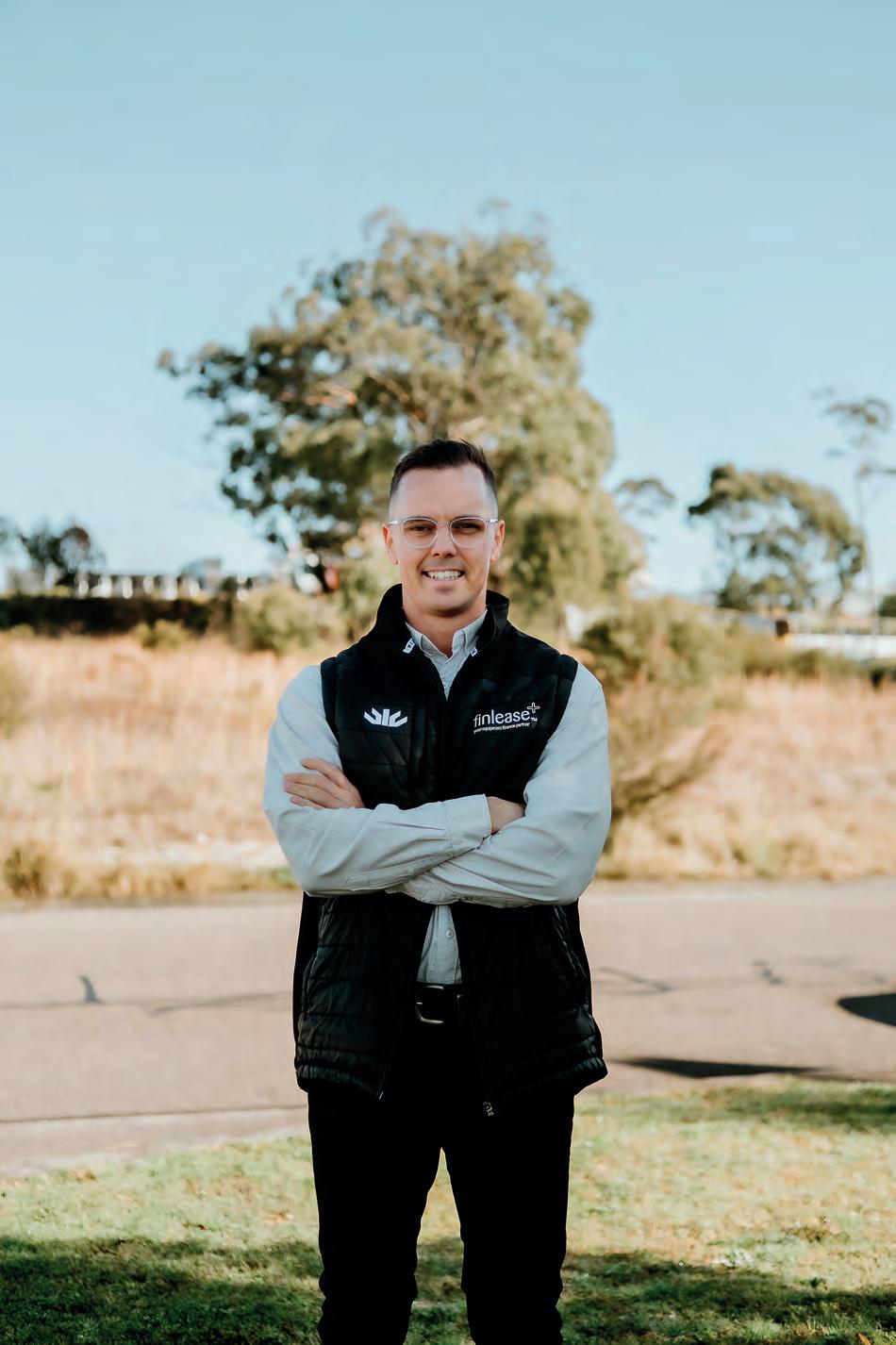

businesses, we have been meeting the next generation over the years and now, they have really smart ideas on how to improve the business and with Mum and Dad’s support, these businesses are going from strength to strength.”
Chris and the team at Finlease process economic information and data all the time including reports from auction houses, forecasts from banks and economists. He said recent data shows an outlook of slow but modest growth for Australia.
The big takeaway from August’s Economic Reform Roundtable was cutting the red tape for the construction sector – if builders and contractors are busy, cranies’ are busy.
“Finlease
has multiple offices throughout Australia and has always worked in regional communities, it is this sort of experience and knowledge that allows us to provide competitive products and offer a better financial solution for the customer as we are not limited by the local branch one bank policy.”
“When I heard the take-outs from the forum my immediate thought was that’s good news for the industry. Cutting the tape for residential and commercial construction is only going to benefit the crane owners,” said Chris. “Having spoken to some tower crane operators recently, I know they are pretty upbeat around what the forward outlook looks like. That is always good news, because if there are tower cranes on the skyline that shows that the city is busy. They are certainly quite upbeat about what 2026 looks like.”
After acquiring the crane scheduling software Visual Dispatch in July 2024, RapidWorks, a heavy equipment solutions provider, has been rolling out its product line to the Australian and New Zealand crane sectors. This suite of products now includes Rapid Fleet.
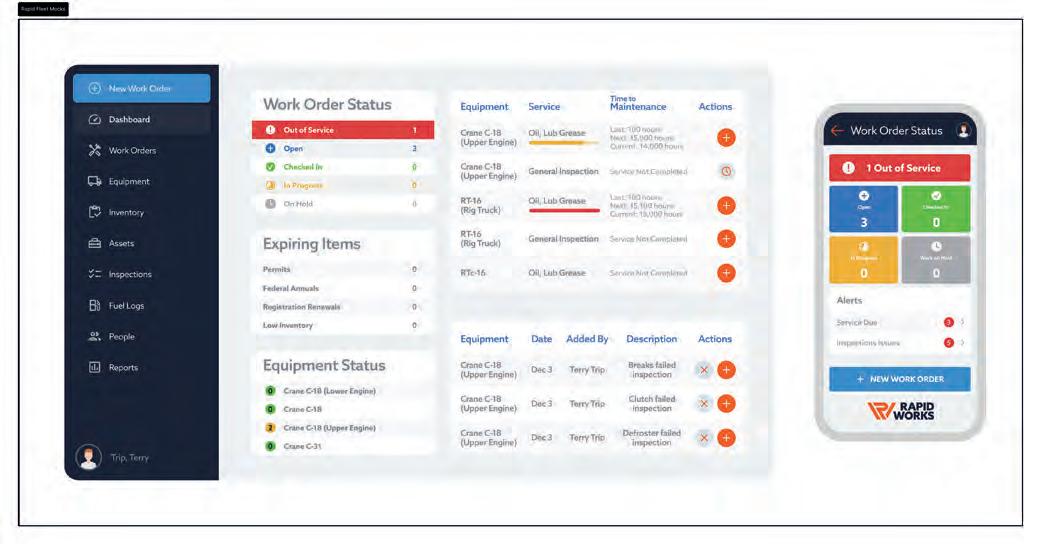
RUNNING A HEAVY EQUIPMENT BUSINESS
is no small feat, especially when unexpected downtime threatens to derail operations. RapidFleet eliminates the hassle of equipment maintenance, giving you peace of mind that your fleet is always ready to perform. With RapidFleet, you’ll reduce unplanned downtime, keep projects on track, and ensure your services remain reliable for customers. Say goodbye to missed repairs and paperwork headaches – RapidFleet has you covered.
A key feature of the RapidWorks and Visual Dispatch suite, RapidFleet is designed to manage the service and maintenance of all heavy equipment. Daniel McBride, Australian and New Zealand Cranes Manager for Visual Dispatch, explains more.
“RapidFleet is the latest addition to our product suite. To strengthen our ongoing partnership with customers, we knew this was a must-have feature. Visual Dispatch users will be pleased to know that RapidFleet integrates seamlessly with their existing Enterprise software. It’s also available as a standalone solution for anyone seeking top-notch maintenance software,” Daniel said.
“With quoting, scheduling, eTickets, timesheets, and invoicing already key features within Visual Dispatch, RapidFleet perfectly embodies our ‘onestop shop’ mission! Not only can we track cranes, but we also provide visibility into every other piece of equipment in your fleet.
“From trucks and trailers to motor vehicles, forklifts, and EWPs (elevated
work platforms), we’ve got you covered. We’ve not only made a great stand-alone product but we have really concentrated on how RapidFleet integrates with Visual Dispatch. With both solutions aligned to streamlining your business the connection between Visual Dispatch and Rapid Fleet really connects workshop to operations and through to compliance.
“Partnering with RapidWorks was a key move to better support our growing customer base, and this is just the beginning. There’s much more to come.”
Here’s how RapidFleet helps manage fleet maintenance, connect shop and back office, and protect the bottom line.
• Work Order Dashboard
Keep your equipment on the road with a central hub for
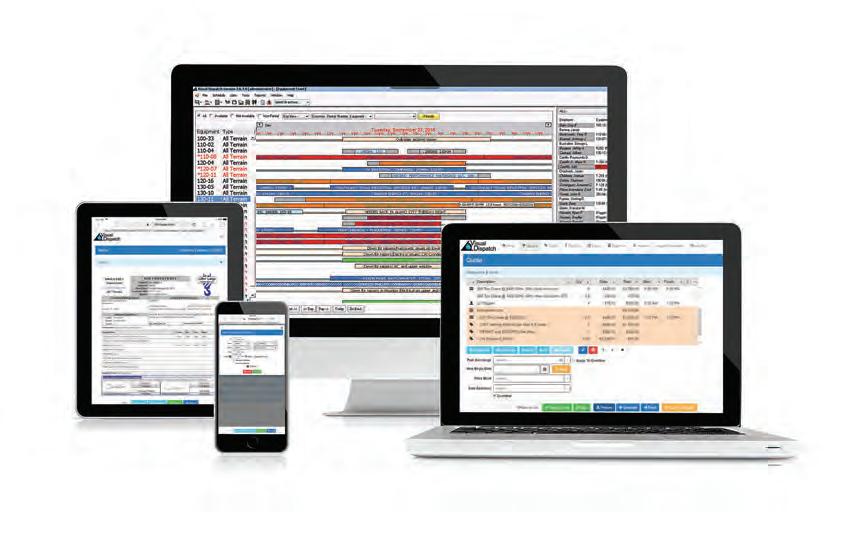
assigning, tracking, and completing maintenance tasks.
• Inventory Management
Know what parts you have, what you need, and where to find them.
• Preventive Maintenance Program
Extend the life of your equipment with preventative maintenance plans for each asset.
• Odometer Readings Vehicle Status
• Compliance Centre
Stay audit-ready with all your maintenance and pre-inspection records in one place.
• Connected Operations
Equipment status syncs automatically, so out-of-service vehicles are never scheduled accidentally. With real-time updates and records that sync seamlessly with RapidWorks’ job management systems, you’ll always know which equipment is ready for the job.
• Pre-Trip Inspections
Run inspections with in-app
checklists that alert your shop when issues are found.
1. Less Downtime, More Work Time
Digital work orders and proactive scheduling help your mechanics keep your equipment earning instead of sitting in the shop.
2. Safe and Reliable Services
Regular, preventative maintenance means fewer breakdowns, safer crews, and more jobs done right.
3. Better Collaboration
When issues are found in the field, the shop and back office are instantly alerted so repairs can be scheduled and jobs reallocated.
4. Protect your Bottom Line
Organised maintenance records, inventory tracking, and compliance reports mean fewer costly surprises and a better asset resale value.

5. Stay Audit-Ready
Keep your maintenance records organised and assemble them at the push of a button.
6. One Source of Truth
Keep your shop and back office in sync across your maintenance and job management systems, so your team is always on the same page.
BENEFITS
• Know what’s being repaired and what’s next.
• Keep equipment safe and under warranty.
• Track parts usage for smarter inventory management.
• Empower your crew to flag issues and ensure these get closed.
• Stay up-to-date with registrations and certifications.
• Build a complete digital asset record for regulatory and business needs.



• Cloud Solution
• Quoting
• eTickets / eDockets
• Payroll / Timesheets • Reporting / Dashboard • Purchase Orders • Invoicing
Fleet Maintenance
Storage
Visual, Drag and Drop Scheduling • Form Designer
ERP Integration
Inductions / Compliance
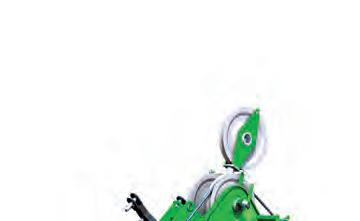
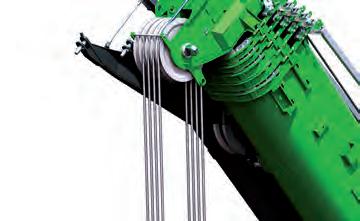
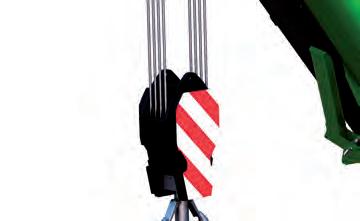




Flexible on the construction site
• Short set up time
• Easy to transport
• Travel under 100 % load
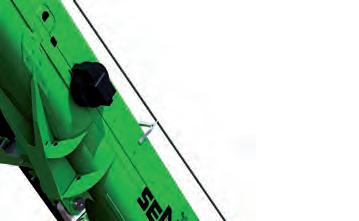


Sennebogen 6133E
Telescopic Crawler Crane
130 Tonne Capacity
































52m Main Boom 15m Fly Jib
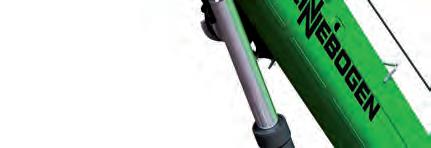

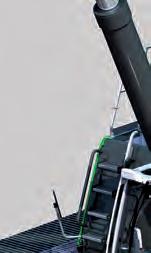

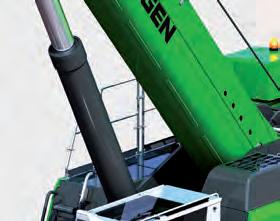













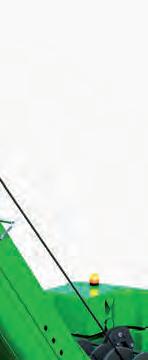

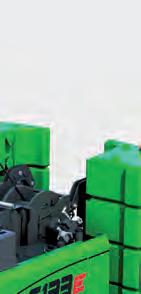
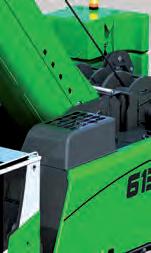














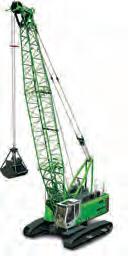











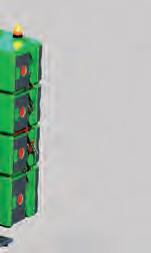























The North East Link will reshape how Melbourne moves, linking the city’s north and east in ways planners have envisioned for decades. But while commuters look forward to faster journeys, those building the project face a very different challenge: staying safe in some of the most hazardous conditions in construction.
AMONG THOSE LEADING THE EFFORT IS Steve Lonsdale, Lift Supervisor on the Spark North East Link central package, where cut-and-cover tunnels are being constructed. Steve and his team are overseeing heavy lifting operations in some of the most high-risk conditions on the project. For them, new safety technology has already changed the way they work.
To support the tunnelling operation, three brand new Franna MAC25 cranes were purchased. Each was fitted with Protective Engineering Safety’s
designed to prevent fatal accidents on worksites.
“On any site, the danger is always there – an operator could be telescoping the boom and if you take your eyes off for a second, you risk coming into contact with live power lines,” Steve said. “These systems give us a secondary layer of protection that’s engineered to stop that from happening.”
The GoUpSafely system uses four magnetic sensors mounted near the boom tip to detect overhead power lines carrying 1000 volts or more. The wireless system feeds into an in-cab display, warning
operators in three stages: no alert, orange for caution, and red for danger.
This is the world’s first dual secondary guarding system of its kind, according to Protective Engineering Safety. “For years, the industry has been asking how can we stop cranes from coming in contact with power lines. Now we’ve got a real, engineered solution,” Steve said.
The latest version of GUS V3 also links to a mobile app, allowing supervisors to adjust sensitivity based on conditions. “When we’re working out in the open, I can reduce the sensitivity knowing there’s no chance
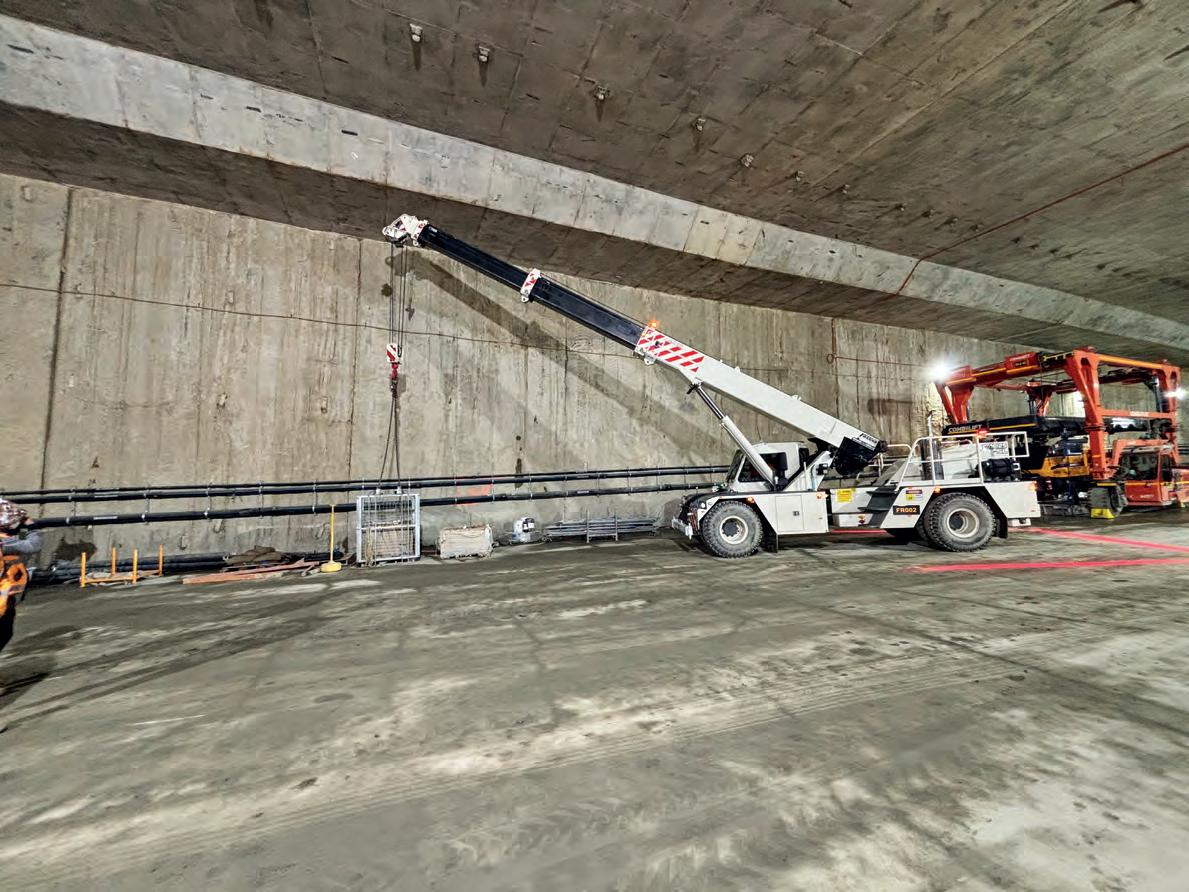

Spark’s Franna MAC25 cranes feature GoUpSafely V3 and Protective Shield systems.
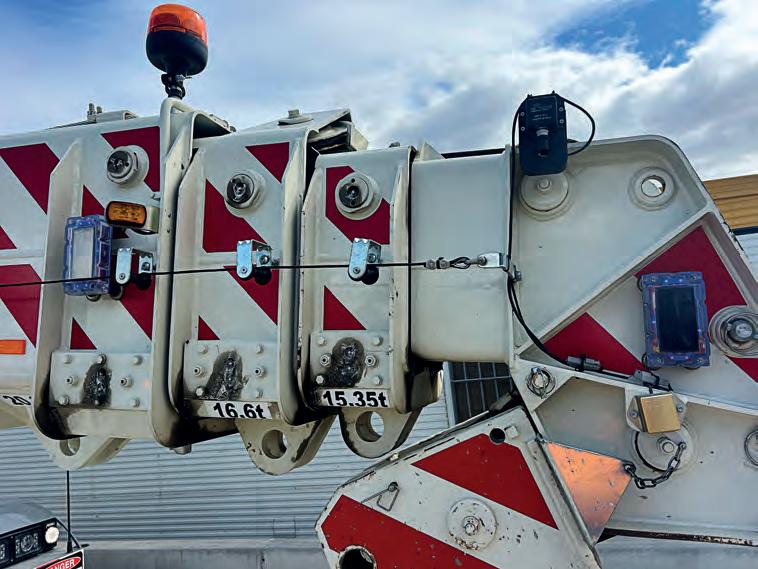
of coming in contact with a power line. But underground, where we’ve got 66 kilovolt (kV) power cables running through the tunnels, I can turn the sensitivity right up,” Steve said. “It gives us that flexibility to match the system to the environment.”
Even shielded power cables can trigger alerts, keeping operators on their toes. “The feedback from the crew has been positive. They know the system is sensitive, but it keeps them alert – which is exactly what we want,” Steve said.
The Protective Shield sensor works in tandem with GUS. Mounted at the boom tip, it constantly points upward, scanning for physical obstacles above the crane.
“In a tunnel environment, you’ve got low clearances and overhead hazards that can damage equipment or injure workers. The Shield sensor detects those risks and sends an alarm straight to the operator,” Steve said. The combination of GUS and Protective Shield creates a 360-degree safety net – covering electrical and physical hazards that are among the biggest causes of crane-related incidents.
Both systems were installed on the Frannas before delivery, with Terex and Protective Engineering Safety working together to integrate them seamlessly. “The handover was really thorough. We were given all the information we needed, and our team felt confident straight away,” Steve said.
Protective Engineering Safety, led by Karl Rosewarne and Jason Jordan, has built a reputation for being highly responsive
Magnetic sensors, wireless cab alerts, and adjustable sensitivity ensure Spark’s crane operators can safely navigate powerlines and tunnel obstacles.
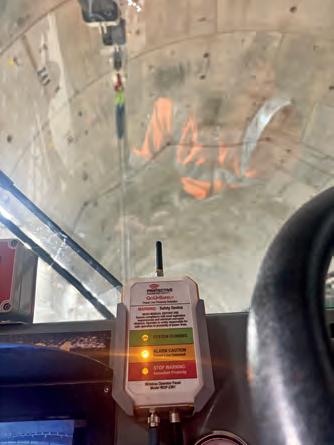
to contractors’ needs. That support, Steve said, has been a major part of the smooth rollout on site.
The GUS V3 system represents the next step in overhead powerline detection, providing wireless communication, increased sensitivity, and integration with operator training frameworks. Similarly, Protective Shield is marketed as an “early warning system against collision”, designed to complement physical barriers and spotters.
For Steve, the combination of these technologies is not just about compliance –it’s about saving lives. “Human error will always be part of construction. You can have spotters, barriers, and procedures, but there’s always that small percentage of risk. These systems close the gap. They make sure a moment’s lapse doesn’t turn into a tragedy,” he said.
Technologies like GoUpSafely and Protective Shield are already lifting the standard for crane operations, but their impact reaches beyond construction sites. Protective Engineered Safety extends its expertise into the rail sector, where the ability to reliably detect both alternating current (AC) and direct current (DC) high-voltage lines could transform safety for operators of rail, tram and light rail networks.
The company is developing a worldfirst AC/DC GoUpSafely system, aimed at solving one of rail’s most persistent safety challenges: reliable detection of both AC and DC high-voltage lines.
The experience with similar sensors on the North East Link project shows that a wider shift is happening across the industry. Safety is no longer about checklists, it’s about engineered solutions that remove risk at its source.
“These machines have been set up with the best of the best. It’s the direction the industry is heading, and it’s the only way we’ll keep improving safety,” Steve said. With hundreds of workers underground and heavy equipment operating in confined spaces, innovations like these could mean the difference between another day on the job and a life lost.
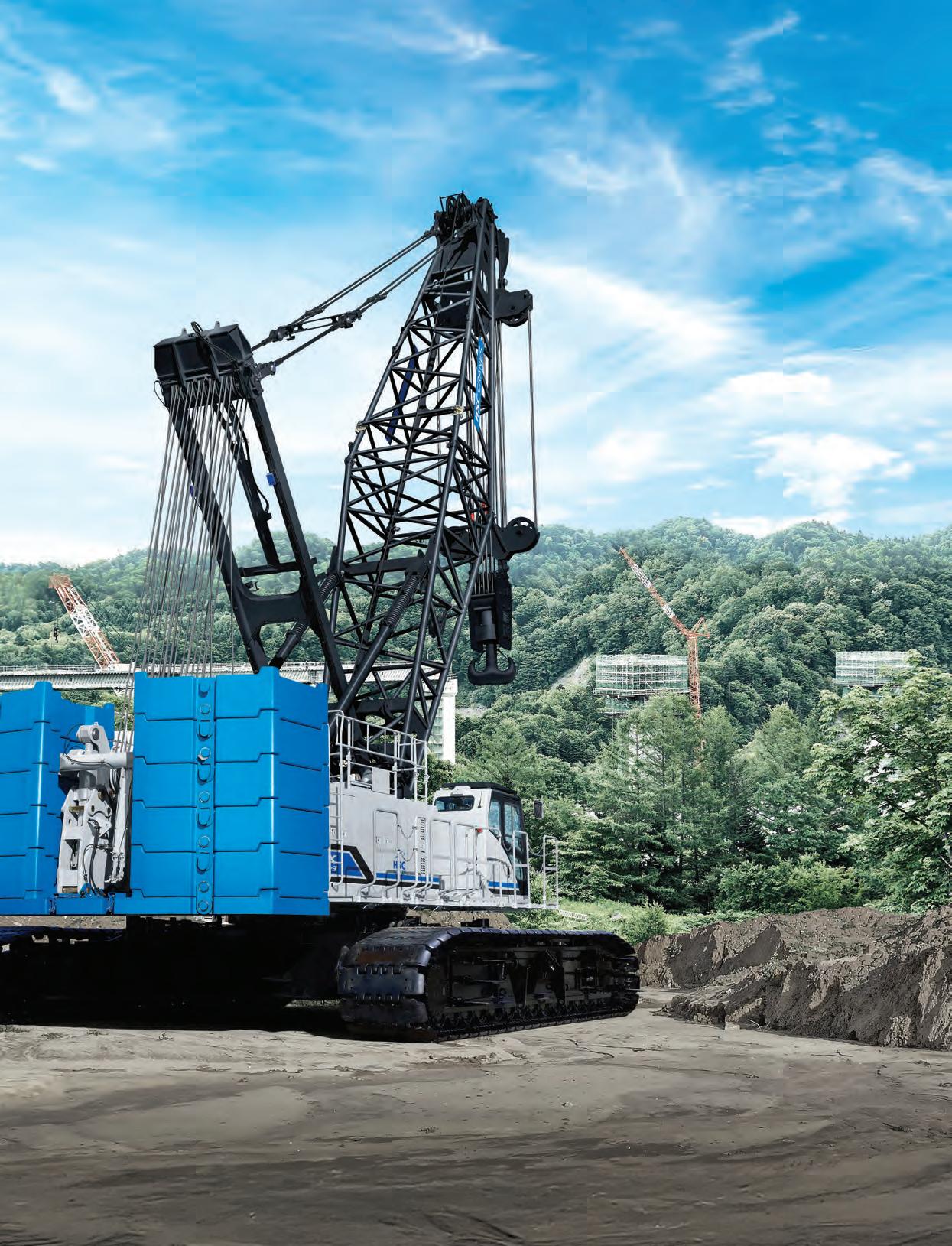
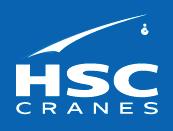
The HSC SCX2800A-3 sets a new standard in the 275-tonne crawler class, delivering the muscle contractors need with the efficiency today’s projects demand. Its Cummins Stage V engine and ECO Winch Mode cut fuel use without sacrificing performance, while features like the tilt cab, intuitive controls, and advanced safety systems give operators confidence on every lift. With smart self-assembly and transport-friendly counterweight options, the SCX2800A-3 is more than a crane, it’s a reliable partner for complex lifting challenges.
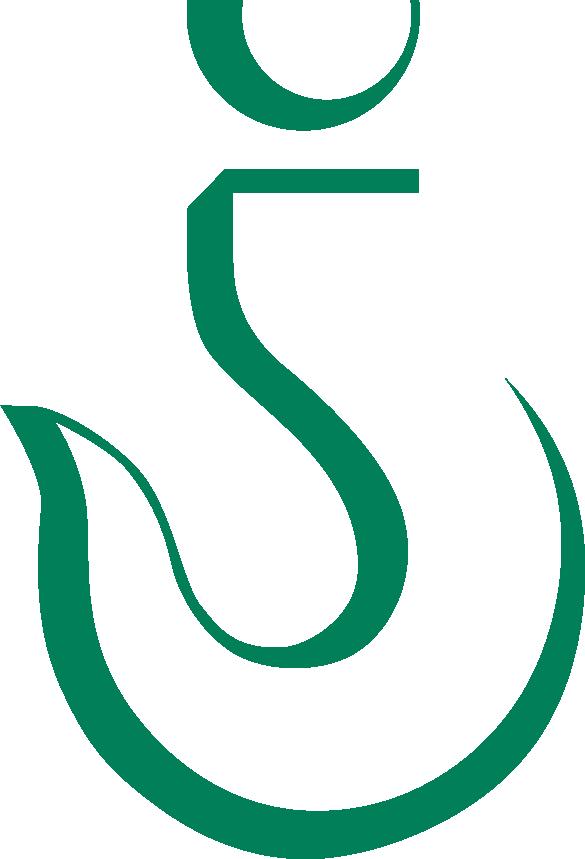



Aconda (formerly known as Tracked Carriers) recently announced it had won the King’s Award for Enterprise 2025.
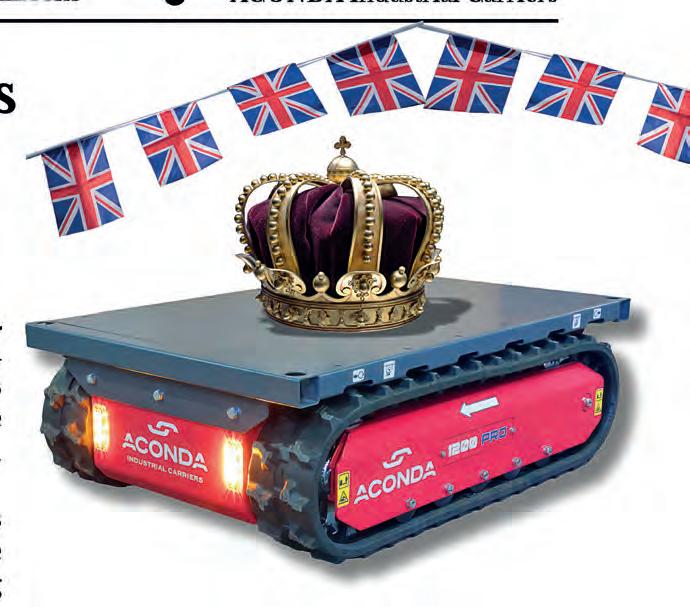
HRH KING CHARLES III RECOGNISED THE company’s achievements in pioneering technology and material-handling machines and acknowledged Aconda as a shining example of innovative British manufacturing excellence. Aconda, the pioneering force behind heavy-duty tracked carrier technology, is celebrating a major milestone in its global success story.
Following continued international growth and record-breaking sales across Europe, the company has recently moved into a new, state-of-the-art headquarters in Essex, UK to support increased production and innovation capacity. Crowning this period of exceptional
across industries.
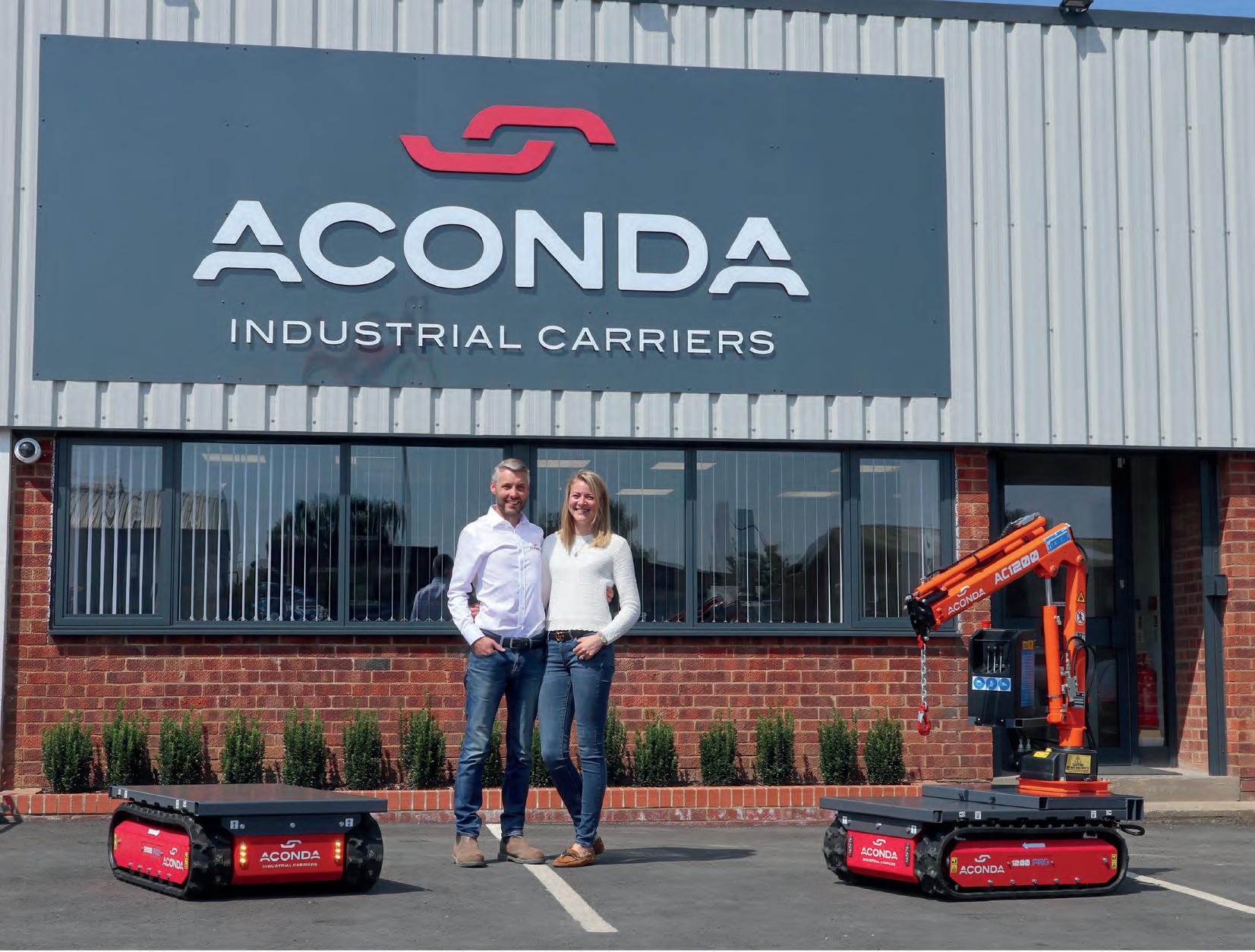
achievement, Aconda has been awarded the 2025 King’s Award for Enterprise in the Innovation category – one of the world’s highest accolades for business.
The award recognises Aconda’s outstanding contribution to technological advancement and its impact on productivity and safety across industries. Aconda Director Tom Cannon commented, “This award and our global growth are a testament to the hard work of our team and the strength of our innovation. We’re proud to fly the flag for
British manufacturing. Thank you also to our loyal customers and supply chain for being part of our success.”
FROM
Being one of only 197 companies to receive the King’s Awards for Enterprise in 2025 is not only a great achievement, it’s also an opportunity for the spotlight to fall on British made material handling machines by being listed in the prestigious London Gazette publication.

“This award and our global growth are a testament to the hard work of our team and the strength of our innovation.”
Having received the award, Tom had the opportunity to meet HRH King Charles III at an exclusive winners’ royal reception at Windsor Castle in Berkshire.
In addition, later this year, HRH King Charles III will send his Lord Lieutenant, Jennifer Tolhurst, to Essex to
meet the ACONDA team at the global headquarters in Witham. Tolhurst will present the bespoke trophy together with a commemorative scroll, signed by His Majesty the King and the Prime Minister. Winning the King’s Award for Enterprise, allows Aconda to fly the
bespoke commemorative flag at its offices and to display the King’s Awards’ emblem on products, packaging and stationery.
Established in 1965, the King’s Awards for Enterprise were previously known as the Queen’s Awards for Enterprise.
Aconda (Tracked Carriers) are available in Australia and New Zealand through Pace Cranes who have been the local distributor for more than five years.
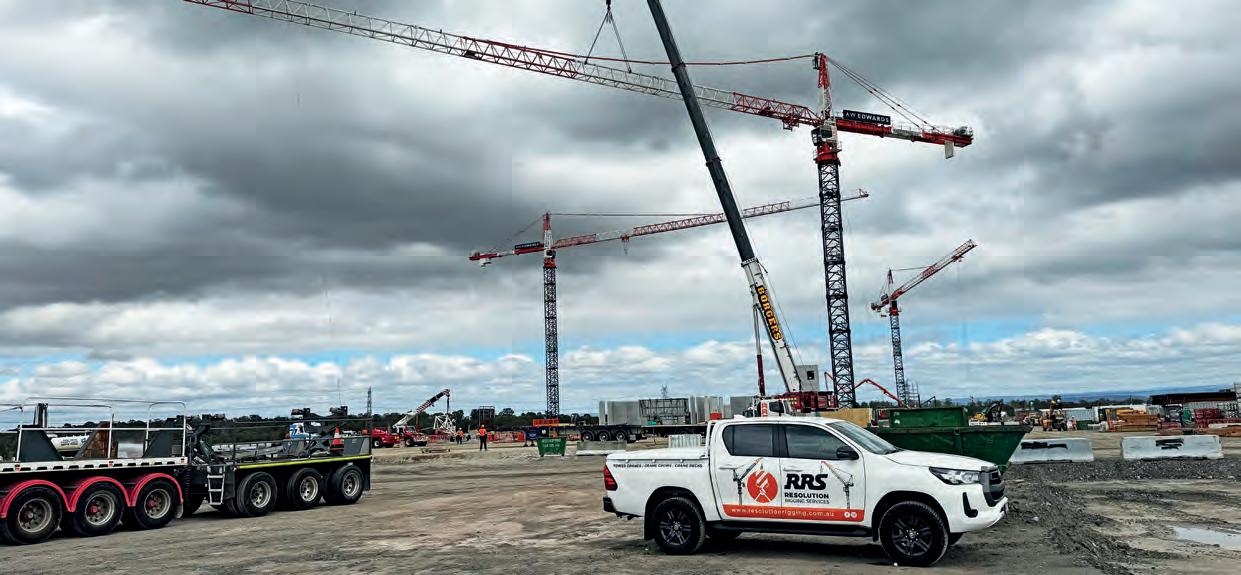

Faster Construction: Modular building techniques reduce construction time by up to 50%, and our cranes handle increasingly large and heavy modules efficiently.
Cost Efficiency: Larger cranes with extended booms can replace multiple smaller cranes, offering significant cost savings.
Reliability and Innovation: With advanced technology and robust support, RRS ensures high performance and minimal downtime for your projects.
Discover how Resolution Rigging Services can enhance your construction projects


Hardiquip recently installed the first Jarlway hydraulic luffing tower crane, the JTL100 C6, on a suburban construction site in Mosman on Sydney’s North Shore.
THE CRANE WAS INSTALLED TWELVE months after being ordered by Hardiquip’s Steve Hardiman, as part of a year-long collaboration with Jarlway to finetune the JTL100’s design specifically for the Australian market.
“The crane was thoroughly tested at the Jarlway factory – once it arrived in Aus, it was assembled and prepared at our yard where we took the opportunity to familiarise and train our techs on the new equipment before it was mobilised to the customer’s project,” said Steve Hardiman.
The site in Mosman presented multiple challenges. In terms of crane selection, the key constraints were the narrow footprint of the site and the necessity to avoid over sail of the neighbouring properties. As for mobilisation and demobilisation, the challenges lay in the tight, narrow urban street and the uneven ground. With its minimum radius of 4.2 metres and its hydraulically powered luffing jib, the JTL100 C6 was uniquely qualified to meet these requirements.
“We can put [the jib] up in five-metre sections as opposed to trying to get a 30-metre run, which was very difficult as there was no room to do that on this particular site. Also, we could deliver all the components to site on rigid trucks with no semi-trailers required. The heaviest lift is 3.8 tonne, so we didn’t need a massive mobile to put it up either. The crane takes about six hours to install and commission.
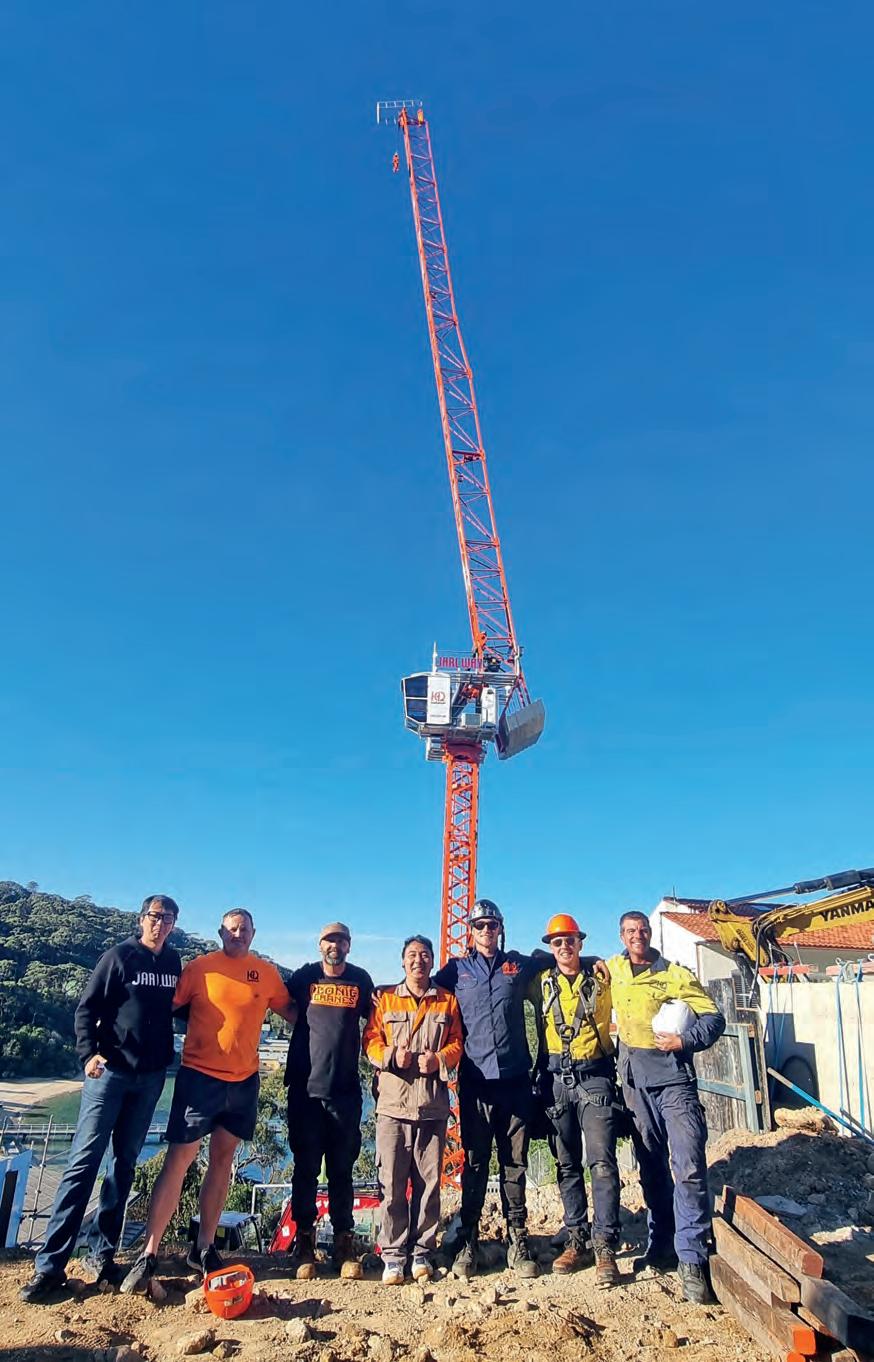
It’s been performing really well, and as yet we haven’t had to go back to site. It should be there for the next 12 months,” said Steve.
Hardiquip and Jarlway share a longstanding collaborative relationship. Paul Guo, Jarlway’s International Business Development Manager, has visited Sydney numerous times to engage with the
Hardiquip team, leading to the creation and refinement of crane models specifically designed for the Australian market.
“Paul Guo has been with Jarlway for more than 15 years, and most of the key people at Jarlway have been there since the beginning. If you visit other manufacturers you’ll meet lots of people, but two years from now, they’ll have moved on and will
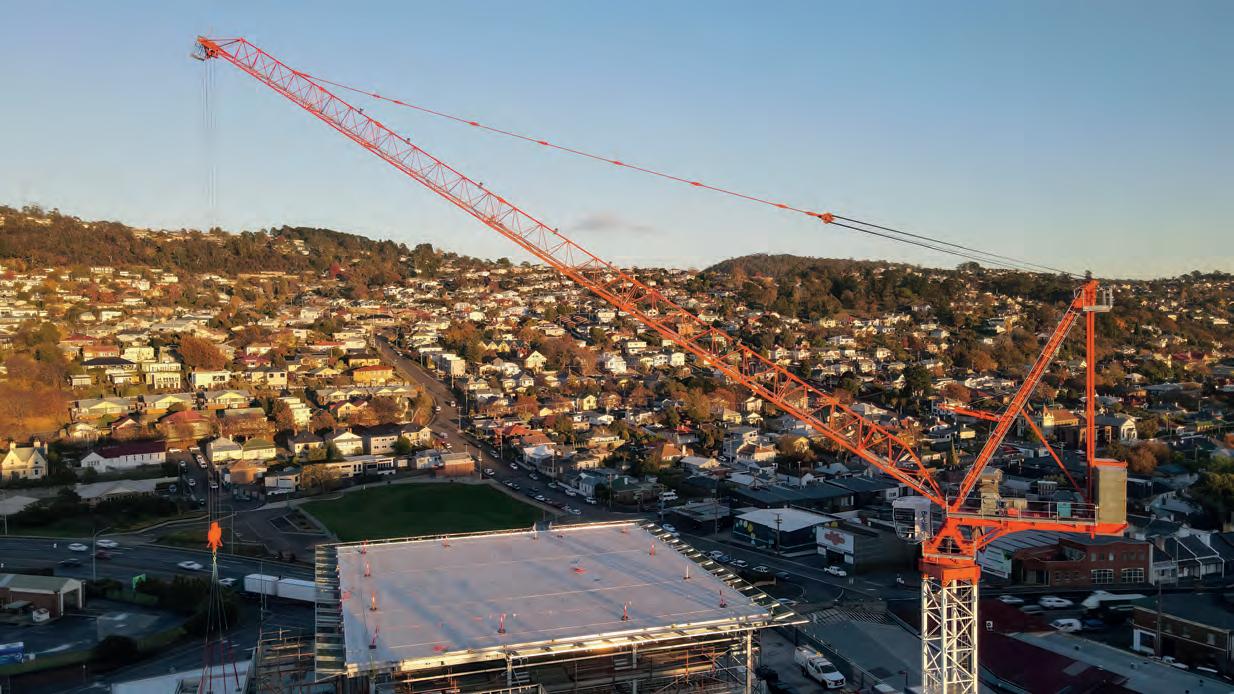

be working in other areas of the industry, building or selling different construction equipment and you’ll have to start again each time. The Jarlway team know the details of every machine they have made,” Steve said.
“The people at Jarlway are crane people and they’re passionate about their product. The development process for the JTL100 C6 was fairly straight forward. The
engineers put the basic geometry of the crane together, and we took a group over in July of last year to test that model and iron out any issues with it, before it got shipped to Australia. The second unit is on its way to Sydney and will be out working by the end of 2025.”
Beyond Hardiquip, other Australian companies are integrating Jarlway cranes into their fleets. Tasmanian crane
company Becket Industrial has just placed an order for its second JTL315 H18 rope luffing tower crane. Pete Jenkins, Director of Becket Industrial, recently travelled to the Jarlway factory with the Hardiquip team to discuss the implementation of some minor upgrades to the new unit before it is shipped to Tasmania.
“We had Pete review the first crane and let us know of any changes he wanted – primarily to make it more riggerfriendly and easier to transport. All this information had been communicated back to Jarlway.
“I have had the opportunity to travel the country and work with other Jarlway owners as they bring new cranes into their fleet. I have accidentally become the voice of the Australian Jarlway owners.
“The factory has been incredibly responsive to the feedback we have provided during the build of our second JTL315. The changes are subtle but well thought out and will be well received. I expect the new 315 to well and truly stamp its authority in the Australian market. By any measure this is a class leading crane,” said Pete from Becket.
“As a manufacturer, Jarlway is keen to hear customer feedback from international markets like Australia to help with reengineering specifications and features on the cranes. They want to know what the end-users want.
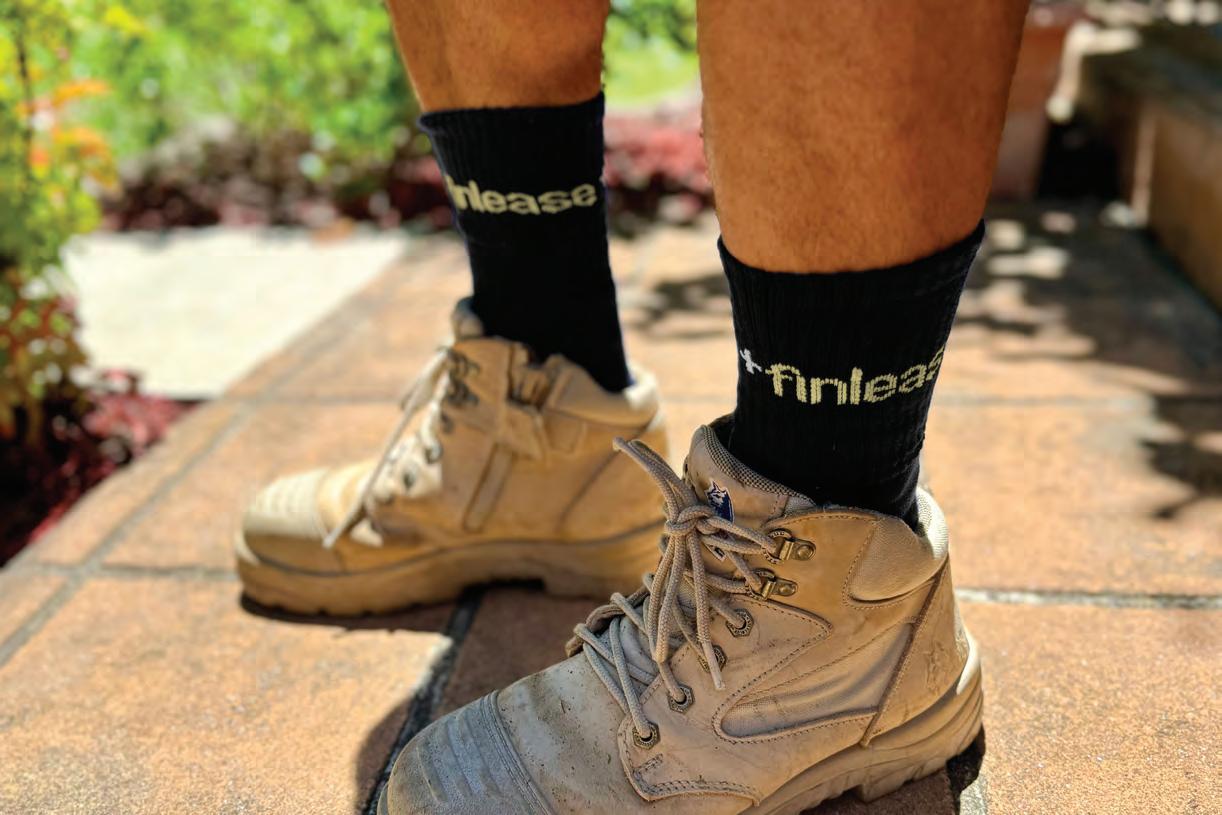


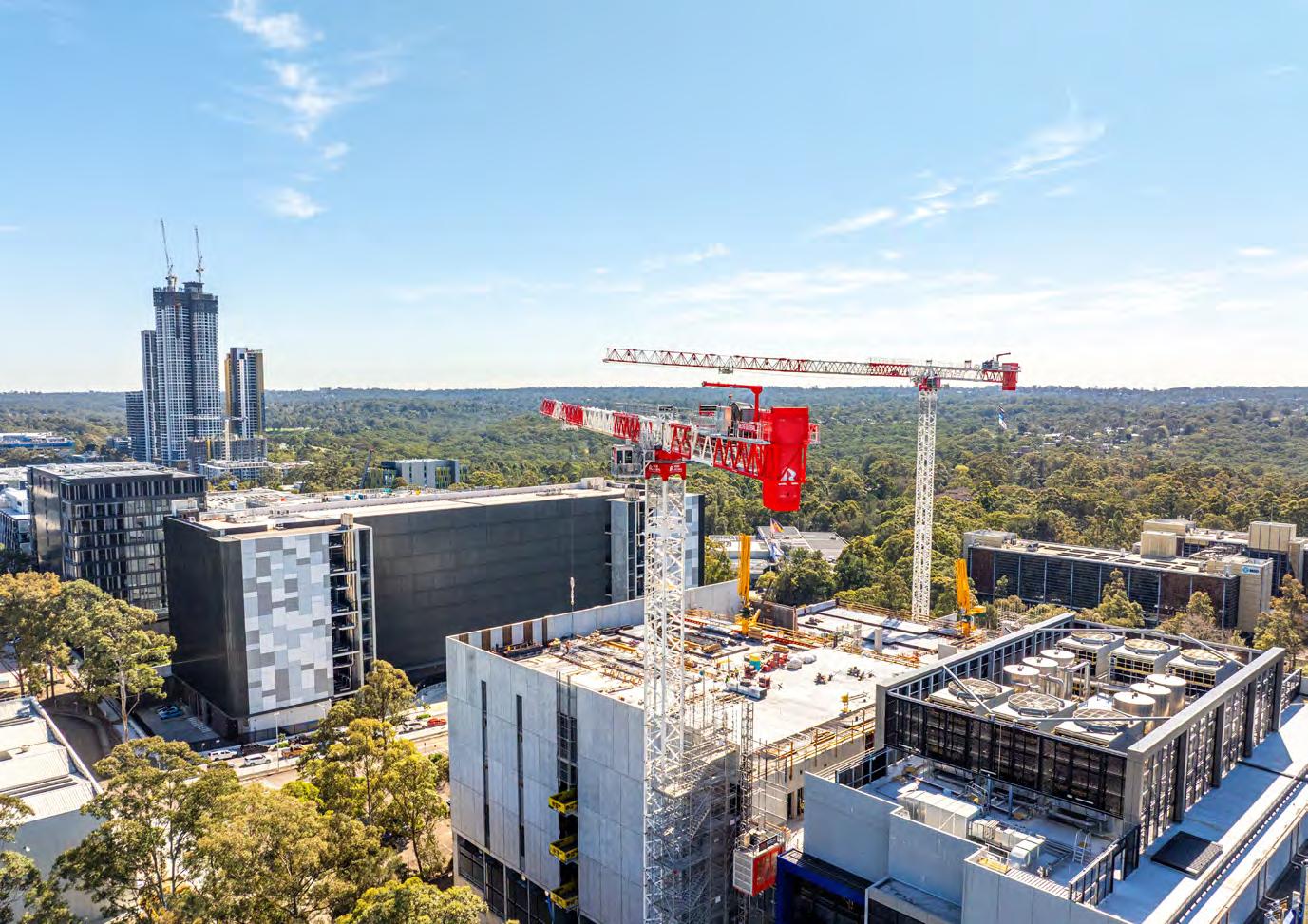
Leading tower crane hire company Reds Global is currently operating two Potain MCT1105-50 heavy lift models on a data centre construction site in Sydney. They are currently the largest flat top tower cranes in Australia.
The Potain MCT1105-50 heavy lift models are an investment made by Reds Global in 2024 and support a strategic objective of the business. The size and performance of the MCT1105-50 gives it a wide range of applications, from modular construction, data infrastructure, energy, and transportation projects. Any project that has needs for high capacity lifting in conditions that have space limitations and aviation restrictions are an ideal job for these cranes.
These are the first heavy lift Potains in the Reds Global fleet, but certainly not
the first Potains in the fleet. Reds Global has a long history with the Potain brand. In fact, it was a Potain that was the first tower crane Reds Global invested in almost 20 years ago. That first Potain had a five tonne capacity – these MCT110550s have a capacity ten times greater than the first crane. Over the years, Reds Global has built a strong relationship with the Potain brand and the team at Manitowoc Cranes, founded on trust and collaboration.
The MCT1105-M50 was chosen for its unmatched lifting power and 80 metre jib reach, delivering 50 tonnes at 20 metres. Operators praise its smooth controls,

reliability, and ergonomic cab, while highspeed precision and energy efficiency boost productivity and sustainability. With Reds Global’s battery energy storage option, it also offers a cleaner, quieter solution for environmentally sensitive sites. The latest installation at a major data centre exceeded expectations for both client and crew.
Red Global’s crews rate the Potains highly for their intuitive controls, reliable performance, and role in keeping projects on schedule –like the MCT1105-M50 at the data centre, which was key to hitting milestones and impressing the client. Operators call out the responsive slewing, low power use, and built-in safety features as standouts, while the battery-powered option is a winner on low-emission sites. Just as importantly, riggers, techs and transport teams love the efficiency: quick to erect, easy to load, and hassle-free to handle – rare praise for machines this size.
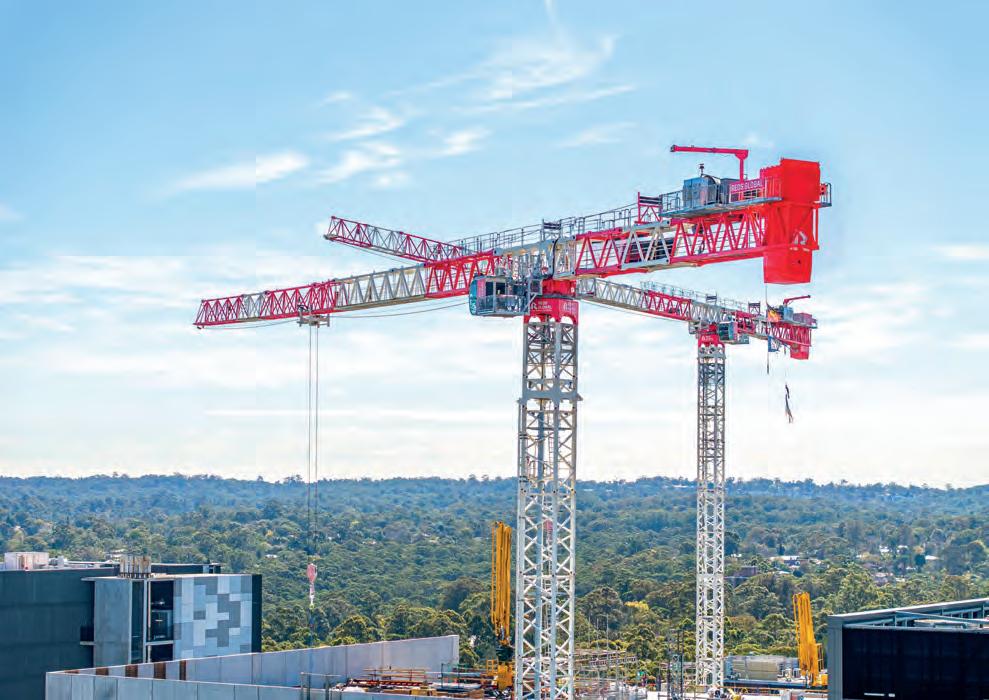
Key features and benefits of the MCT1105-M50 include:
• Heavy lifter – Class-leading strength, handling big loads with precision.
• E xtended reach – 80m radius covers more ground, fewer cranes needed.
• Modular tower – 2.4m sections cut transport costs and speed up setup.
• Topless design – Ideal for low-profile or airport-restricted sites.
• Fa st and precise – Smooth slewing and hoisting boost safety and productivity.
• E nergy efficient – Low power draw with big-crane performance.
• Tall and safe – High free-stand heights with built-in safety features.
• Reliable support – Local service, ready parts, and Manitowoc’s global network.
The MCT1105-M50 is one of Reds Global’s heaviest lifters, built for high-
The Potain MCT1105-M50 was chosen for its unmatched lifting power and 80 metre jib reach, delivering 50 tonnes at 20 metres.
capacity, long-reach jobs. It rivals other heavy models but stands out with its flat-top design, modular setup, and strong tip load – 7.65 tonne at 80 metres. Add smart logistics, low energy use, airportfriendly profile, and optional battery power, and it’s the go-to for complex, sustainable builds.
Manitowoc’s service has been outstanding – proactive, fast, and deeply knowledgeable. Parts and technical support are always on hand, giving confidence that help is never far away. By working closely with the Reds Global team, has not only minimised downtime but also delivered a seamless commissioning process that sets a benchmark for industry support.
The experience of Billy Rumble, Tower Crane Manager for Manitowoc
Cranes Australia, in crane setup and performance optimisation has been invaluable to Reds Global. His worldclass support, rapid responsiveness, and unwavering advocacy – especially on the MCT1105-50s – set him apart as a true partner in the company’s success.
Reds Global acknowledges the capabilities of the Potain MCT1105-M50. For projects demanding performance, precision, and smart logistics – the 1105 is the obvious choice. With options like battery energy storage systems to powered operation and local support, it’s not just a capable crane – it’s a future-ready solution. The company looks forward to continuing its work with Manitowoc and project partners to deliver excellence across Australian projects.
Get in touch with Reds Global to discuss availability, custom configurations, and project planning www.redsglobal.com
Dotmar Engineering Plastics offers high-performance load distribution materials tailored for the crane industry.
Our lightweight, durable solutions replace traditional steel and timber, delivering superior strength and reliability. Backed by engineering calculations, Dotmar products are designed to protect ground surfaces and support heavy lifting in all environments.
Engineered to perform. Trusted to support.

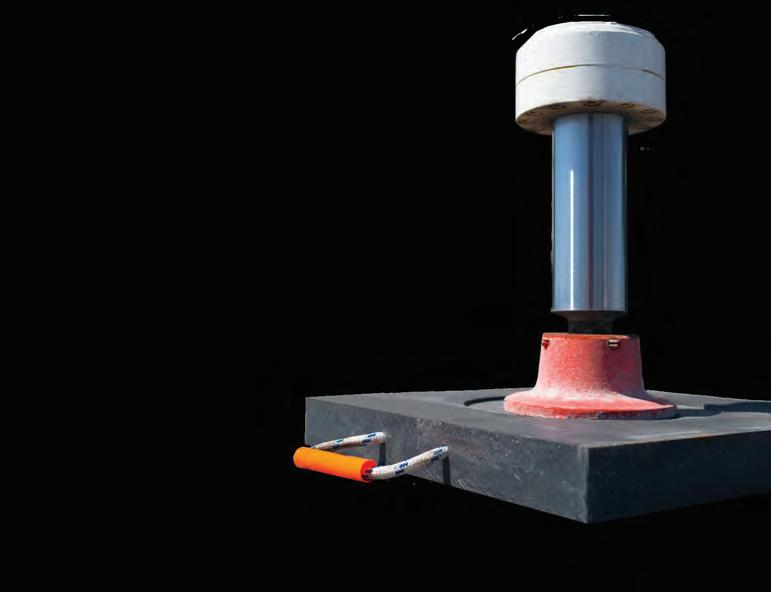
Polystone Confetti Grade Recycled UHMWPE
A sustainable and economical alternative that provides reliable strength and durability for everyday crane operations. Confetti grade plates are lightweight, corrosion-resistant and suited for general load distribution.
Ertalon/ Nylatron Nylon
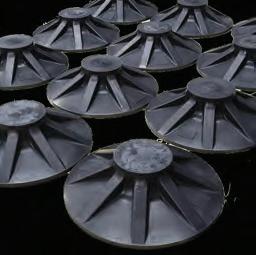
A premium engineering plastic offering excellent mechanical strength and wear resistance. Nylon outrigger plates are ideal for applications requiring high load-bearing capacity, dimensional stability, and long service life under repeated use.
Both materials can be also used to manufacture stackable Dunnage Blocks , designed for ground levelling and height adjustment on uneven or sloped terrain, working alongside outrigger plates to ensure safe, stable footing.
Confetti Recycled
Nylatron
Safe working loads are per outrigger, based on the smallest contact area on flat, even ground. For application-specific calculations, contact Dotmar Engineering Plastics. Custom sizes available.
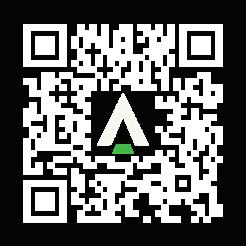


For crane owners, every investment is high stakes. The decision to purchase a new machine can tie up entire businesses with prohibitive repayment schedules. Recognising this, Liebherr has partnered with Quadrent to provide financing solutions tailored to the unique needs of the crane industry.
THE PARTNERSHIP COMBINES FINANCIAL expertise with local understanding, offering operators more flexibility and confidence as projects grow larger and more complex.
In Europe, Liebherr traditionally worked with long-standing partners such as BPCE Equipment Solutions (previously known as Société Générale Equipment Finance (SGEF) and Siemens Finance. Hans Joerg Nothacker (Hansi), General Manager, Mobile and Crawler Cranes for Liebherr Australia and New Zealand said, “In Europe we always relied on known partners in the finance industry. The idea was to blend our engineering expertise with their financial know-how so customers could get the right structure to invest in a Liebherr machine.”
The challenge came when Liebherr tried to replicate this in Australia. Taxation hurdles and the dominance of finance brokers meant European finance models didn’t fit. “In Australia, customers have very close relationships with finance brokers, which is something you don’t see in Europe and needed to be understood by us first,” Hansi said.
That gap resulted in lack of locally relevant financing – until now.
Following the sale of SGEF to Groupe BPCE, the fourth most highly capitalised bank in the euro zone, Groupe BPCE sought to deepen the relationship with Liebherr by delivering the products that had been successful in Europe for the past 30+ years, to other countries across the globe.
Quadrent brings a unique advantage: it is both the Australian and New Zealand arm of BPCE, one of Europe’s largest banking groups, and is officially recognised as Liebherr Authorised Finance. This alignment gives customers access to financing structures already proven in Europe but adapted for the Australian market.
Peter McIntyre, General Manager, Industrial Equipment at Quadrent said, their role goes beyond being just another financier.
“Financiers and banks generally don’t understand the asset very well. Many treat all yellow goods as the same and assume they only last five to seven years. That’s completely irrelevant in the crane industry, where machines are often in service for 20 years or more,” he said.
By leveraging factory support from Liebherr, Quadrent can structure deals that match the actual life cycle of a crane – whether through longer terms or residual values/balloons that ease cash flow.
“With factory support, we can structure transactions that are more appropriate to the life cycle of a crane. Customers can have lower repayments during the term and then the ability to hand back, refinance, or purchase outright at the end,” Peter said.
Factory-backed financing from Quadrent allows extended terms, residual values, and project-aligned repayment schedules for Liebherr cranes.

This flexibility is crucial for smaller operators – the “mum and dad” businesses – who may be putting their entire livelihood on the line. For Liebherr, recommending a partner it trusts is part of its responsibility to help customers succeed.
“When customers invest in a Liebherr machine, they often put their whole house on the line. So, we had better make sure any finance partner represents the same values we do,” Hansi said.
Australia is entering a period of unprecedented infrastructure and energy investment. From wind farms to stadium builds and potential offshore projects, the cranes needed are only getting larger.
Hansi said, “All those large projects require large machines, because everything is getting heavier and more modular. And as the machines get larger, so do the investments.”
The challenge for operators is bridging the financial gap between their dayto-day business and project-driven purchases. A crane like the Liebherr LG 1800-1.0 or LR 11000 might be essential for winning major contracts but represents an enormous financial risk if projects are delayed or cancelled.
Here, Quadrent’s tailored structures provide confidence. “Our objective is to help customers get into larger, projectdriven cranes without jeopardising their daily operations. Sharing the risk between the end user, Liebherr as manufacturer and Quadrent as financier in a fair way makes that possible,” Hansi said.
Another key benefit is how the partnership safeguards resale values. Unlike banks that may liquidate repossessed equipment through auctions – driving prices down for everyone – Quadrent works with Liebherr to ensure cranes are refurbished and remarketed properly.
“Anything that comes back gets refurbished and resold through Liebherr. That keeps values higher for the benefit of all owners. There’s nothing worse than a crane being sold cheaply at auction, which drags down the value of every machine in the market,” Peter said.
This full-lifecycle approach not only protects operators’ balance sheets but also underpins the long-term strength of the Liebherr brand.
While much of the focus is on financing mega projects, the partnership is equally
relevant for smaller businesses climbing the growth ladder. A typical journey might begin with a Franna, then step up to a 40 or 50 tonne Liebherr and grow from there.
For many operators, Quadrent acts as both financier and broker, working with local banks where it makes sense while still bringing the added advantage of factory-backed support.
Wind energy is a clear example of where these solutions matter. As Peter said, operators bidding for wind farm projects often face significant upfront costs, from mobilisation expenses to long lead times before payments begin.
“When we understand the cash flows generated by a crane on a wind farm project, we can structure finance specifically around that. It means operators can take on these contracts with confidence, knowing their repayments align with the project’s revenue stream,” he said.
In practice, this can mean the difference between buying one crane slowly or acquiring two machines at once to cover multiple contracts – enabling faster growth and better economics.
For Liebherr and Quadrent, the partnership is about more than just transactions. It is about building longterm relationships and giving operators the tools to succeed.
“I’m confident that with Quadrent, we have a partner who shares our values and will stand by customers in difficult times,” Hansi said.
In an industry where machines can define a company’s future, access to the right finance is as critical as access to the right equipment. Liebherr and Quadrent’s collaboration brings together decades of European experience and local market expertise, giving crane owners more options, greater flexibility, and enhanced value that extends far beyond the signing of a contract.
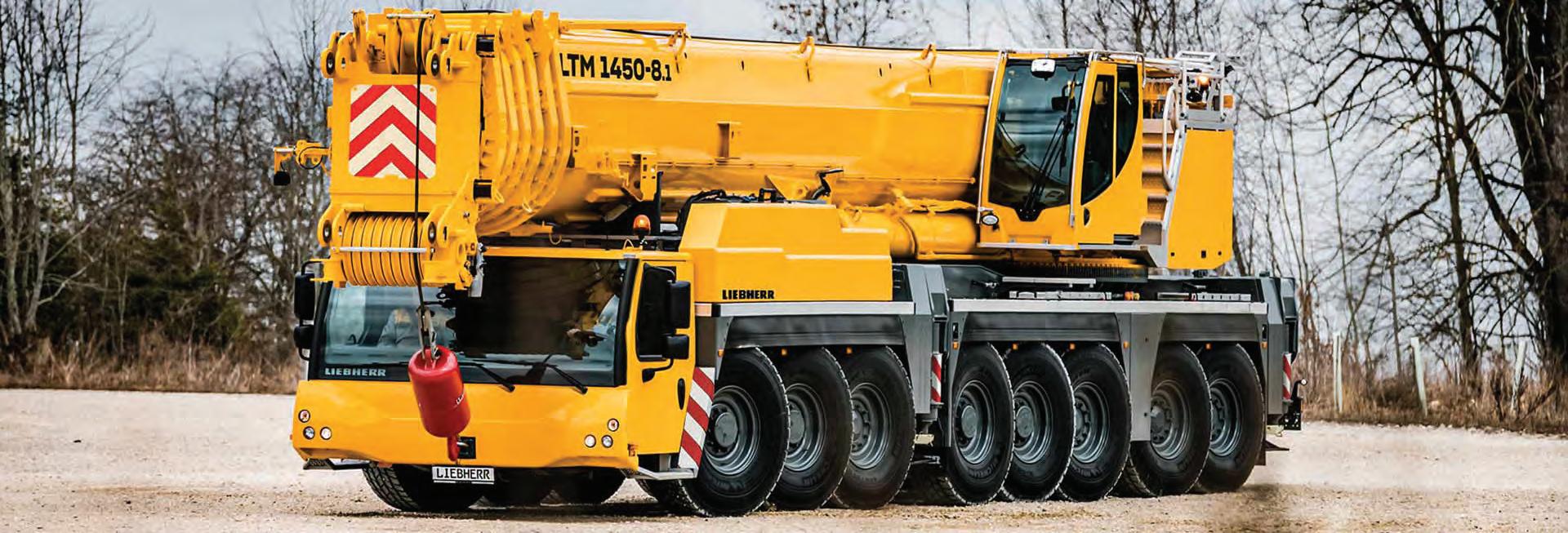
Flexible tailored finance - Choose chattel mortgage or flexible leasing
Faster access - Pre-approved limits for Liebherr cranes
Lower cost of ownership - Lower payments through our asset value expertise
Free up capital - Off-balance sheet funding improves ROA and ROE
Stay in control - Diversify lenders and keep banks competing for your business

Scan the QR code to learn more, or chat with our team at www.quadrent.com.au/liebherr
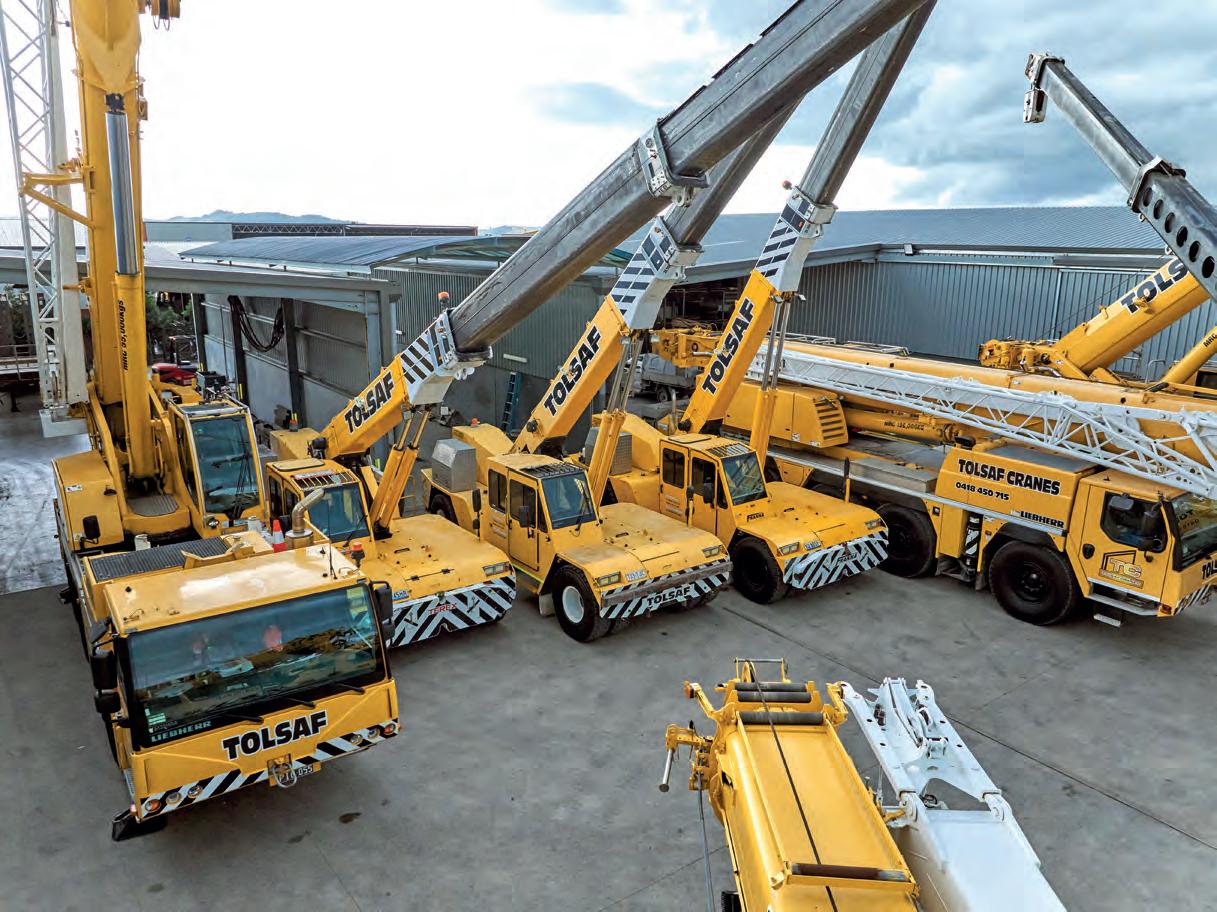
By delivering first-class solutions, Pickles remains the leader in the secondhand crane market.
IN THE MIDST OF A CHANGING MARKET AND competitive demand for new equipment, Australian businesses are finding unexpected value in the secondhand market. This is especially evident in the current crane marketplace, where household names like Pickles continue to provide effective solutions for vendors, and access to reliable equipment for buyers.
Since 1964, Pickles has stood strong as a fixture in the crane market by staying adaptable to the ever-changing needs of customers. As Australia’s leading auction house and used asset marketplace, Pickles is renowned for steering businesses with confidence toward the best result for them.
By remaining a pillar throughout this rollercoaster decade, Pickles has continued to unlock value for vendors to alleviate challenges while providing powerful purchasing experiences for buyers.
For James Chauncy, Pickles’ National Sales Manager, Trucks and Machinery, choosing to invest in the secondhand market can be a key play for a business navigating short turnarounds.
“What’s becoming evident in 2025 is the continued benefits of getting access to used cranes in the current market,” James explained. “Whilst buying new will always have its place, buying used allows flexibility. Take, for example, a situation where a business needs assets fast for a newly-won job. A used crane can be acquired in the interim so that you can start and finish the job even faster. If a job requires very low utilisation and has a high potential for downtime, we have assets available to cater to this too. We’re here to find solutions.
“But not only that, the crane operators, riggers and technicians on the ground want quality, reliable equipment quickly; and we’re here to give them that peace of mind. With a used unit, the purchase process can be completed more rapidly, which reduces wait times and provides a suitable solution.”
Backed by a specialist team of crane experts ready to handle the hard parts, Pickles is diligent about its online listings and meticulous in sourcing all of the details needed for buyers to make informed purchases from an online auction. Selling
cranes can involve complex compliance, transport, and market timing issues, but by providing transparent processes, financing options, accurate valuations, and fully compliant transactions, Pickles prioritises its customers’ needs.
Reducing risk for both buyers and sellers is why many have remained loyal to Pickles through the years. Pre-owned cranes can come with extensive service records, offering a clear picture of previous operational results. Knowing that a crane has performed under real conditions, and will continue to function, gives buyers the relief of reliable performance.
For businesses looking into the used market, it’s as simple as having a conversation with a Pickles sales executive. With experience in securing value on everything from high-value gear, to premium assets, and even guiding retirement and business closure sales, businesses find it easy to offload with the experts.
James attributes Pickles’ longevity to its customer-first emphasis on the details and

sharp understanding of the domestic and global market.
“It’s not just about the early conversation – we see the sale through to the end. We come together across the company, from our industrial team to the financial and marketing side of the equation, to move quickly to ensure maximum sales results and ultimate convenience for the vendor.
Finance makes sure that all details and funds are organised so that the vendor can be paid as quickly as possible, and the marketing team will create a huge pre-sale campaign to reach a wide audience of potential buyers,” James said.
“We are conscious of the fact our bidders are based all over the world and may not be able to inspect the equipment before the auction. Whether bidders are based on the other side of the country in Perth or overseas in the Middle East, wider Asia or Africa, our long-standing customer relationships protect vendor outcomes and give buyers confidence in their purchases.”
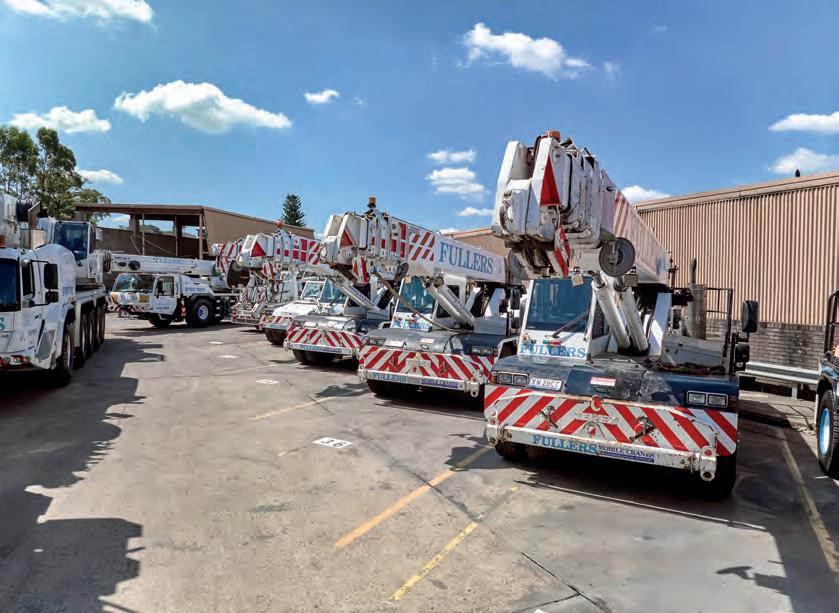
Selling cranes can involve complex compliance, transport, and market timing issues, but by providing transparent processes, financing options, accurate valuations, and fully compliant transactions, Pickles prioritises customer needs.
Pickles’ connection to domestic and global industries is why many choose to acquire their used cranes there. Secondhand cranes offer businesses a cost-effective way to boost efficiency, productivity, and safety, and give the assurance of proven performance. This is essential to fast-moving industries such as construction, engineering, manufacturing (especially steel fabrication and automotive), and maritime transport industries where cranes are needed the most.
these trends for their customers, positioning themselves as the informed, reliable partner vendors can trust in a changing market. By seeking to innovate daily, Pickles has carved out a distinct lane as a business capable of guiding the everyday needs of a broad range of customers based around the world.
Pickles has proudly built lasting relationships with many local and global crane providers, largely because it is proficient in finding buyers for the equipment being auctioned. By providing the right advice based on extensive experience and delivering on the best return for the vendor, Pickles is duly regarded as having built a trustworthy marketplace.
At Pickles, customers gain access to a secure online marketplace and an exclusive database of active buyers with thousands of sales conducted monthly. This is supported by a team of expert data scientists and analytic solutions specialists, which ensures that Pickles stays on top of current crane market trends – from model demand shifts to regional pricing insights – to navigate
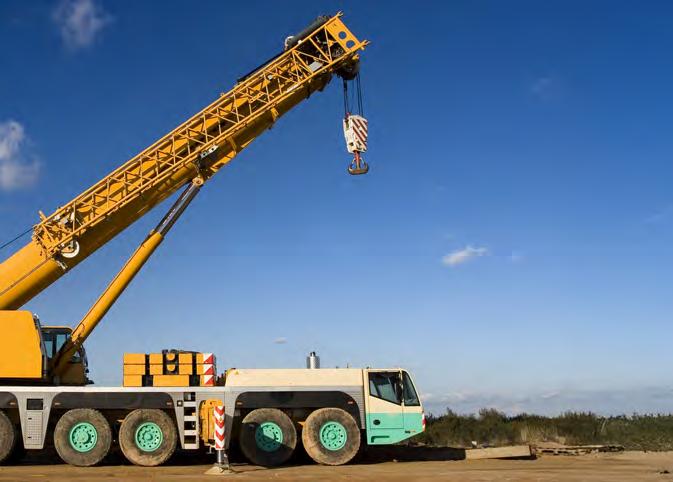
“The team at Pickles Industrial are very knowledgeable but most importantly they are customer centric. Their commitment to achieving the best outcomes for their customers, with as little hassle as possible, is second-to-none.”
“Pickles
As the backbone of Australia’s booming construction, mining and renewable industries, cranes are an essential part of how Australia builds its cities and communities. By drawing on decades of auction experience and a proven sales process to deliver results for crane owners and buyers, Pickles has a deep knowledge and understanding of the industry’s impact.
At Pickles, a crane auction is just the start. By combining valuation expertise, targeted marketing, and a nationwide buyer network, across multiple industries where cranes are utilised, Pickles can maximise asset value from listing to final sale. With the largest connected network of buyers across construction, infrastructure, and resources, Pickles moves cranes into the hands of serious buyers faster. As James explains, having the expertise to deal with the challenges of an evolving industry is what enables these rapid results.
“Supply and demand naturally drives what used cranes are available on the market. Pricing of assets is ultimately dependent upon the projects currently happening or in the pipeline for the industry,” he said.
“In a market which naturally undergoes fluctuation each year, our ambition is always to adjust on the fly to meet the changing needs of our customers.”
If you’re ready to let Pickles do the heavy lifting, discover a thriving online marketplace at pickles.com.au.
Spark’s Franna MAC 25 fleet is equipped with Superlift, Safety Radar, 360-degree cameras, and systems like GoUpSafely, Protective Shield, and Halo.
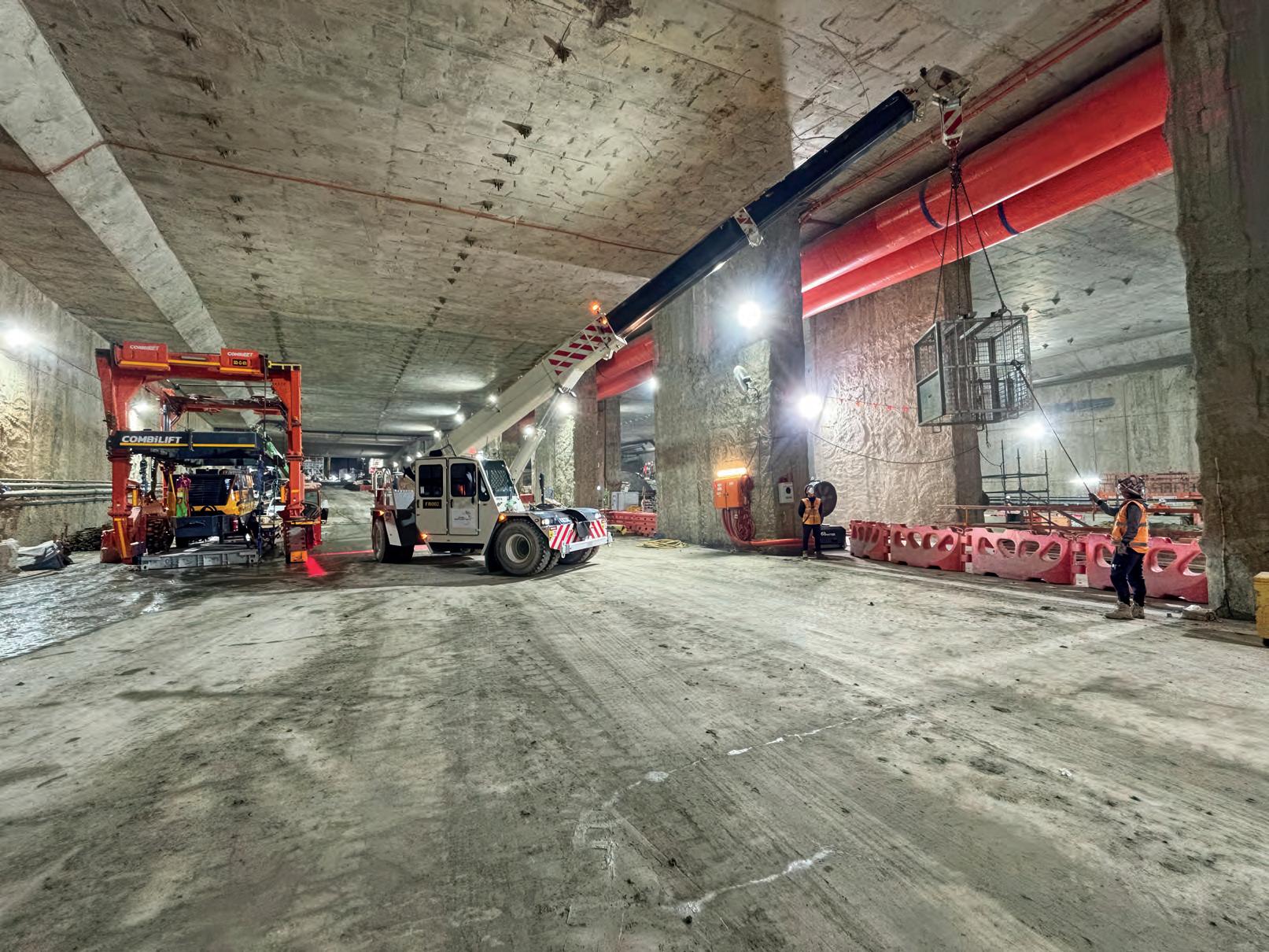
Every major project depends on reliable machines. For Spark, working on Melbourne’s North East Link, that reliability has come in the form of three Franna MAC25 cranes. More than a year after they arrived, the cranes are proving themselves as efficient all-rounders, backed by new safety systems that are setting benchmarks on site.
THE CRANES WERE PURCHASED EARLY IN 2023, with the first arriving in October and the other two soon after in November and December. Spread across the project’s three main zones – the northern tunnel entrance, the southern exit, and a central position – they’ve been used in both surface and underground work.
“All three cranes were bought for general lifting duties, whether it’s moving rubbish bins, jersey barriers, unloading trucks, precast installs or assisting larger cranes with set ups,” said Steve Lonsdale, Lift Supervisor on the Spark North East Link. “They’ve been worked hard from
the start and continue to do what’s asked of them.”
Flexibility has been critical, particularly on the tunnel sections. “The new machines were specced for underground use as well,” Steve said. “If required, they can be driven into the tunnel entrances or lifted down into the box sections, which gives us options across the whole job.”
WHY FRANNA?
Spark’s decision to go with Franna came after extensive discussions at management level. While other options were available, Steve said the Franna MAC25 stood out
because of its proven track record and the upgrades introduced in the latest models.
“The Franna MAC25 has been around since the late ’90s, and it’s proven itself over time,” he said. “What set these new machines apart were the upgrades – the radar system, the Robway computer, the 360-degree cameras, and safety systems like GoUpSafely and Protective Shield.”
Each of the units purchased by Spark includes the Superlift upgrade and Franna’s Safety Radar, which monitors slope and load angles. “The radar system is excellent, especially when the machine is working on a side slope,” Steve said.
Spark also ensured the cranes were fitted with additional protective systems. Fire suppression was mandatory for underground work, and all three machines were equipped accordingly.
“There’s a big button in the cab, which we hope never gets used,” Steve said. “But if there’s a fire, the system isolates the machine instantly. It’s simple but effective.”
The team has also incorporated new technology to prevent on-site accidents. Alongside the GoUpSafely system, which prevents potential electrocution, and Protective Shield, which reduces the risk of striking an above structure during lifts, Spark has added the Halo system – a visual aid projecting a red exclusion zone around the rear of the crane to highlight the ‘swing’ area of the crane.
“It’s about making sure people stay out of that danger zone,” Steve said. “Again, it’s another first, something no one else has done before, and it’s proving very effective.”
With many experienced operators on site, the introduction of the new Frannas was seamless.
“The operators have been very comfortable with them,” Steve said. “It’s not like moving into a completely different type of crane. The seating, steering, and feel of the machine are familiar, so the transition was smooth.”
That ease of use, combined with the safety technology, has meant the cranes have been well received by crews across the project.
According to Steve, one of the strongest aspects of the purchase has been the ongoing support from Franna’s team. Robin Ghosh and the tech support from Terex Brisbane has been fantastic.
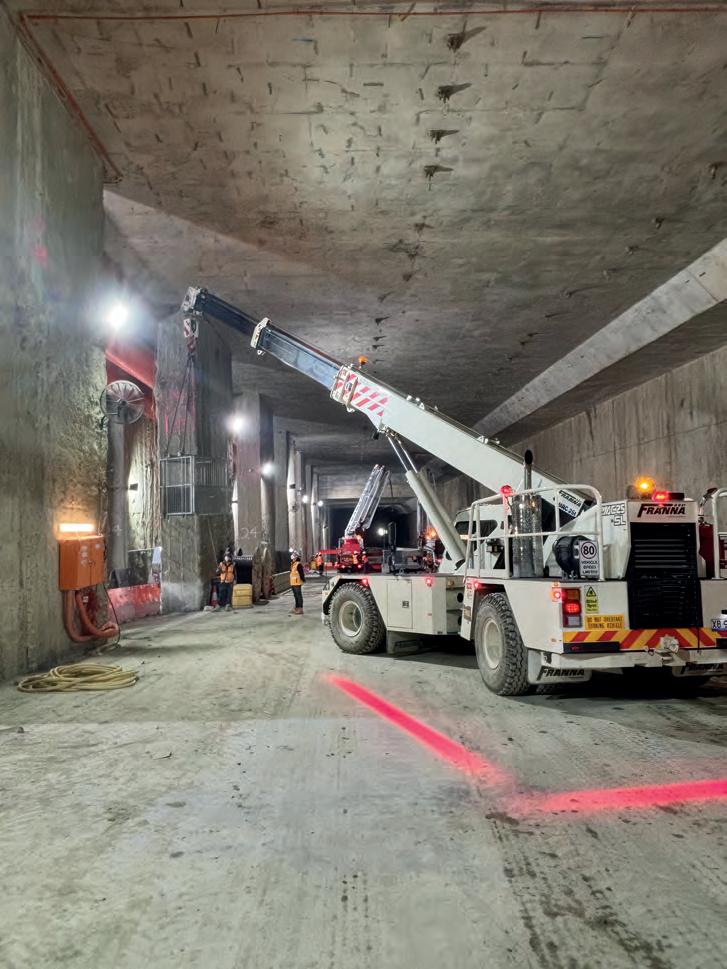
Howe, along with fitters Aaron and Sammy, for their responsiveness.
“The relationship with Terex in Melbourne is brilliant – 10 out of 10,” he said. “We’re coming up to two years with these cranes, and the backup service has been exceptional.”
He credited Service Manager Andrew
“Whether we take the machines to them for major servicing, or they come out to site, it’s never been a drama. We’ve never had to run the cranes overdue for service –it’s always been top of mind. And the Terex workshop crew including Leanne in admin, keep everything running smoothly.”
For Steve and Spark, the investment in both proven machines and innovative safety features has made a clear difference on a project of this scale.
The MAC25s have been configured with fire suppression for underground use.
“On any site, the danger is always there. But with the systems we’ve got now – radar, cameras, Protective Shield, GoUpSafely, and the Halo – we’ve added layers of protection that weren’t available a few years ago. That’s important when you’re working in tunnels and on a job of this size.”
As one of Australia’s largest road projects continues to take shape, Spark’s approach underlines a simple lesson: when safety and performance go hand in hand, everyone benefits.
FROM LIFTING TO HEAVY HAULAGE, TRT DELIVERS COMPLETE SOLUTIONS FOR FOUNDATION AND CONSTRUCTION PROJECTS.
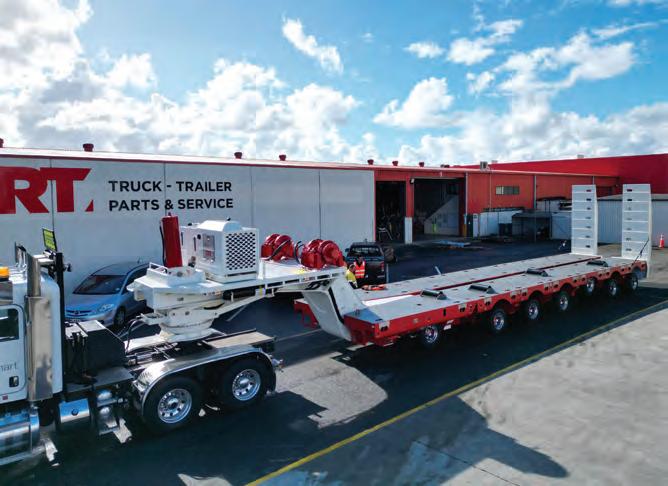
When Maritime Constructions needed reliability and versatility for remote projects, they turned to TRT.
What began with a single Kobelco crane has grown into a fleet of three, including the latest arrival, the powerhouse BMS800, engineered for high-duty cycle foundation work.
But we didn’t stop there. The relationship grew, and so did the solutions. Now, Maritime Constructions is also equipped with a TRT ESS (Electronic Steering System) Modular Platform Trailer, giving them ultimate flexibility for transporting heavy loads.
TRT has been backing industries since 1967, doing what others can’t and going where others won’t. Wherever business takes you, TRT has got you covered.
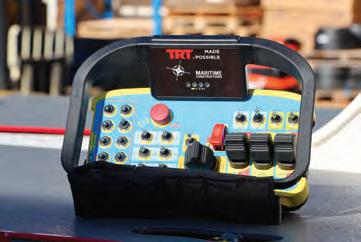
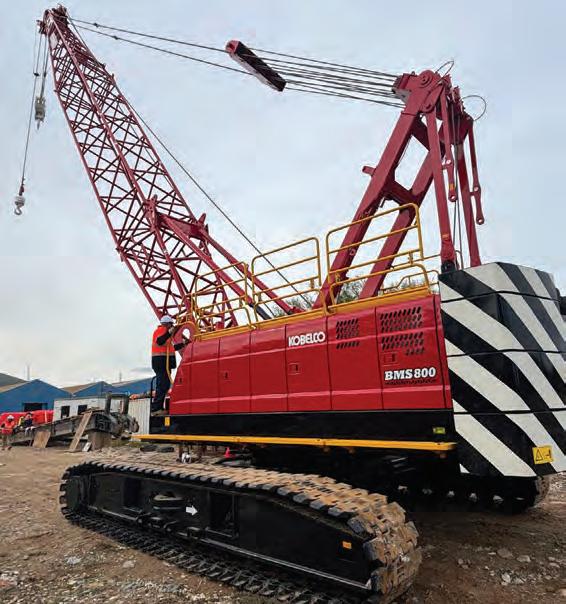
In crane hire, every decision comes down to cost, reliability, and efficiency. From fleet investments to the smallest rigging accessory, margins depend on making choices that last. Increasingly, those choices are moving away from timber and steel and toward engineered plastics – not only as a better product choice, but also as a financial necessity.
DOTMAR ENGINEERING PLASTICS HAS over 50 years of experience in the plastics industry. They’re showing crane operators how using engineered plastics for outrigger pads, wear parts, and sheaves can be a better economical decision and

Australia operations. Dotmar operates eight plastic machining technology centres throughout Australia and New Zealand to cater to growing demand.
That difference isn’t just about durability. Timber absorbs moisture,
Plastics, on the other hand, can be carried and positioned manually.
“The number one benefit is weight,” Ian said. “One person can lift it. You’re not dealing with timber that cracks or warps, or steel that needs a

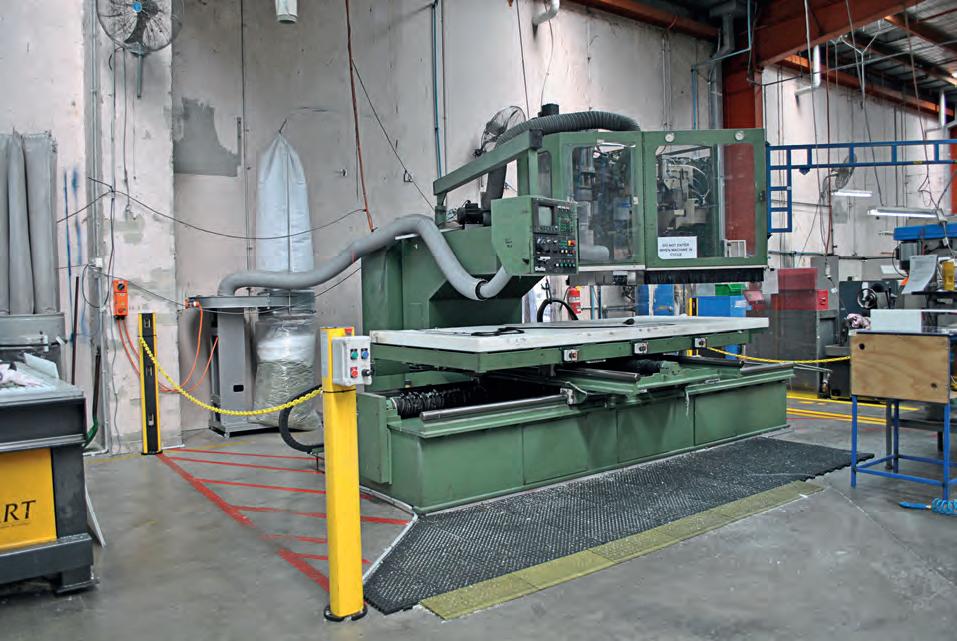
companies to measure the real loadbearing capacity of their timber.
Plastics solve that problem with uniform, tested material properties. For crane hire companies quoting jobs and managing liability, that predictability translates into reduced exposure to risk and fewer costly surprises.
Ian said, “Timber absorbs moisture, breaks down over time, and you don’t know its exact capacity. With engineered plastics, you know exactly what you’re dealing with.”
Lead times are another area where costs add up. In fast-moving crane hire, a delayed component can stall an entire project. Dotmar addresses this by maintaining stock and offering rapid machining capabilities at its eight sites across Australia and New Zealand.
“We’ve held up to 800 pads before and can do it again,” Ian said. “If I know someone’s serious, I’ll bring in stock. The key is building relationships with partners who want reliable supply.”
That readiness means operators avoid expensive downtime waiting for parts to
Dotmar’s UHMWPE outrigger pads last four times longer than timber, providing high strength, lower replacement costs.
arrive. For new businesses trying to build credibility or established fleets working to tight schedules, that responsiveness is an economic safeguard.
Outrigger pads are not glamorous purchases. Many operators see them as consumables, often lost or left behind on projects. In such a price-sensitive market, affordability is critical.
“These things do get left behind, so price is important,” Ian said. “But we can be very competitive on pricing, and the durability gives them longer life.”
By leveraging strong supplier relationships in Europe and manufacturing capabilities in Australia, Dotmar can offer pricing that competes directly with timber and steel –while outperforming both on total cost of ownership.
The economic case doesn’t stop at outrigger pads. Dotmar also produces wire rope sheaves from engineered plastics such as Nylatron GSM and Ertalon 6PLA.
These components not only weigh oneseventh as much as steel but also extend rope life two to six times. That translates directly into fewer rope changes, reduced downtime, and lower operating costs.
Wear pads like Nylatron 703XL bring similar savings by ensuring smooth boom operation without lubrication, cutting maintenance and extending service intervals.
Every avoided rope replacement, every hour saved in servicing, and every kilo of dead weight removed adds up to dollars back in the operator’s pocket.
Sustainability is often framed as a compliance cost, but in plastics it doubles as a savings driver. Dotmar incorporates regrind material into its pads, reducing environmental impact without compromising quality.
“It reduces the footprint of manufacture,” Ian said. “And the industry is starting to ask those questions more: what’s your sustainability story?”
For crane hire companies under pressure from clients to demonstrate greener practices, having a sustainability story is becoming essential. By choosing engineered plastics, they not only cut waste and extend product life but also strengthen their marketability in competitive tenders.
For new entrants into the crane hire industry, investing in plastics means building a fleet with lower overheads and fewer headaches. For established players, it’s about protecting margins and reducing the risk of downtime.
“These aren’t throwaway parts,” Ian said. “They’re engineered, tested, and built to work. What we really want is for people to know we’re here and ready.”
In a sector where profit margins can swing on downtime, replacements, or wasted labour, the argument for plastics is no longer just technical – it’s economic.
As crane companies across Australia weigh their options, engineered plastics are proving that the smarter choice is also the cheaper one.





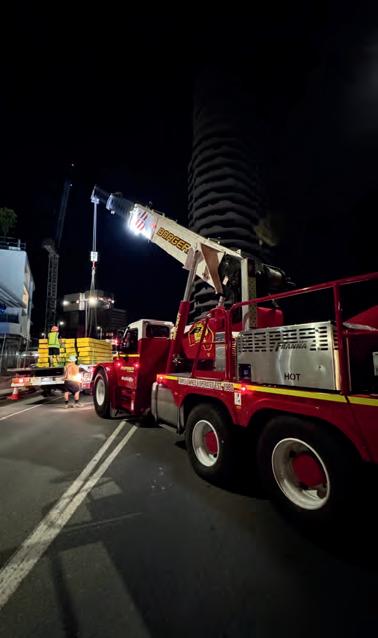
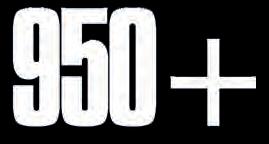
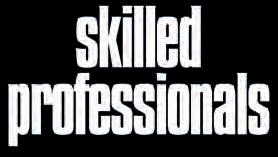
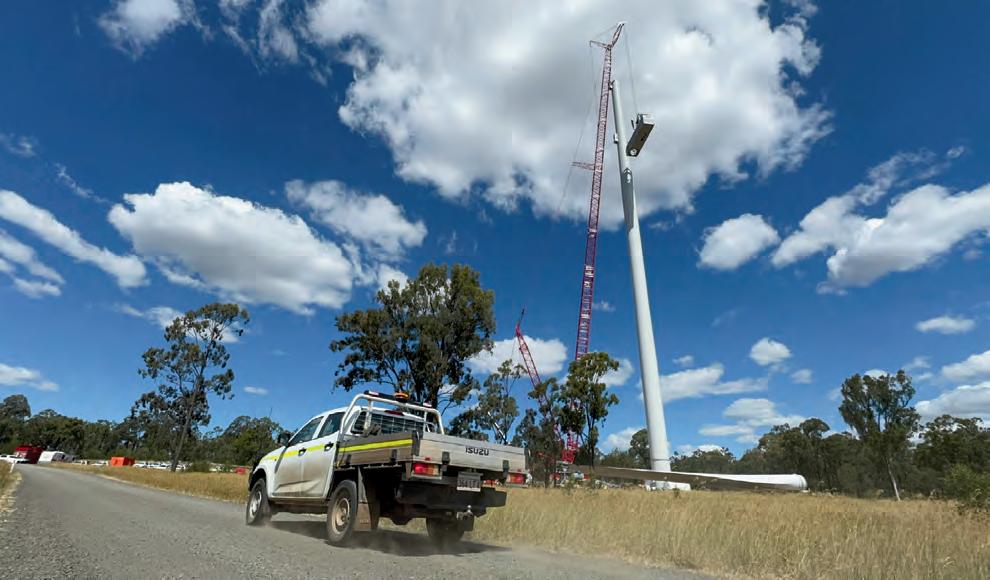
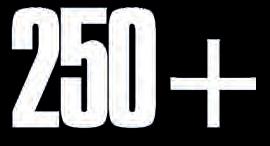


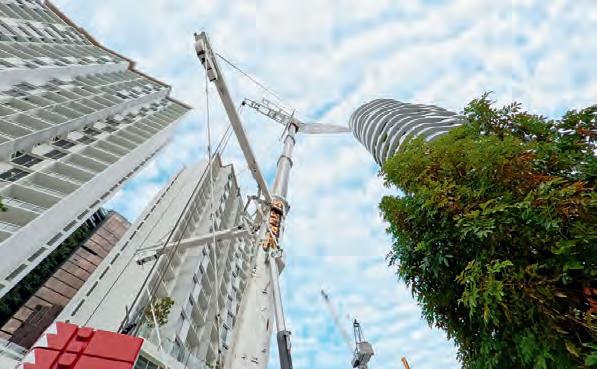

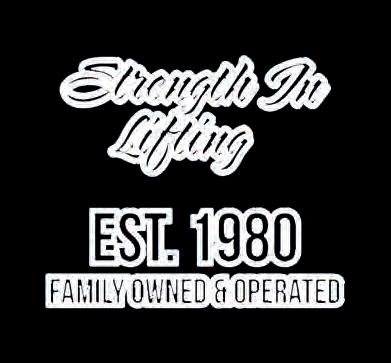
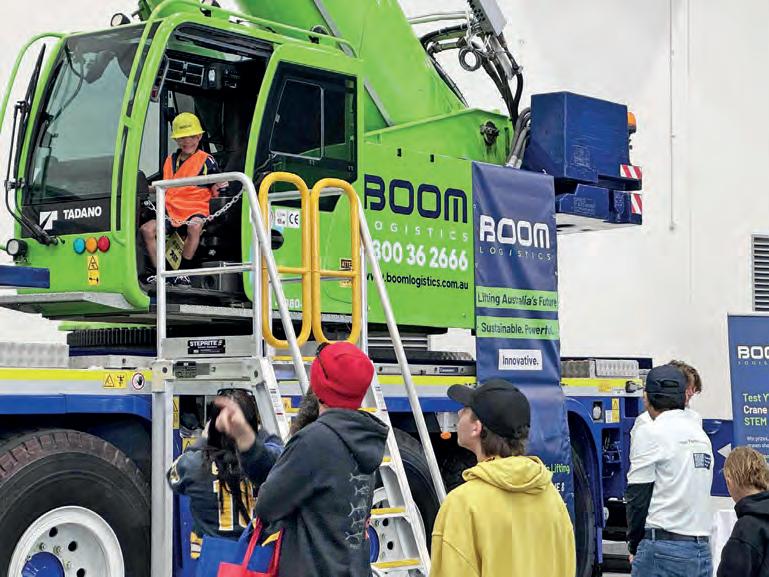
Attracting young people into the crane industry is one of the biggest challenges facing crane hire companies across Australia. With demand for skilled operators far outweighing supply, the industry can’t just rely on competing for the same limited pool of workers.
BOOM LOGISTICS IS ADDRESSING THIS issue head-on by engaging with students early before they’ve decided on their career paths. Regional Manager Dave Barfield and General Manager Rod Welfare explain how Boom Logistics is building the workforce of the future.
MEETING STUDENTS WHERE THEY ARE
Boom Logistics recently sent a crane and delegation to the Boddington Careers Expo in Western Australia which was attended by many schools in the south west region. The expo attracts different industries, providing students with opportunities to consider career paths after high school.
“We took a crane and a crew to the expo to promote the crane industry and the career opportunities at Boom Logistics. We took the opportunity to showcase interactive games for the Year 11 and 12
students, grant access to the crane to look around, and an opportunity to ask questions to our supervisor and operator who provided examples of how they progressed into the crane industry,” said Dave.
“We also attended the Resource Technology Showcase (RTS) in Perth earlier in August where younger students who are starting to make subject and career decisions were exposed to the industry and what is on offer.
“Our aim is to promote all aspects of the business starting with ‘ground up’ training for those with no experience. We demonstrate the different entrance pathways or ‘tickets’ that can be obtained and what they mean including forklift, RWB and riggers ticket and then moving onto a heavy rigid licence, and eventually a C1 crane ticket.”
Dave is currently working with a trainee who came through The Crane Industry Council of Australia (CICA) Traineeship Program.
“Our current trainee is a terrific young man who is eager to learn. We are moving him around the business, so he is exposed to different people and situations. Everyone is willing to share their knowledge due to the demand for more qualified operators.
“It’s in everyone’s interest, including the existing operators, to bring new people in and train them properly so they understand the importance of looking after the gear and how to conduct themselves safely in a high-risk industry. Back in the day you had to be a rigger for five years and have 10 years’ experience in the industry before you could sit on a crane seat. They were very different times,” said Dave.
Dave also acknowledged a common challenge: the disruption caused by companies recruiting within the industry as a substitute for developing new talent.
“Boom Logistics is committed to upskilling, which improves our retention.
As there are more jobs available than there is skilled labour, there are lots of opportunities out there creating a very competitive market. We continue to put our best foot forward and focus on our people by investing in them which is rewarded with loyalty and a determination to stay within the business,” said Dave.
Rod confirms the approach on the East Coast is similar to Western Australia with Boom Logistics remaining involved with career expos and CICA events encouraging young individuals to look at the opportunities available in the crane industry.
“Our focus is on school leavers but also the seven to 12 year olds, to get them interested in the industry early,” he said. “Our recruitment is based around offering traineeships such as the Cert III in Queensland. Our approach is not a ‘one-size-fits-all’ solution, we have
developed local insights and tailored our programs to suit different demographics in regional areas.
“In Central Queensland for instance, we have an Indigenous Mentorship Framework, which is successful in attracting and maintaining our indigenous engagement targets. Our Women in Leadership training provided by CICA has also been successful.
“The conversations the team have with young individuals at these employment expos highlight the pathways to a career with Boom Logistics. I’m a good example of this, having started with Boom as a Rigger back in 2006 and now I’m the East Coast General Manager,” said Rod.
Training and development instill a sense of loyalty in these youth and a continued commitment to upskilling encourages them to stay with the business long-term.
“It is important for us to demonstrate how pathways through training and
“Our approach is not a ‘one-size-fits-all’ solution, we have developed local insights and tailored our programs to suit different demographics in regional areas.”
development can help young individuals reach senior positions within the company. Boom Logistics boasts a national footprint, allowing our people to go anywhere they want.
“Local engagement is where we find good success. Our depot managers and regional managers go out to schools, attend local golf days, support local football teams and engage with people on their terms. This enables them to demonstrate what we do.
“We had a careers day at Whitehaven, in Blackwater, where children aged six through 10 years old came through the cranes and were very excited by what was being showcased,” said Rod.
Rod acknowledged that competing for workers remains a widespread challenge in the crane industry.
“Focusing purely on financial motivation is an industry-wide challenge. We’re taking a different approach by encouraging ongoing training, growing the talent base and keeping them with us long term,” he said.
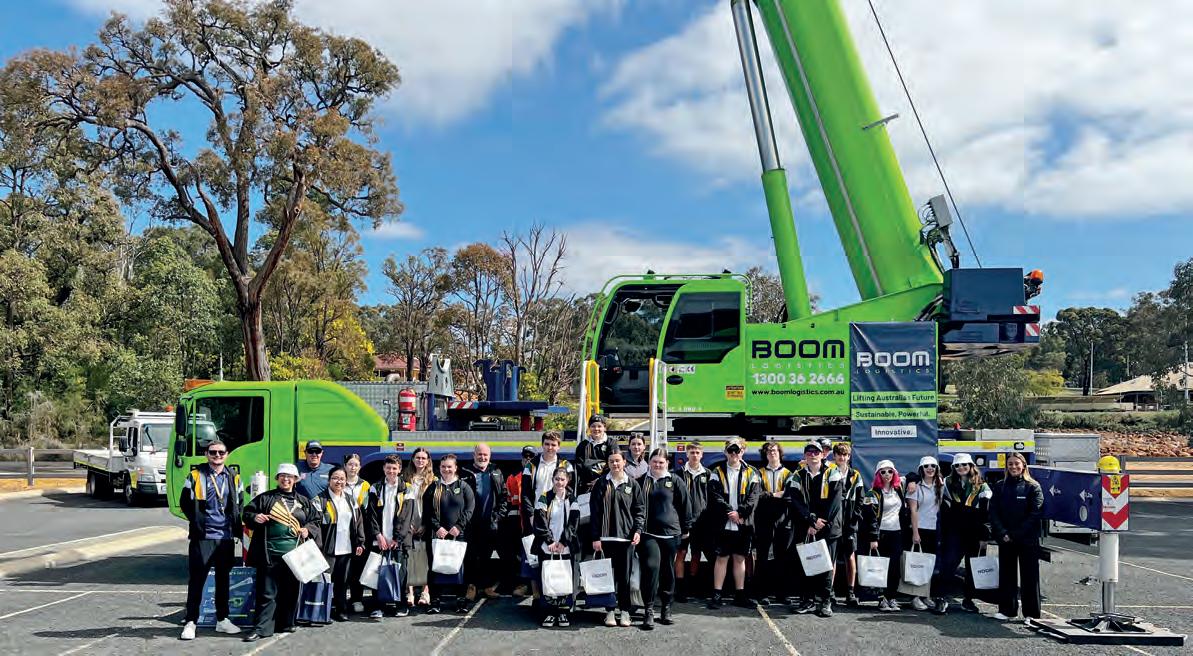
“We maintain a strong rate of retention to support this. We are a safe, diverse, and compliant workplace and people can make good financial and career progression at Boom Logistics.”
Boom Logistics is focused on school leavers as well as seven to 12 year olds, to get them interested in the industry early.
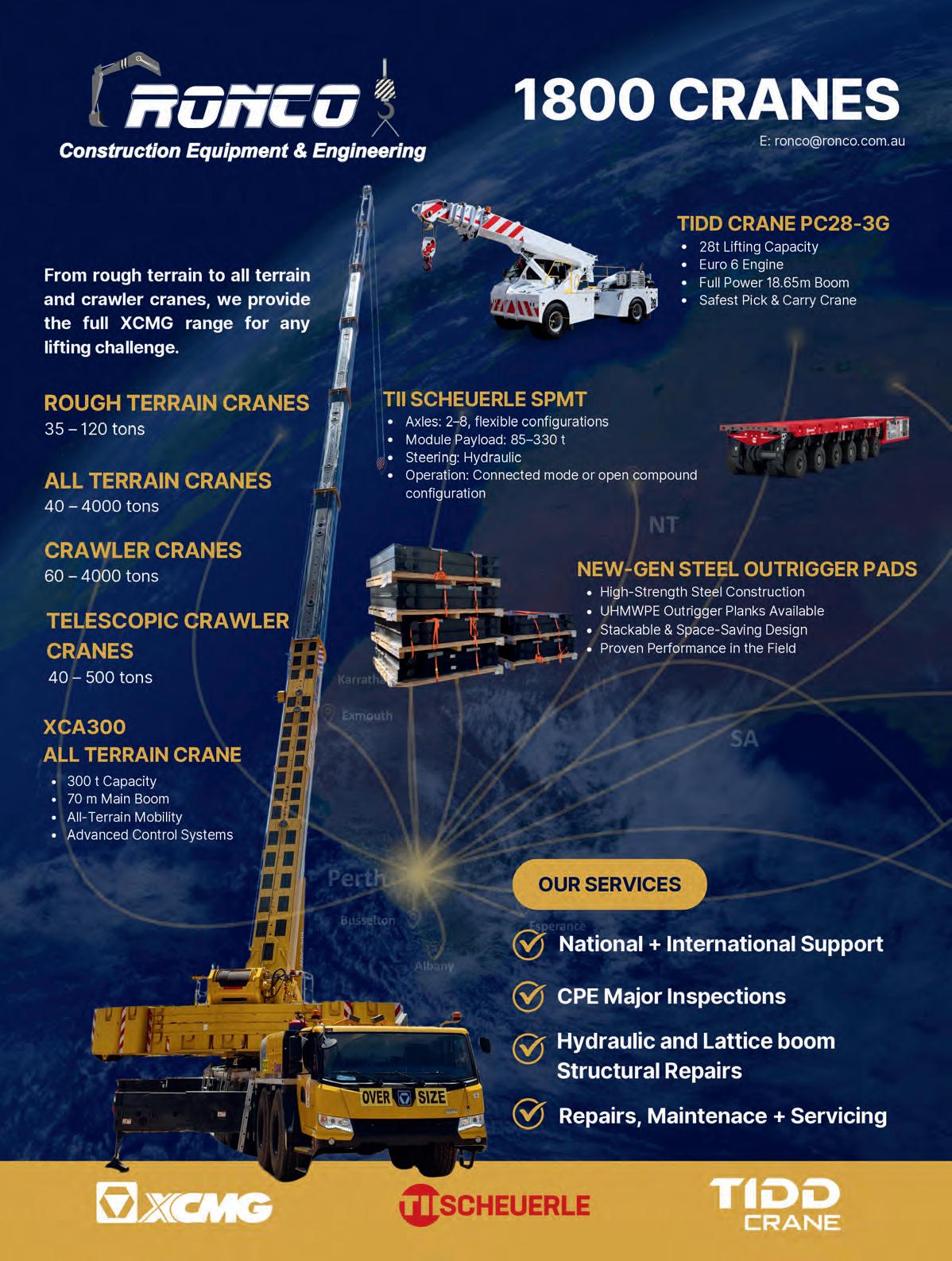

Group Chief Executive Officer, Stan Alexandropoulos reflects on the depth of UAA’s relationship with The Crane Industry Council of Australia (CICA).
How long have you been associated with CICA?
UAA’s association with CICA dates back more than two decades. Our partnership began with a shared purpose, to support the safe, sustainable, and progressive growth of the crane industry in Australia. Over this time, we’ve been proud to work alongside CICA to champion the interests of crane owners, operators, and the broader lifting community.
How has the relationship developed over this time?
What began as a sponsorship has evolved into a deeply collaborative relationship. Today, UAA is more than a supporter, we’re an active contributor to CICA’s initiatives, industry advocacy, and safety programs. The relationship has been built on trust, transparency, and a mutual commitment to delivering tangible benefits to the industry.
You have seen many industry issues over this time, how have you assisted CICA and its members to address these for a mutually beneficial outcome?
We’ve worked hand-in-hand with CICA on a range of challenges, from addressing safety concerns and regulatory change to helping operators manage evolving risk. Whether it’s providing claims insights to shape safety initiatives, sharing technical expertise, or supporting advocacy to government, our aim has always been to help CICA deliver solutions that benefit the industry as a whole while protecting the commercial and operational interests of our customers.
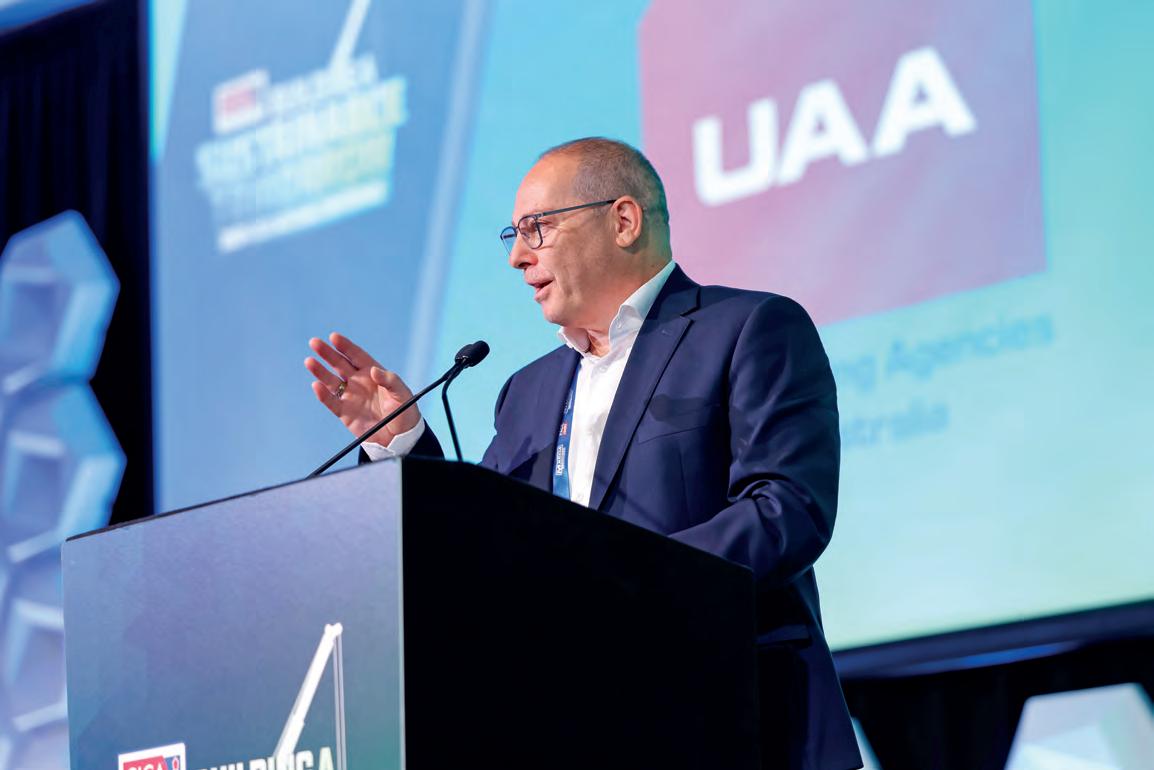
How many times have you been the platinum sponsor of the CICA conference and exhibition and why? What are the benefits for UAA?
I don’t really have those details but what I do know is that UAA has been a Platinum, Gold or Silver sponsor for the CICA Conference for every one of the 16 years that I have been at UAA, apart from the 2020 Covid year when it was cancelled. The history of major
sponsorship extends well beyond my time with the company and easily extends well over 20 years.
The benefits for UAA are many and flow both ways:
• D eepens industry credibility and brand alignment by reinforcing UAA’s position as experts and the trusted insurance partner for the industry
• It gives UAA and its customers direct
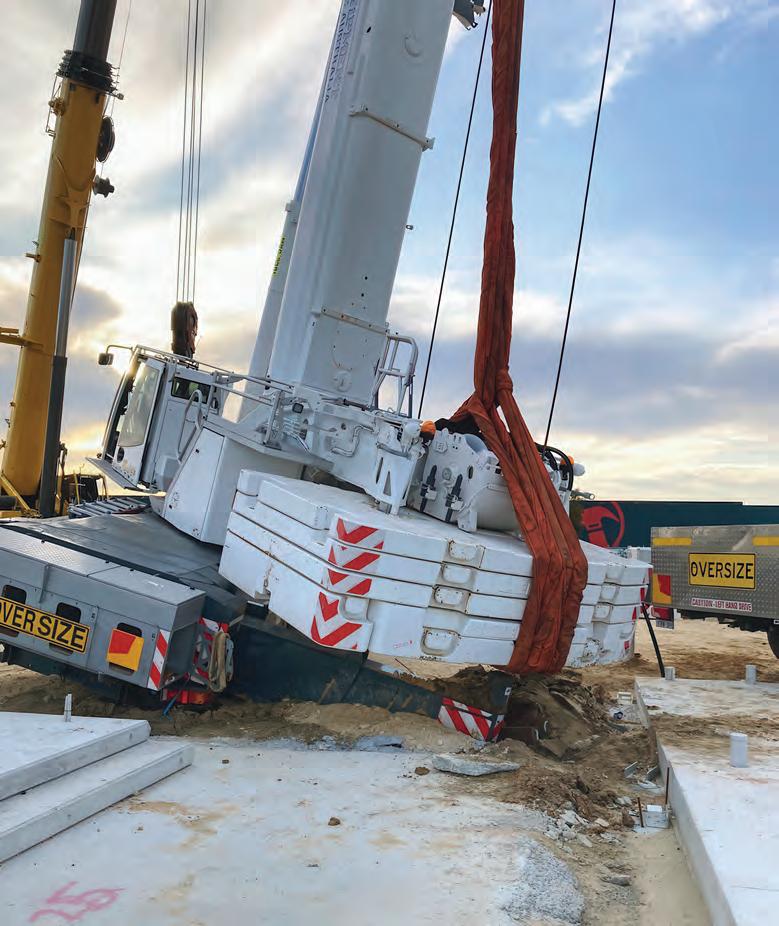
and decision makers fostering the development of strong and enduring personal relationships.
• Sharing industry insights and thought leadership, via emerging risks and trends, regulatory updates, supporting education and safety initiatives.
• Supporting and giving back to the industry that supports us. It demonstrates UAA’s genuine commitment to the long-term success and safety of the crane and construction sectors. UAA want to be seen as a partner not just a provider.
UAA has been instrumental in helping to resolve industry issues… How has UAA viewed its role during these processes and how does this reflect how invested UAA is in the industry?
We see our role as a partner, not just an insurer. When challenges arise, such as the debate around ‘walking fully dressed cranes’ around wind farms or the risks associated with operating pick and carry cranes, we’ve worked closely with CICA, regulators, and operators to find practical, workable solutions.
For example, our support in highlighting the operational complexities of pick and carry cranes
helped pave the way for CICA’s Articulated On Road Course, an important step in raising safety standards and operator competency. These initiatives demonstrate that our investment goes beyond financial sponsorship, it’s about contributing knowledge, advocating for safety, and helping to future-proof the industry.
At the same time we also need to ensure that insuring cranes and lifting equipment remains a sustainable prospect for our stakeholders and we do that by working with the industry to address pain points and concerning trends that we identify in our claims data before they become a major issue that adversely affects our crane insurance portfolio profitability. The fact that we have been insuring cranes for over 50 years says a lot about how effective this collaboration has been and the sustainability of our model.
INVESTMENT IN THE BUSINESS
UAA has always spoken about its ability to process claims quickly. How have you maintained these high levels of service? Speed of service comes from having the right people, processes, and technology in place. We’ve built a specialist claims team with deep industry knowledge, supported by streamlined workflows and decision-making authority close to the front line. This means we can assess, decide, and act quickly, which is critical when a customer’s business is impacted. Having people that understand our customers business and equipment is always going to drive a better result and improve customer confidence and experience.
What has been the recent focus to ensure the high levels of service is maintained into the future?
We’ve invested heavily in upgrading our claims systems, expanding our specialist teams, and embedding digital tools that enable faster information sharing with customers and brokers. Our focus has been on reducing touchpoints, eliminating bottlenecks, and ensuring every claim is handled
“Having people that understand our customers business and equipment is always going to drive a better result and improve customer confidence and experience.”
by people who understand the unique nature of crane and heavy equipment risks. We will continue to invest in systems and tools like artificial intelligence (AI) that can deliver efficiencies that improve our customer experience but we also need to be careful not to dilute or lose sight of the things that have made us successful in the first place, like the personal face to face relationships built throughout the industry and with our customers.
Where has the investment been in terms of systems and processes? How will customers benefit?
A focus on new policy and claims platforms. For customers, this
translates into faster turnaround times, greater transparency, and an overall smoother experience when they need us most.
How does UAA invest in its people and what are the benefits for customers?
Our people are our greatest asset. We invest in them through continuous professional development, industryspecific training, and providing opportunities to be involved in industry events like CICA. By equipping our team with technical expertise, market insights, and the confidence to make decisions, we ensure customers get advice and

StartSafe is comprehensive tool designed to streamline your crane operations, enhance safety, and ensure accountability.

service that is both informed and responsive.
LOOKING AHEAD: How invested is UAA in the future?
H ow secure is UAA’s support for the crane sector into the future?
Our commitment to the crane industry is unwavering. It’s a sector that is part of UAA’s DNA, and our future plans continue to place cranes and lifting at the centre of our product development, service model, and community engagement.
The crane sector is evolving, with advances in technology, safety systems, and regulatory requirements. UAA is invested, financially, strategically, and culturally, in supporting this evolution, ensuring operators, owners, and the broader industry can thrive with confidence. Cranes and lifting is our heritage and will always hold a special place in our history, story and future.













Machine specific checklists are in line with the CraneSafe program.
StartSafe streamlines the process for collecting pre-start information, with instant data retention to a central location for the crane owner to access.
Photos tell the story.
When a faulty item is recorded by the operator, the maintenance team is notified of the issue by email, which includes photo evidence of the fault. This also assists with gathering major inspection data.












Across Australia’s resource, infrastructure, marine, and industrial sectors, lifting and material handling challenges are rarely straightforward. MCT Equipment is committed to rethinking how these jobs get done, pushing the limits of the alternative lifting landscape in Australia. By introducing smarter, safer, and more versatile solutions, it is helping crews work with greater precision, efficiency, and confidence wherever heavy lifting is required.
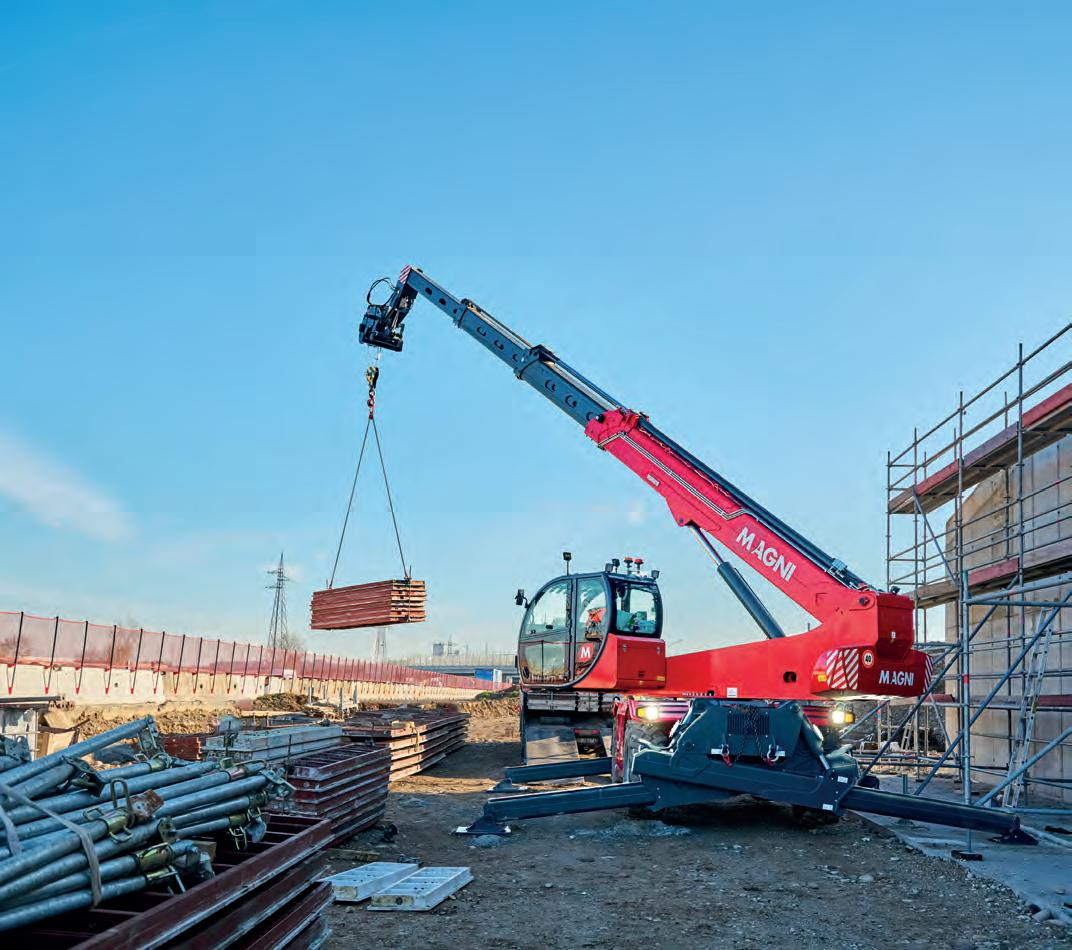
Rotating telehandlers take versatility to the next level with full 360 degree rotation, a patented load LMI system, and the ability to handle multiple attachments, from forks, hooks, winches to baskets, while managing payloads of five tonne to 13 tonne.
MAGNI TELEHANDLERS IS ONE OF MCT Equipment’s lifting solutions, offering a range tailored to different operational needs. Fixed boom models provide stable and reliable lifting of three to seven tonnes, with advanced interactive load charts that make even complex lifts predictable and safe.
Rotating telehandlers take versatility to the next level with full 360 degree rotation, a patented loam moment indicator (LMI) system, and the ability to handle multiple attachments, from forks, hooks, winches to baskets, while managing payloads of five to 13 tonne.
For the heaviest lifting tasks, Magni’s heavy-duty telehandlers deliver up to 50 tonne of payload, maintaining high stability and manoeuvrability even under extreme conditions such as mining, large-scale construction, and manufacturing. Each machine is engineered to combine power, precision, and adaptability, and now the newest addition to the Magni range, the rough-terrain forklifts, bring 2WD/4WD traction, oil-immersed brakes, high-visibility cabs, and up to five-tonne capacity, all backed by a two-year extended warranty for ultimate site productivity.
Alongside this, the range of JMG electric pick-and-carry cranes offer a greener, low-noise approach to lifting. Available in capacities from 0.9 to 70 tonne, they provide up to eight hours
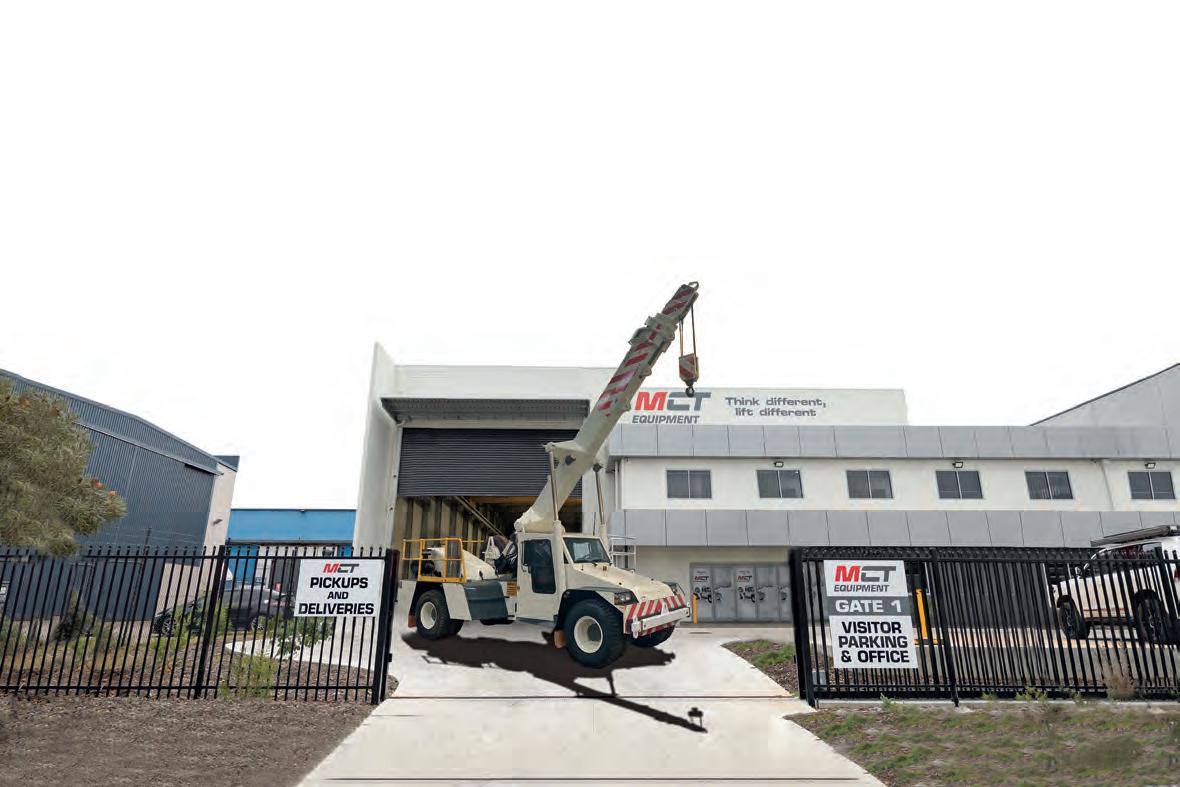
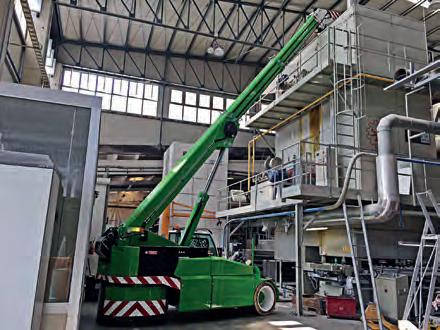
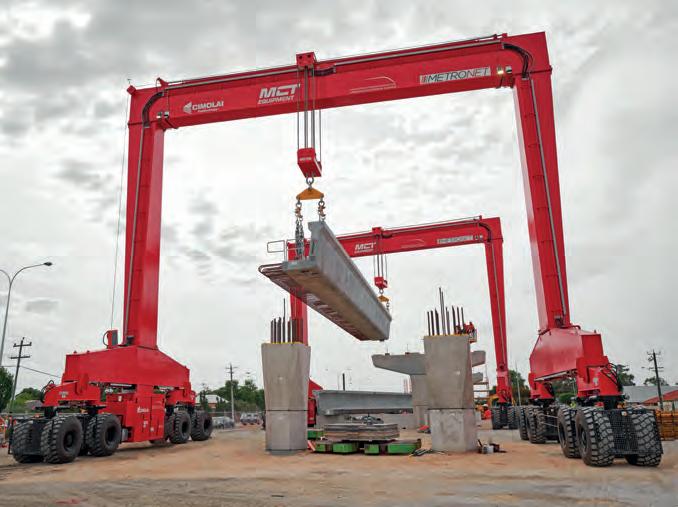
of operation with zero emissions. Their compact design and rapid setup reduce operating costs and boost efficiency, making them suitable for sites where sustainability matters, while keeping operator safety front of mind and offering versatility across multiple applications.
Partnering with Cimolai Technologies adds the ability to custom design and build material handling solutions with customers
from project conception to find the ideal way to lift and shift with no limits.
Supporting this is MCT Equipment’s large, fully-equipped workshop, capable of handling repairs, servicing, and maintenance to keep machines performing at their best. The company also maintains a wide selection of used cranes in all sizes, providing practical options for projects of any scale.
“From day one, our goal has been to shape the alternate lifting game,” said
Anthony Grosser, Managing Director of MCT Equipment. “Four years on, we remain committed to pushing the boundaries and challenging the lifting industry.”
By combining reliable machines, maintenance support, and flexible options for used equipment, MCT Equipment offers a comprehensive approach to lifting, one that prioritises safety, performance, and results without compromise.
Established in early 2025, Tonnage designs and manufactures specialised heavy lift equipment for the mining construction and offshore industries.
TONNAGE DESIGNS, ENGINEERS AND manufactures a range of equipment including Industrial Stools with a safe working load (SWL) of up to 500 tonne and Transport Beams. These products can be hired from Tonnage facilities in Perth, Karratha, Sydney and Brisbane.
Tonnage is a collaboration between three leading industry experts, Josh John, National Director for Complete Crane Solutions, Jason Pivac, General Manager V&D Engineering and Didier Smets, Technical Solutions expert. Didier provides the background to the organisation.
“Josh and I worked together at Sarens and we met again when he had set up Complete Crane Solutions. We were discussing the shortcomings we could see in the heavy lifting and transport industry and discussed some of the gaps we could see in
products servicing these industries.
“Earlier in the year Josh advised he had created the Tonnage business which now involves the three of us, Josh, myself and Jason Pivac from V&D Engineering. I’m more involved in the heavy lifting products which currently include Industrial Stools with SWL up to 500 tonne and Transport Beams. Jason runs the design, engineering and manufacture of the products. With all things considered, the business is off to a solid start with the products being well received by several customers,” said Didier.
Didier also worked for Mammoet where he specialised in gantry cranes. He is bringing this expertise to Complete Crane Solutions.
“I finished working with Mammoet two months ago but in August I was back on
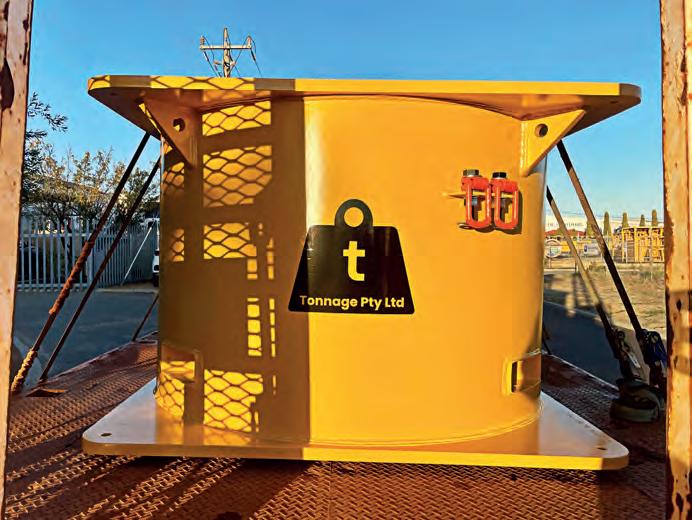
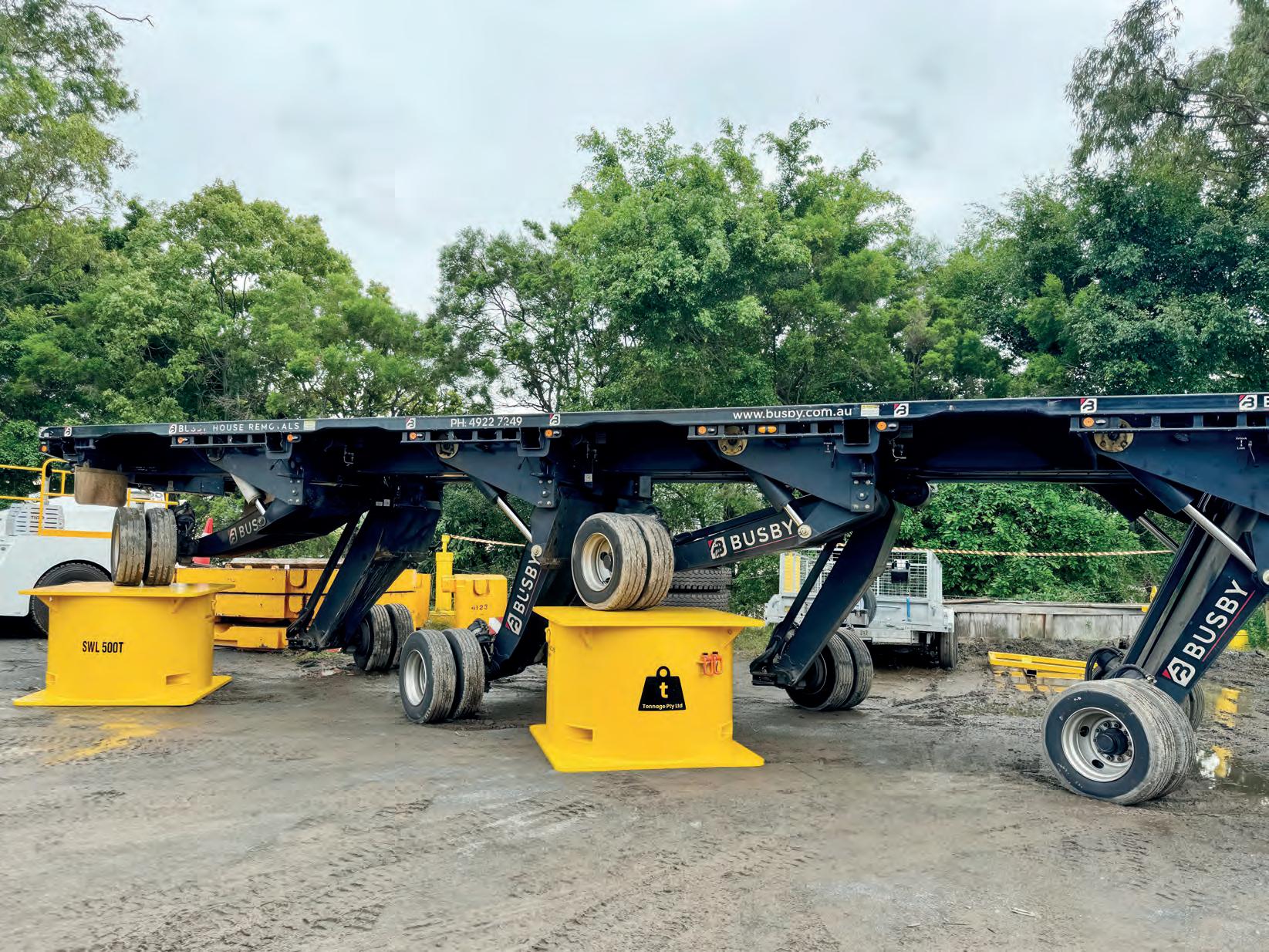
a job site for them. There was breakdown on a mine site and they needed a gantry supervisor urgently to assist the mine site with the repairs of their equipment. As the trainer and assessor within Mammoet I have the required level of gantry crane experience.
“Josh and I see the servicing of gantry cranes as a significant opportunity for the business. Recently, we had our first gantry crane from Sarens. We stripped it down, conducted the 10 yearly overhaul and CraneSafe inspection and then packed it up again ready for transport.
“Basically, we will be leveraging our experience across different lifting equipment with a strong focus on service and support in mind. As the business continues to grow, we will be bringing more people on board that I can help train and impart my experience and continue this depth of knowledge within the business,” said Didier.
VDE perform a wide variety of engineering works from simple fabrications through to complex site installations, maintenance and project works. VDE

“We’ve got a number of the Industrial Stools in workshop applications, particularly in the mining sector where large mining excavators and trucks are being dismantled for servicing and maintenance and the heavy componentry is temporarily being stored on the stools.”
is focused on understanding the needs of clients so the optimum solution can be engineered. This is achieved through considerable technical skills and experience gained through years of delivering quality projects. VDE self-executes all jobs, delivering projects safely, efficiently, and to the highest possible standards. Jason and his team relish the challenge of technically complex projects and blend engineering disciplines to deliver the clients’ aspirations on time and on budget. VDE specialises in mobilising and working in remote and challenging locations.
Didier goes on to the discuss the quality of the Tonnage range and the applications it is designed for.
“The Tonnage range is engineered and
manufactured by Jason’s business V&D Engineering (VDE). He’s manufacturing the Industrial Stools for Tonnage, and he also has the engineering knowledge to certify them up to 500 tonne capacity,” he said.
The Industrial Stools are ideal for applications in heavy transport for the storage or temporary storage of heavy parts, including trailers, as well as applications where mining equipment is being serviced, large construction equipment and also in the crane industry. Basically, all applications where equipment needs to be ‘stooled off’ and maintenance conducted. The stools are often only required for a short duration which is a major reason why Tonnage has a rental model.
“We’ve got a number of the Industrial Stools in workshop applications, particularly in the mining sector where large mining excavators and trucks are being dismantled for servicing and maintenance and the heavy componentry is temporarily being stored on the stools. Storing them this way keeps them off the ground and dust free,” said Didier.
Although early days, the Tonnage business is off to a great start with plenty of demand for the products and services offered.
“To be honest, the business has got off to a better start than I was expecting, I thought it would be a slow process but there has been a lot of demand for the stools and beams and there have been a number of enquiries about gantry crane servicing and maintenance,” said Didier.
“We are currently looking at a couple of gantry crane projects which I obviously specialise in and we have made presentations to clients. We are waiting for the clients confirmation to proceed on these so we’ll keep our fingers crossed.”
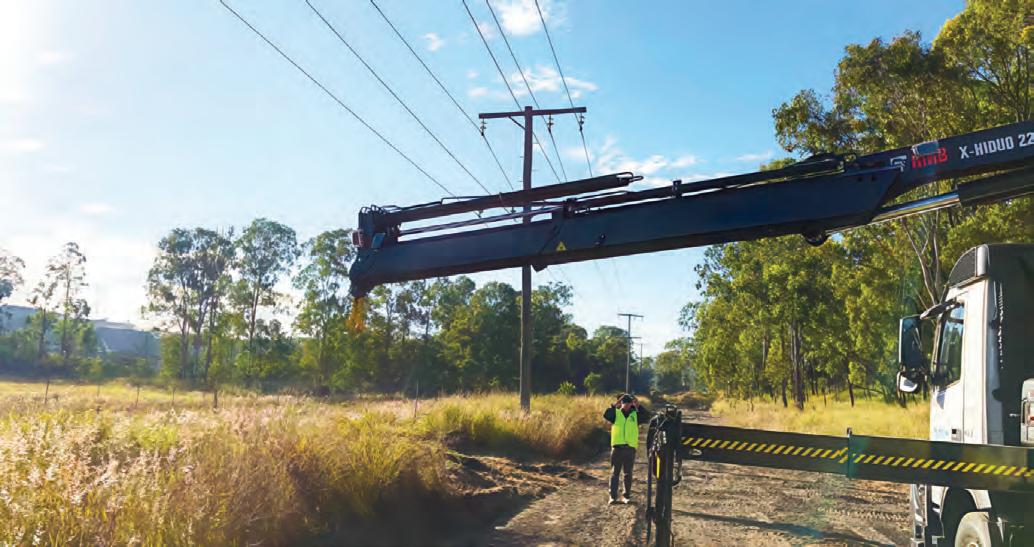
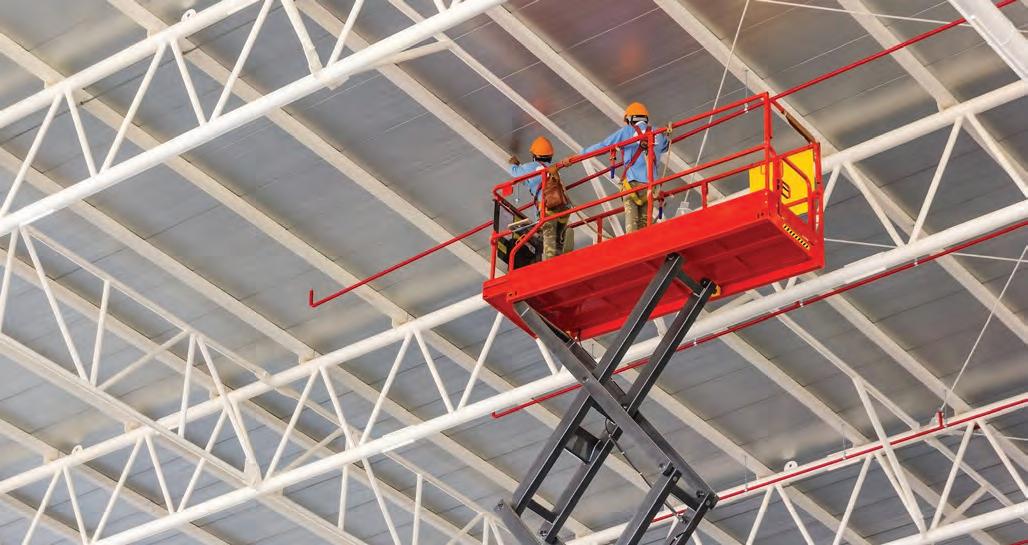

With a commitment to stock availability and ensuring the correct tyres are fitted for the right applications, Bridgestone is a Tier One Tyre supplier to the crane industry. Steve Bekker, Regional Sales Manager, East, for Bridgestone Mining Solutions Australia explains the importance of fitting and maintaining correct cranes tyres.
SPEED AND LOAD RATING ARE KEY TO getting the right tyre for the right application.
“Bridgestone is a premium product supported by an extensive network of after sales service outlets and agents which is working with customers who understand the value of working with a Tier One Tyre. Fitting the correct tyre for the right application is obviously important
“We’re supplying the 385/95R25 which is ideally suited for the smaller all terrains and some of the larger Franna pick and carry cranes. The 445/95R25 and the 525/80R25 are more available than ever as we have been bringing in reasonably large quantities and we are securing additional business based on the fact that we have stock on hand,” said Steve.
The 525/80R25 is the largest available mobile crane tyre from Bridgestone and this is offered in two speed load ratings, the 177 E and the 176 F. The 445/95R25,
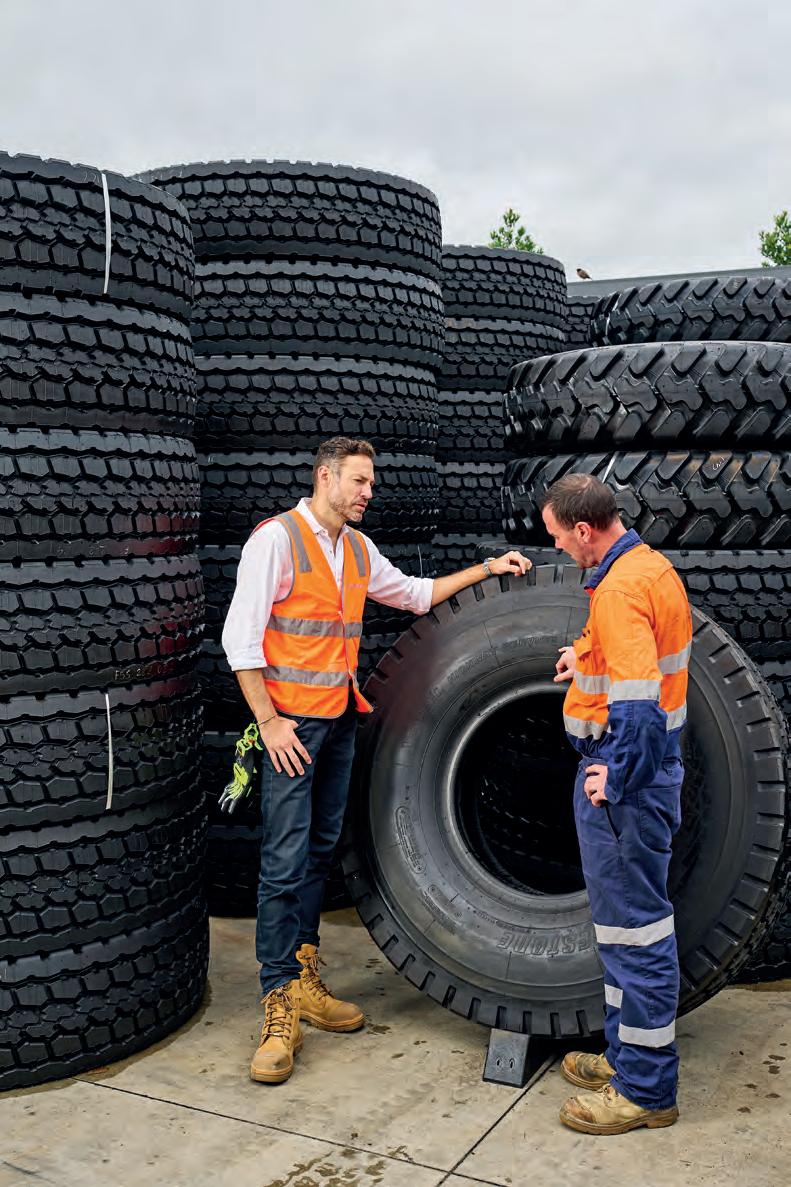
which is a smaller tyre is also available in two speed ratings. Bridgestone is currently examining the possibility of offering the G rated, 90km/h version of this tyre giving customers the ability to run at higher average speeds for a longer period of time.
Bridgestone operates 14 Mining Solution Centres around the country and each has the ability to supply and fit mobile crane tyres. Bridgestone also has strategic partnership agreements with tyre dealers and distributors around the country.
Working with and supplying tyres to Tier One Crane manufacturers is a priority said Steve.
“If a customer buys a crane featuring Bridgestone tyres it provides them with an opportunity to understand how the tyre performs, and when it comes to replacing them they are more likely to choose Bridgestone. We will be working with Liebherr and other major original equipment manufacturers (OEM) selling the concept of a Tier One Tyre not just as a better product, but also as a sales tool for the OEM.
“It’s not just a matter of making the machines look good, it’s also having the correct tyre for the best performance in the right application.
“This may well mean supporting the training of OEM sales, servicing and supply teams to ensure they are making the right tyre recommendations to their customers,” said Steve.
Bridgestone’s approach to compliance and roadability is complicated by each state operating different regulations around weight carrying capacity, footprint on the ground, navigating bridges and other infrastructure etc. Branches and partners in each state understand the local rules and regulations and provide Bridgestone with this information to ensure the appropriate tyres are fitted. It is a strategy that has worked for Liebherr, ensuring machines come with the right tyres.
Working with a Tier One Tyre supplier like Bridgestone will help reduce the total cost of ownership over the life of the tyre. Supplying tyres where there is immediate demand is also a key focus for Bridgestone.
“We focus on the total cost of ownership, and we have measures and systems in place to ensure the customer understands what is required for the tyre to perform at its best for its entire life. This includes reporting on the wear of the tyre as well as regular inspections and pressure maintenance,” Steve said.
“One of the biggest challenges is the remote nature of customer’s sites. If a tyre fails, they need the machine back operating as soon as possible and will
consider putting any tyre on to get up and running again. We are working with an increasing number of partners and service providers to help supply our products and offer fitting services in a timely manner. We want to support end users by providing them spares wherever they are operating.”
Mobile crane and Off The Road (OTR), including mining and heavy industrial tyres, fit into the same category. Important wear issues for these tyres relate to weight, speed and pressure and crane operators need to understand that running at the correct pressure is critical. Too low, will mean irregular wear of the shoulders,
having ‘wheel nut indicators’ fitted to make sure any loosening of the nuts is visible immediately,” said Steve.
“The next step will be to show them how to examine the tread to see if there’s any scuffing or irregular wear, to see if there is any damage to the sidewall, or cuts that are more than superficial. We are focused on total cost of ownership and after sales support.
“We have a program called Toolbox, which is a tyre monitoring system which enables us to input data, serial numbers, tread depths and pressures and run reports by machine or by tyre. These reports can
“Working with a Tier One Tyre supplier like Bridgestone will help reduce the total cost of ownership over the life of the tyre.”
increased pressure on certain components of the tyre can increase temperature reducing its life, or increase the total cost of ownership. Overpressure will see the centre of the tyre wear quicker. Therefore, ensuring regular pressure checks and maintenance is vital.
“Ideally customers are conducting daily visual checks on their tyres. We’re supporting a customer in the Hunter Valley by retraining their operators to conduct prestart checks on both the tyres and wheels and they are considering
confirm the cost per millimetre, cost per hour – however the end user wants to run that data for the life of the tyre.
“We can compare this against historical data to highlight any issues or concerns before they become critical or if customers want to trial new products, we can compare different patterns and specifications.
“Tyre management is important and increasingly technical, as a Tier One Tyre supplier, Bridgestone is at the forefront of these developments.”
Availability of stock is a major focus for Bridgestone.
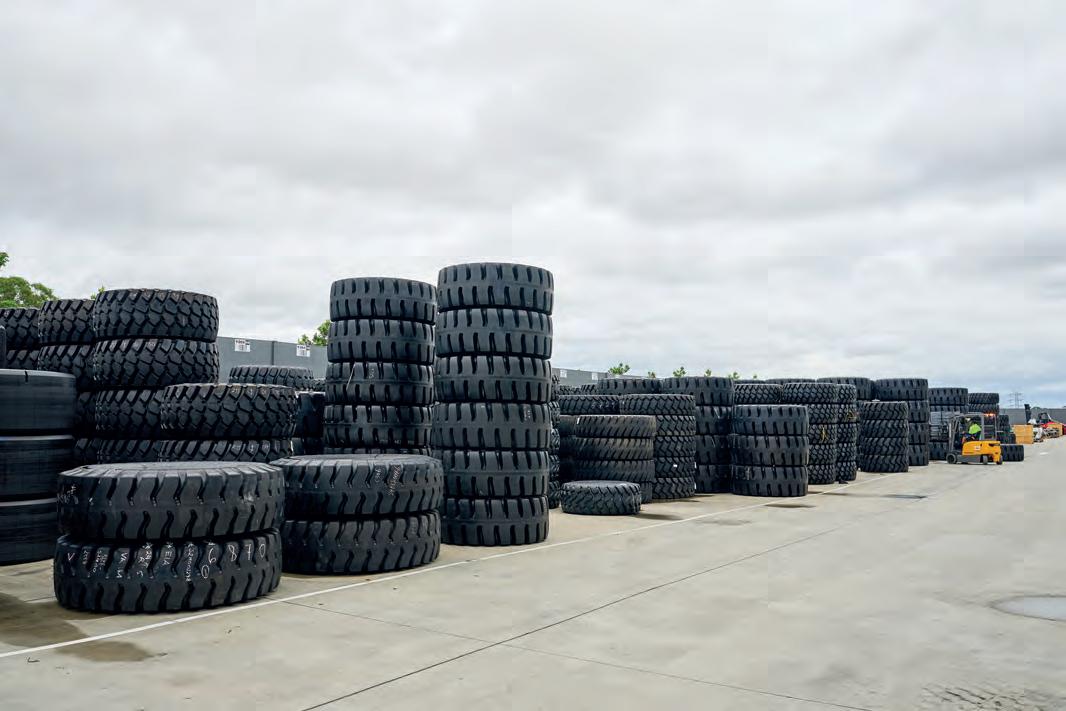










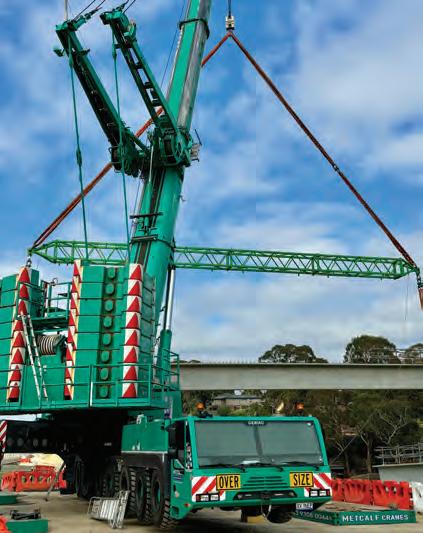
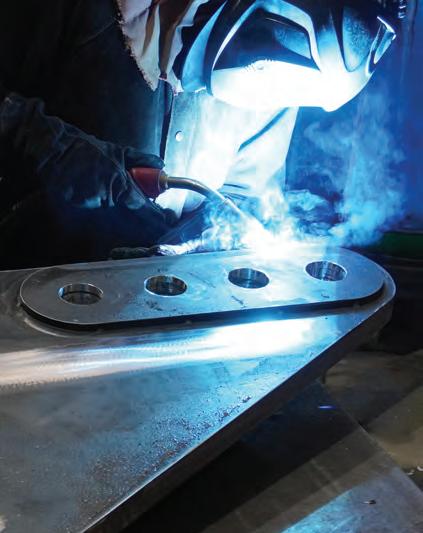

Luke Davis joined Ronco, the Western Australia, South Australia and Northern Territory dealer for XCMG Cranes, in August. Mark Turner has been with the organisation for a number of years. Both provide insights into the Ronco organisation.
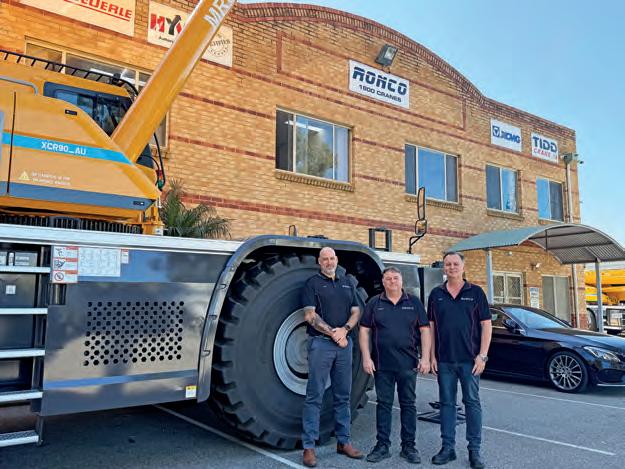
Luke’s first few weeks have been an eyeopening experience. “Coming into the role, I was curious to see how the XCMG product would stack up in a competitive crane market. Now, four weeks in, I can confidently say I’ve been pleasantly surprised – especially by the build quality, technology, and thoughtful design across the crane range,” he said.
XCMG’s crane line-up is impressively broad, covering all-terrains, crawlers, tele-crawlers, rough terrains, and truck mount cranes, with lifting capacities ranging from 30 tonnes all the way up to a massive 4000 tonnes. This versatility means there’s a solution to meet almost any lifting requirement, from urban construction projects to large-scale industrial applications.
One of the standout features is the 360-degree bird’s eye camera system on the all-terrain models, complete
with pedestrian identification. It works seamlessly and adds a valuable layer of safety that operators genuinely appreciate on busy worksites. The operating system itself is another highlight – intuitive and easy to navigate, with a large, crisp screen that displays all key functions clearly and efficiently.
From a mechanical standpoint, XCMG’s use of trusted European components – engines, pumps, and running gear – ensures that servicing and maintenance are straightforward and familiar for technicians. This clever integration of quality parts makes the learning curve smoother and supports long-term reliability in the field.
Another significant benefit is peace of mind – every crane in the XCMG range comes backed by a standard twoyear manufacturer’s warranty. That commitment to aftersales support speaks volumes about the company’s confidence in its product and provides added assurance to owners and operators.
“Operationally, the cranes deliver on all fronts. They’re smooth, quiet, and comfortable – three things you want to hear from any operator. The all-terrain carrier cabs are well laid out, offering plenty of space and comfort. The driver’s area is bright, modern, and functional, with a digital dash and entertainment system right where you need them.
“When it comes to delivery timelines, XCMG offers excellent lead times compared to industry standards. For new crane orders under 300 tonnes, there is a standard 60-day ex-works build time, while cranes over 300 tonnes are typically completed within 90 days ex-works. At Ronco, we work closely with customers to ensure these timelines are met and that our clients are waiting as little time as possible for their new assets,” Luke said.
“In short, XCMG has built a product that punches well above its weight, combining smart engineering, userfriendly tech, and premium components. I’m genuinely excited about what lies
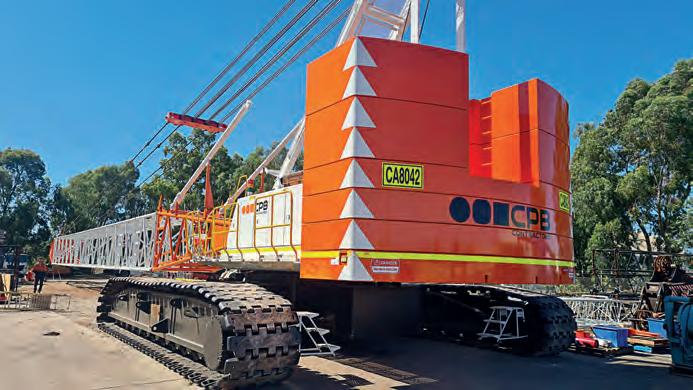
ahead here at Ronco, and even more so about helping introduce more people to this impressive range of cranes that are priced to make your accountant smile.”
Ronco’s 14,000 square metre facility in Maddington, Western Australia is ideal for the maintenance of all sizes of cranes.
“Currently we have three crawler cranes assembled and stood up (with a fourth on the way in) three roughies, three scrap handlers, a tele crawler, two all terrains, a spider crane, a skip bin trailer, and roughly a dozen pick and carry cranes in the yard,” said Mark.
While Ronco has been in operation for nearly 30 years, Major Inspections have only been a large part of the business for the past 15 years. Recently we carried out a review and realised that over the past 12 years more than 220 had been completed for this period. Ronco has also received five Gold data plates from the Cranes Industry Council of Australia (CICA) for major inspections.
“It has been an interesting challenge for the team with all brands and types of cranes undergoing the Major Inspection process. While the variety of cranes we work on can, in itself, be a challenge, the team is always eager to learn a new product and help support our customers by turning their equipment around as efficiently as we can.
“As an example, we have in a Tadano RT, a Yardboss carry deck, a Ronco pick and carry, and a Tadano VLC all in for major inspections, plus three lattice boom sections in for lacing replacements, as well as the usual variety of repairs, servicing and maintenance.
“As we complete almost all repairs in-house, including structural repairs to booms and most cylinder rebuilds, it has allowed our team to learn and transfer new skillsets as we carry out these critical repairs under the guidance of an engineers repair plan.
“Dent repairs to telescopic booms are always an interesting process for the uninitiated. With our supervising engineer being Perth based it is quite convenient for him to visit on a regular basis to review our

teams findings and discuss repair options,” said Mark.
“We also work closely with our painter to make sure cranes are painted correctly and not sandblasted in sensitive areas, it’s always pleasing when a client has the time and budget to refinish their crane so it can return to work looking like new.”
Ronco’s field service techs enjoy getting out of the workshop and out into the north west and goldfields areas for mobile servicing and repairs.
“While we are the Western Australia dealer for XCMG and TIDD cranes, we are also the Australian dealer for Scheuerle heavy transport products and look forward to catching up with these specialised units wherever we can in the country.
“These hard-working units need regular check overs to ensure they are ready for that next big lift, no one wants a blown hose when you have a submarine as the load! Our service team travels Australia-wide with recent visits to both Brisbane and Sydney to support clients in need, as well as trips through out Western Australia.
“Through our parts department we also supply steel outrigger pads and UHMWPE planks, as well as the revolutionary GoUpSafely safety device designed to protect your team and assets from powerline strikes.”
For further information on products and services contact 1800CRANES or ronco@ronco.com.au

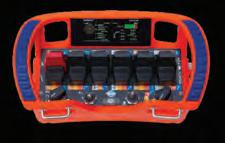
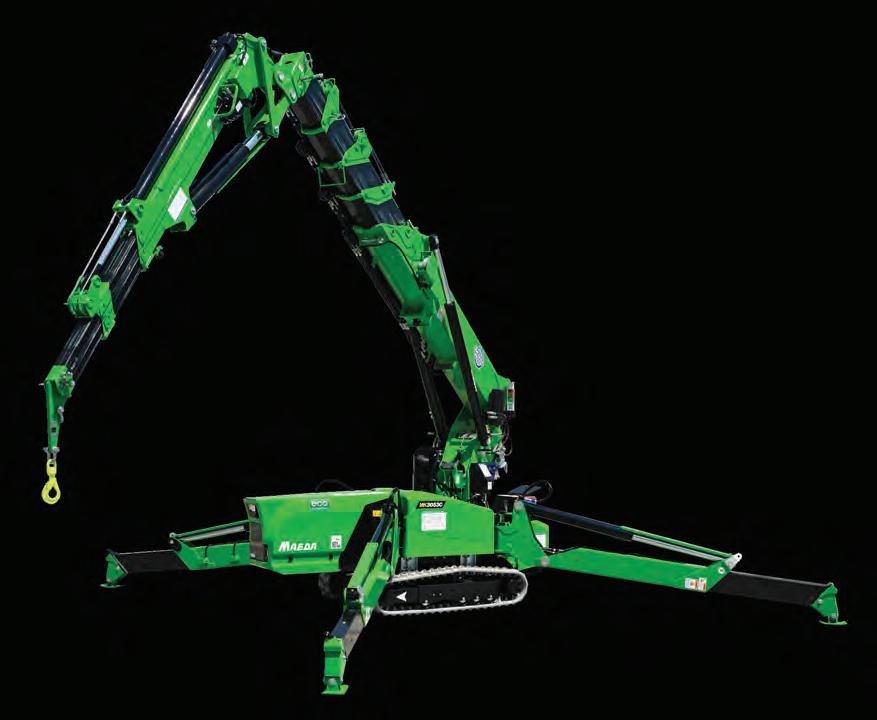
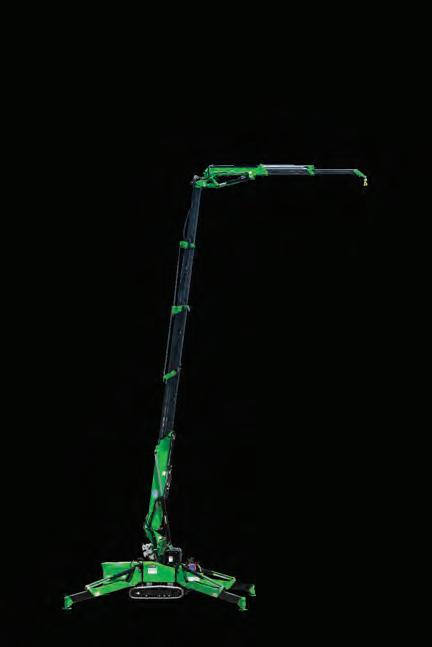
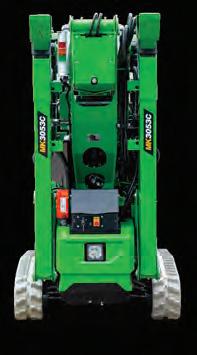
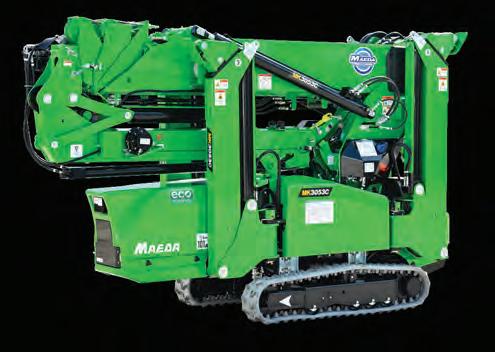
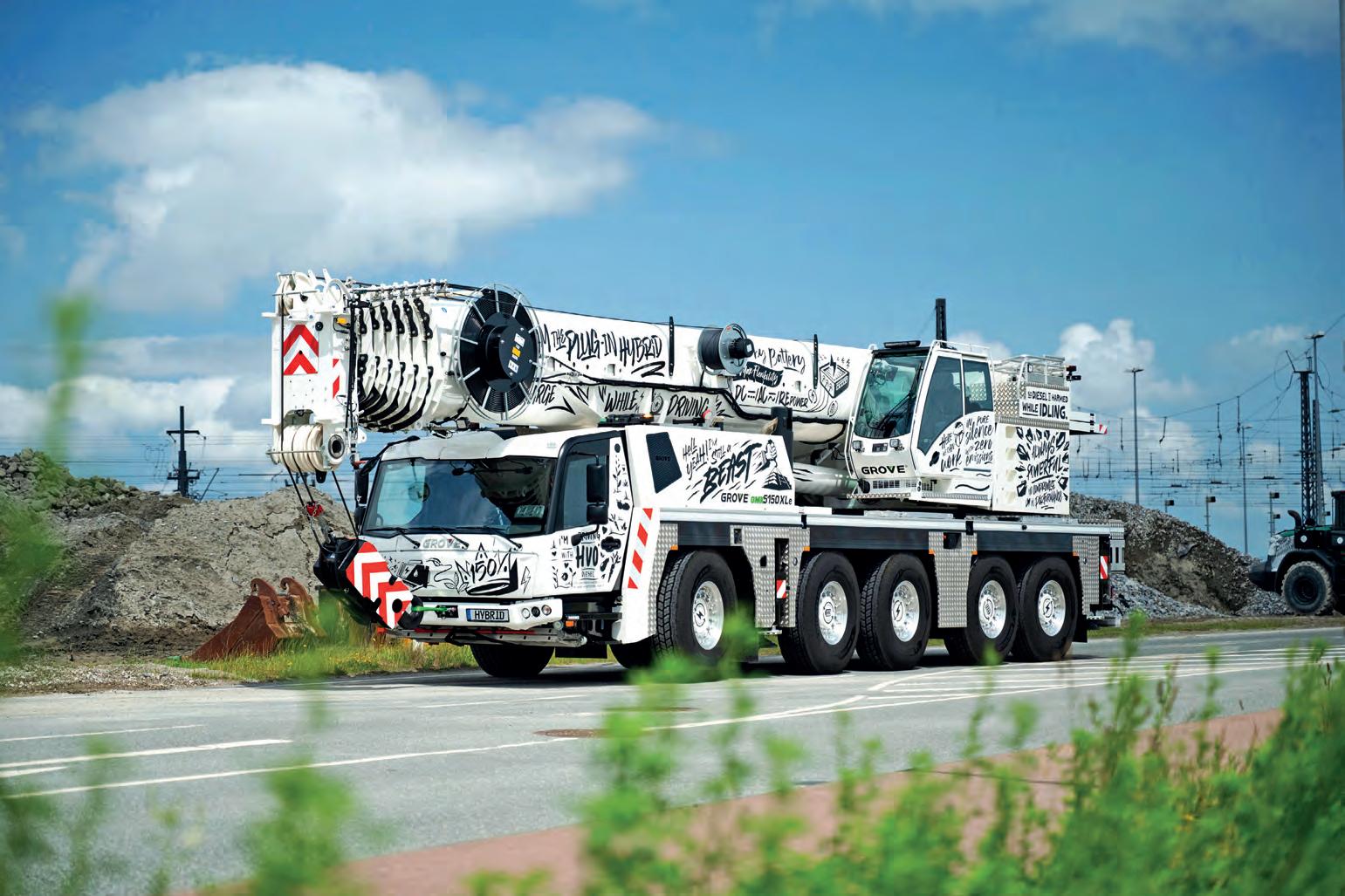

Manitowoc made a powerful impression at Vertikal Days 2025, bringing together cutting-edge technologies and a strong focus on customer support. Manitowoc also featured a variety of Grove all terrain and rough-terrain cranes during September’s GIS EXPO that have never been shown in Italy.
HEADLINING THE BOOTH AT VERTIKAL Days, Europe’s largest lifting equipment event, was the Grove GMK5150XLe plug-in hybrid all terrain crane.
While the all terrain was launched at bauma 2025, Vertikal Days, held in Nottinghamshire in September, marked its United Kingdom debut.
The Grove GMK5150XLe delivers 150 tonne capacity and a 68.7 metre,
seven-section boom, with performance that matches that of the regular dieselpowered Grove GMK5150XL. At the same time, it delivers low-emission operation through a fully electric mode for on-site lifting.
The crane’s 160 kilowatt-hours (kWh) battery pack can be charged while driving, allowing it to top-up on the way to the next jobsite. Options include
a 9.6m/16.2m bi-fold swingaway jib, an eight metre boom extension, and a six metre jib extension.
At the heart of the new crane is a battery pack that enables a solid day’s work as a taxi crane. With 180kWh of energy, the Grove Plug-in Hybrid cranes can easily carry out several daily tasks. What makes them especially versatile is their ability to charge the
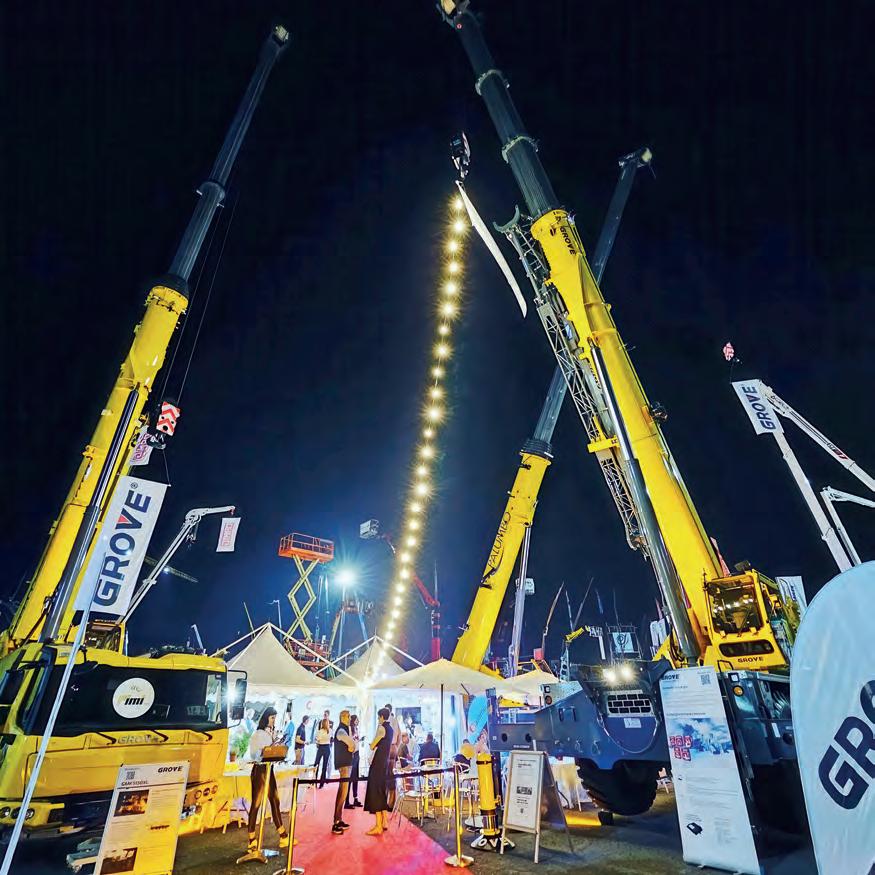
battery from the grid (either AC or DC power supplies) or a 170kW generator integrated into the carrier. This allows charging while driving and eliminates concerns about the availability of charging infrastructure. The cranes can even be operated while charging (providing there is infrastructure for this at the jobsite).
The battery pack enables about eight hours of emissions-free lifting without compromising speed or capacity. When the crane is connected to the grid, the crane can operate continuously. This is more than enough functionality for a 150 tonne taxi crane, and when the day’s work is complete, the batteries are recharged while the crane is driven back to base. Another exciting feature is the E-Boost function. While accelerating the generator can be used as motor and gives an additional 800Nm torque into the driveline.
These new Plug-in Hybrid cranes deliver more sustainable lifting and boost owners’ environmental
Italy had its first look at Groves’ latest models during GIS EXPO 2025.
• Grove GRT550: With a 50 tonne capacity and class-leading 39 metre five-section boom (49 metre tip height with eight metre extension), the GRT550 offers improved load charts, faster 155m/min line speed, and 5552 kilogram line pull. It remains road-legal across Europe under 29t GVW, and is easy to transport with a vehicle width of 2.55 metres. Upgrades include Site Steering, MAXbase™, redesigned cab with improved visibility, and service access supported by Grove CONNECT™ and CSI diagnostics.
• Grove GRT780: The 80 tonne rough-terrain crane features a five-section MEGAFORM™ boom spanning 11.9 – 47.3 metres, with a bi-fold swingaway jib extending reach to 67 metres. It includes MAXbase™ variable outrigger positioning, Grove CONNECT™ telematics, a 12-in CCS 1+ touchscreen, CSI diagnostics, and a full-vision tilting cab – all packed into a narrow, manoeuvrable
“The battery pack enables approximately eight hours of emissions-free lifting without compromising speed or capacity.”
credentials. They can drive to the job site using hydrotreated vegetable oil (HVO) fuel to power the efficient MercedesBenz engine and reduce carbon emissions by up to 90 per cent while simultaneously charging the batteries.
There’s also a massive reduction in noise pollution – an advantage when operating in a city centre.
The Grove GMK5150XLe is expected to land in Australia before year’s end.
During September’s GIS EXPO, Grove featured a variety of all terrain and rough-terrain cranes that have never been shown in Italy.
The Grove GRT550 and GRT780 –both built at Manitowoc’s Italian factory in Niella Tanaro – and GMK6450-1.
frame with optional hydraulic counterweight removal. The crane’s carrier is less than three metres wide, and its Gross Vehicle Weight is 46.6 tonne with a full spec, or less than 43 tonne.
• Grove GMK6450-1: The 450 tonne all-terrain crane has a 60 metre five-section main boom and MegaWingLift™ attachment that boosts capacity by up to 70 per cent on the main boom (up to 400 per cent with luffing jib). It lifts 8.9 tonnes at 50 metre radius with a 79 metre jib (136m tip height); or 12.8 tonne between 36 and 52 metre radius with a 67 metre jib. MAXbase™, CCS, and a faster hydraulic system enhance flexibility and speed.

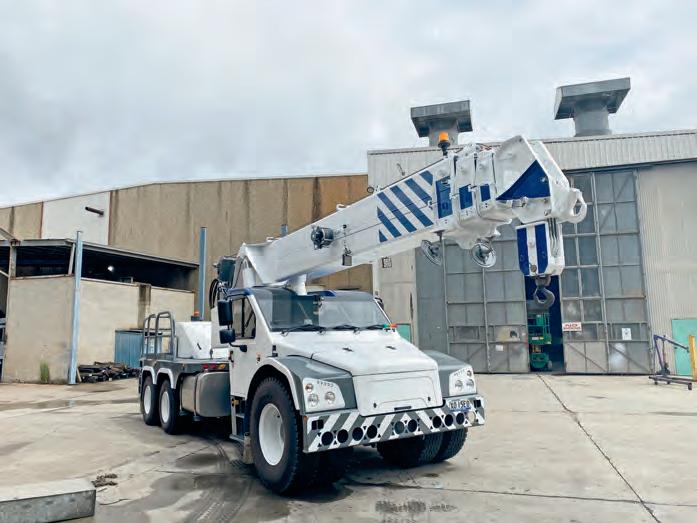

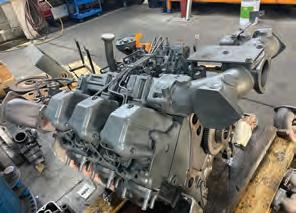
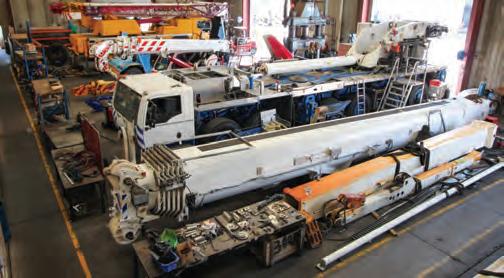





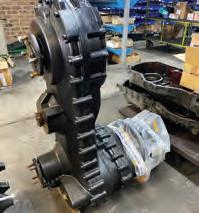
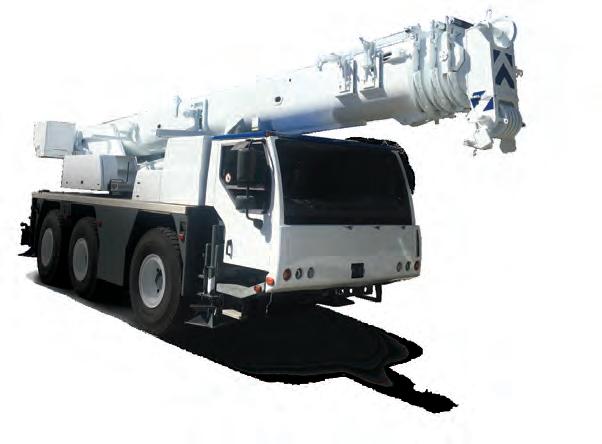
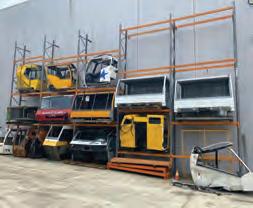
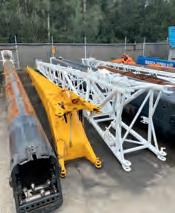
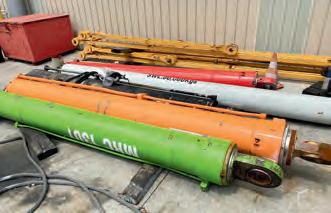

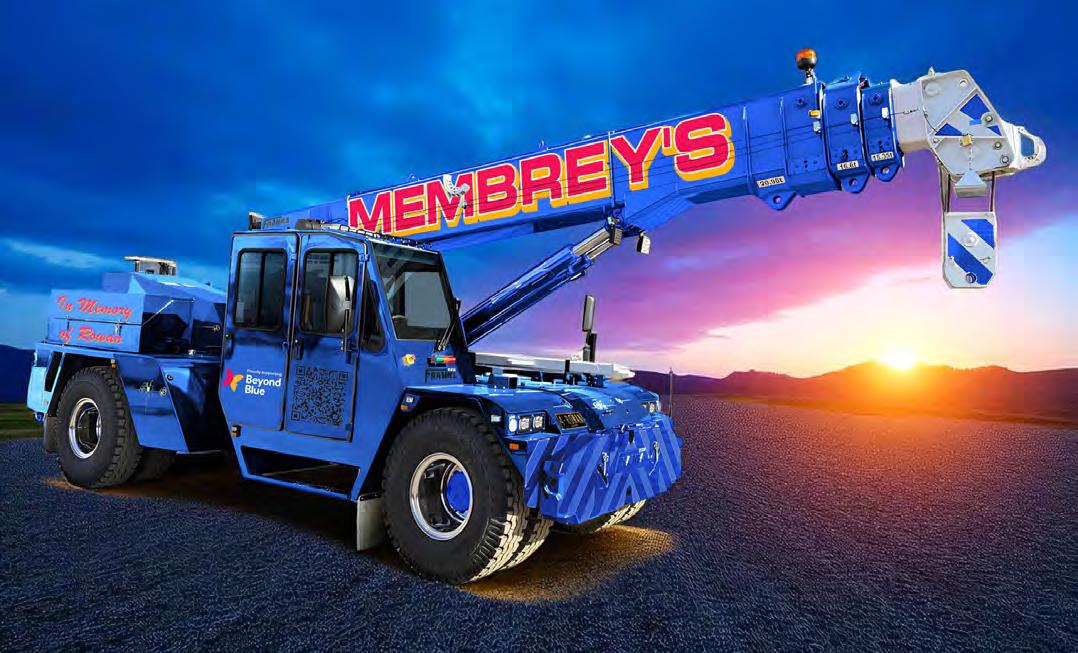
For most transport and crane hire companies, machines are a livelihood. But some machines carry more than just weight – they carry meaning. For Craig Membrey, Managing Director of Membrey’s Transport & Crane Hire, one crane now holds something deeply personal: the memory of his son Rowan, and a message he has carried for more than a decade –that talking about mental health can save lives.
IN MARCH 2011, CRAIG’S LIFE WAS irreversibly changed when his son Rowan died by suicide at just 17. The tragedy left a hole that could never be filled, but also lit a fire in Craig to ensure his son’s story would not fade. Within months, he restored his son’s beloved T904 Kenworth as a moving memorial. Painted in memory of Rowan and driven to industry events across the country, the truck has become a catalyst for conversations about suicide prevention and the importance of seeking help.
“The journey with the truck has always been about encouraging people to reach out before it’s too late,” Craig said. “It’s not about me, it’s about Rowan’s story, and if that story can help someone
choose life, then it’s doing what it was meant to do.”
Over time, Craig began to dream of extending that legacy into the lifting sector –a space that has been central to Membrey’s for decades. When he learned Franna was about to deliver its 2000th MAC25, he saw the opportunity to bring that dream to life.
Working with long-time friend Danny Black, General Manager of Franna, and securing the support of Beyond Blue, Craig ensured the milestone crane was finished in Beyond Blue livery. The crane carries not only Rowan’s name but also a fundraising barcode, connecting every sighting of the machine to a chance for someone to seek help.
“This blue crane is about visibility. It’s
about Rowan’s memory travelling down the road and hopefully encouraging someone to ask for help before it’s too late,” Craig said.
BREAKING THE SILENCE
For Craig, the decision to speak openly about mental health was never easy. Talking about Rowan means reopening a wound that never really heals. Yet he knows that silence is dangerous.
“I’ve been there myself,” he said. “I know what it’s like to feel overwhelmed. The difference for me was seeking help early, before it went too far. Suicide is 100 per cent preventable if people ask for help early enough. That’s the message I want to get across.”
It’s a message Craig repeats tirelessly –at truck shows, crane conferences, and in everyday conversations. His openness has resonated with people who might otherwise keep their struggles hidden. Over the years, he has been told directly that Rowan’s truck helped save lives. Now, he hopes Rowan’s crane will have the same impact.
“I don’t want anyone to go through what I’ve gone through,” Craig said. “Losing a child is something you never get over. If sharing my story prevents even one other family from experiencing this pain, then it’s all worth it.”
Craig’s initiative has already found strong allies across the industry. At this year’s
CICA Conference in Brisbane, the Beyond Blue crane will be unveiled, with Craig, his son Jack and the Franna team on hand in bespoke Beyond Blue polos, distributing caps and other items designed to spark conversations.
Behind the scenes, organisations such as UAA Group and PNOinsurance have stepped up to support Craig’s efforts. For Marc Crossman, Executive General Manager – Distribution Strategy at UAA, the decision was deeply personal.
“As a business, we like to support causes that are meaningful to us and our customers,” Marc said. “Craig’s story really hit home. It’s relevant to so many of us, both within our industry and across the broader community. Helping him get that message out felt like something we had to do.”
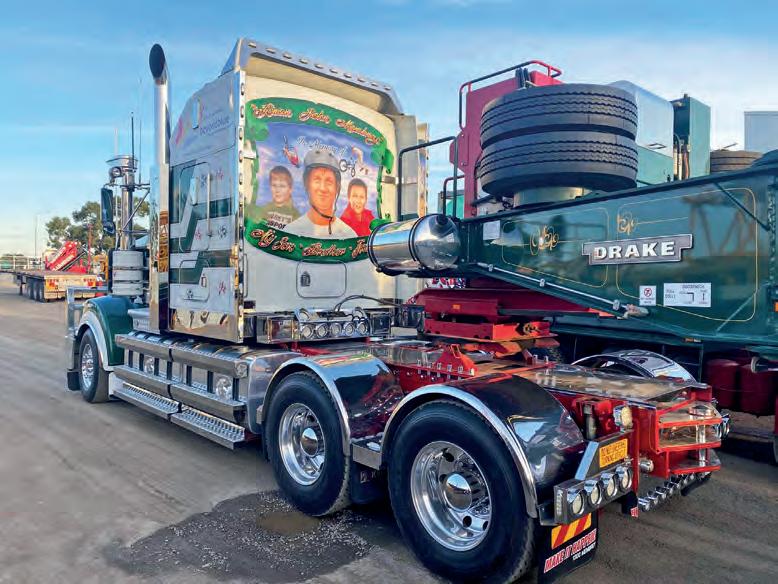
Marc believes the initiative highlights an issue that is both widespread and under-discussed. “Mental health is a big issue in Australia, and the pressures in our industry can make it even more acute. By providing Craig with a platform, we can help raise awareness, create conversation, and encourage people to support each other.”
Nearly half of Australians will experience a mental health condition in their lifetime. Beyond Blue exists to make it easier for people to get the help they need earlier,
and to stay well. Every two minutes, someone in Australia turns to Beyond Blue’s 24/7 Support Service for free counselling and support.
Funds raised through Rowan’s crane will go directly towards this service, ensuring that those who reach out can find someone ready to listen on the other end of the line. It’s a cause that resonates across industries but holds particular weight in sectors like transport and construction, where isolation, long hours, and financial stress can exacerbate mental health challenges.
Craig knows these pressures well. He has seen firsthand how colleagues and peers often suffer in silence. “Depression can be invisible. People think it’s embarrassing to admit they’re struggling. But it’s not weak to speak. The hardest step is asking for help,
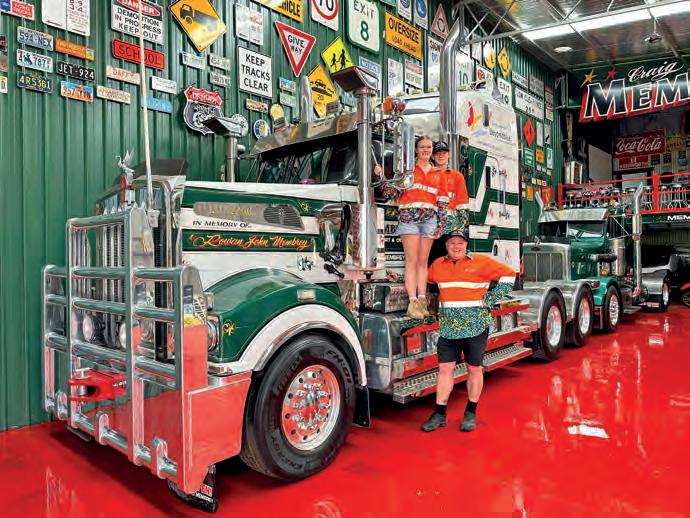
but it’s also the most important one,” he said.
Once the conference ends, the Beyond Blue crane won’t just sit as a showpiece. It will head straight to work across Victoria, its blue paintwork and message of hope visible on worksites and roadsides alike. For Craig, that mobility is essential.
“This crane is a special one. It’s not about business or branding – it’s about carrying Rowan’s memory and Beyond Blue’s message wherever it goes. If seeing it helps just one person take that step to seek help, then it has done its job,” he said.
Craig is modest about his role. “I’m no hero. I’m just a father who lost a son. But if using my trucks and cranes can help spread this message, then that’s what I’ll keep doing,” he said.
The message is simple, but urgent: you don’t have to go through it alone. Help is out there. And thanks to Rowan’s legacy, carried forward on the road and the jobsite, that reminder will keep reaching people when they need it most.
If you or someone you know needs mental health support, reach out to Beyond Blue’s free 24/7 service on 1300 22 4636 or chat to a counsellor online at www.beyondblue.org.au/get-support.

At Melbourne Lifting, 4.30pm isn’t “tools down.” If a customer calls late with an urgent job, the answer is still yes. “That’s not knock-off time for us,” say company owners Mick and Clair. “If someone rings at five in the morning, we’re ready to go.”
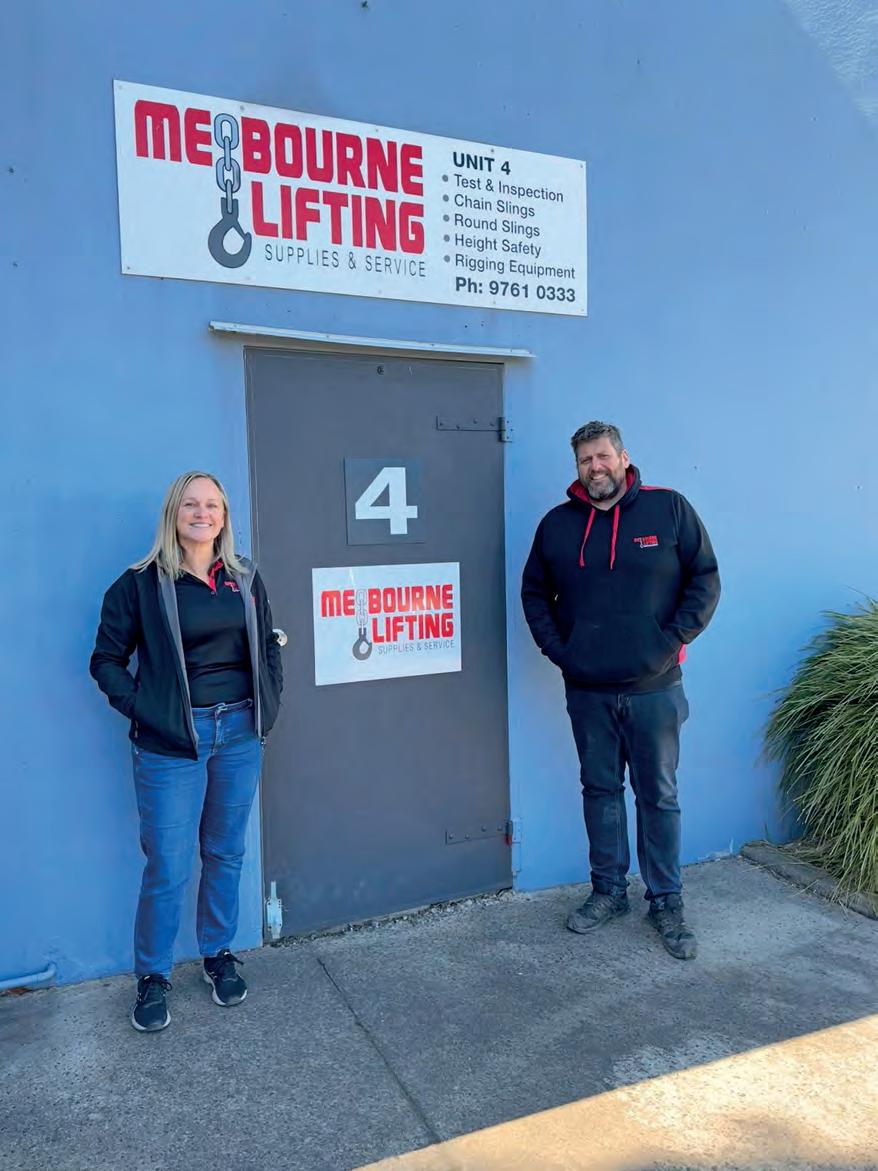
THAT RESPONSIVENESS SITS ON TOP of a long family history. The company traces back to B&I Supplies, the business started by Mick’s parents, Brian and Irene. After almost three decades building a loyal customer base, Mick and Clair bought the business in 2017 and re-cast it as Melbourne Lifting – a name that actually says what the company does. “We wanted the name to reflect the work,” Mick said. “People shouldn’t have to guess what we specialise in. For all your lifting needs, large or small, we
A shift to a larger site in 2019 marked a turning point. “The old premises were physically and logistically too small,” Clair said. “We were literally unloading the factory for an hour each morning just to create space to work – then loading it all back in at night.” The move brought street-front visibility and immediate expansion. “We filled the new place straight away.”
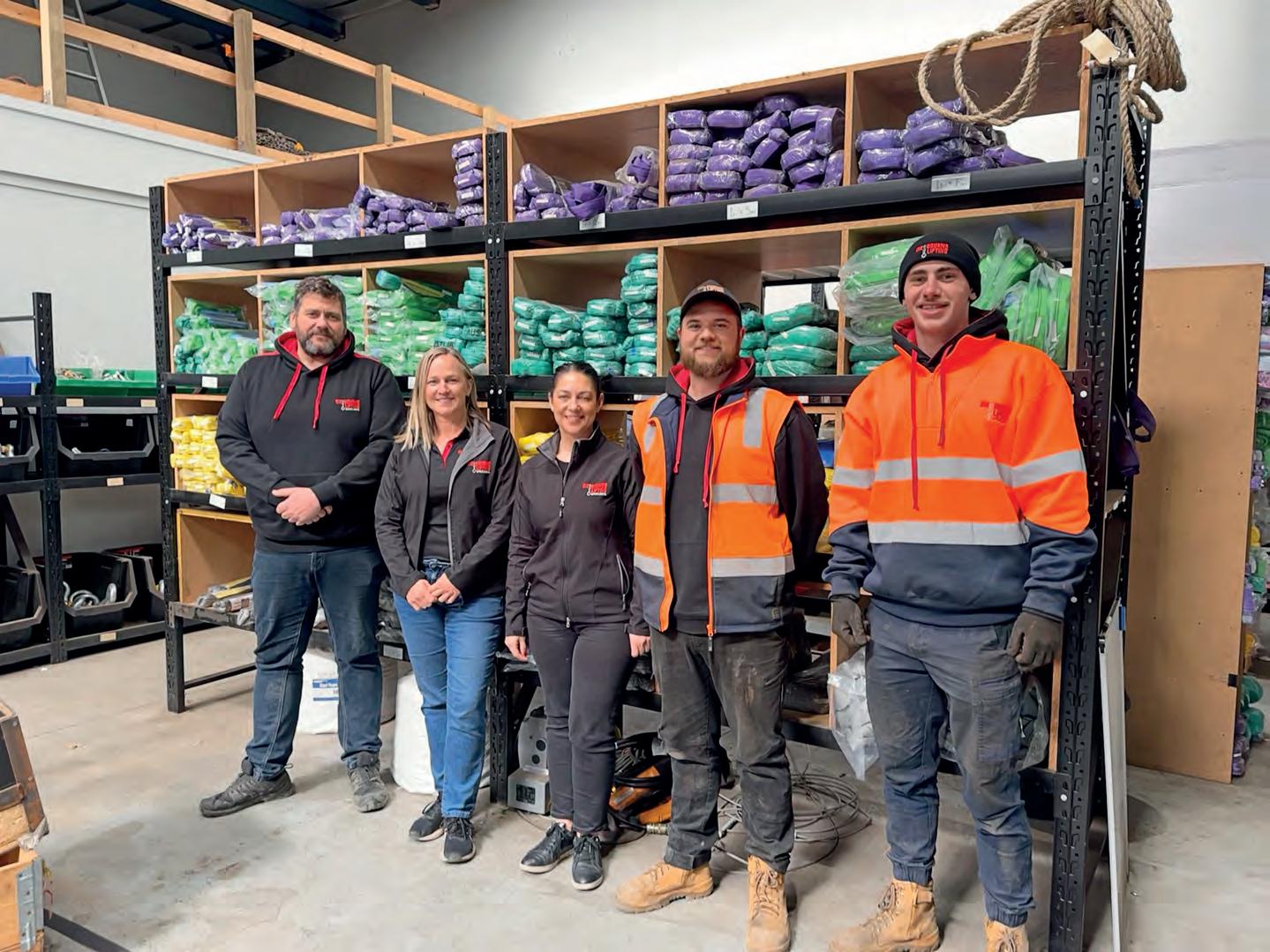
The extra room wasn’t just about comfort. It unlocked new capability. “Wire rope was the big one,” Mick said. “At the old place, we couldn’t fit the racks or a press. Here, we can lay out work properly and see the job in front of us. A showroom means walk-ins can see and handle our products before buying. “
ADE-TO-ORDER, IN-HOUSE Wire rope slings aren’t one-size-fits-all – they vary by material, construction, diameter, length and application. As demand rose, outsourcing became
“Lead times weren’t where we wanted them,” Clair said. “So, we invested in a 600-tonne wire rope press and brought

manufacturing in-house.”
Today, Melbourne Lifting builds wire-rope slings to order, re-swage end fittings, repair where possible, and test and tag on site. “The in-house press lets us control quality, shorten turnaround and respond to unusual requirements without sending customers elsewhere,” Clair said. “We also keep pre-made Franna ropes on the shelf at sharp prices so fleets can grab and go.”
Most modern crane hoist ropes come with a Resin Spelter Button (RSB) end. If that button is damaged, owners are often told to buy a whole new rope – an unnecessary expense and a guaranteed dose of downtime. “We’ve trained our technicians to repair, replace and refit an end-socket on site,” Clair said. “It’s a big cost saver and, more importantly, it gets cranes back to work quickly and safely.”
That on-site mindset extends beyond wire rope. A mobile test bed allows clutch, chain and component testing at a customer’s yard, eliminating the old routine of carting equipment back to the workshop and waiting for reinstall.
“You can test on site and put it straight back to work,” Mick said. “No downtime, no double handling – that’s why we bought it.”
Melbourne Lifting’s core remains lifting equipment supply, service, repairs, testing and inspections – with the wire-rope line now sitting alongside on-site crane-rope inspections, mobile testing and RSB work.
“People can walk into the showroom, see what we stock and talk directly to us about the job they’re trying to solve,” Clair said.
Service is deliberately personal.
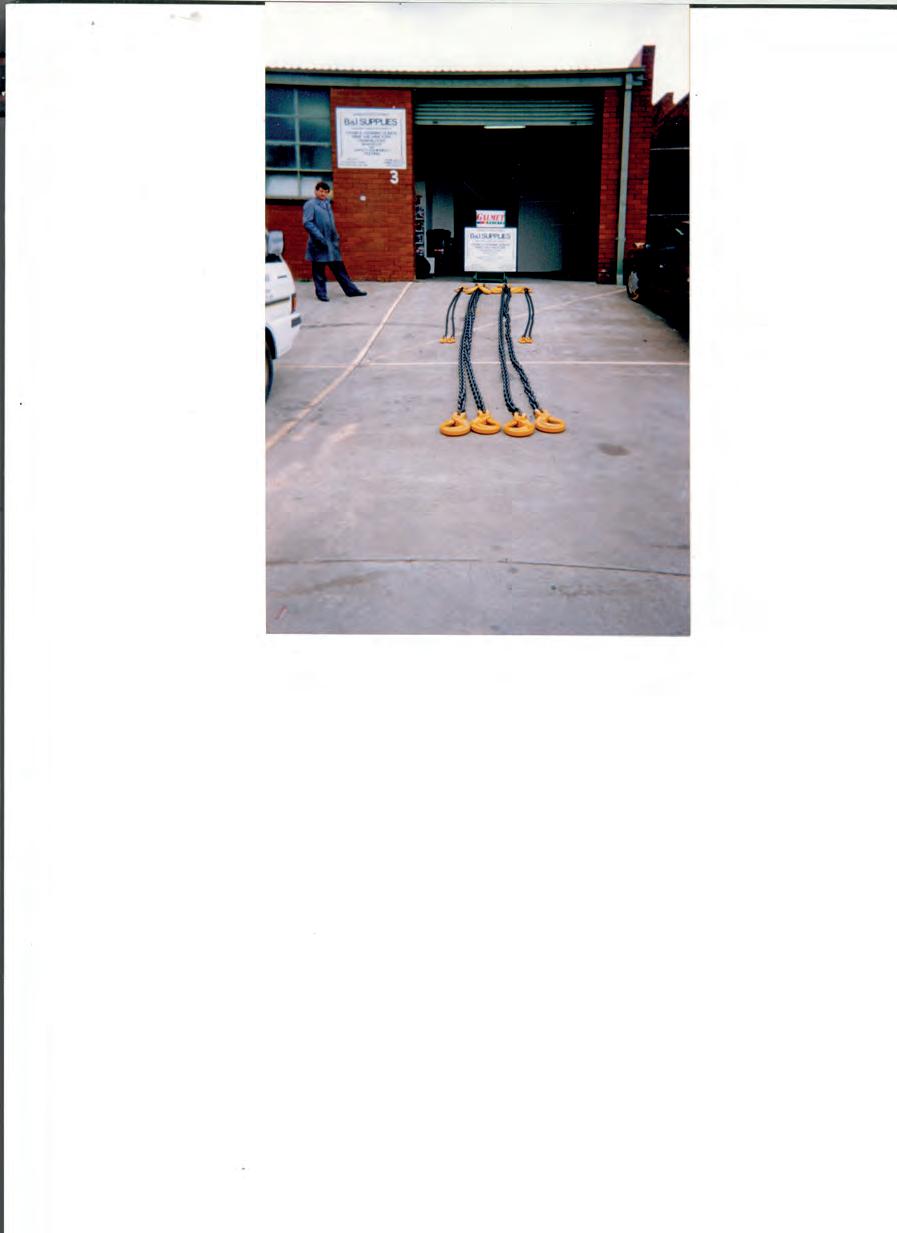
Melbourne Lifting combines in-house wire rope production, mobile testing, and personal service to keep fleets productive across Victoria.
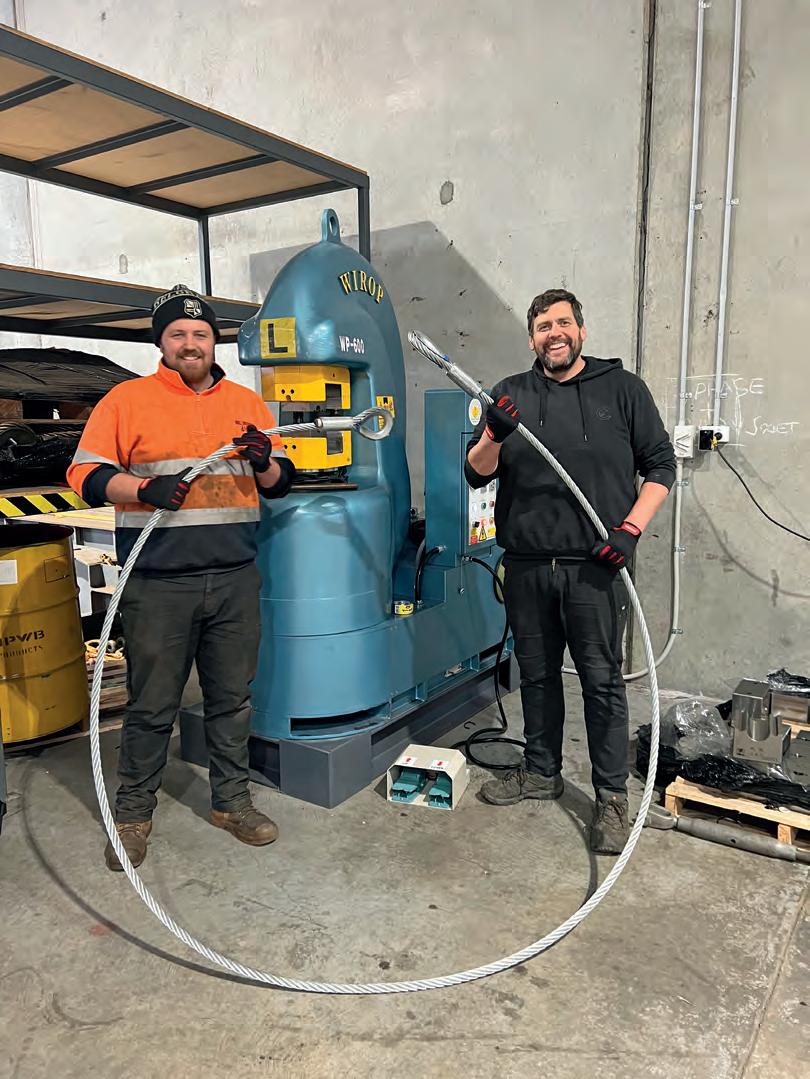
– that’s a given,” Mick said. “What’s different is how fast you move and how much pressure you put on yourself to get a customer back online.”
That philosophy extends to account size. “Everyone gets the same service,” Mick said. “Whether you run 15 cranes or just one, the respect goes both ways.” The team avoids public client lists in a competitive market, but the approach is consistent: fast response.
Melbourne Lifting’s safety framework is guided by LEEA (Lifting Equipment Engineers Association). “LEEA has been excellent for us,” Clair said. “They’re
help and advice when we need it. Our technicians are qualified, but so much of this trade is experience and constant onthe-job training.”
Scale is only useful if the team can move with it. “We’re six people,” Clair said. “We are like a family. Emma and I run the admin – Emma handles reporting and bookings – Mick manages the floor, and three technicians rotate across testing, deliveries, pick-ups, on-site inspections and service calls. We mix the work so no one gets stuck in a rut. The bench is steady: Harley has been with the business for well over a decade
“You can ring and speak directly to one of us. That’s how we want it and we’re not changing that. We wouldn’t have it any other way.”
dating back to the B&I days, while Emma is also long-tenured; Casper started as a one-day-a-week junior and grew into the role. Jarrah came on board as we needed more hands as our business grew.”
The company hasn’t chased headlines or megaprojects. It prefers to keep the ability to service the loyal – long-time customers. Its kit is there – often via crane-hire customers – but the focus is squarely on keeping fleets productive. “We’re hands-on and reachable,” Clair said. “You can ring and speak directly to one of us. That’s how we want it and we’re not changing that. We wouldn’t have it any other way.”
Two decisions made the recent growth possible and sustainable:
Space that works: the 2019 move brought layout, visibility and a showroom, replacing daily stock shuffles with organised work cells.
Capability in-house: the wire-rope line turned a recurring bottleneck into a competitive edge; the mobile test bed stripped out downtime and double handling.
Ask Mick what really differentiates Melbourne Lifting and he won’t reach for marketing language. He’ll point to turnaround. “We don’t claim to be ‘better’ than anyone who follows the rules. We just make it happen quicker, and we stand behind the work and quality. We put pressure on ourselves to take the pressure off our customers.”
Clair frames it simply: “If we can reduce downtime and cut costs for a customer – we’ve done our job. That’s what keeps people coming back.”

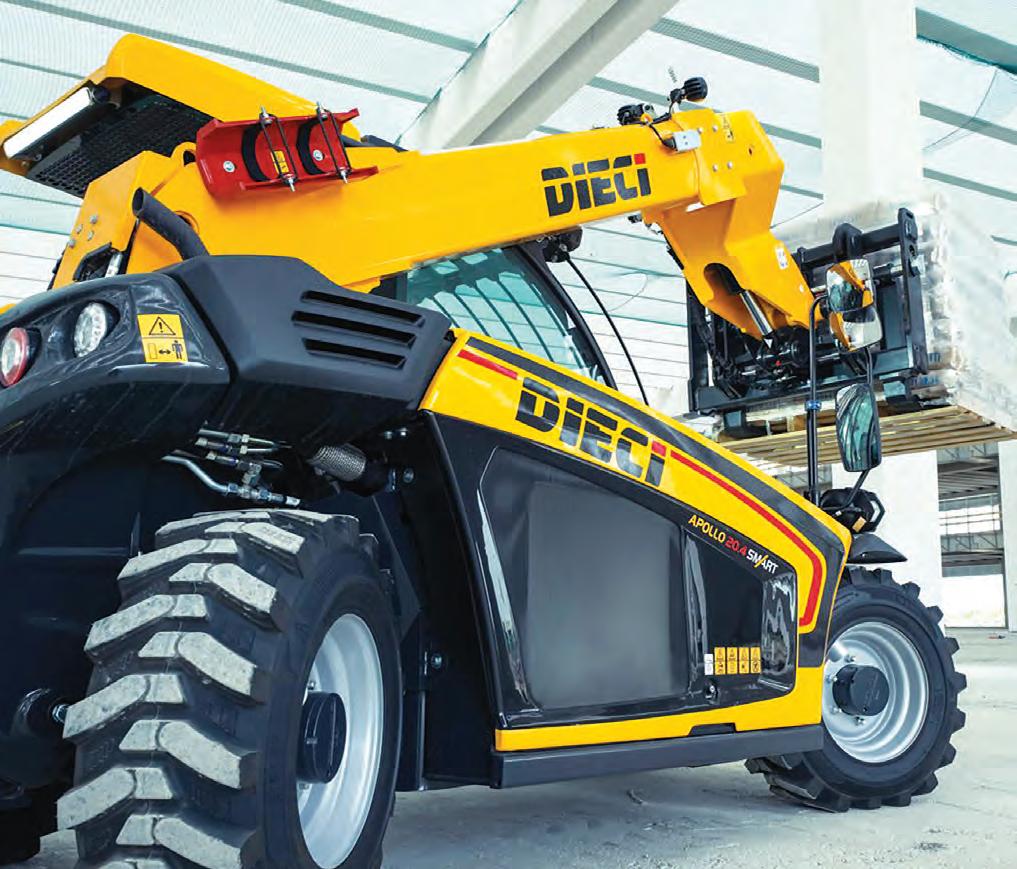
The APOLLO SMART 20.4 telehandler by Dieci is built for tight spaces without compromising precision. Its sleek design ensures effortless manoeuvrability, a spacious cab for comfort, and a durable boom for heavy loads at impressive heights. Three steering modes guarantee smooth navigation, while the advanced engine and simplified maintenance deliver unmatched efficiency and savings.
Max Capacity: 2,000 kg
Max Lift Height: 4.35 m
Max Speed: 25 km/h
Max Power: 37 kW (50 hp)
The HC-L series from Liebherr represents the next generation of high-performance luffing jib cranes, designed to meet the challenges of modern construction sites. Innovative ballast solutions and robust hoist units ensure maximum reliability and safety, while advanced control technology enables intuitive operation. With a well-thought-out design, these cranes optimize space and efficiency, making them ideal for confined construction projects. www.liebherr.com

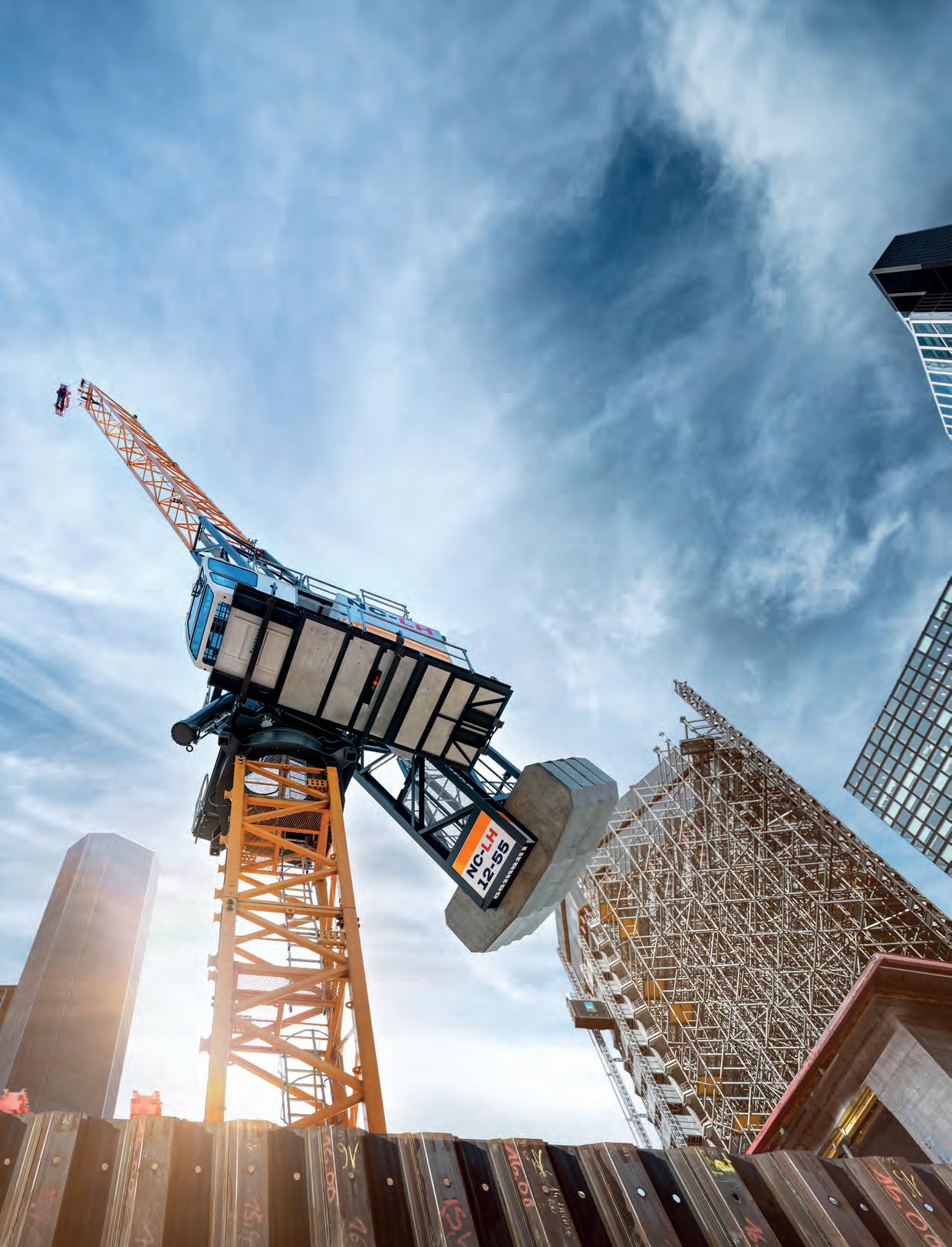
In early September, The Baden Davis Crane Connection (Crane Connection) announced that it had been appointed as the distributor of XCMG Cranes covering New South Wales, Queensland and the ACT.
THE CRANE CONNECTION HAS A rich heritage when it comes to crane dealerships. The predecessor company, GM Baden, was the distributor for Liebherr for 12 years and was responsible for introducing Liebherr mobile cranes to the Australian market.
Crane Connection’s Ben Baden and Anthony Davis have gone on to represent a number of products and brands including Link-Belt, Kobelco and TIDD pick and carry cranes. The team are no strangers to representing brands, building the awareness and then providing the critical aspect of after sales service and support.
XCMG and The Crane Connection have been negotiating for many months and during this time it became clear to Ben and Anthony that XCMG has a very strong, long-term focus for the Australian market.
“It was apparent to us that XCMG don’t want to rush products that are not ready for entry into the Australian market. The decisions they make are thoughtful and calculated, and the products that they are bringing in have been thoroughly tested to the high and exacting standards your typical Australian crane customer is expecting,” said Ben.
“We appreciated that this approach wasn’t just in theory, it is based on a thorough understanding of the exacting high standards the Australian market requires, and this was one of the fundamental reasons we decided to go with XCMG,” he said.
Customers can be reassured that
when they purchase an XCMG from The Baden Davis Crane Connection, they will receive strong product support and service.
Ben and Anthony operate a dedicated service, repair and spare parts facility in Sydney’s western suburbs that is second to none. It includes 14,000 square metres of land with workshops, fabrication shops, large wash bay facilities, large paint shop facilities, and a significant spare parts department.
“Our capabilities put us in a perfect position to support XCMG product and as it grows in the Australian market, so will our commitment to provide the required levels of product support including spare parts availability,” said Ben.
The entire Crane Connection team is focused on cranes. Most are long-
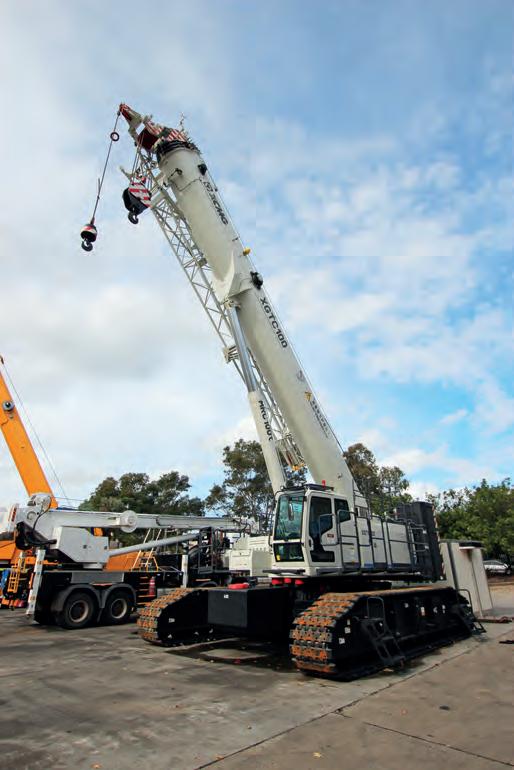
“We operate a facility where everything is done in-house. We don’t need to subcontract welding, we don’t need to subcontract painting or electrical work, it’s all managed in-house.”
term employees, many with 15 to 20 year’s experience, with the company and some with more. The workshop continues to manage the repairs and maintenance of every crane manufacturer, and this work includes insurance and major inspection repairs.
“Why do we provide such a comprehensive range of after sales services? We operate a facility where everything is done in-house. We
don’t need to subcontract welding, we don’t need to subcontract painting or electrical work, it’s all managed inhouse,” Ben said.
“From our perspective, we see many opportunities of working with XCMG. When a global crane business like Sarens signs an agreement to purchase XCMG all terrains into the future, you understand the goal posts have been moved.”

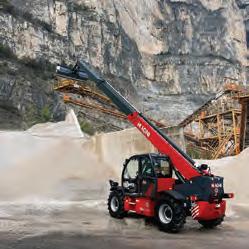
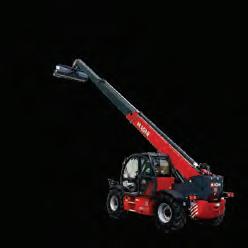
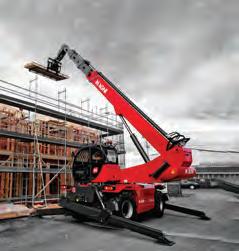
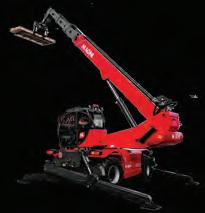
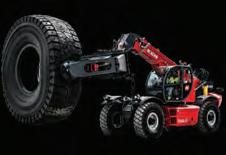
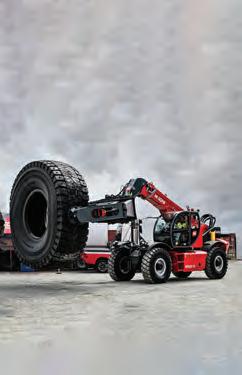
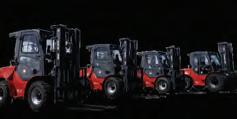
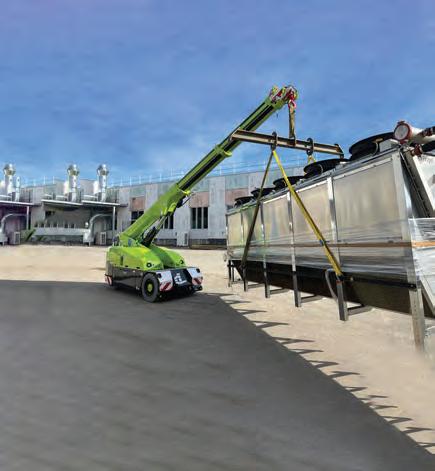

Custom Material Handling Solutions
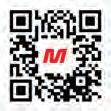
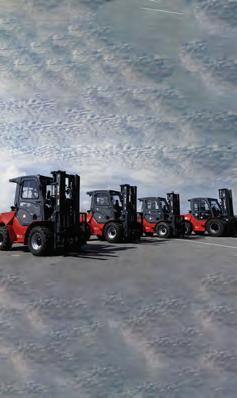
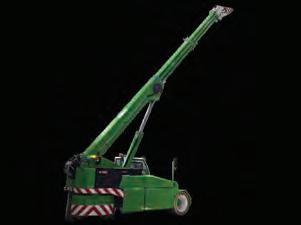
8h Non-stop hours 0 emissions

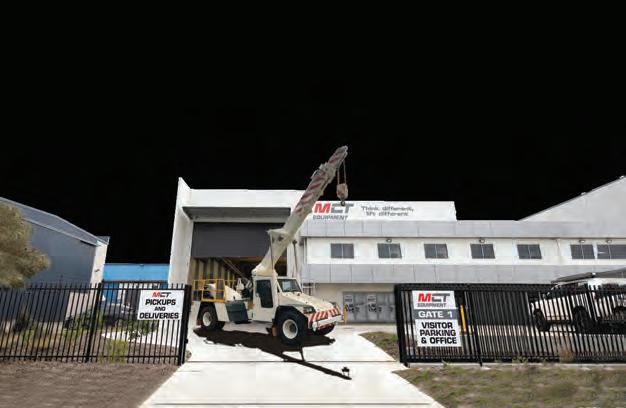
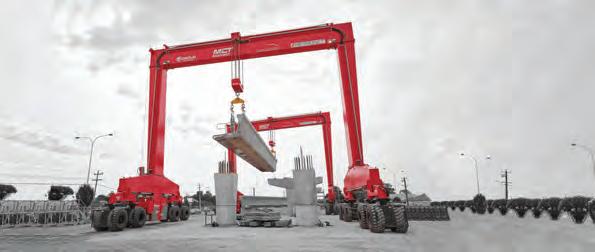
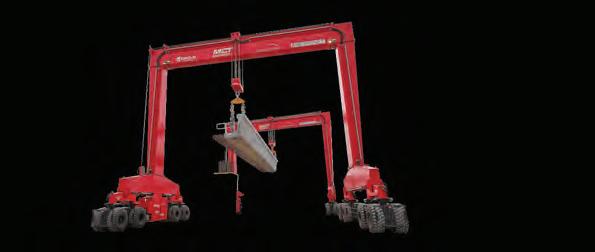
Full-service workshop servicing, repairs and used crane options

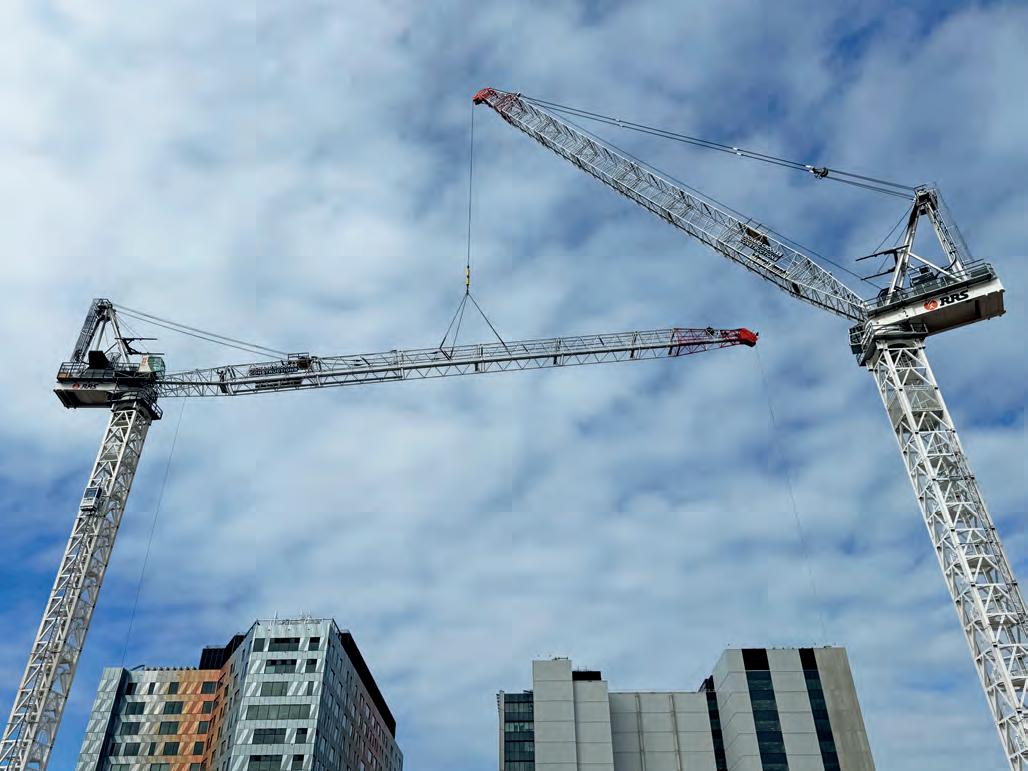

Resolution Rigging Services (RRS) has come a long way since starting out in 2000. From a small, family-run business, it has grown into one of Sydney’s most respected crane and rigging providers, supplying major hospitals, universities, residential and large commercial projects.
RESOLUTION RIGGING’S SUCCESS IS BUILT not only on an expanding fleet and technical capability, but on an ethos that values loyalty, accountability, and long-term relationships.
Rhys Noronha, Project Manager at Resolution Rigging, said the company’s reputation is as much about people as it is about cranes.
“We’ve always been proud of being family-owned and family-run. It means we operate with our name on the back of every job. That sense of accountability shapes the way we work with clients and with each other,” Rhys said.
Starting out with limited resources, Resolution Rigging steadily built its capabilities by taking on complex work and ensuring projects were delivered without compromise on safety or service. Today, its cranes are a fixture on high-profile hospital redevelopments, large commercial builds, and major research facilities across Sydney. A defining point of difference for
Resolution Rigging is the direct involvement of its director, Tony Noronha, in high-risk activities. Tony supervises the erection, dismantle, and climbing of tower cranes – critical operations that demand both technical precision and on-site experience. With more than 900 such operations completed to date, his oversight brings a unique level of assurance to clients.
That commitment to safe delivery has become part of the company’s DNA, and shows its ability to confidently take on complex projects.
Resolution Rigging operates one of the most diverse fleets of Liebherr and Favelle Favco tower cranes, ranging from six-tonne to 96-tonne capacities, with jib radii stretching up to 83 metres. Liebherr’s German-made electric flat-top cranes are designed for maximum efficiency, requiring the least power in their class, while Favelle Favco’s
diesel-powered models are renowned for their speed and strength.
This mix gives clients flexibility across project types – from high-rise towers demanding fast hook speed to projects where heavy lifting is paramount. Efficient erection and dismantle schedules are critical. As Rhys said, “In Australia, labour costs are high, so the faster you can erect and dismantle a crane, the more cost effective it is to the client.”
Having both electric and diesel cranes gives further flexibility to the client. The electric cranes suit projects with strict environmental requirements, while the diesel cranes deliver unmatched speed and lifting power for high-rise and heavy-duty jobs.
PROJECT HIGHLIGHTS ACROSS SYDNEY Tony pointed to several hospital and research developments as cornerstone projects for Resolution Rigging. At New Shellharbour Hospital, the company currently has two
The family-owned business has worked on major hospital, university, and commercial projects with expertise and care.
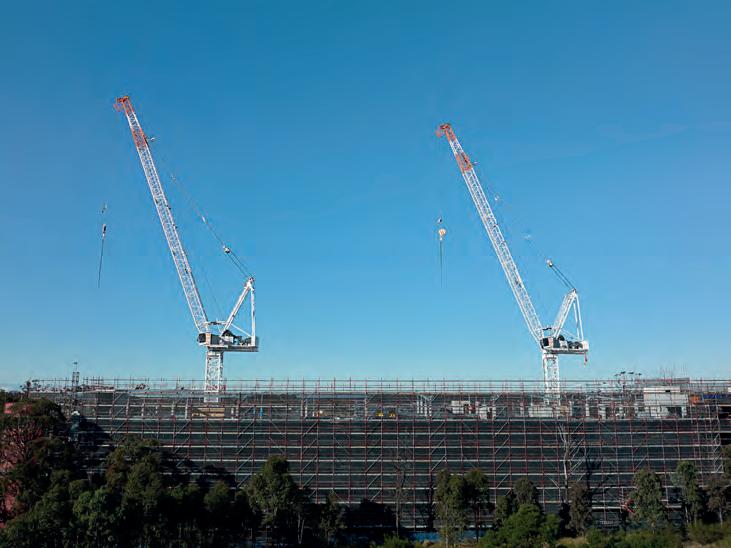
cranes erected, with a third to follow on the multi-storey car park. Resolution Rigging is supplying cranes to the new Westmead Integrated Mental Health Complex, an extension of the existing hospital. The team is also engaged at Ryde Hospital, where both flat-top and hammerhead cranes have been deployed, and at the Sydney Biomedical Accelerator, a major medical research facility within the University of Sydney’s Camperdown campus.
“These long-term jobs are significant for us because they keep our large cranes tied up for extended periods,” Rhys said.
“It gives our people stability and allows us to expand into other areas of work while still having our big cranes engaged on those sites.”
Beyond hospitals, the company has been involved in a wide range of community and educational developments.
Resolution Rigging has supplied and operated cranes for a number of New South Wales school projects, including Darcy Road Public School, Castle Hill Public School and Darlington Public School, and is currently engaged at Midtown Macquarie Park Public School.
These jobs go on to show the company’s ability to deliver safe and efficient crane operations on projects that directly benefit local communities.
The company has also supported student housing projects, such as the Col James Student Accommodation in Sydney. Here, Resolution Rigging supplied cranes tailored to the tight site conditions.
Resolution Rigging has also been active in the fast-growing data centre sector in Western Sydney. On one major project, the company deployed five hammerhead and flat-top tower cranes to support the large-scale build. On another, its Favelle Favco M860DX and M630D cranes were engaged to lift heavy prefabricated modules into place. Such projects require complex logistics and precision lifting.
Another standout job is The Showground Precinct at Castle Hill, where the team deployed a mix of Favelle Favco and Liebherr cranes. The project required multiple climbs and ties during construction, with one crane dismantled and replaced with a larger model on a grillage base to meet the evolving demands of the build.
Beyond cranes, Resolution Rigging Services provides a complete range of material-handling solutions, including retractable loading platforms, brick cages, rescue cages, sky decks, spreader bars, offset lifting beams, and licensed twoway radios. The company also engages engineers to design bases, grillages, and crane ties, ensuring each setup is tailored for both safety and cost efficiency.
The move into 3D modelling and BIM integration is further enhancing project planning. By demonstrating crane tie-ins and clash detection digitally, the company is helping clients better visualise construction sequences and reduce risks before work begins.
While the fleet and project portfolio tell one part of the growth story, Tony is quick to point out that the company’s ethos has always revolved around people. The family aspect remains strong – his father and uncle play active roles, and younger generations have stepped into larger responsibilities as the business has expanded.
That culture of loyalty extends beyond the family. One of the company’s longestserving employees, Dragan, has been with Resolution Rigging for more than two decades.
Resolution Rigging has also expanded its engineering and drafting capabilities, while continuing to invest in mechanics and riggers who have been part of the team for years.
“We’re not a revolving-door business. The same core people are still here. That consistency is one of our biggest strengths,” Tony said.
For Tony, Resolution Rigging’s ethos is best captured in how it approaches client relationships. “Tower cranes are one of the most dangerous pieces of equipment on a site,” he said. “Clients need to know that when they pick up the phone, they’re talking to someone who can make decisions straight away and carry the project through from start to finish.”
That one-point-of-contact approach –where the same person handles tendering, project management, commissioning, and dismantling – has earned the company respect across the industry.
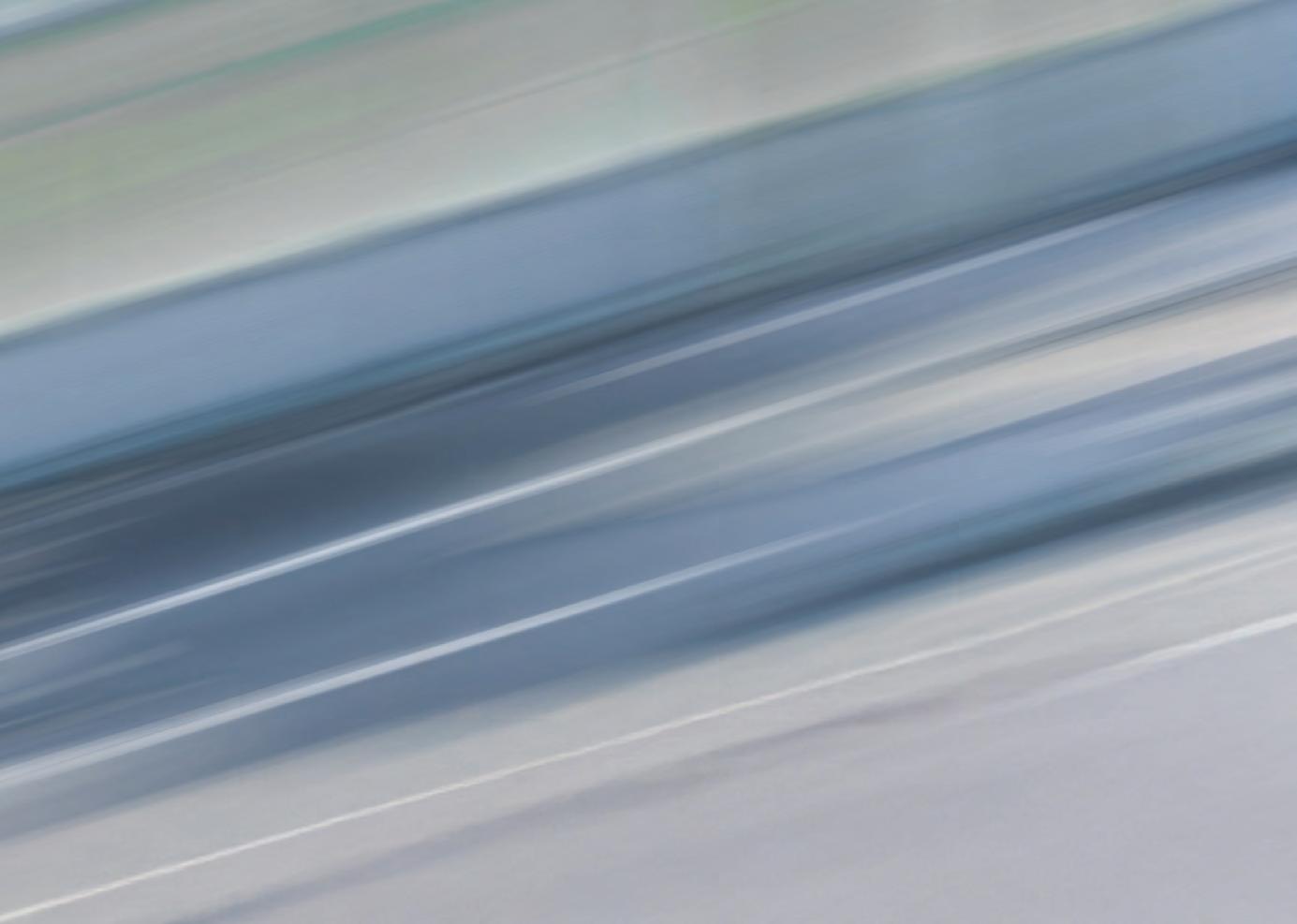
“Pricing matters, but what matters more is assurance. Builders want to know they’re in safe hands, and we make sure they are,” Rhys said.
Looking ahead, the business is focused on deepening its capabilities in modelling and project planning while continuing to invest in both electric and diesel crane technology. But for Rhys, the real measure of success lies in people.
“Cranes and projects will always change,” he said. “What doesn’t change is the team, the relationships, and the pride in what we do. That’s what keeps us strong and will carry us forward.”
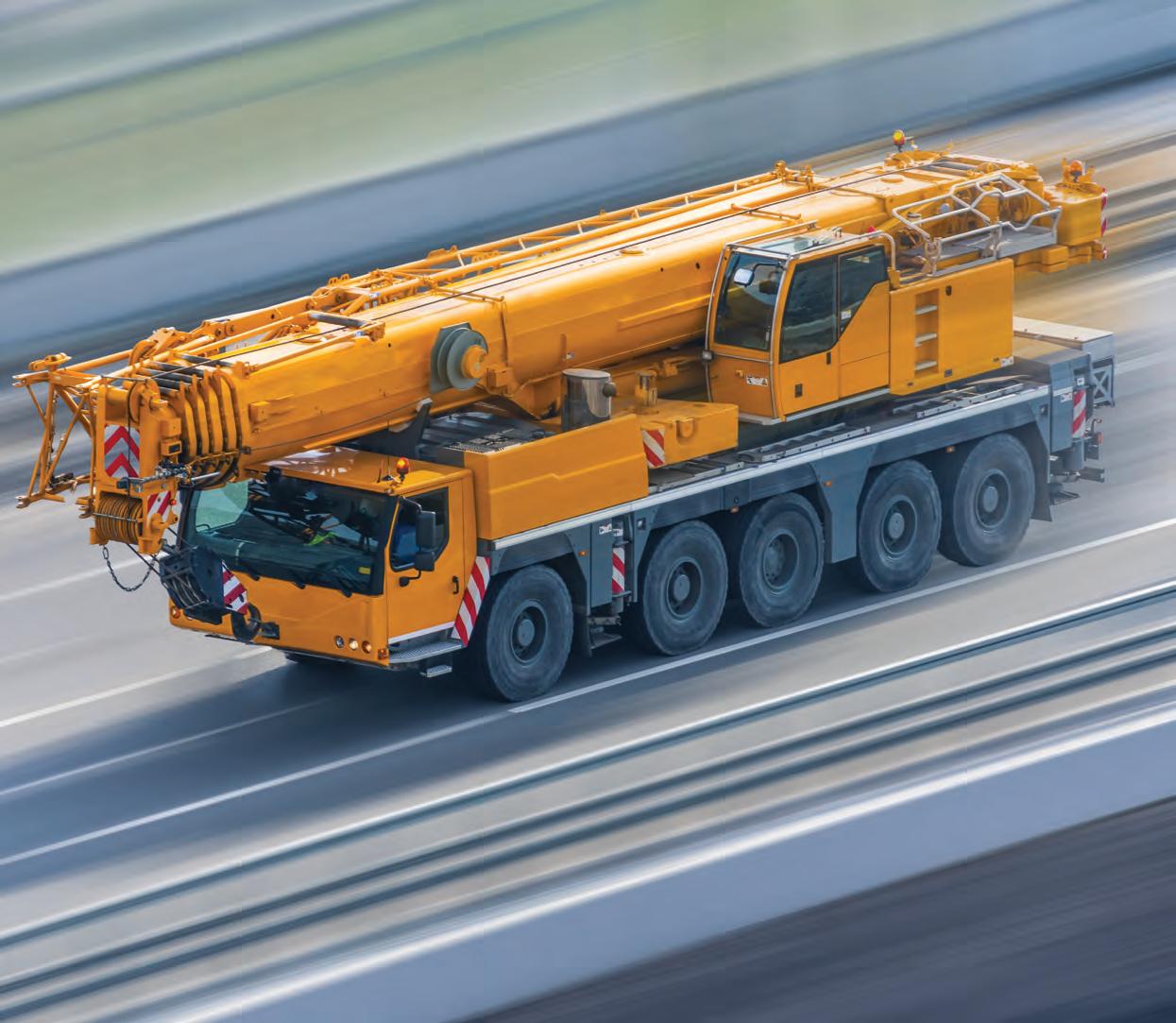
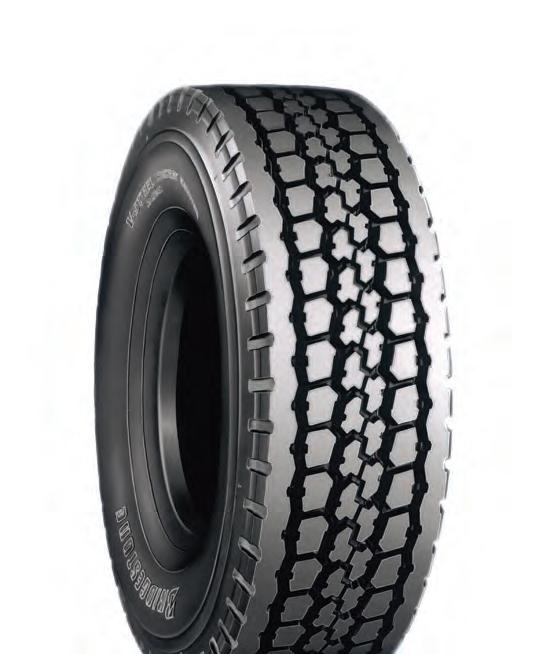


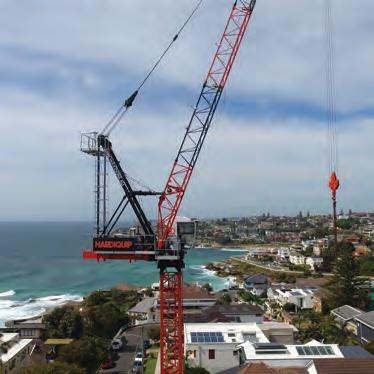

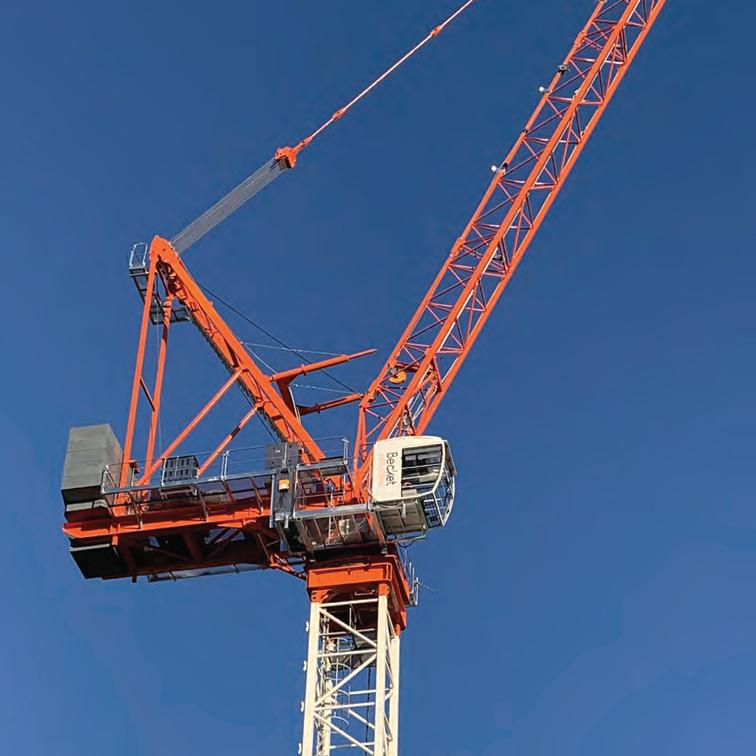
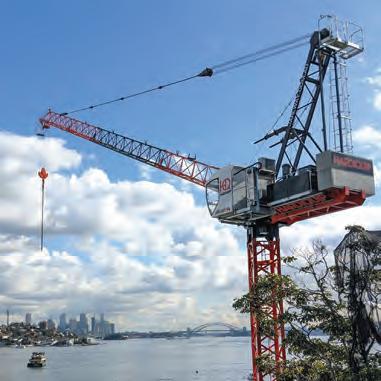
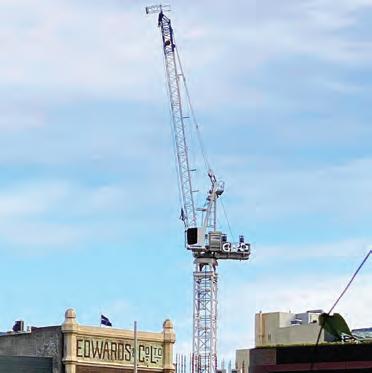
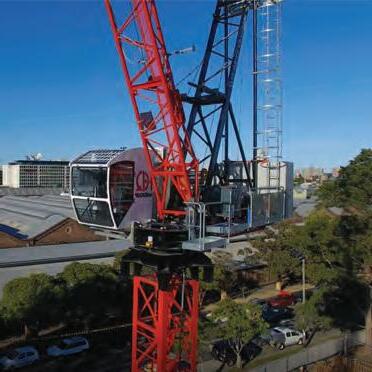
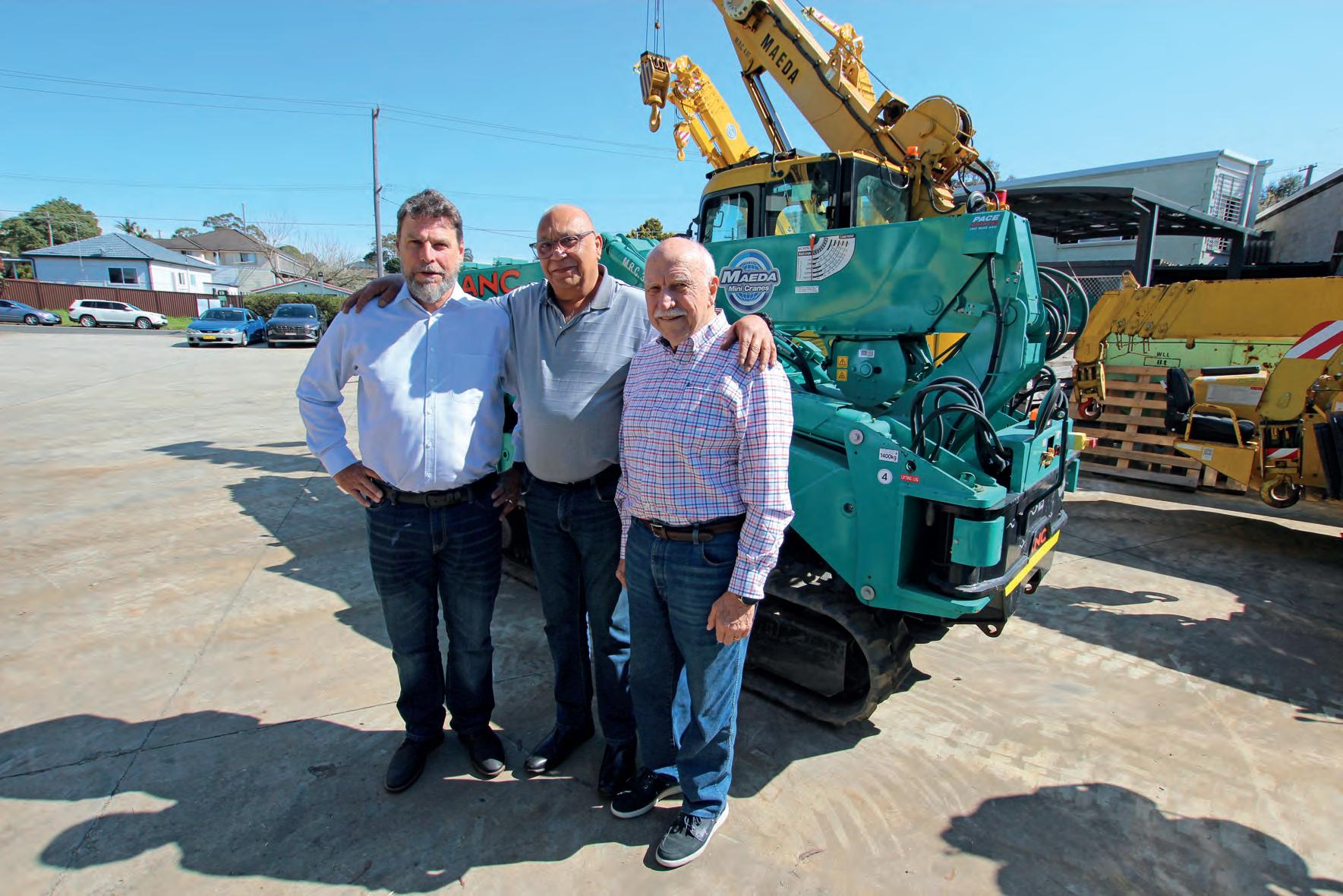
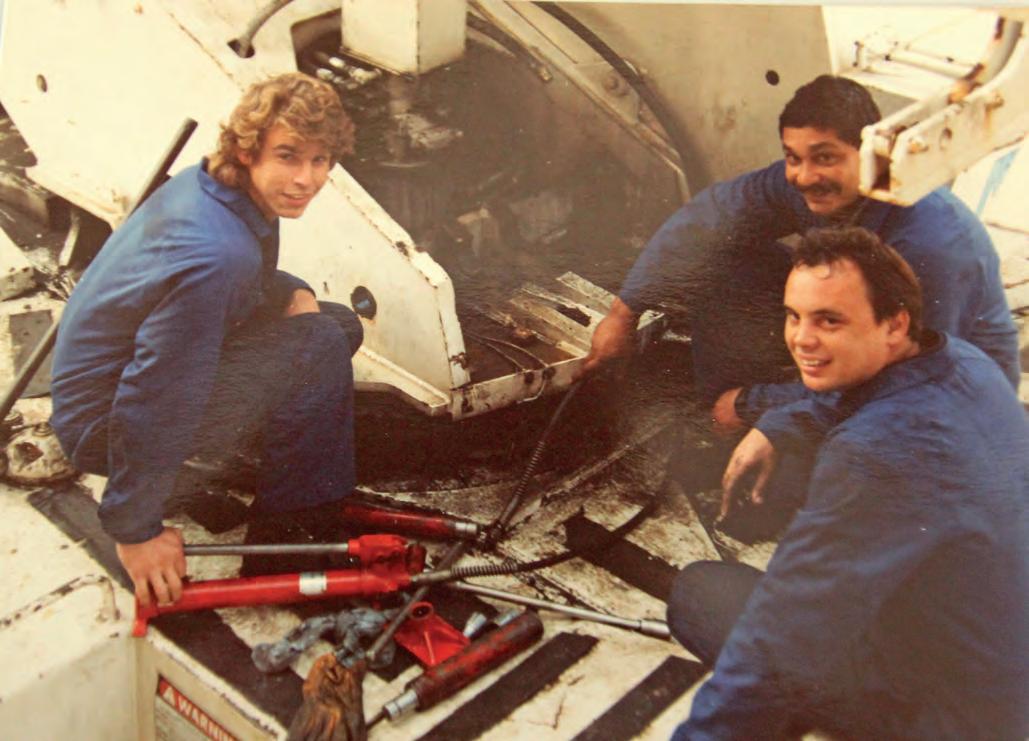
was buying and selling used cranes and selling spare parts while Paul Flood and I were managing the field service work. It was a small business operating from the Heeks’ rumpus room, but we did what we had to do. That’s how the business and a lifelong friendship started. Over all those years our relationship has been based on a friendship between his family and mine. We had a beautiful daughter and Paul and his wife Faye took us under their wings. We would spend time together watching a young Anthony play soccer and we’ve basically watched our families grow up together,” said Patrick.
In the early days, Paul worked his industry network receiving requests for used cranes. He’d travel to countries like Japan to source a crane, bring it back and Patrick and his team would carry out a full inspection, service and ensure it conformed with Australian standards. They worked like this for a few years and
for many customers. But as time went on, Paul decided he wanted to represent crane original equipment manufacturers (OEM) with new cranes. That’s when he was introduced to Maeda.
Back then nobody had heard of mini crawler cranes, there was no such thing in Australia or in fact anywhere else outside of Japan. The idea of a small mini crawler crane was a completely alien concept. Regardless, Maeda asked if Paul would like to visit the factory and have a look at the product, so he flew out and the rest, as they say, is history. In 1991 Paul agreed to represent the brand. He bought a small model and was keen to see how the market responded. The initial response wasn’t promising.
“Paul had picked up the first Maeda on his trailer and I remember thinking this is a whole new concept for the industry,” said Patrick. “Initially the response was very slow, and the industry
couldn’t see the requirement for such a small crane, but Paul persevered and decided he needed to demonstrate the Maeda’s capabilities and started a hire division. This provided exposure for the crane during the lead-up to the 2000 Olympic Games and we backed it with the best possible service and support we could offer.
“That has always been the approach and that’s what we have taught our team over the years. It’s about attention to detail and putting the customer’s requirements first and making sure the customer is happy. Obviously, there’s a commercial reality to what we do, but our main aim has always been for our customers to be satisfied.”
Through the 1990s and into the 2000s the Maeda product went well for Pace Cranes as the business was now known. The mini crawler concept became popular, with small builders,
glaziers and crane hire businesses wanting at least one in the fleet. Paul started looking at the larger telescopic crawler manufacturers around the world and discovered Sennebogen, which at the time was another unknown brand in Australia.
At this time, Anthony was becoming more active in the business. He was initially more interested in the servicing and maintenance of the equipment and although he completed management studies, he preferred being on the workshop floor rather than selling. He was deeply involved in the decision to take on Sennebogen and he basically took the ‘business reins’ at that stage.
Over the years the level of technology required for cranes to lift heavier loads further has increased beyond anyone’s wildest imagination. Patrick explains how he has managed to remain across these developments and how proud he is of the Pace Crane’s business and what it has achieved.
“You have to always be focused and you have to want to learn about the new technology. You have two choices; admit it is too advanced for me or keep up with it – and we kept up with it,” he said.
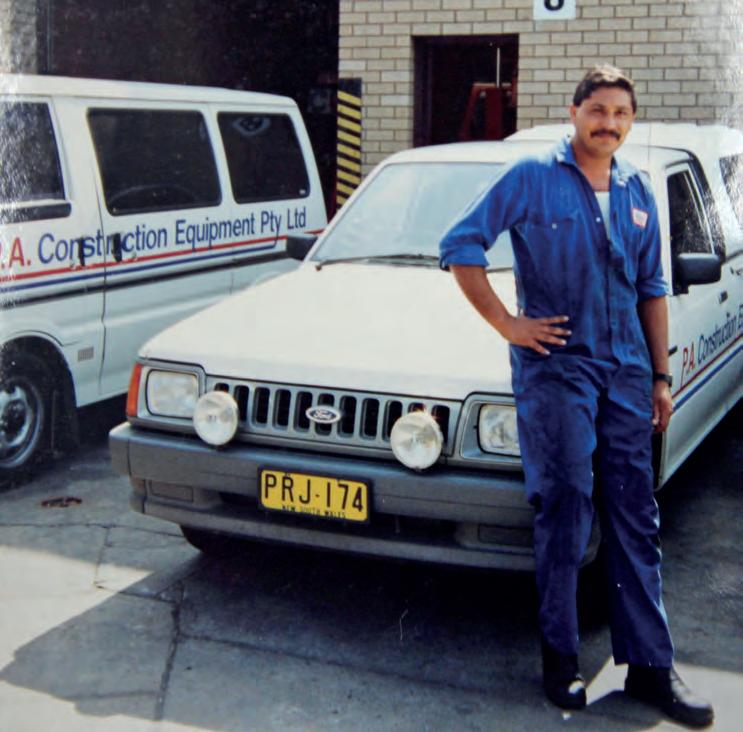
“You have to always be focused and you have to want to learn about the new technology. You have two choices; admit it is too advanced for me or keep up with it, and we kept up with it.”
“Obviously, we have had a lot of backing from the factories and a lot of ongoing training but we have also believed in what we could do and what we could achieve.
“You spend your working life as part of a team, but we all had the same vision and that’s to get further than where we were before. Our building and workshop that we operate from was a vision years ago and with planning and everyone working together, that vision has become a reality and I am proud to have played my part.
“When I arrive at work every morning I remember where we have
come from and I’m happy to have played my role during the journey. It’s important to have the right team around you and for the most part that has been the case. We have always invested in trainees and apprentices, and I’ve tried to lead by example by sharing my experience on how best to get the job done efficiently and productively.
“Often this has involved explaining how it helps to think about the task you are facing. In today’s ‘quick fix world’ youngsters tend to look at servicing and repairs and quickly conclude ‘it is broken, let’s replace it’ whereas my approach has been to say, ‘it is broken,
how do we fix it?’ With experience you learn to take your time, and this is what I have tried to instill in the generations coming through. It’s one thing to take an engine apart but it’s a completely different matter putting it back together. My advice has always been to take your time, take an hour to plan the job rather than jumping in and five minutes later realising you are lost,” said Patrick.
WHAT DOES PATRICK HOPE HIS LEGACY WILL BE?
“I hope to be remembered as someone who helped youngsters on their way in the crane industry and one person of many who has helped this business grow up, I’ll be satisfied with that,” he said.
“During my time, everything has evolved beyond recognition and with the way technology continues to develop I dare say we still have a way to go yet.”
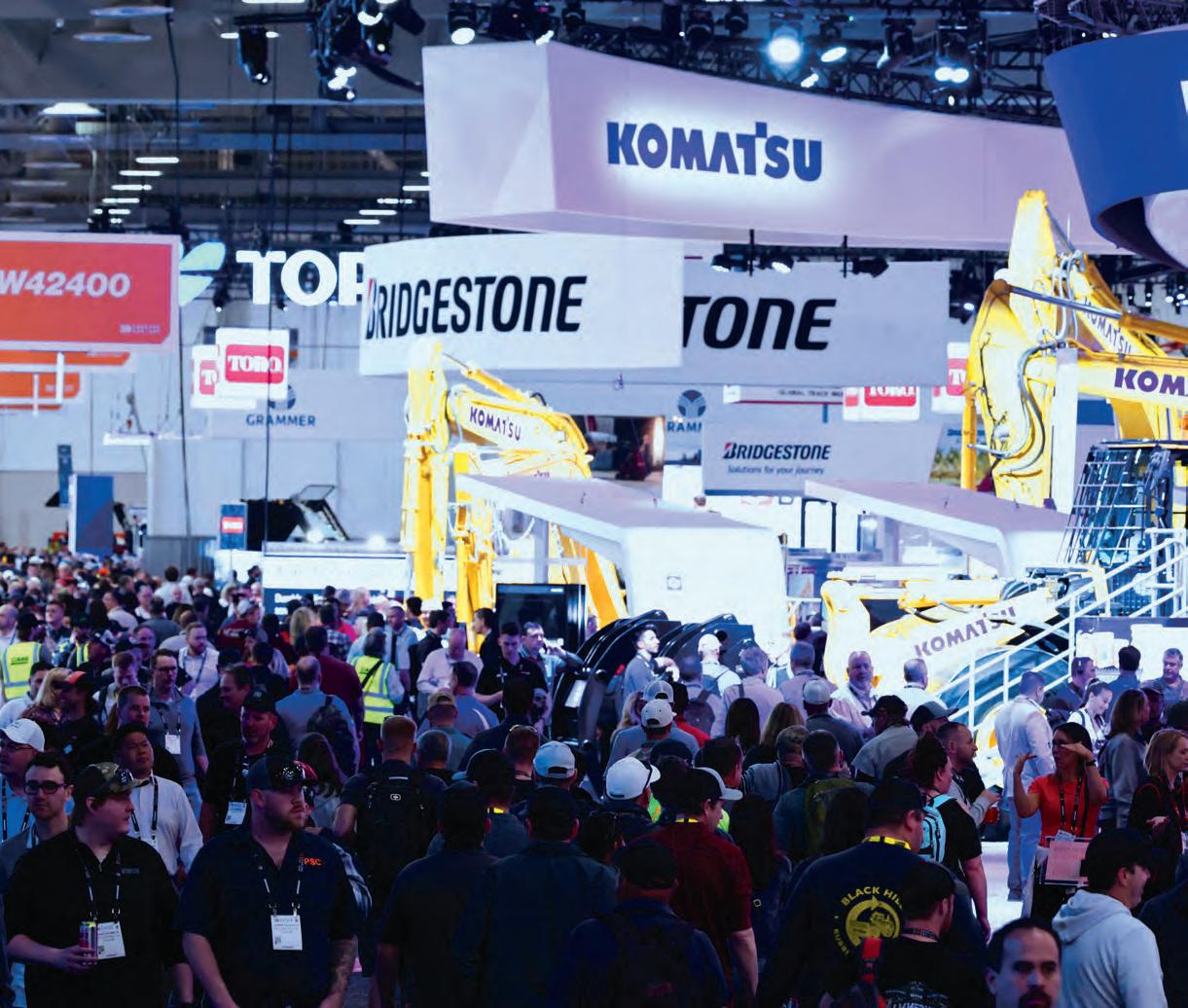
No
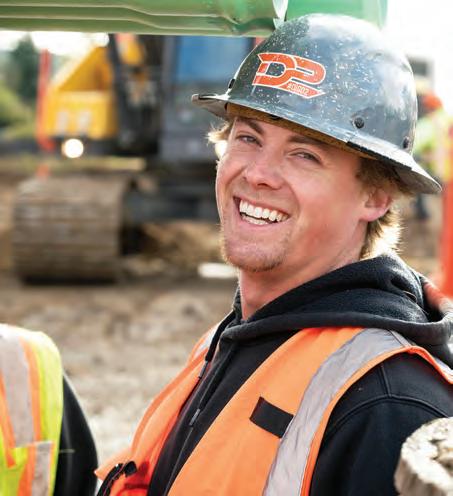
Longest powered boom to 20.9m with 5.5m telescopic fly extends to 26m
All Models (25T, 35T, 55T) rated @ 1.4m boom position, highest boom strength available, fully fabricated
Air-spring suspension with shock absorbers eliminating cabin noise and vibration
High Stability at all positions to 42 degrees
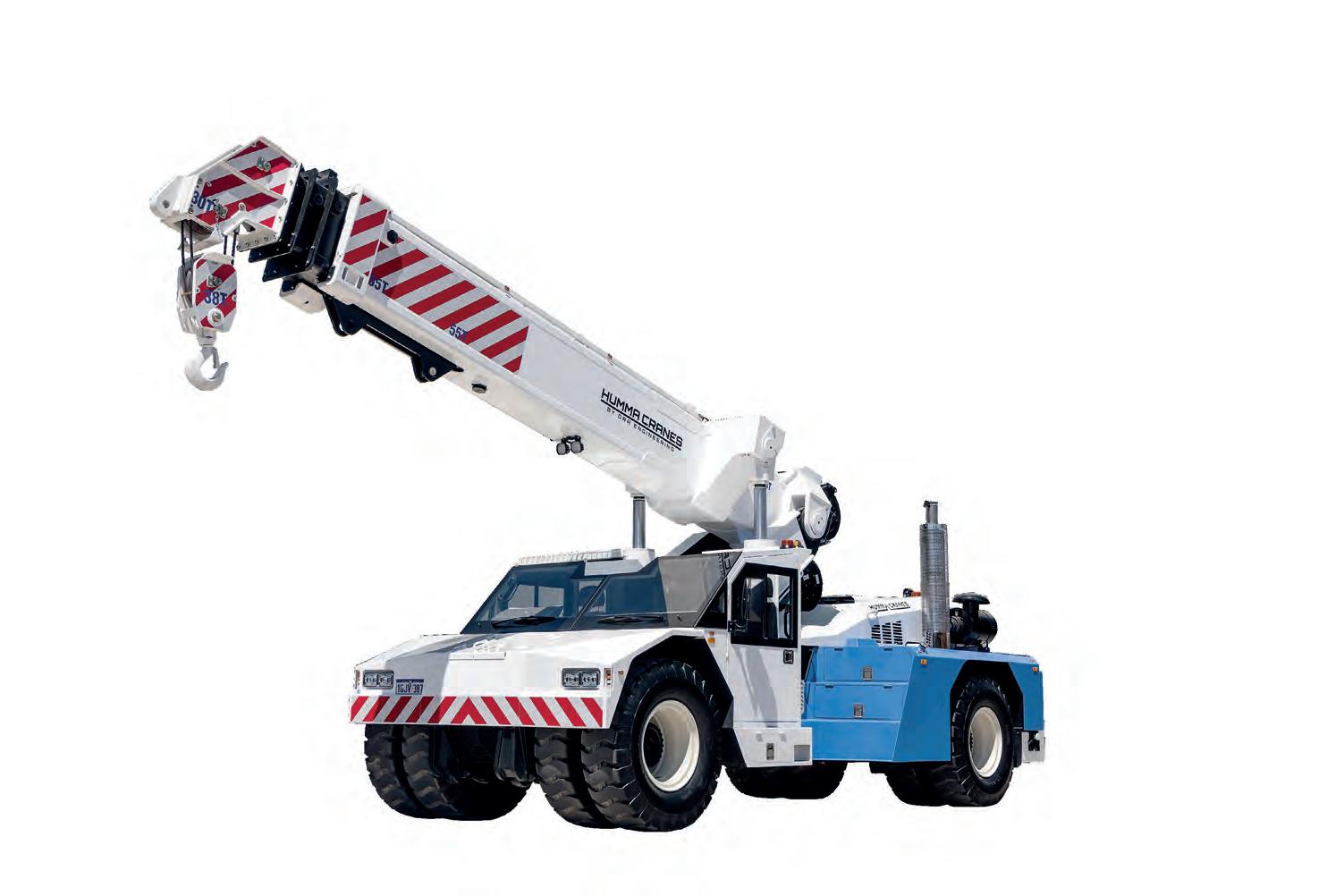
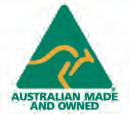
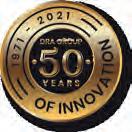

Low centre of gravity with rigid chassis design, safest crane available
Dynamic Load Chart and Digital Rope Compensation
Safe road speed 90-100kph with 180 degree unobstructed front vision with four cameras to sides and rear
Humma Heavy Lift Crane design, specification with proven componentry has set the new Industry standard for performance. ONE FOOTPRINT FOR ALL MODELS.
Crane owners require low operating and maintenance costs, highest level of safety in both driving and crane mode, achievable on all Humma Models.
Patented Auto-leveller on Humma 55, the largest and safest Pick and Carry available.
Highest level of safety at all articulation positions to 42 degrees using Humma low twist chassis design.
Cabin rated the safest and quietest available at 65 decibels.
Remove the removeable counterweight from 35T and 55T and you have a heavy duty 25T and 35T.
